




Sunday, January 29th, 2023 at 12:00 P.M. GMT
Apollo Art Auctions are delighted to present their first sale of 2023 - Fine Ancient Art, Antiquities & Coins. The catalogue encompasses a broad range of well-provenanced and expertly authenticated artefacts from Classical Europe, through Egypt and the Near East, as well as many treasures from India and China. The catalogue is divided into four sections: commencing with Classical and Egyptian Antiquities, followed by Medieval Works of Art, Asian Works of Art and finishing with a great selection of Ancient Coins.
Some of the highlights of this sale include Lot 1 Attic Black-Figure Whiteground Lekythos, an artefact with royal provenance belonging to the Second Marquess of Northampton. Lot 6 Rare Egyptian Cartonnage Mask, and Lot 7 Large Egyptian Limestone Stele King o f Upper Egypt Middle Kingdom With Report, beautiful and important Egyptian pieces. Lot 23 Rare Apulian – Lucanian Red-Figure Volute Krater – TL Tested and lot 24 Apulian Greek Red Figure Column Krater – TL Tested a great examples of high-end Greek pottery. Lot 50 Rare Greek Corinthian Bronze Helmet an iconic and desired type of helmet in great quality. Lot 51 Greek Bronze Winged Helmet - ex. Axel Guttmann an extraordinary Greek helmet of rare type and famous provenance. Lot 59 Important Marble Portrait of a Serveran Lady, Possibly Julia Domna, an astonishing Roman sculpture captured by the artist in timelessly beautiful marble. Lot 63 Large Roman Marble Venus, a playful representation of the goddess Venus in large size. Lot 65 A Bronze Statuette of Jupiter Depicting Zeus Brontaios an important Roman bronze figure modelled after a Greek original by the famous sculptor Leochares. Lot 94 Large Roman gold Cameo Pendant with Fustina Junior, one of many beautiful examples of Ancient Jewellery. Lot 276 Byzantine Marble Reliquary Box with Cross – Published, a published and unique Byzantine reliquarium. Lot 278 Massive Teutonic Knights Ceremonial Great Slashing Sword. - 207 CM the “holy grail” for Medieval weaponry collectors, a sword in astonishing preservation and substantial size. Lot 284 Viking Sword with Silver Inlaid Handle and Original Leather Straps, an exception Viking sword with original leather strap - one of many attractive Viking artifacts in this catalogue. Lot 296 Set of Eight Silver Viking Pendants – With a Report, a very rare set of Viking jewellery with a laboratory report. Lot 372 Large Gandharan Schist Standing Buddha with a Halo, a large and beautiful sculpture of Buddha. Lot 375 Chinese Han Dynasty Terracotta Pair of Seated Figures Playing Liubo – TL tested a very rareto-find complete set. Lot 411 Neo-Sumerian Inscribed Brik of Ur-Nammu, King of Ur well preserved and rare Sumerian brick.
We are a dynamic company proud of the innovations we can bring to the traditional Ancient Art market. This is one of the first catalogues in the world to offer NFTs/DOTs of Ancient Art. Apollo Art Auctions and Coinllectibles, world leaders in digital art markets, have started working on this collaboration to bring Ancient Art together with digital content. Lots 1 to Lot 5 in this catalogue have been specially chosen due to their beauty and fantastic provenance to be transformed into DOTs. The buyer of each lot will receive both the physical and digital assets, which gives ownership over the DOT that making it a liquid access on both traditional and virtual marketplaces.
Apollo Art Auctions’ January 29, 2023 auction will commence at 7 a.m. US Eastern Time/12 noon BST. View the fully illustrated auction catalogue and sign up to bid absentee or live online through www.apolloauctions.com. Apollo Art Auctions accepts payments in GBP, USD and EUR; and ships worldwide. All packing is handled by white-glove specialists in-house. For questions about any item in the sale, as well as consignments, please call the London gallery on +44 7424 994167 or email info@apollogalleries.com.
Dr. Ivan BonchevDr. Ivan Bonchev (General Antiquities) Carol. R. Andrews (Ancient Egypt) Simon Schmidt (Ancient Jewellery) James Brenchley (Classical & Ancient Egypt) Russell Scott (Viking) Clive Sawyer (Numismatics).
We are based opposite the British Museum, and love to meet history enthusiasts from all over the world! Additionally you can book an appointment to meet with our director Dr. Ivan Bonchev or to arrange the collection of a piece you have purchased.
To book an appointment to view the auction items please email info@apollogalleries.com.
25 Bury Place, London, WC1A 2JH Monday – Friday | 9:00 – 18:00
Auction house tel. +44 07424994167 Gallery tel. +44 02072422771 We accept payments in:
DOLLARS
POUND


- No Import fees for antiquities shipped to United Sates of America. - Shipping handled in house. Consign with us
We offer low, flat-rate seller’s premium of 10% +VAT. Comission is only payable for sold items with no extra charges. Our aim is to make your experience with us easy and profitable. We will not sell the item at lower then agreed price and we will make sure all of your items sell, during or post auction.
We do not charge you for advice and appraisal so contact us with images of your collection and we will get back to you with 2-3 business days.
No charge for photography, unsold lots or insurance. We are always completely transparent!
Apollo Auctions is extremely happy to present to you this truly unique bidding opportunity available for the first time in the antiquities art market, born from our collaboration with Coinllectibles, specialising in providing cutting-edge DOTs solutions.



In this sale we are offering the first five lots with DOT (digital ownership tokens) minted by Coinllectibles and stored on decentralised blockchain, helping you with the future ownership of your newly purchased piece of ancient art.
Coinllectibles™️ is a technology company supporting the collectibles industry with a focus on rare memorabilia and artworks that exist and have intrinsic value in the real world, whether tangible or intangible in nature. Coinllectibles™️ applies blockchain, marketplace, metaverse and DOT technologies as tools to enhance the real-world collectibles industry.

The technology underpinning DOTs (digital ownership tokens) has multiple functional use cases that Coinllectibles™️ is applying to areas including art and collectibles areas. A DOT (Digital Ownership Token) is a proprietary DOT format that provides a gold standard of rights and title of ownership of a digital asset, securely underpinned by smart contracts and legal documents stored on the blockchain, each with a unique identification code and metadata, also beneficial title to the relevant Collectible to which it is pegged.
Uniquely identified file stored on Arweave
Legal documentation and appraisal report are included in the DOT and written onto the blockchain


Through the use of proprietary AI, NFC and RFID technology, each collectible is unequivocally tied to the DOT
may be minted on any blockchain
Ca. 490-480 BC
Starting price: £8,000
Attributed to the Athena painter. This vase depicts a scene from a centauromachy, showing a hoplite soldier on one knee, thrusting the point of his spear into his opponent’s mid-section. The centaur, rearing up on hind legs and armed with a large fir tree branch, takes hold of the hoplite by his helmet’s high crest. Five nonsense letters are scattered in upper field. For a similar lekythos by the Athena Painter, with the same subject, see the white-ground example in the Museo Nacional de Belles Artes, Havana, inv. no 141 (J. D. Beazley, Attic Black-Figure Vase-Painters, Oxford, 1956, p. 523, no. 7, Beazley Pottery Database no: 330755).

Size: L: 238mm / W: 98mm; 343.05g.

Part of an Oxford gentleman’s collection; from an old British collection formed in the 1980’s. Ex, Christie’s, Lon- don, 2 July 1980, lot 75. Fine Antiquities, Christie’s, London, 2 July 1980, lot 75. Fine Antiquities, Ex, Christie’s London, 6 June 1989, lot 490. Fine Antiquities, Ex, Christie’s London, 11 July 1990, lot 161. Private collection, Geneva, Fine Antiquities, Ex, Christie’s London, 6 June 1989, lot 490. The Castle Ash- by Vases; Ex, Christie’s, London, 2 July 1980, lot 75. Spencer Joshua Alwyne Compton, Second Marquess of Northampton (1790-1851), Castle Ashby, and thence by descent.



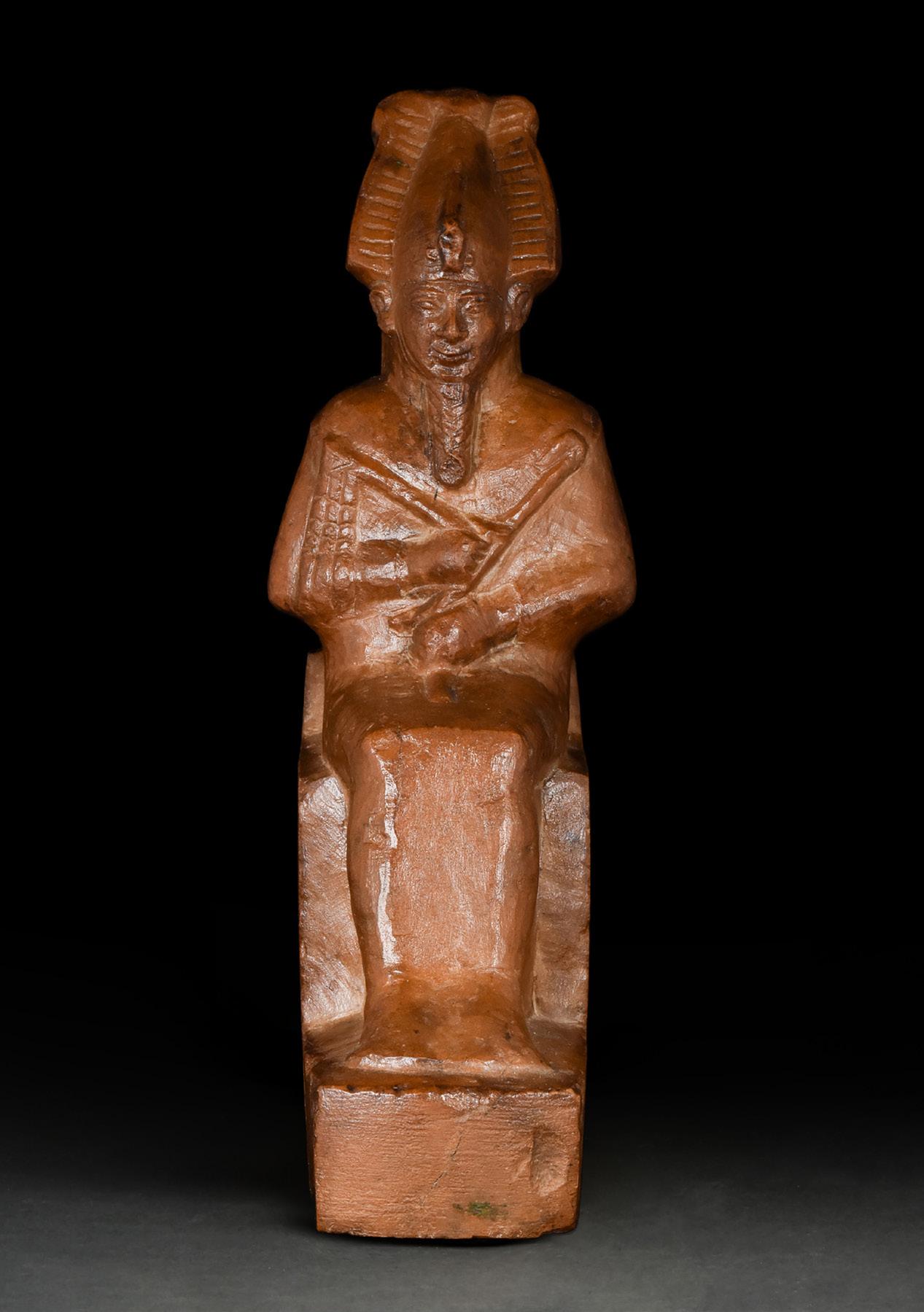
Ca. 664-332 BC, Late Dynastic Period
Starting price: £8,000
An ancient Egyptian stone statuette depicting the god Osiris. He is shown seated in mummiform with a braided divine beard, an atef-crown, and a peaceful, idealised face. He is posed with the arms folded across the chest holding a crook and flail. Osiris is the most significant and important god in the Egyptian pantheon. He is known firstly as a god of fertility, then as a god of the underworld. In his role of lord of the underworld, he was associated with a pharaoh and is, thus, generally portrayed as a deceased pharaoh, as seen on this figure. This very important example was exhibited at Kresge Art Gallery, Michigan State University, 1985 to 2002. Published: J. Eisenberg, Art of the Ancient World, vol XXII (2011), no.158.
Size: L: 145mm / W: 75mm; 580g.

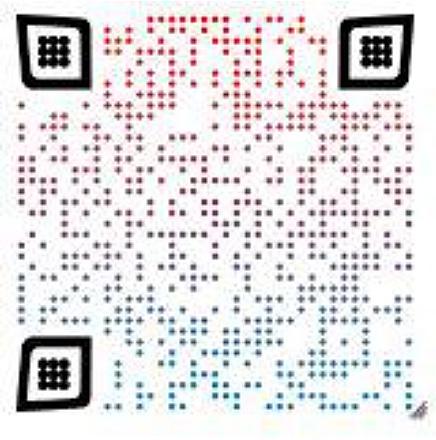
Property of a Central London Gallery, acquired by a British collector, ex-private Bandy collection, Rochester, Michigan, USA; ex Royal Athena Gallery, 1986. Exhibited at art fairs such as: Olympia Art & Antiques fair, London June 2022.
Ca. 400-200 BC
Starting price: £5,000
A well-preserved terracotta votive head of a male youth. The head is hollow-moulded, presented atop a broad clavicle base. The youth is depicted with features characteristic of Etruscan elegance.; such as almond-shaped eyes within heavy lids and a slender, nearly aquiline nose. His full lips are slightly parted, and smooth cheeks and cupped ears hidden beneath the bangs of his shaggy coiffure.

Size: L: 340mm / W: 235mm; 5.2kg.


Ex New York Gallery, Previosuly part of Collection of Dr. Angelo R. Bergamo, N.J., Ex Christies NYC, June 1993, Thermoluminescence Report from Oxford Authentication LTD, Exhibited: Olympia Art & Antiques fair, London June 2022.


4. A ROMAN BRONZE FIGURE OF A GODDESS, POSSIBLY JUNO Ca. 100 - 300 AD
Starting price: £5,000
Wearing a heavily draped chiton with a knotted belt beneath the breasts and wrapped in a himation falling from her proper left shoulder and across her waist, her right arm outstretched holding a patera, this female figure is identified as a goddess by the form of her diadem. The figure’s pose and dress draw heavily on the Greek Classical tradition. She is one of the twelve Olympian gods and chief goddess of the Greek and Roman pantheon; sister and consort of adulterous Zeus/Jupiter (q.v.); protector of women and patron deity of marriage and childbirth. For similar see: Auckland Museum Acc. No. 87. 4.

Size: L: 23.5cm / W: 98mm; 1.7kg.


Private collection of an Oxford professional. Ex. Bonhams. Private USA collection; from an old New York collection from 1990’s. Ex Sotheby’s, New York.
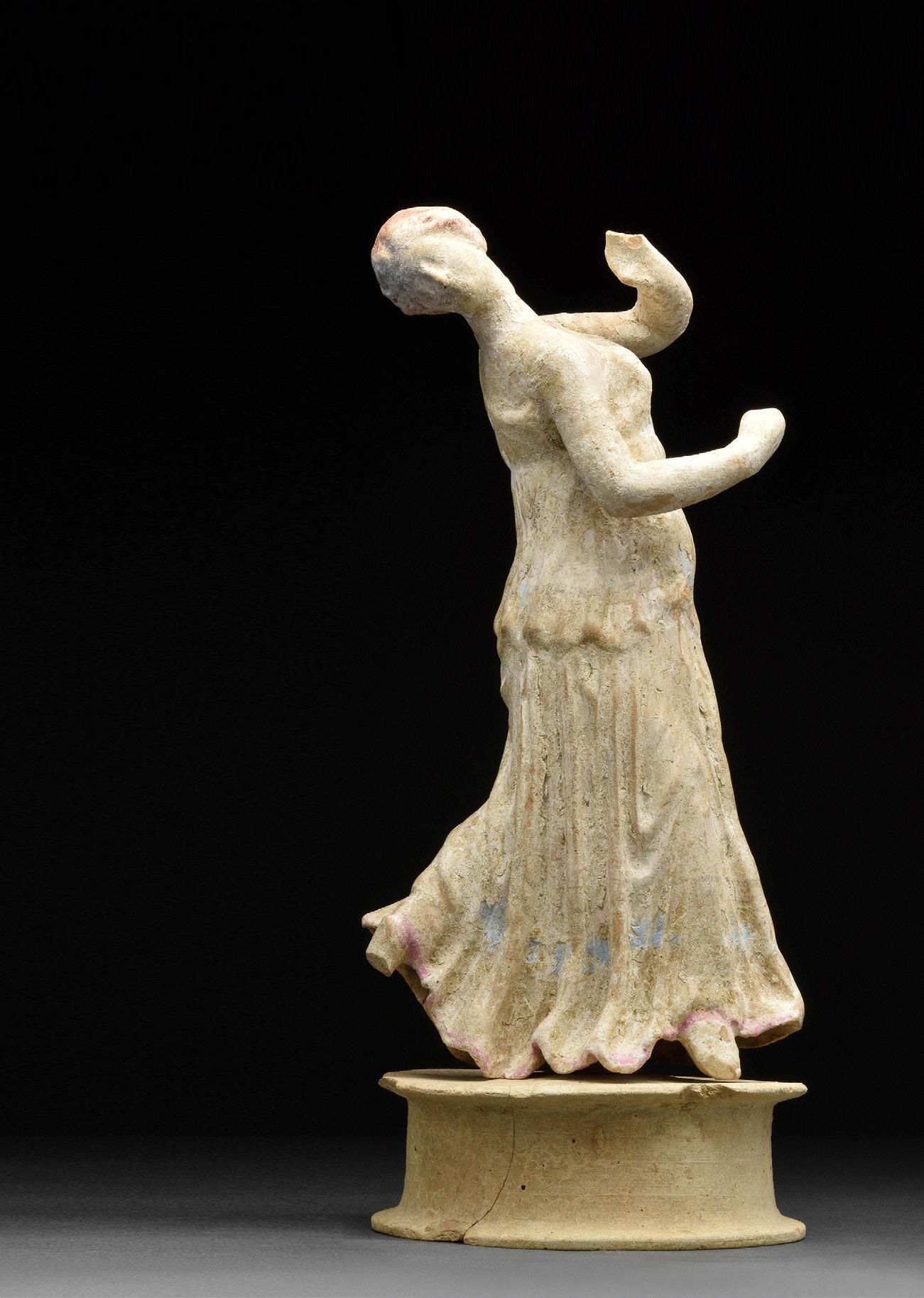
Ca. 200 BC
Starting price: £5,000
Perhaps from Centurpipe, Sicily, depicted wearing a chiton, her body twisting spirally to the right, head thrown back and turned sharply to her right. Left leg raised behind her, arms positioned out before her, redpainted hair tied in a chignon, chiton preserving blue and pink strikes, on a reelshaped base original to the figure.
Size: L: 312mm / W: 135mm; 880g.
Provenance:
Ex Christie’s, December 2002, lot 54. Accompanied by original invoice (8500$). Superb provenanced object. Ex Palladion Antike Kunst, Basel, Katalog, 1976, no. 85. Literature Simon, The Kurashiki Ninagowa Museum, Greek, Etruscan and Roman Antiquities, no.148. Exhibited: Olympia Art & Antiques fair, London June 2022.





Ptolemaic Period, Ca. 332-30 BC
Starting price: £8,000
An ancient Egyptian cartonnage mask of timeless beauty depicting the deceased who is shown wearing a tripartite wig, the lappets of which fall gently behind the ears to the level of the chest. These lappets, now painted a turquoise blue with shining gilded ends, are decorated with identical mirrored scenes of the god of the underworld Osiris. He is depicted wearing a white crown and is seated upon a bennu or shrine the double-leaved doors of which are sealed closed with double bolts, one on top of the other. Dating to the Ptolemaic Period, this mummy mask displays the continuity of the existing pharaonic civilisation with new decorative motifs introduced by the ruling Greek/Macedonian culture. The lot is accompanied by the Art Loss Register Certificate, ALR Ref: S00218512.

Size: L: 510mm / W: 365mm; 2.45Kg.
Provenance: Property of a London doctor, formerly in the collection of M.D., private collector Oxfordshire; previously in the collection of N.H., Ontario; owned by descent; previously in an old Canadian collection formed in the 1970s. Item comes with an Art Loss Register Certificate number: S00218512. Exhibited: Olympia Art & Antiques fair, London June 2022.
7. LARGE EGYPTIAN LIMESTONE STELE KING OF UPPER EGYPT MIDDLE KINGDOM - WITH REPORT Ca. 2050-1786 BC Starting price: £5,000

A large limestone carved in raised relief with two columns of hieroglyphs, containing titles of an official. The column on the left translates as “The Seal Bearer (Treasurer) of the King of Upper Egypt. The sole companian[...]” and the second “The one who is upon His two River Banks (meaning, one who is faitful to the Pharaoh), the Overseer of (The granary?) of Amun [...]”. The titles are common to the Middle Kingdom of Dynasty XII to which period this piece can be assigned. Some normal light weathering to surface. Professionally repaired from three pieces. Item comes with a professional historical report from Ancient Report Specialists.
Size: L: 733mm / W: 330mm; 22kg.
Provenance: Private London, UK collection; formerly in NYC collection, ex. Secret Eye Gallery, N. Y. C., acquired in the 1970s.

Late Period to Ptolemaic Period, Ca. 664-32 BC
Starting price: £3, 000
An ancient Egyptian gilt wood and bronze Ibis depicted seated, the body sculpted in wood, covered in gesso and gilt, the closed wings articulated, the legs and the head each separately cast of bronze and inserted, the legs folded under, the forelegs and talons incised with crosshatching, with a sinuous neck and long hooked bill, two deep grooves along the length of the bill, the eyes inlaid below ridged brows, two tenons below each leg for insertion. With or without the mummy, the ibis-form figure would have likely been an offering to the god. Some restoration. Item comes with a professional historical report from Ancient Report Specialists. Die Sammlung Hubertus und Renate Wald Hamburg, Hamburg, 1998, pp. 196-197. For a fine ibis coffin and a further description of the type, see no. 91 in Fazzini, et al., Ancient Egyptian Art in the Brooklyn Museum. For similar see: Bonhams, 16 April 2015, lot 29.Size: L: 315mm / W: 170mm; 1.7kg.
Provenanance: Private London collection; ex Attal collection, Austin Texas. Via family descent from great uncle; firstly acquired in the first half of the 20th century.
Late Dynastic Period, Saite Period. Egyptian, Ca. 664-332 BC
Starting price: £900
A bronze figure of Osiris standing mummiform with his hands emerging from his cloak, holding the crook and flail, and wearing a broad beaded collar with tassels and the Atef-crown. His face with fully outlined lips and eyes and eyebrows. Osiris was one of the most popular ancient Egyptian gods and was connected with male fertility. He was said to be the first Pharaoh of Egypt and was murdered by his brother Seth for his crown. Osiris was revived by Isis, his wife, and sister, to conceive Horus, the son who would avenge his death. After death, Osiris became ruler of the underworld and God of the dead, which is why he is shown with the crook and flail, the symbols of authority for Egyptian rulers. Size: L: 315mm / W: 170mm; 1.7kg.
Provenanance: Property of a West London gentleman; previously in a collection formed on the UK/International art market in the 1990s.

Late Period - Ptolemaic Dynasty, Ca. 663-30 BC
Starting price: £500
Statuette of the war god Maahes enthroned on a modern stand. His leonine head is adorned with a nemes headdress and a false beard, and his hands are joined over his stomach to hold a sceptre that extends down to the ankles, bending with the seated body. The throne is richly adorned on the sides with figurative designs. Much of his left arm and ear are missing. Maahes was a benevolent warrior god, the son of Ptah and Bast/Sekhment, who was associated with protection and victory. This likely would have been given as a votive offering to a shrine or temple of the god in exchange for his favour, perhaps in battle. Size: L: With stand: 165mm / W: 64mm; 280g.

Provenance: From a private London collection; acquired on the UK art market in the 1960s-1970s.
Late Period, 26th Dynasty, Ca. 664-525 BC
Starting price: £500
A silver votive figurine of Osiris wearing an atef crown, plumed on each side with ostrich feathers and decorated on the front with a uraeus cobra. The modelled face also wears a false beard, and his mummiform body holds the signature crook and flail, crossed over his torso. This would have been given as a votive offering to a shrine or temple of the god in exchange for his favour. Size: L: 31.3mm / W: 7.3mm; (with stand) 7.77g.
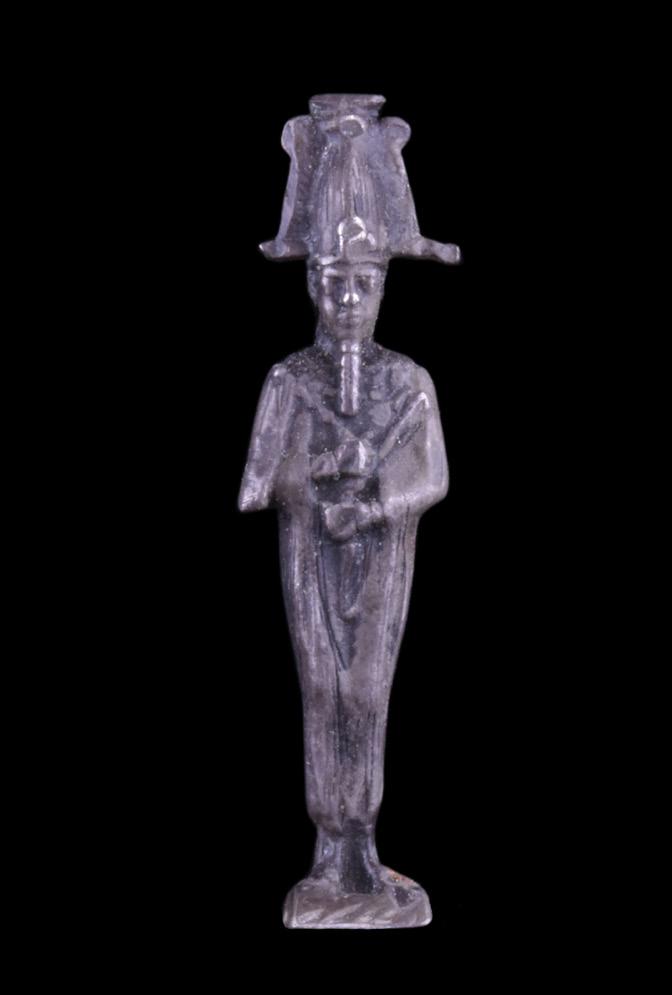
Provenance: Property of a London Art Gallery; previously with M.A. Mansoor, Cairo, Egypt, 7 March 1946. Acquired by the current owner in West Palm Beach, Florida, 2011.
New Kingdom, 19th - 20th Dynasty, Ca. 1292-1085 BC
Starting price: £500
A well-moulded terracotta shabti, wearing the tripartite wig, holding hoe and mattock, basket on the back, details painted in black and red. A column of hieroglyphs painted in black on the front reads: sHD Wsir wr-djw DHwtj-ms mAa-xrw meaning: Illuminating of Osiris, the great one of five, Thutmose, justified. The title wr-djw ïgreat one of five designates the high priest of Thot at Hermopolis Magna. Several shabtis dating to the 19th dynasty are known which belong to one or more high priests of Thot, called Thutmose. The owner was probably buried at Tuna el-Gebel, the necropolis of Hermopupolis Magna. For comparison see: J.-F. Aubert/ L. Aubert, Statuettes _gyptiennes, chaouabtis, ouchebtis, Paris 1974, pp. 122-123. W. M. F. Petrie, Shabtis, London 1935, pl. XXXV, no. 240. Size: L: 165mm / W: 50mm ; 210g.
Provenance: Private London collection; ex. B. Kickx and J. Peeters collections, pre-1978, Belgium.

13. ANCIENT EGYPTIAN TERRACOTTA USHABTI
New Kingdom, 19th-20th Dynasty, Ca. 1292-1085 BC
Starting price: £500
A terracotta shabti figure modelled in stylised mummiform pose with hands crossed over the chest, wearing an illustrious tripartite wig. All details in black pigment with a single vertical line of text at the front that reads: “The Osiris Djed-khiu, true of voice”. Size: L: 165mm / W: 50mm; 250g.

Provenance: Private London collection; ex. B. Kickx and J. Peeters collections, pre-1978, Belgium.
14.
Middle Kingdom, 11th - 13th Dynasty, Ca. 2345-2181 BC
Starting price: £1,800
An ancient Egyptian boatman funerary figure carved from a single piece of cedar wood in a kneeling position. He wears a black echelon-curled wig. The eyebrows, eyelines and mouth delicately painted in black pigment. The body painted in a deep red pigment on top of a thick layer of white gesso. In ancient Egypt during the Sixth Dynasty (2345-2181 B.C.), it became common to place wooden models of lifelike scenes in Egyptian tombs; by the Middle Kingdom (2040 -1782 B.C.), they were placed in the tomb chamber around the coffin. Some tombs went as far as having separate tombs just for wooden models. For further information see Metropolitan Museum of Art, accession number 20.3.11 and 20.3.6; O.W. Muscarella, ed., Ancient Art: The Norbert Schimmel Collection, Mainz, 1974, no. 181. J. Settgast, et al., Von Troja bis Amarna, The Norbert Schimmel Collection, New York, Mainz, 1978. Size: L: (with stand) 450mm / W: 150mm; (with stand) 1.3kg.
Provenance: Private collection of N.A., London, UK; acquired between 2003-2009 on the UK/ International market; formerly in the 1960s-1980s collections.

Late Period - Ptolemaic Dynasty, c. 663-30 BC
Starting price: £1,000
A large polychromy wooden female figure of an Offering Bearer, depicting a woman balancing a basket on her head, striding forward on a rectangular plinth, wearing a short wig and a tight dress to the ankles. Size: L: 315mm / W: 170mm; 1.7kg.
Provenance: Property of a London doctor, formerly in the collection of P. G., New York, USA; formerly part of the famous Skinner Estate collection, USA, formed since the 1960s.

16. EGYPTIAN WOOD FEMALE
Late Period - Ptolemaic Dynasty, Ca. 663-30 BC
Starting price: £1,000
A polychromy wooden female figure with a basket on her head and a water vessel in her right hand. She is depicted striding forward, wearing a short wig and a tight dress to the mid-calf. Her left arm is raised to hold the basket. Her face displays a serene expression, and her facial features are outlined in black. This statue was designed to carry food and accompany her “master” into the afterlife. For a similar example, see The Metropolitan Museum of Art, Accession Number: 24.1.1. Size: L: 375mm / W: 140mm; 582g.

Provenance: From a private London collection; acquired on the UK art market in the 1960s/70s.
Roman Period, Ca. 100 AD
Starting price: £500
A lovely face mask of plaster or stucco over linen; with handsome features painted in yellow and reddish pigments, the eyes and lashes in black pigment. The wig in raised molded relief design to simulate the hair. Nice calcite deposits remaining. Size: L: 180mm / W: 130mm; 250g.


Provenance: Property of a London gallery; formely in High Wycombe Estate collection; formerly acquired on the US Art market, Art for Eternity; Ex. French collection 1960s. Exhibited: Olympia Art & Antiques fair, London June 2022.
Late Dynastic Period, Ca. 664-32 BC
Starting price: £500
A carved sarcophagus mask formed from a finely grained cedar wood. The countenance presents with bulging almond-shaped eyes, a broad nose with flared nostrils, full lips with slightly indented corners, a rounded chin, and smooth cheeks, all beneath a wide headdress that sits low on the forehead. Traces of original white pigment are visible across the face and forehead. Remains of the originaldowel holes can be seen on the reverse. Mounted on a custom-made display stand. Size: L: 210mm / W: 170mm ; 640g.
Provenance: From a private London collection; acquired on the UK art market in the 1960s/70s.
19. EGYPTIAN ALABASTER JAR

New Kingdom, Ca. 1550-1070 BC
Starting price: £500
The vessel of piriform shape smoothly tapers to a narrow flat base, standing on an everting foot, with a short cylindrical neck and thick, flat disc rim. Cf. el-Khouli, A.; Egyptian Stone Vessels Predynastic period to Dynasty III. Size: L: 128mm / W: 80mm; 610g.
Provenance: Property of London Ancient Art Gallery; Ex. New York Gallery, acquired around 2000.
20.
Ca. 2050-1786 BC
Starting price: £500
A beautifully modelled cylindrical vessel of alabastron form, the cylindrical body tapering to the pointed base, the plain rim painted with a band of black slip. The vessel was probably used to hold precious liquids, possibly wine or oils. Such elegant objects were often placed in tombs as part of the funerary equipment. Belonging to a type of pottery that was produced as early as the pre-dynastic period, (ca. 4000-3000 BC). Delicately crafted from a local clay, the surfaces were burnished with stones and either left in their natural state or covered with a thin layer of pigment. The two-toned effect was produced by up-ending the pot in a layer of slow-burning coals. The lack of oxygen had the effect of carbonising the surface and blackening the clay. By the time of the Middle Kingdom period, to which this breath-taking object belongs, the same effect was created by painting the upper section with band of black slip. For a similar example see Bonhams, October 26, 2007, lot 5. Size: L: 128mm / W: 80mm; 610g.
Provenance: From the collection of a London gentleman; formerly acquired in early 2000s; previously in 1970s UK collection.
21.
Pre-Dynastic, Ca. 3500-3000 BC
Starting price: £1,800
A rare piriform alabaster mace head with a cylindrical drill hole in the centre for attachment to a wooden handle. Maces were extensively used in Egypt and neighbouring Canaan from the middle of the 4th millennium BC to the middle of the 3rd. Using the mace required a rather great physical force. Size: L: 200mm / W: 100mm; 505g.
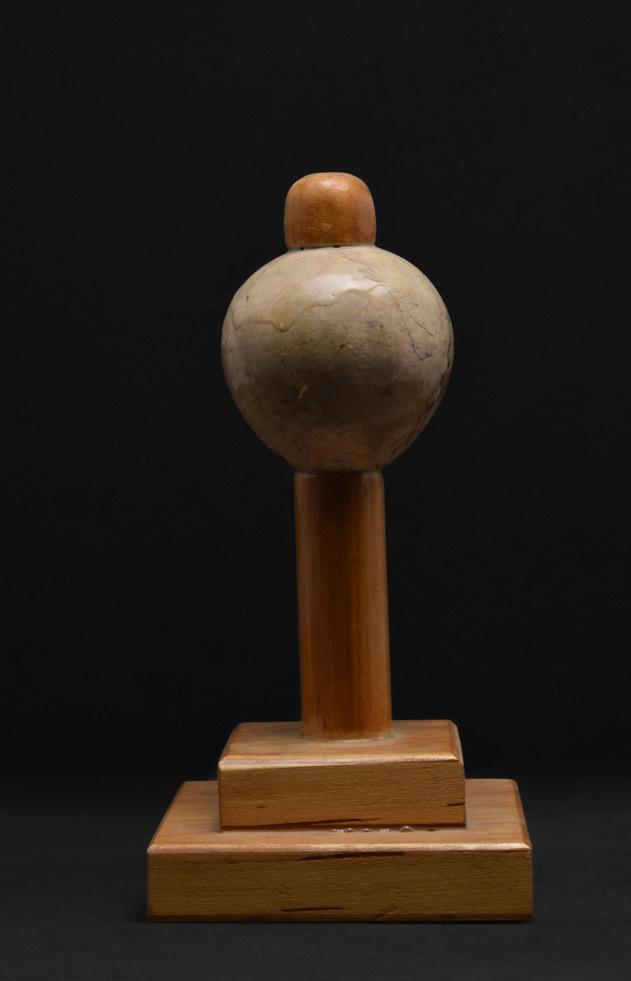
Provenance: From the collection of a London gentleman; formerly in the collection of Dr. Bruce L. Ralston, Tuxedo Park New York; Dr. Ralston assembled a large collection during the 1960s and 1970s; accompanied by a copy of the 1973 receipt.
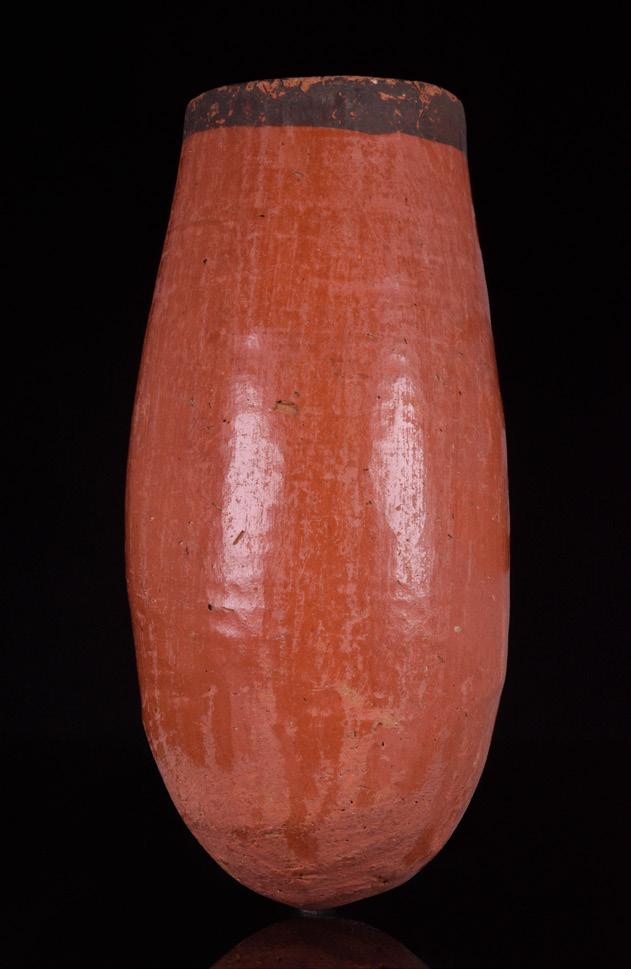
Starting price: £4,000
Hellenistic Period, possibly from Egypt. A beautiful gold finger ring composed of a round hoop and a large bezel engraved with a lion-headed gryphon (griffin) depicted in flying motion. It has been suggested that such mythological creature, only found on Egyptian jewellery, was associated with the Macedonian dynasty, whereas the most common eagle-headed gryphon was associated with the Achaemenid Empire. For a similar depiction lion-headed gryphon on jewellery, please see the Metropolitan Museum, accession number 35.6.2. Size: D: 19.76mm / US: 10 / UK: T1/2; 12g.

Provenance: Private London collection; formerly in the 1970s European collection.
400-300 BC
Starting price: £1,000
A charming janiform pale blue glass bead with a cylindrical body drilled vertically for suspending. The exterior is decorated with two human faces with applied eye beads and densely located fine spheres. For a similar example, see The Metropolitan Museum of Art, Accession Number: 17.194.727. Size: L: 30mm / W: 25mm; 30g.
Provenance: English private collection; in the collection of O. Burchard, Zurich, until 1983; formerly part of the collection of M. Hess, Basel - Hotel Jura.

23. RARE APULIAN-LUCANIAN RED-FIGURE VOLUTE KRATER - TL TESTED Ca. 400 BC
Starting price: £8,000
A large and impressive red-figure painted terracotta vessel, standing on a pedestal foot, having two opposing handles at the shoulder, and two additional handles arising from the shoulder and extending over the top of the decorated rim. The scene on side A shows a seated youth at center, clad in a mid thigh-length, short-sleeved garment, holding a rounded shield and two spears in his right hand, his left holds a footed kantharos, extending it towards a standing maenad, clad in full-length draped garment. She holds a wreath in her extended right hand, over the youth, and signifying victory. Her left hand casually holds a hydria by the handle, presumably she is about to fill the victor’s cup with wine. Side B shows two standing figures, a nude youth with draped shawl, holding a thyrsus. Opposing him is a meanad, clad in a sleeveless, full-length draped garment, extending an offering on a platter to the youth. She also clutches a thrysus in the right hand. Accompanied by a Ralf Kotalla laboratory, TL test confirming its age and authenticity.

Size: L: 506mm / W: 299mm; 4kg.
Provenance: Collection of Edmund Bourke, MD., Yonkers, NY. Acquried Arte Primitivo, auct 48, lot 66, 2008, ex. Ancient Art International, Fl., ex. Brockway collection. Exhibited: Olympia Art & Antiques fair, London June 2022.
24. APULIAN GREEK RED FIGURE COLUMN KRATER - TL TESTED Ca. 350-300 BC
Starting price: £8,000
A large and superb Apulian pottery Column krater with a decorative frame. From right to left, on the A-side a scene of a seated draped woman wearing a stylised chiton fastened below her breasts by a belt. Above the belt, the garment is bloused to form a kolpos. Her hair is covered by a kekryphalos. She is holding a wreath in her left hand and a fan in the right. Facing her on the left, a youth wearing a tall pointed cap and a short garment with short sleeves. He is holding a situla in his left hand a laden patera in right. The B-side shows two facing draped youths in conversation. Both of them holding a staffs. Either side of an asymmetric palmette, with palmettes beneath the handles, a band of meander and saltire squares below, a wreath of laurel under the rim. Cf. A.D. Trendall and A. Cambitoglou, Second Supplement to the Red-Figured Vases of Apulia, London, 1991, p. 60, no. 213a. Accompanied by a Ralf Kotalla laboratory, TL test confirming its age and authenticity.
Size: L: 460mm / W: 393mm; 4.3kg.
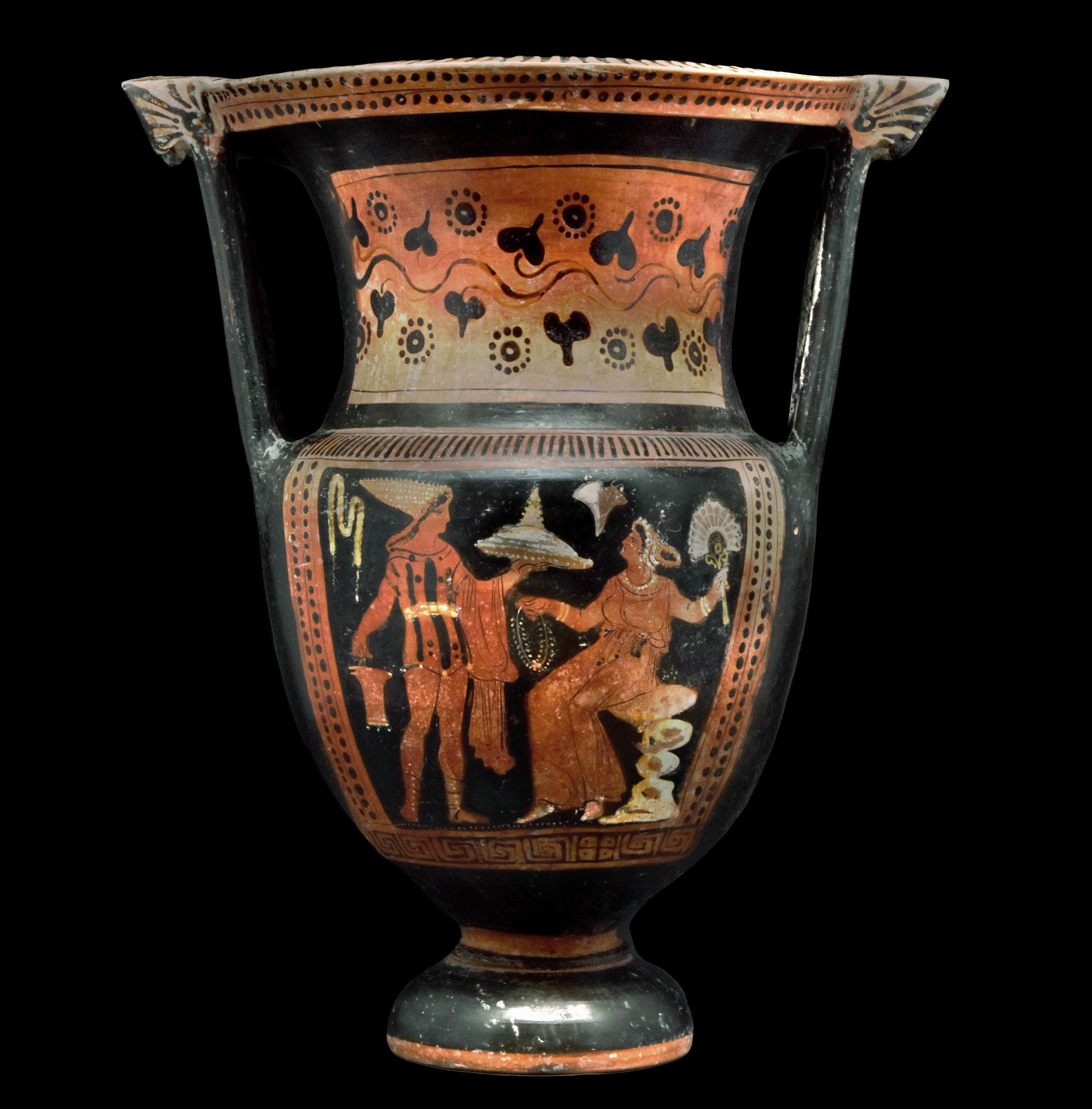

VINES
Ca. 4th century BC
Starting price: £2,000
Of imposing size, this bell-krater is decorated with colourful program in red, yellow, and white pigments against black glossy ground, with dual sided twin lion-headed handles. This krater is a fine example of ancient Gnathia ware, formed in the region of Apulia, currently named Puglia, a region in south-eastern Italy. For similar see Christie’s, December 9, 2015, lot 32. Size: L: 200mm / W: 100mm; 505g.

Provenance: Property of a London Ancient Art gallery; formerly in a private J.H. collection, Beaverton, Oregon, USA.
25. VERY LARGE APULIAN SKYPHOS
Ca. 370-360 BC
Starting price: £5,000
A very sizeable and attractive red-figure painted skyphos (wine cup), depicting (on side A) a winged nude Eros in profile, riding a horse adorned by a petite dolphin brand on its buttocks, and (on side B) a nude male satyr with characteristically pointy asinine ears, leaning against his pedlum (shepherds crook), and extending his left arm outward. Standing beside him is a female maenad nymph, dressed in a flowing chiton and carrying a thyrsus (pine cone-tipped staff) in one hand - all suggesting a Dionysian context. Beneath each handle is an intricately delineated ensemble of stylized palmettes; above the scenes is a narrow register ovalo and below a somewhat wider meander band. Size: L: 280mm / W: 410mm; 3.17kg.
Provenance: Property of a London Ancient Art Gallery; formerly acuired on the US art market; prevously in a NYC collection; Ex. Fortuna Fine Arts, NYC.

Attributable to the Iliupersis Painter, Ca. 370-350 BC
Starting price: £2,000
An attractive blackware oinochoe. On the body is Hermes, the messenger of the gods, wearing petasos and leaning on caduceus, fronting a Maenad holding a mirror, and leaning on a shield. For a type, see The Museum of Fine Arts, Budapest, Inventory number 56.141.A. Size: L: 190mm / W: 120mm; 410g.
Provenance: English private collection; purchased from a London Art Gallery during the 1970s - 1980s (including original purchase photos).
28.
Ca. 350-300 BC
Starting price: £1,000
Beautifully painted, lidded lekanis of typically elegant form, the shallow bowl painted in black, standing on a stemmed foot and with the lid with knopped finial handle. The main register with red-figure decoration; on one side is androgynous winged Eros, seated on a rock and staring into an ornate mirror. On the opposite side is a seated woman, shown with her garment, the folds of the cloth hang loosely. For a similar see Gisela M. A. Richter and Marjorie J. Milne, Shapes and Names of Athenian Vases, (New York, The Metropolitan Museum of Art, 1935), p. 23-24 and figs. 149151. Size: L: 190mm / W: 120mm; 410g.
Provenance: Property of a London Gallery; acquired from US Art dealer; formerly in a German collection, 1983. Exhibited: Olympia Art & Antiques fair, London June 2022.
29.
Ca. 500-400 BC
Starting price: £3,000
A beautiful Attic pottery kylix decorated via the black-figure technique on the exterior walls of both sides, hemispherical body with two lug handles, featuring a central horse and rider. Each horse if flanked by running nude male figures, and standing cloaked nobles flank the runners. As a final touch, graceful palmettes adorn each end of the figural scenes. The tondo depicts a bichrome ring. Size: L: 190mm / W: 120mm; 410g.

Provenance: Property of a London Gallery; obtained from a private Orange County, California, USA collection, acquired before 2000.

30.
Ca. 540-525 BC
Starting price: £3,000
A beautiful pottery kylix decorated via the black-figure technique on the exterior walls of both sides, hemispherical body with two lug handles. The exterior decoration features a central band with a swan flanked by two bovines facing each other. As a final touch, graceful palmettes adorn each end of the scene. The tondo depicts a bichrome ring. For a type see The Metropolitan Museum of Art, Accession Number: 06.1021.157.

Size: L: 125mm / W: 280mm; 360g.
Provenance: English private collection, acquired on the art market in the 1980s.
Ca. 300-200 BC
Starting price: £3,000
Presenting with breathtaking form, a wheel-thrown Pyxis with a bellshaped lower body resting upon three moulded pottery lion’s legs. The base features a broad lower rim and a tapered interior body that leads into a deep basin, and the corseted lid is wide enough to rest comfortably around the walls. Both base and lid are first decorated with orange slip that is festooned with draped laurel wreaths and a solid bar in fugitive yellow pigment. Atop the lid is a register of intricate sgraffito ivy that encloses the elegant female visage on top that longingly gazes to her right. A stunning example of fine Hellenistic artistry. For another example of a Hellenistic Pyxis with lion’s legs, please see The British Museum, museum number 1861,0724.12. Size: L: 235mm / W: 170mm; 1.2kg.
Provenance: Property of a Central London Gallery; acquired from a private collector, formerly in a private Orange County, California, USA collection, acquired in December 2017; ex-Artemis Gallery; ex-private New York, New York, USA collection; ex-Christie’s, New York “Antiquities” auction (sale 14355, April 25, 2017, lot 231); ex-private German collection; ex-Sotheby’s, London “Antiquities” auction.Exhibited: Olympia Art & Antiques fair, London June 2022.

32.
Ca. 330-200 BC
Starting price: £3,000
The slender terracotta rhyton formed with a flaring lip and conical shaped body terminating into a stag protome with the head drawn back on its long neck, its ears perked upright. Item comes with a professional historical report from Ancient Report Specialists. This piece has been precisely dated having undergone Thermo Luminescence analysis by Ralf Kotalla, an independent German Laboratory. The samples collected date the piece to the period reflected in its style, whilst also showing no modern trace elements. Its TL certificate with full report will also accompany this lot. For similar see: Miho Museum Japan: Accession Number 00002005e. Christie’s, Antiquities 1584, 9th December 2005, lot 287. Size: L:520mm; 1.3kg.
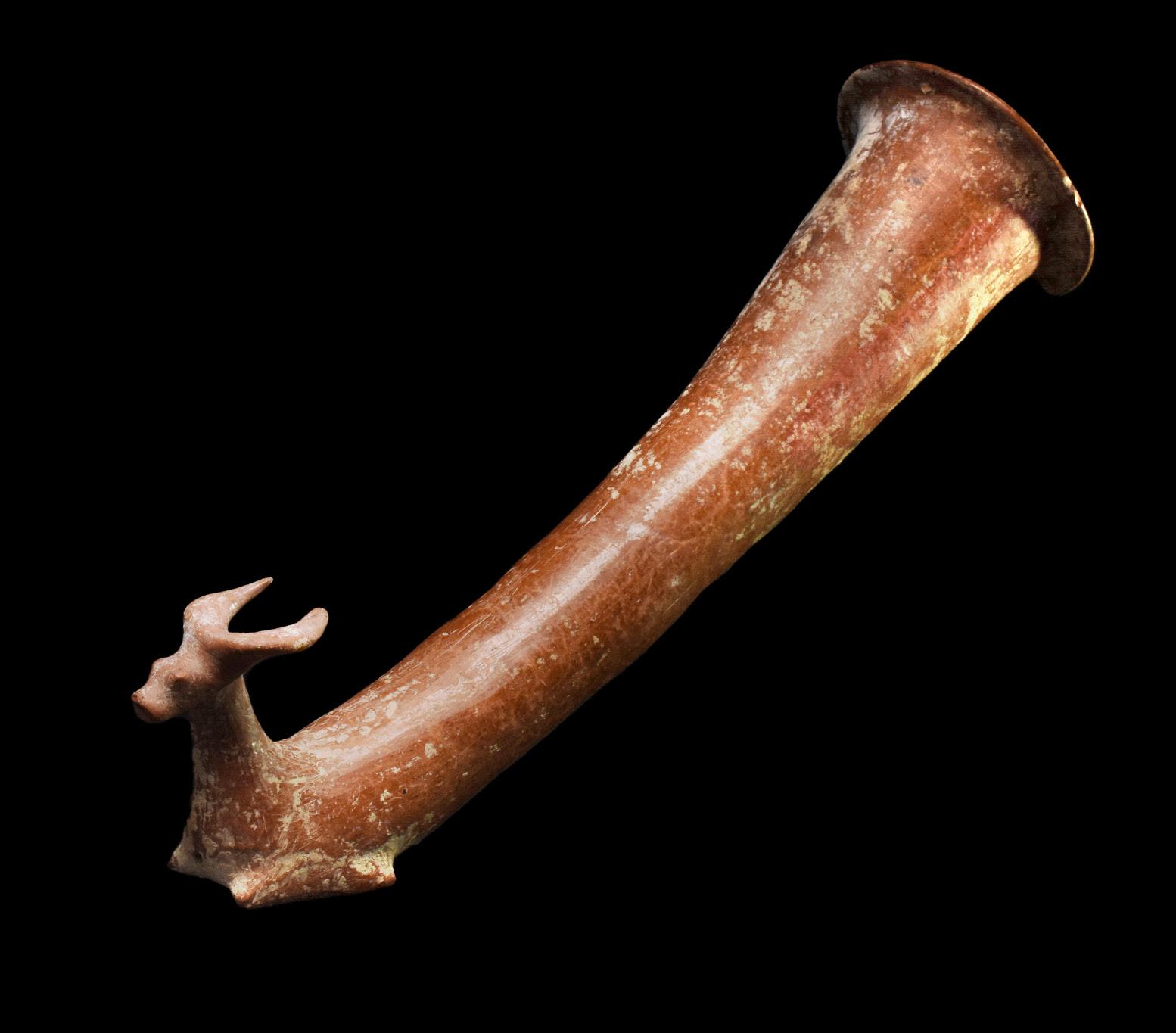
Provenance: From the private collection of a gentleman; previously with A.R. London; formerly in an old British collection, formed in the 1980s on the UK / International art markets.
Ca. 400 - 300 BC
Starting price: £5,000
A terracotta rhyton with a flaring lip, and a conical shaped body terminated into a equine finial; the trumpet-shaped both with painted bands of intersecting red and black lines., circumferential solid red bands, segmented hoops and lattice panel with black pellet detailing; Horse finial with legs folded beneath the body, painted reins and harness, vent to the chest. A fine example used by the Greeks for religious rituals. The translation of the Greek verb “to pour through”, literally describes what happens when the liquid is added. Item comes with a professional historical report from Ancient Report Specialists. Accompanied by a TL test from Oxford Authentication laboratory, UK, confirming age and authenticity. ref: Christie’s, Antiquities 1584, 9th December 2005, lot 287. Christie’s, Antiquities 1584, 9th December 2005, lot 287. Size: H: 240mm; 800g.

Provenance: Provenance: Private collection of Xavier Guerrand-Hermes, Boisgirard, Arts D’Orient, 17 December 2008, lot 7. Artcurial, Arts D’Orient et de L’Islam, 25 March 2014, lot 8.

Near the Bearded Sphinx Painter, Ca. 600 BC
Starting price: £5,000
A pottery amphora of a classic form, with a bulbous body upon a raised, round foot, a flared rim at the top and gracefully curved twin handles adjoining shoulder to neck; all hand painted via the black figure technique with intriguing iconography featuring two sphinxes facing each other between a plant. The amphora is decorated with laurel wreath around the neck. Restored. Size: L: 365mm / W: 255mm; 2.45kg.
Provenance: English private collection; acquired in Germany in 1990s; with TL analysis Oxford Authentication N117a76.
35.
Subgeometric III, Ca. 4th century BC
Starting price: £1,000
With a rosette in the tondo enclosed within a band of alternating lines and dots, framed by thick, plain bands, a band of ivy below the rim, light-brown umber paint on a cream background. Two raised handles with applied decorative protrusions on either side. Daunian or Messapian with clear Greek influence. Size: L: 126mm / W: 358mm; 1.7kg.

Provenance: Ex. High Wycombe Estate collection 2000, Ex. Gorny & Mosch, previously in a Bavarian collection acquired in 1970s. Exhibited: Olympia Art & Antiques fair, London June 2022.
Ca. 400 BC
Starting price: £1,500
A very rare example of a ceramic krater with a deep funnel-shaped neck, twin loop handles on the shoulder, and between each handle a vertical zoomorphic protome in a form of a donkey head, each with impressive pair of horns. The body, including the inside of the funnel, is decorated with red and brown encircling bands and panels. Some repairs, one on a protome; on body an ancient restoration: a crack surrounded by small holes. For a similar type, see The Museum of Fine Arts, Budapest, Inventory number T.687. Size: L: 320mm / W: 360mm; 4.07kg.
Provenance: Private collection, London; acquired in Geneva from Alara gallery in 1990s.
37.
Archaic Period, ca. 6th-5th century BC
Starting price: £900
A decorated pottery kothon with a smooth burnished, cream-color slipped surface and delicate black and red decorative lines around the rim and interior. A loop handle emerges gracefully from the shoulder and the round body stands on a short, pronounced foot. Handle has been repaired. Otherwise intact, with some scattered deposits on surface. Size: L: 60mm / W: 200mm; 355g.



Provenance: Private London collection; acqiuired from NYC collection, ex. Fortuna Fine Arts, NYC.
Cypro-Archiac, Ca. 750-600 BC
Starting price: £2,000
A beautiful thin-walled bowl of slightly elliptical form, with twin handles and ring base. The black-painted decoration on the exterior consists of bands of concentric circles below the lip which is ornamented with a thick black band. There are multiple black bands below and on the interior encircling the body. The vessel body raised upon a concave discoid foot. For similar examples from the Cesnola Collection see J.L Myres Handbook of the Cesnola Collection of Antiquities from Cyprus. Size: L: 160mm / W: 277mm; 1kg.
Provenance: Ancient Art Gallery in London, Ex. High Wycombe Estate Collection acquired in 1990s. Exhibited: Olympia Art & Antiques fair, London June 2022.
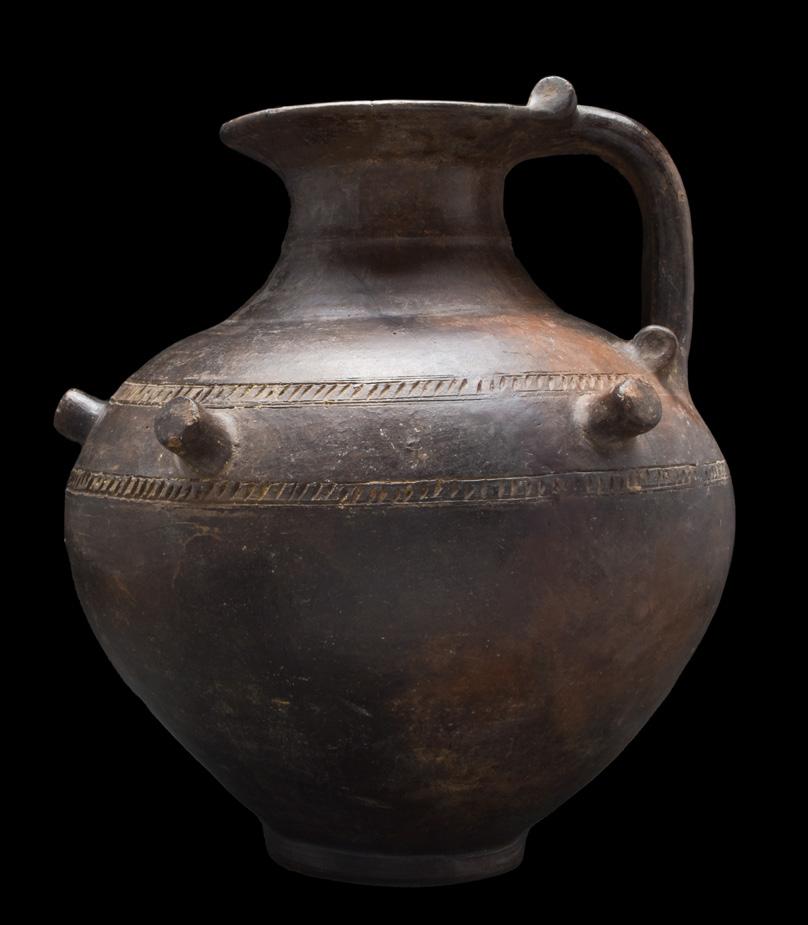
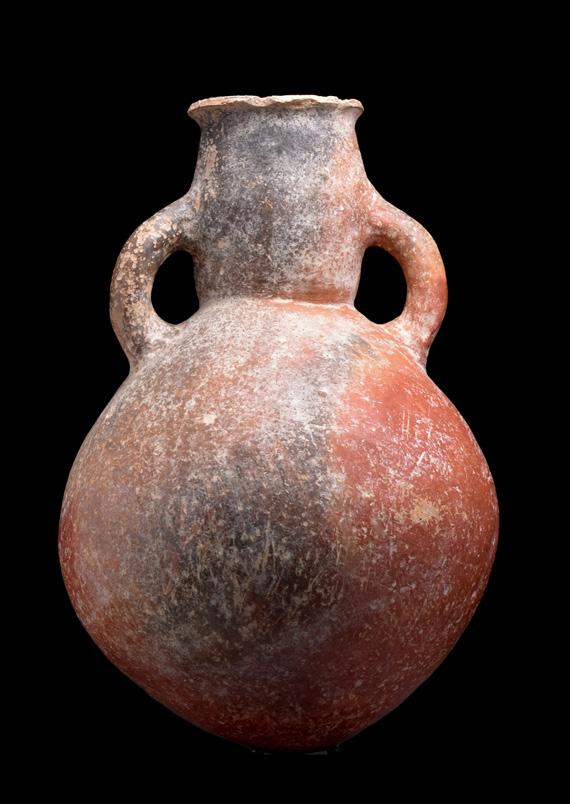
Ca. 2300-1650 BC
Starting price: £500
An attractive red slip ware amphora with a bulbous body, slim cylindrical neck, tubular rim, and two handles joining shoulder to neck. Amphorae such as this were used to hold and transport oil, wine, milk, or grain. During the Late Bronze Age, Cyprus was an important centre for the manufacture of works of art that show an amalgam of local and foreign influences. Stylistic features and iconographic elements borrowed from Egypt, the Near East, and the Aegean are often mixed together in Cypriot works. The pottery of the prehistoric Cypriots, especially that produced in the Early and Middle Bronze Ages, is exuberant and imaginative in shape and decoration. Size: L: 400mm / W: 270mm; 3.75kg.
Provenance: Property of a central London Gallery; formerly in a 1980s UK collection.
Ca. 700-600 BC
Starting price: £900
A one-handled pottery vessel of a wide, globular body on a flat ring foot. The shoulder is broad, with two bands of incised decoration flanking multiple protrusions. Cylindrical neck leads to a circular mouth with a flaring rim. Size: L: 300mm / W: 260mm; 2.56kg.
Provenance: Art Market, Germany, prior to 1968. Marin Gross (1922-2017), Biel, Switzerland, 21 August 1968.

Ca. 500 BC
Starting price: £1,800
Molded in bucchero “pesante”, these oinochoai have an ovoid body, trefoil mouth, two plastic rotelles on the rim, a disc-shaped foot, and a handle stretching from the rim to the shoulder. Decorated with a frieze of three lions in a fascinating archaic style, alternating by tongues in relief. A specimen from the same workshop was in Christie’s on 5 Jul 2017, lot 57. Restored. For a similar example, see The British Museum, Museum number 1814,0704.459. Size: L: 350mm / W: 170mm; 1.23kg.
Provenance: Private collection, London; acquired on the art market prior to 1990.
41A. HELLENISTIC SKYPHOS DECORATED WITH EROTIC SCENES - EX. CHRISTIE’S
Late Hellenistic, Ca. 100 BC
Starting price: £2,000
The two-handled vessel on a splayed foot, with a flaring rim and twin handles with circular bosses, with four, applied, molded love-making vignettes, each side with a scene of a couple in a bedchamber. This rare vessel shows the Greco-Roman appreciation for the pleasures of this life. The subject matter most likely links the vessel to the worship of the wine god Dionysos. Size: L: 95mm / W: 184mm; 420g.

Provenance: Property of a London Art Gallery; formerly in a private collection of M. G.; Ex. Christie’s, London, 2005. Exhibited: Olympia Art & Antiques fair, London June 2022.

Ca. 400-200 BC
Starting price: £4,000
Depicted with her hair arranged in multiple curls, with tresses falling at the sides, a veil drawn up over her head. For literature see C. Ede, Collecting Antiquities: An Introductory Guide, London, 1975, p. 72, no. 187. Also, see Bonhams, Lot 55, 1st May 2013. Size: L: 265mm / W: 180mm; 2.5kg.
Provenance: Frm an old Swiss Collection. Royal Athena Galleries, New York (Art of the Ancient World, vol. XVII, no. 81), 2006. Exhibited: Olympia Art & Antiques fair, London June 2022.
43.
Ca. 400-300 BC
Starting price: £900
A museum-quality bowl hammered from a single sheet of silver with underside low-relief decorated with numerous embossed amphorea designs surrounded by a circumferential band of almond-shaped protrusions. Libation bowls, known as phiale, were used across a wide geographical area - from Greece to Tibet, throughout the ancient Near East and Central Asia. These shallow bowls for holding wine in ritual and ceremonial settings were made from many materials - glass, ceramic, and many kinds of metal. Royal vessels were made of precious metals, like this one. They functioned both as tableware and as wealth - they could be stored in the royal treasury or given as gifts to people they were hoping to influence. Size: L: 210mm / W: 210mm; 648g.
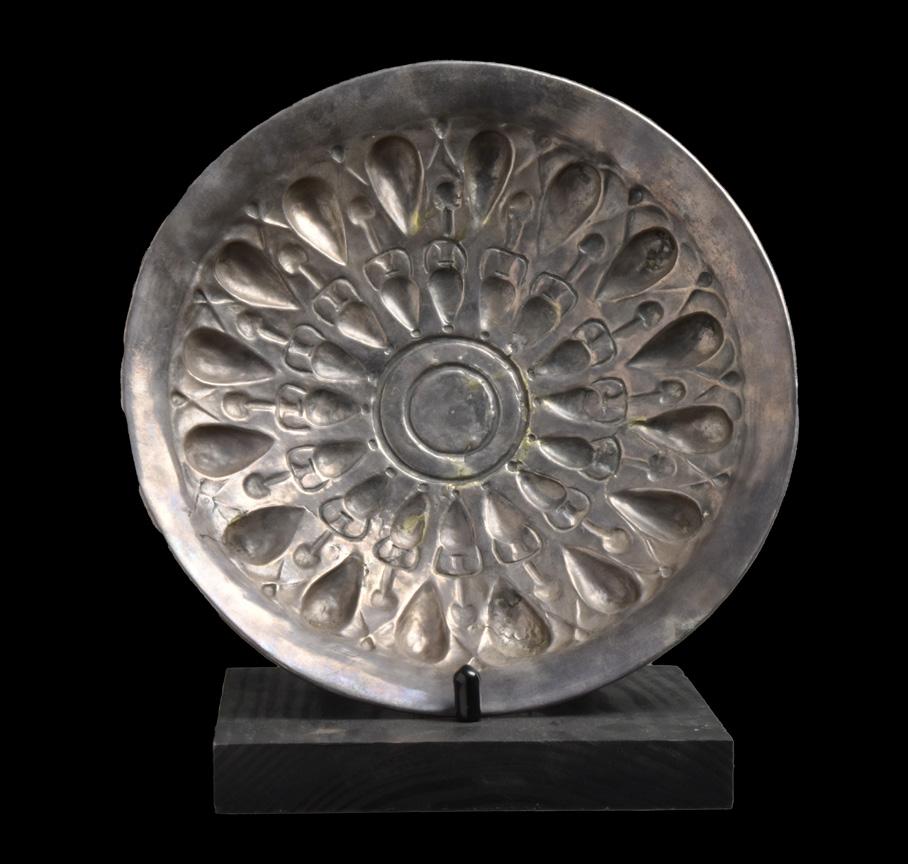
Provenance: Private London collection ( B.A); formerly acquired in the 1970s from John Lees collection.
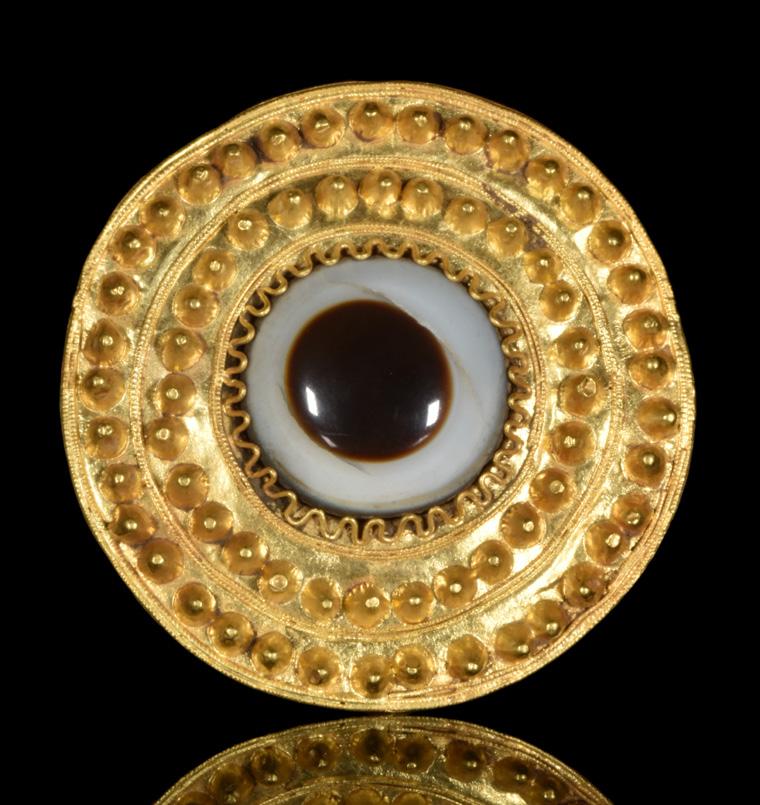
Ca. 300-100 BC
Starting price: £1,000
A finely rendered Greek Hellenistic gold disc-shaped brooch/pendant, hammered from thin gold, with an agate eye to the centre. The obverse is finely decorated with dense filigree designs. The reverse remains smooth and unworked with small loops for attachment or suspension. Size: L: 80mm / W: 80mm; 52g.
Provenance: Private London collection of Ancient Art; previously with a London art dealer; acquired from a Japanese collection (1970-2010).
45. LARGE HELLENISTIC GOLD RING WITH ONYX INTAGLIO PORTRAIT
Ca. 300 BC
Starting price: £1,800
A beautiful gold ring with a hollow circular band and an oval black gemstone with an intaglio depicting a left-facing portrait of a Ptolemaic Ruler. She is displayed with an elegantly styled coiffure, aquiline nose, and overall calm expression. Excellent condition. Size: D: 18.14mm / US: 8 / UK: P 1/2; 14g.
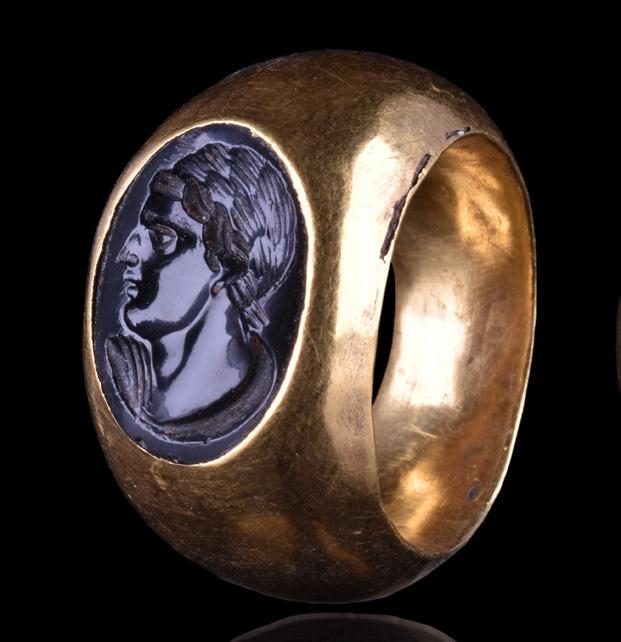
Provenance: Property of a London collector; formerly acquired in Japan in the 1990s.

Ca. 200 BC
Starting price: £1,800
A stunning gold ring composed of a D-shaped hoop with its arms terminating in architectural form with a hinged mechanism. The raised bezel features a large cell with a garnet cabochon inset. For similar examples, see F. H. Marshall, M.A., Catalogue of the Finger Rings, Greek, Etruscan, and Roman in the Departments of Antiquities, British Museum, London, 1907, Pl. XXI, 843-844. (ex Collection & bequest: Franks from 1897). Size: D: 17.12mm / US: 6 3/4 / UK: N; 8g.
Provenance: Property of a London collector; formerly acquired in Japan in the 1990s.
47. GREEK
Ca. 300 BC
Starting price: £450
An amphora-shaped pendant comprising a central shaft threaded with a large piriform coral bead secured at the bottom with a large sphere. The looped finial, serving as a suspension ring, is flanked by a pair of opposing, delicately formed dolphins. This item is in wearable condition and it comes with a modern necklace cord. The jewellery of the Hellenistic period is characterized by the use of gold and filigree work, which were expertly used to create exquisite pieces like this example. Size: L:31.2mm / W:13.5mm ; 3.64g.

Provenance: Property of a West London gentleman; previously in a collection formed on the UK/ International art market in the 1990s.
Ca. 300-200 BC
Starting price: £15,000
Bronze plated with embossed silver plates. There are two types of phalerae in the set. Six phalerae in the form of oval plates with the image of hovering Nike on the background of perun with trophies in his hands. Scientific sources: Valentina Mordvinceva. Sarmatische Phaleren. Archäologie in Eurasien, Band 11; Bohn R. Altertümer von Pergamon. Band II. Das Heiligtum der Athena Polias Nikephoros. Berlin: Verlag von W. Spemann, 1885. 144 S. 50 Taf; Aleksandr Symonenko Sarmatian Horsemen of North Pontic Region (2nd ed.). Size: L: 350mm / W: 170mm; 1.23kg.
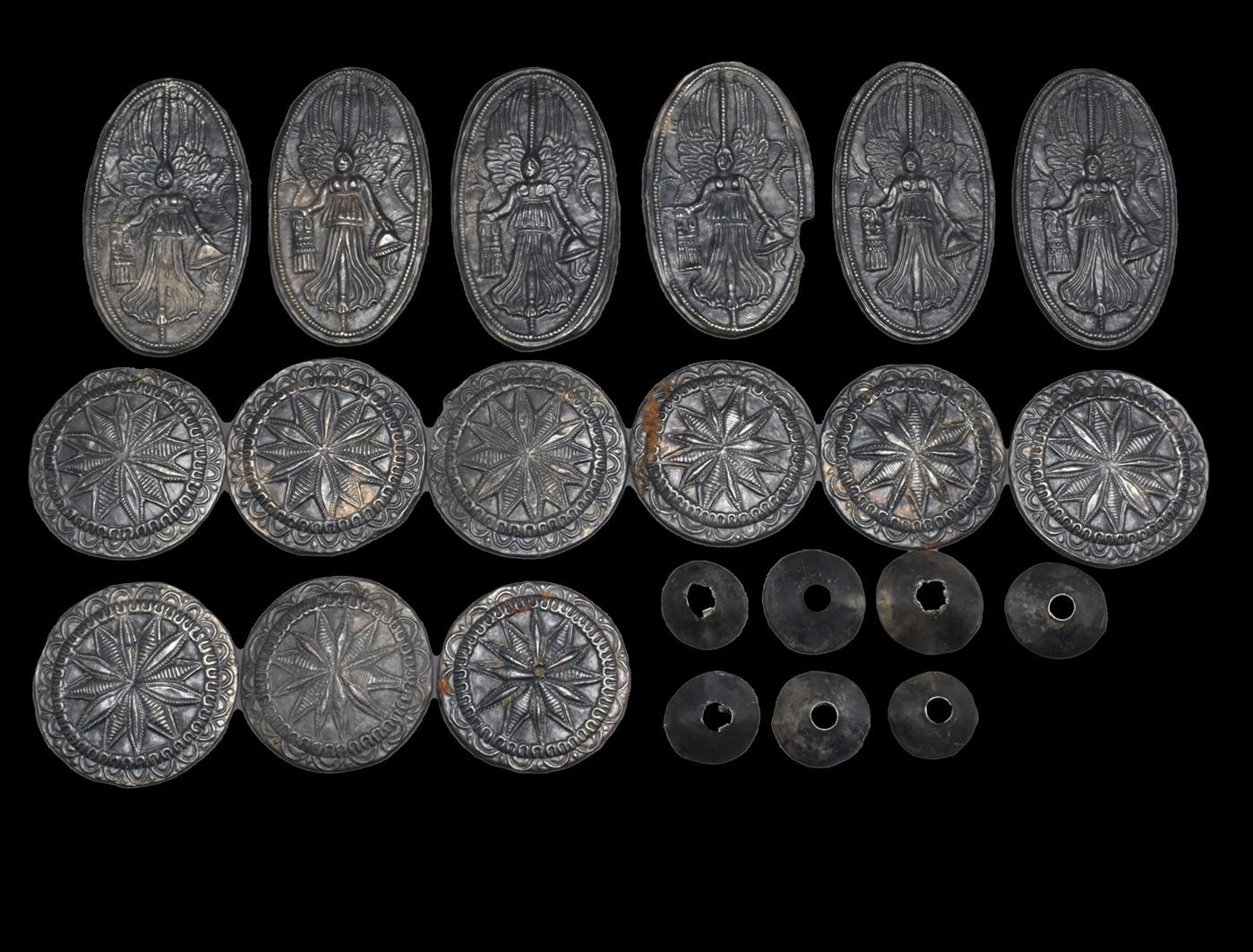
Provenance: Property of an European collector; bought from a UK gentleman collection, formed in the 1960s-1990s.
Provenance: ALEXANDER
49. URARTIAN BRONZE HELMET Ca. 800-700 BC

Starting price: £5,000
A helmet formed of hammered bronze sheet of conical form with two bands of horizontal raised ribs around the bottom edge. The helmet is decorated with repoussé rib to the forward face ending in a beast-head and flanked by two repoussé arched serpents. The representation of mythical snakes with lion heads is a recurring theme on Urartian helmets and is thought to have served as a form of magical protection against even forces.
Literature: Barnett, R.D., Watson, W., ‘Russian Excavations in Armenia’ in Iraq, vol.14, no.2, fig.15, and pls.XXXII,2, XXXIII,2; Borchardt, J., Homerische Helme: Helmenformen der Ágais in ihren Beziehungen zu orientalischen und europäischen Helmen in der Bronze-und frühen Eisenzeit, Mainz, 1972, pp.103ff., fig.9, p.107, 10-12, p.108; pl.34,4; H. Born & i. Seidl, Schutzwafften aus Assyrien und Urartu, Band IV, Sammlung Axel Guttmann, Berlin 1995, pp. 36-39. II-V. Cf. Christie’s, New York 5th June 2014, Lot 55 for similar. Christie’s, 14th April 2011, lot 331. The British Museum Accession number: 134611. The Urartian craftsmen were renown for their skills in producing high quality metalwork. Among these were bronze helmets, quivers, and shields in which they were unique for hammering repousse and engraving techniques. The Urartian kingdom was famous for its battles with the Assyrian empire, the weaponry was in high demand.
Size: L: 310mm / W: 230mm; 900g.
Provenance: From the collection of a London gentleman; formerly acquired in early 2000s in France; previously in 1970s European collection.
Ca. 600 BC
Starting price: £20,000
A bronze combat helmet of Archaic Corinthian-Type, hammered from a single sheet of bronze with finely contoured almond-shaped eyes that gently taper to a point. Simplistic curvilinear eyebrows. Arched enveloping cheek pieces that provide a vertical opening for the mouth. A border has been drilled with rounded head-headed rivets to secure an interior lining. The nose-guard is wide with a round conical shaped terminal end. The dome-shaped calotte with a widely protruding round back of the head continuing into a slightly flaring neck-guard. The ridge decorated with linear decoration above the eyebrows. The domed skull with attachments for plumes. This fine example of helmet would have been owned by a wealthy member of the social elite. Perhaps someone of high importance. The helmet is completely intact, without repair or restoration which is rare on the global art market.
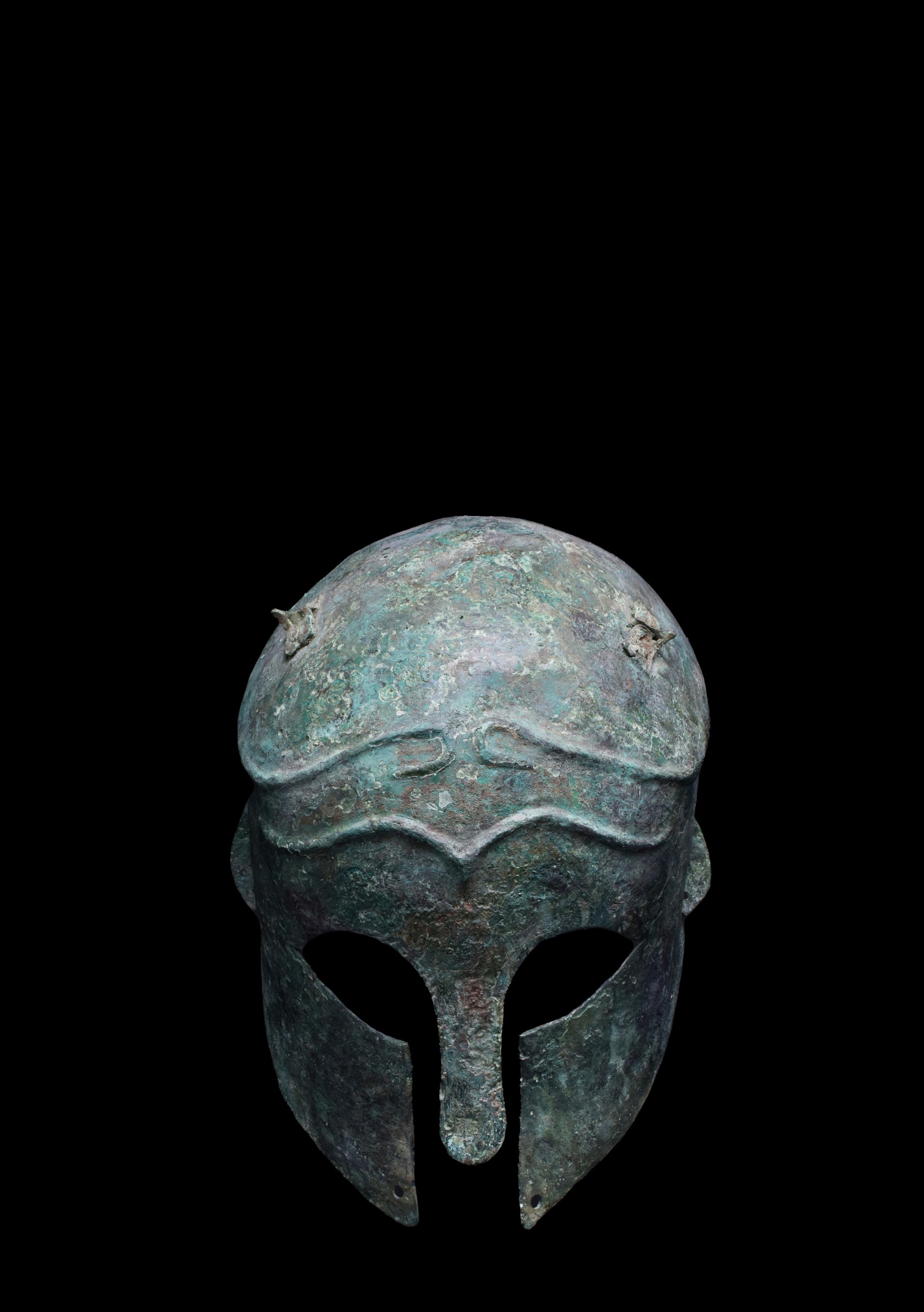
Literature: Martin D’Arcy, S.J., Dr Werner Muensterberger, Edward Sullivan, C.S.B Persona Grata, an Exhibition of Masks from 1200 B.C. to the Present, exhibit catalogue, University of St. Thomas, Houston, 1960, no. 1, illus. R. Hixenbaugh, Ancient Greek Helmets: A Complete Guide and Catalogue, New York, 2019. Cf. Christie’s, 19738, Antiquities, 21 April 2021, lot 52 and 72.
Size: L: 280mm / W: 160mm; 725g.
Provenance:
The Walters Art Museum, Accession Number: 54.2304. The British Museum, Accession Number: 1824.0407.32. This elite form of hoplite helmet is commonly referred to as “Corinthian-Type” because it is worn by the goddess Athena on Corinthian coins. Originating in Greece it was named after the polis Corinth. Although these helmets were not limited to one production place. These helmets were popular in Greece and in territories colonised by or in regular contact with the Greeks. The hoplite wearing a Corinthian helmet would have been a frightening sight to any enemy with a pair of glaring eyes behind a stylised cut-out.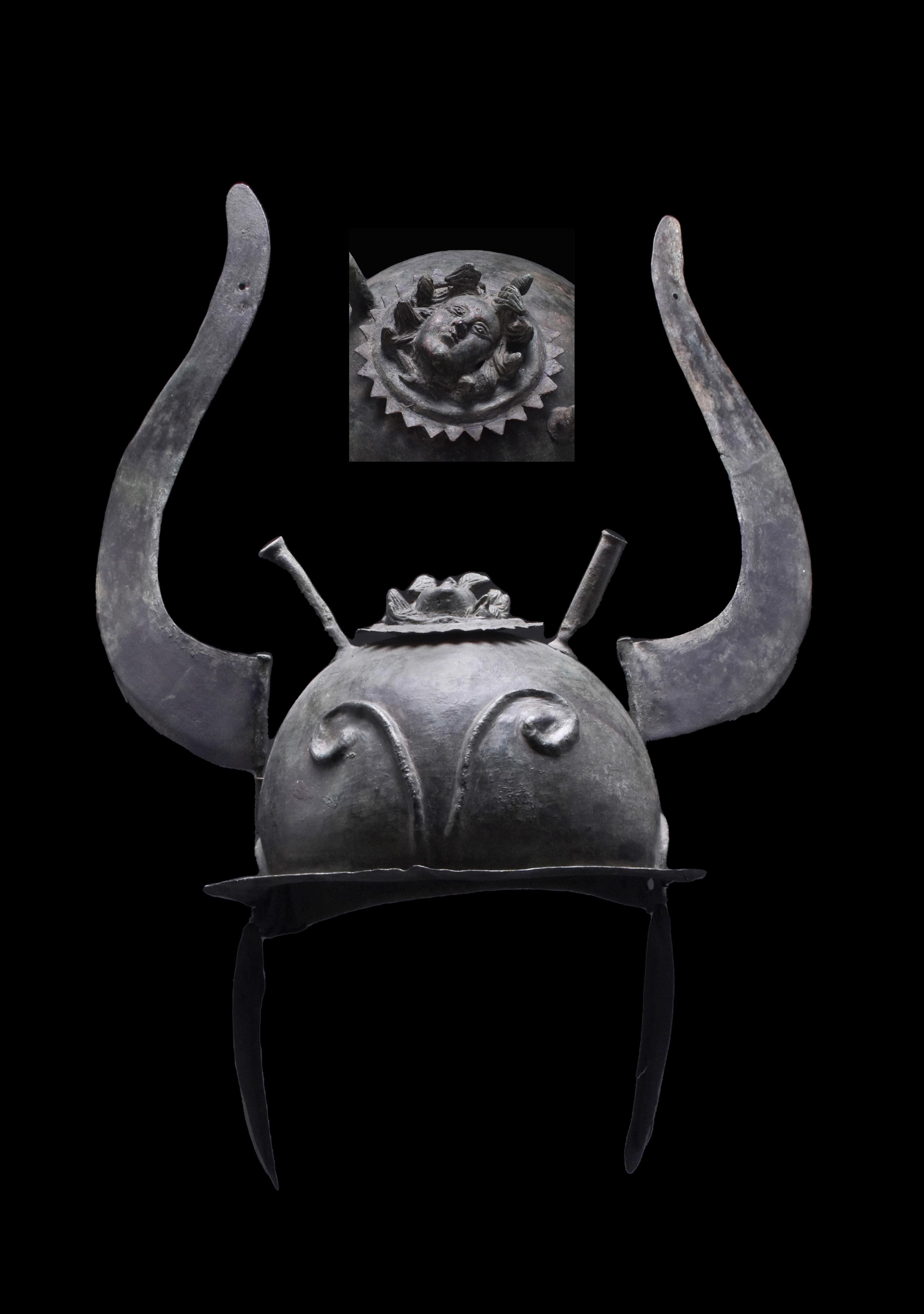
51. GREEK BRONZE WINGED HELMET - EX. AXEL GUTTMANN Ca. 400 BC
Starting price: £20,000
A bronze helmet forged from a single hammered sheet with a finely central crest in high relief depicting a stylised gorgoneion with intricately made snake heads depicting scales, in between two long cyclindrical erect plume holders. The crown with a raised spiral tendril in relief. The ridge terminates at the back in a pronounced carinated edge, an arching ridge above the neck-guard; the cheek-pieces hinged. The helmet is surmounted by a pair of engraved sheet bronze wings. Two finely decorated wings of sheet bronze riveted to the sides. This extraordinary example of Chalcidian helmet was likely owned by someone of importance. A wealthy member of social standing.
Literature: R. Hixenbaugh, Ancient Greek Helmets: A Complete Guide and Catalog, New York, 2019, p. 491, no. X356. For a similar helmet in the Mougins Museum with plume holders and peaked brow see no. 108 in Merrony, op. cit. Graells, R. Lorrio, A., Qesada F.. Cascos Hispano-Calcidos, 2014. Mainz. John Hewitt, Official Catalogue of the Tower Armouries, London, 1859, no. 1.19. M. Burns, “Graeco-Italic Militaria” in M. Merrony (ed) Mougins Museum of Classical Art, France, 2011, p.215. fig 97. Cf. Christie’s, 19992, Antiquities, 12 Ocober 2021, lot 44. Christie’s, 5524 Axel Guttman Collection of Ancient Arms and Armour, Part 2, lot 101. Christie’s. 2364, Antiquities including property from the collection of Max Palevsky, lot 109. Hermann Historica, 7 October 2009, lot 58. The Royal Armouries, Accession Number: 11.197. This extravagant form of helmet with a pair of divine celestial wings would have would have been a frightening sight to any enemy. The Chalcidian-Type helmet started to replace the Corinthian-type helmet on the battlefield in the 5th century BC due to its restrictive attributes. The new versatile Chalcidian form of battle helmet enabled the owner to adapt on the battlefield. The Chalcidian helmet enabled greater sensory perception as the helmet was lighter and made in with senses in mind. By the time of the Peloponnesian War (434-402 BC) the Chalcidian helmet was the most widely distributed helmet in the Greek ranks.
Size: L: 355mm / W: 485mm; 1.11kg.
Provenance: Important private collection of Ancient Art, London UK; acquired from J.Lawton collection Surrey, UK; previously with the Parthenon Gallery, obtained from Axel Guttmann (Munich) pre-2000.
Starting price: £8,000
A helmet comprising of hammered tinned bronze. The domed crown with front with medial ridge, with contoured double curve above the brow continuing as an occipital rib around the helmet, with pronounced arched brows and narrow flared neck guard. The crown domed with a masklike front featuring eyes that have been carefully cut out. The round sections are each accentuated with a separately applied moulded bank. A tear-drop shaped nose guard is reaching down, moveable articulated crescentic
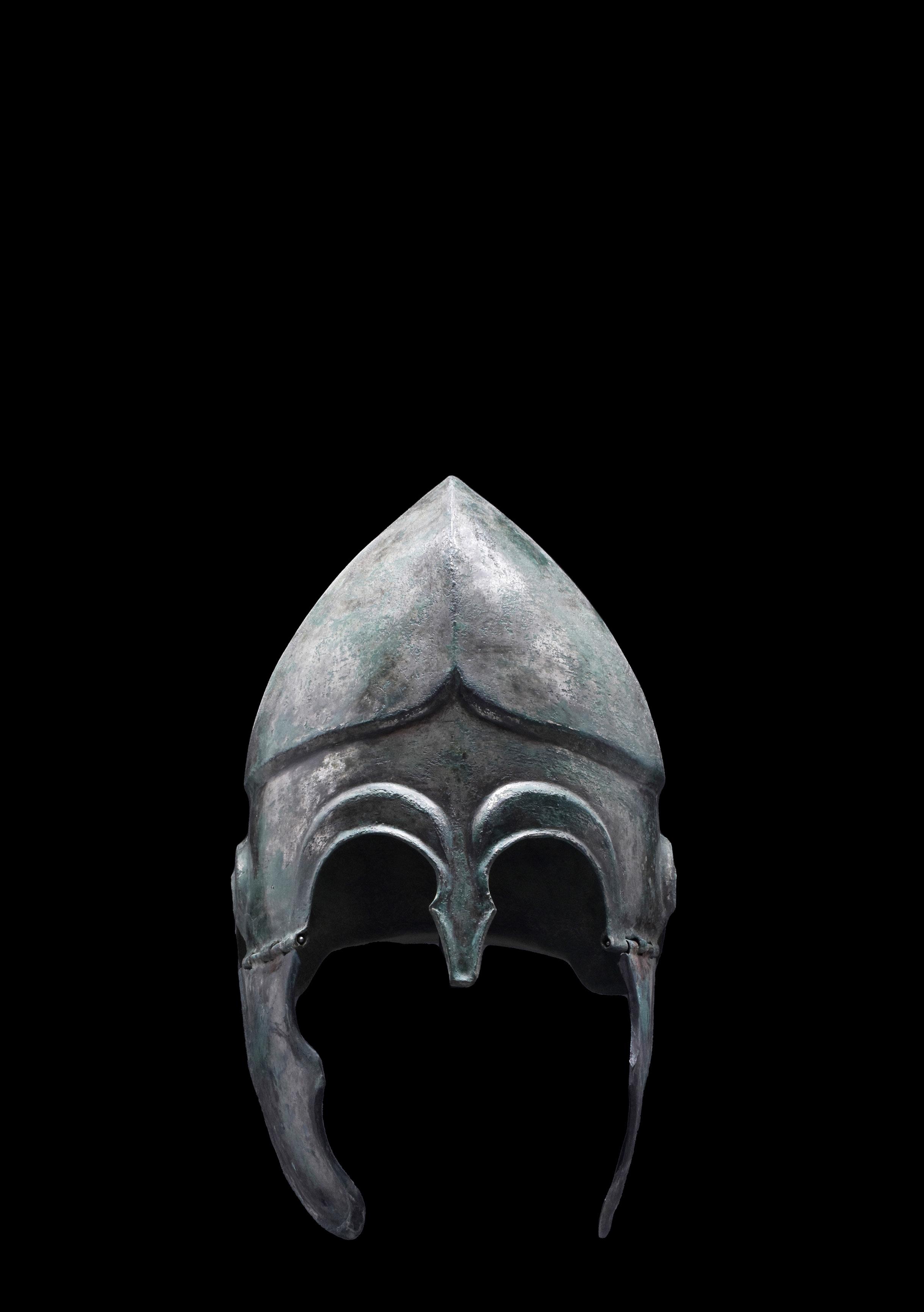
Size: L: 345mm / W: 285mm; 1.16kg.
Provenance:
cheeky guards with contoured edges are attached by hinges on the sides, rounded, and tapering towards the thin allowing binding. Cf. The Walters Art Museum, Baltimore, accession number 54.2468. The British Museum, London, accession number: 1919, 1119.6. Bonhams, 7th October 2021, lot no 72. Literature: R. Hixenbaugh, Ancient Greek Helmets: A Complete Guide and Catalog, New York, 2019. Ohly, D., Die Ägineten, Die Ostgiebelgruppe, Munich, 1976; Pflug, H., ‘Chalkidische Helme’ in Antike Helme, RGZM Monographien 14, Mainz, 1988, pp.137-150. The Chalcidian-Type helmet started to replace the Corinthian-type helmet on the battlefield in the 5th century BC due to its restrictive attributes. The new versatile Chalcidian form of battle helmet enabled the owner to adapt on the battlefield. The Chalcidian helmet enabled greater sensory perception as the helmet was lighter and made in with senses in mind. By the time of the Peloponnesian War (434-402 BC) the Chalcidian helmet was the most widely distributed helmet in the Greek ranks.Ca. 100-50 BC
Starting price: £8,000
A Buggenum type bronze helmet with a rounded bowl, folded brim, and projection on the top for attaching a plume. This was the most iconic helmet of the Roman army from the 1st century BC. It provided excellent protection while also allowing for a full field of vision. Cf. Musée d’Art Classique de Mougins, Inv. n°: MMoCA774. Size: L: 265mm / W: 215mm; 905g.
Provenance: Property of an European collector; previously in an English private collection, then in an American private collection.

Ca. 500-300 BC
Starting price: £5,000
A superb Chalcidian helmet. The bowl is forged in one piece, featuring high-arched eyebrows with an ear drop-shaped nose guard and a flaring neck-guard. The raised curves demarcating the eyes and the nose guard are decorated with bands of dots. The curved cheek pieces are attached with three hinges. Chalcidian helmets are named after similar helmets depicted on pottery vases from the Euboean city of Chalcis. This type of ancient Greek helmet was a lighter and less restrictive form of the Corinthian helmet. The hinged cheek pieces were anatomically formed to fit closely to the face and tended to curve upwards towards the eye, where large circular openings provided a wider field of view than the Corinthian helmets. For more information on Chalcidian helmets, see Everson, T. (2004). Warfare in Ancient Greece: arms and armour from the heroes of Homer to Alexander the Great. The History Press, 116-124. Size: L: 360mm / W: 310mm; 1.15kg.
Provenance: Property of an European collector; bought from a UK gentleman collection, formed in the 1960s-1990s.
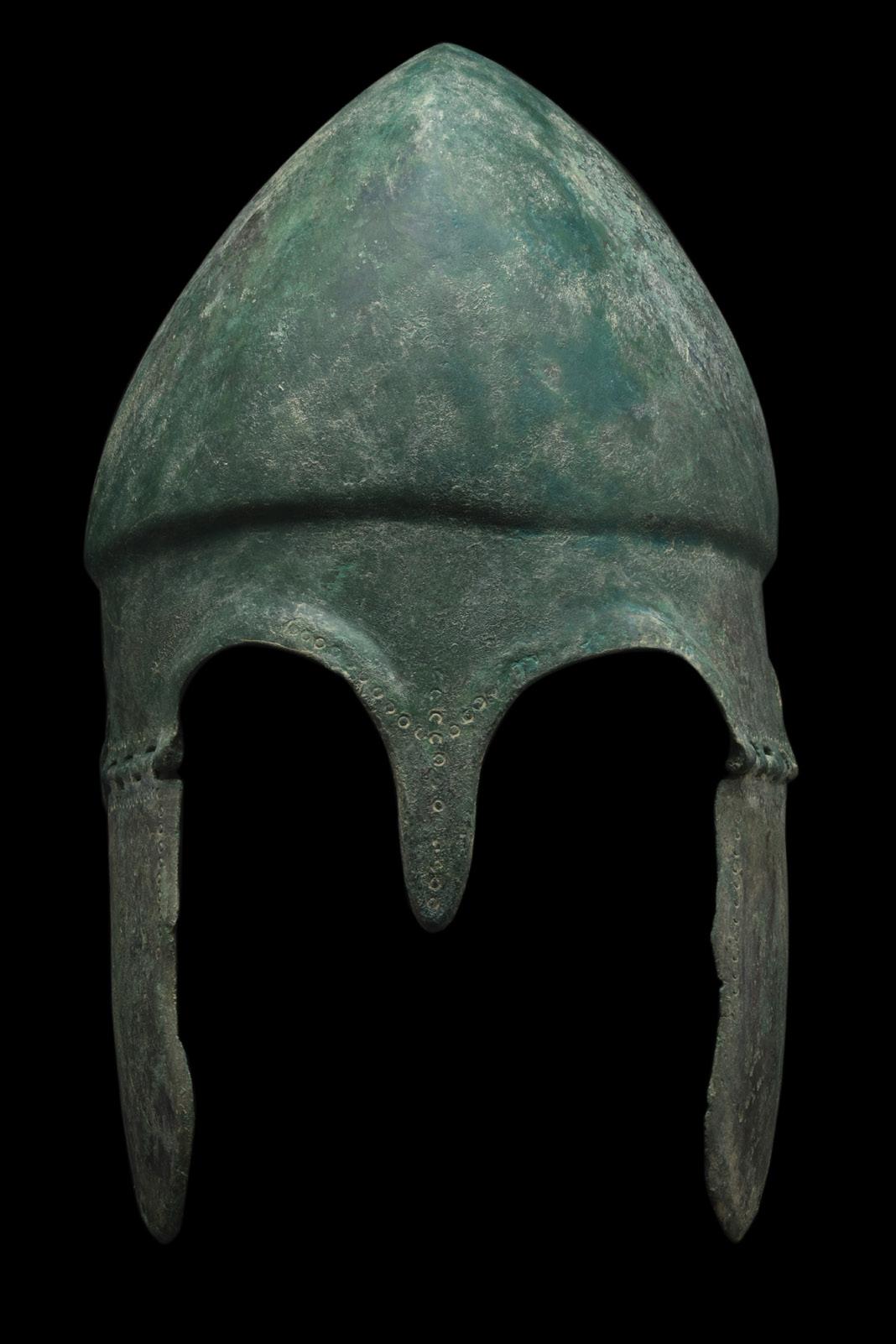
Ca. 1st century BC - 1st century AD
Starting price: £8,000
A relatively light bronze legionary helmet with bulbous domed bowl, small crest knob with flattened top, pierced at the centre for insertion of a crest pin; narrow neck guard with thickened rim; fastening clasps for the cheek-guards inside the bowl. The use of the Etrusco-Italic tradition of the ‘Montefortino’ style helmet continued through the late Consular Age and into the early Imperial period, as shown on the Altar of Domitius Ahenobarbus and on the monument of Flavius Mikkales. See Robinson, R., The Armour of Imperial Rome, New York, 1975, pls.6-25 pp.18ff; Schaaf, U., ‘Etruskich-Römische Helme’ in Antike Helme, RGZM Monographien 14, Mainz, 1988, pp.318-326; D’Amato, R., Arms and Armour of the Imperial Roman Soldier, London, 2009; Christie’s, The Axel Guttmann Collection of Ancient Arms and Armour, part 1, London, 2002, p.102; Travis, H & J., Roman helmets, Stroud, 2014. This lot has been checked against the Interpol Database of stolen works of art and is accompanied by AIAD certificate number no. 10299-168756.

Size: L: 215mm / W: 150mm; 886g.
Provenance: Formerly in the private collection of Mr. M. B., Mainz, Germany, since the 1990s; previously in the Axel Guttman collection.
56.
800-600 BC
Starting price: £8,000
Straight double edged iron blade. Bronze handle, with trapezoid guard, bronze grip, widening towards the middle, where a ridge is formed. Openwork oval pommel. All parts of the handle decorated with cone shape rivets. Dagger with almost identical openwork bronze handle and iron blade is depicted in a table “Kultur der Metalzeit I (Ältere Periode)”, 1900. Size: L: 905mm / W: 100mm; 950g.
Provenance: Property of an European collector; previously in the Ing. Peter Till collection, sold in the UK in 1981; found in 1907, presumably in Austria.
Ca. 100 AD
Starting price: £1,800
An iron pugio, or squat triangular dagger with a midrib and rivet holes to accept a handle. This dagger comes with its beautiful scabbard complete with tassel-like ornaments, and a round chape. The pugio was a sidearm used by Roman soldiers as well as by civilians such as senators or other prominent citizens for self-defense. The weapon is best suited for short, stabbing motions, which would have deadly effects. This item shows signs of restoration. Size: L: 265mm / W: 215mm; 905g.

Provenance: Private UK collection; From an old London collection formed in the 1990s.
100-200 AD
Starting price: £1,000
An iron gladius blade with waisted edges, a triangular tip, and a long tang. The gladius was a key part of Roman military equipment and was used by the empire’s legionaries in close-quarters combat. It is partially thanks to this short sword that Rome was able to control an empire that reached from north-western Europe to the Near East and encompassed all the lands of the Mediterranean. Size: L: 265mm / W: 215mm; 905g.
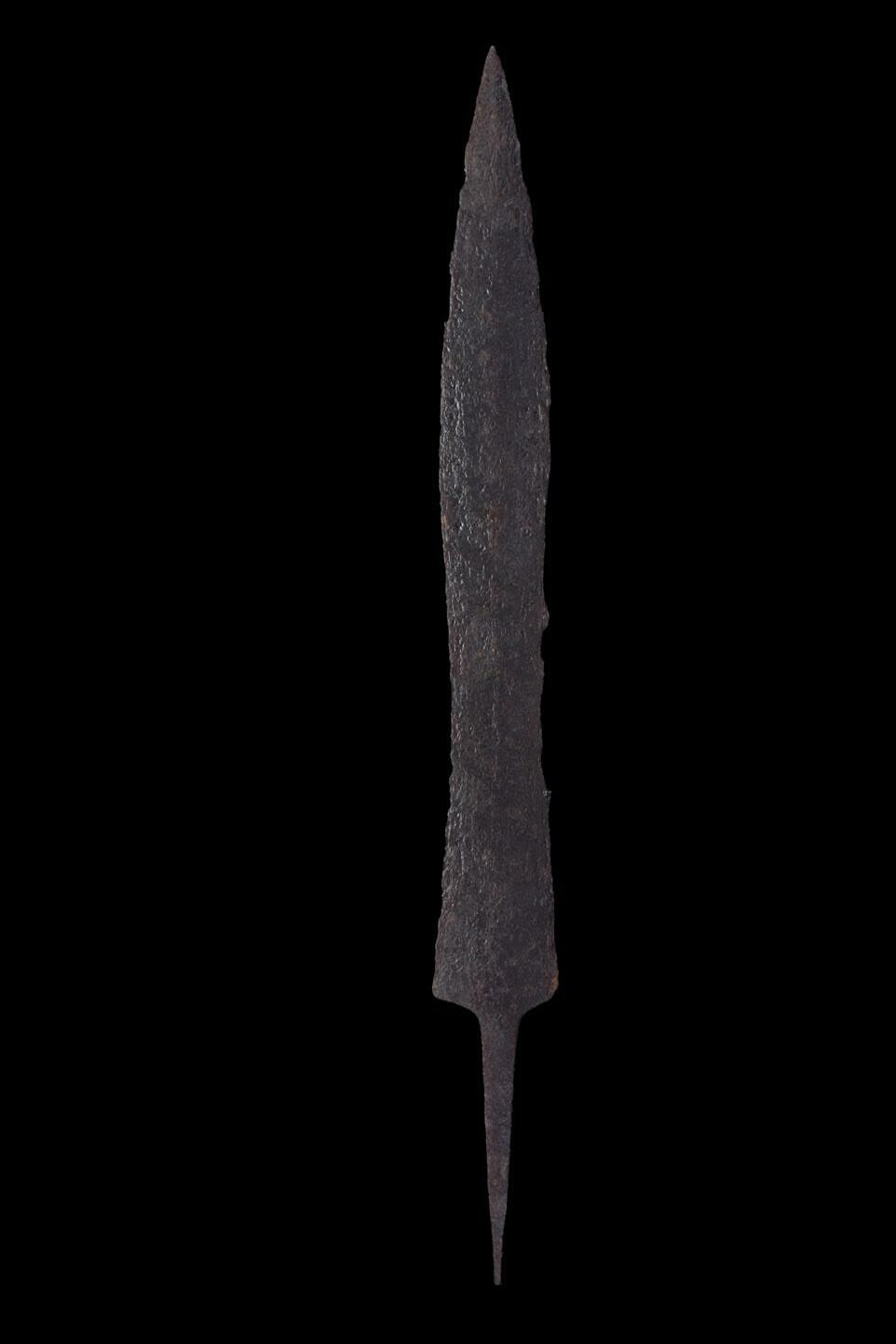
Provenance: Private UK collection; From an old London collection formed in the 1990s.


Ca. Early 3rd century AD
Starting price: £50,000
An over life-sized portrait, gracefully sculpted, the Empress portrayed as a mature woman, her oval shaped face is smooth with a round dimpled chin. Her bow-shaped lips gently ajar, her characteristic bulging almond-shaped eyes articulated with kidney-shaped pupils and drilled irises, her upper lids drooping, the bridge of her slender nose merging with her gracefully-arching brows, their feathering lightly incised, her hair parted in the centre and cascading in undulating waves, framing her face and concealing most of her ears, with a thin braid above the waves, all pulled back into an elaborate braided chignon, with a wispy tendril in lower relief before each ear, and a single tendril falling on the left side of her neck. These details given by the sculptor are a testament to the portrait’s realism and heighten the contrast between the gentle, relaxed, motionless face of the subject and her wavy, heavy, voluminous hairstyle. This portrait thus reflects part of the daily life of Roman women. Christie’s, Antiquities 8890, 5th October 2000, lot 241. Yale University of Art: Accession Number 2010.143.1. Musee de Louvre, Accession Number: MNB 783: MA 1104. Cf.
p. 28.
Size: L: 555mm / W: 270mm; 35.07kg.
Provenance:
Hans Jucker and Dietrich Willers, Gesichter: Griechische und römische Bildnisse aus Schweizer Besitz, exh. cat. (Bern: Archaeologisches Seminar der Universität Bern, 1983), 166-67, no. 68, ill. Flemming Johansen, Roman Portraits: Ny Carlsberg Glyptotek, 3 vols. (Copenhagen: Ny Carlsberg Glyptotek, 1994–95), vol. 3,200 AD
Starting price: £5,000
A finely carved in extremely high relief – virtually in the round – section of a marble sarcophagus depicting the god Eros (Roman Cupid) or one of the Erotes (Roman Cupids) holding a large bunch of harvested grapes in his left hand. Eros, depicted as a nude cherub, is posed standing in contrapposto, with his weight shifted to his left leg, one arm angled to carry the fruit of the vine, the other missing its forearm, perhaps once carrying more grapes (a common theme of Hellenistic and Roman art) or his bow. In addition to possessing an impressive understanding of anatomy and an ability to render flesh from stone, the sculptor of this piece was skilled in communicating naturalism in Cupid’s facial features – generously lidded, almond-shaped eyes, apple cheeks, pudgy nose, and full lips – framed by a wavy coiffure adorned by a leafy crown. Eros was the mischievous yet endearing god of love and, according to some classical writers, a son of the goddess Aphrodite. Size: L: 700mm / W: 260mm; 37.35kg.
Provenance: Property of a Central London Gallery, acquired by a British private collector, formerly in a NYC collection, ex. R. Sorge collection, Germany, 1980s, ex. German collection, Munich, 2000s. Exhibited: Olympia Art & Antiques fair, London June 2022


Ca. 100-200 AD
Starting price: £5,000
A large marble cupid statue carved in the round. Cupid is depicted nude and fleshy, standing and motion to the right, with his right foot, turned outwards. The tree stump behind him is both decorative and a source of support in large statues like this one which lacked the tensile strength of their bronze counterparts. Cupid stands on a square base bearing a Greek-language inscription which reads: “Tatas, son of Theouphistos, [fulfilled this] vow.” Cupid is the god of desire, erotic love, attraction, and affection; perhaps this piece reflects a lover giving thanks to the god for his assistance in an affair of the heart. Good condition. Size: L: 530mm / W: 235mm; 21.75kg.
Provenance: Property of a Central London Gallery, acquired by a private collector, formerly in a private East Coast, USA collection; ex collection from Germany; ex-private Belgium collection, acquired in 1980s.
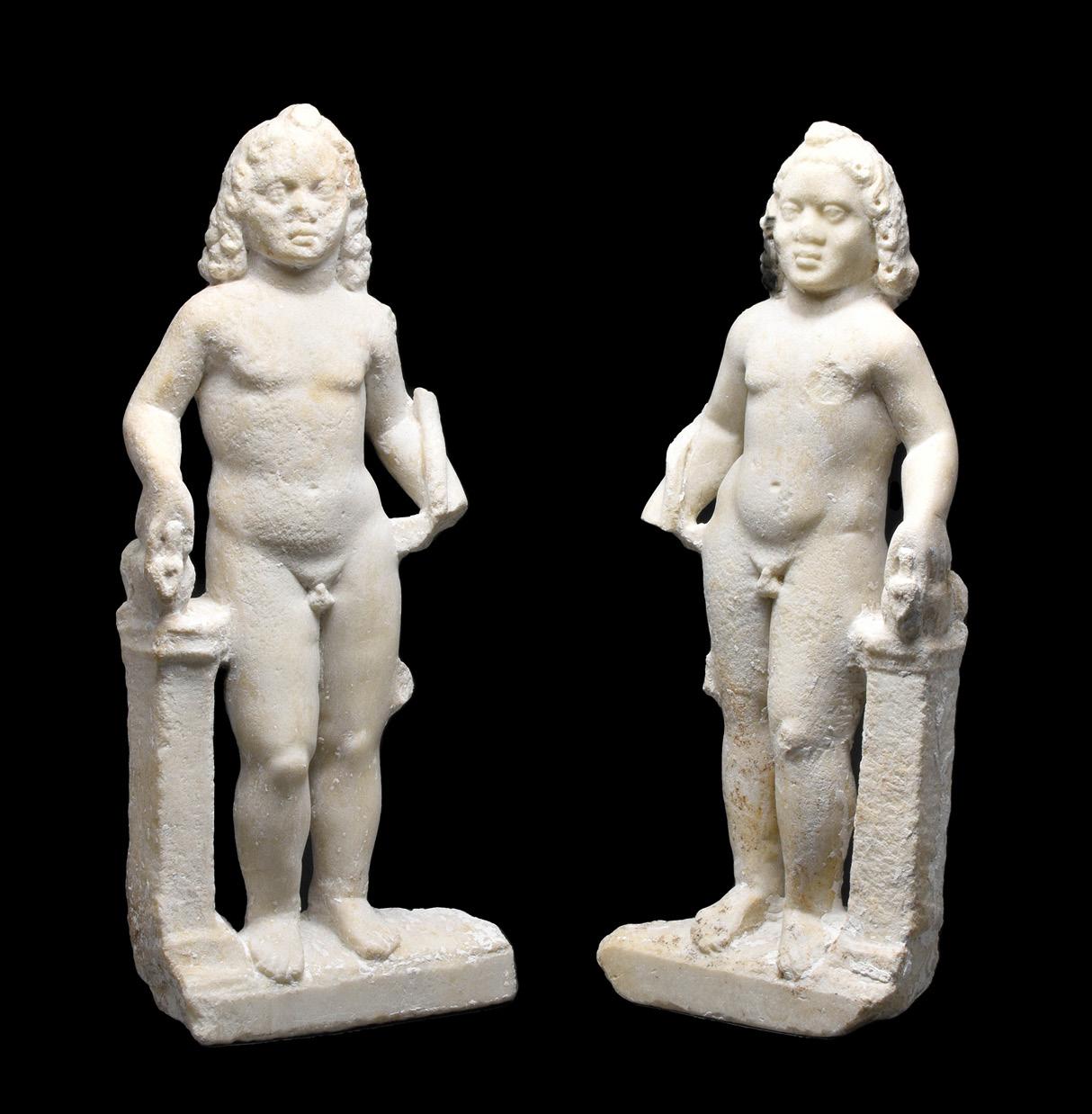
Ca. 200-300 AD
Starting price: £8,000
A pair of beautiful, life-size marble statues of nude children representing Harpocrates, the god of silence and secrecy, each represented elegantly standing on a plinth - one hand resting on a pillar surmounted by a pot, the other arm holding a cornucopia. The oval face framed by long, wavy hair, lotus flower to the top of the head.
See Daremberg & Saglio, Dictionnaire des Antiquités Grecques et Romaines, Paris, 1873-1917; see Jashemski, W.J., The gardens of Pompeii: Herculaneum and the villas destroyed by Vesuvius, II volumes, New York, 1979. Size: L:Set of 2; 665mm/690mm / W:260mm/280mm ; 18.6kg/21kg.
Provenance: From a private French collection; acquired from Helios Ancient Art, London, UK, in 1990; formerly forming part of a West Sussex estate, acquired between 1960s-1970s.
ROMAN MARBLEStarting price: £500
Size: L: 285mm / W: 160mm; 655g.
The Space Venus is a contemporary adaptation of the Large Roman Marble Venus (Lot. 63) created by Matthew Dorabiala, a talented London-based contemporary artist. His practice is heavily inspired by classical masterpieces, such as the aforementioned Marble Venus, which he encountered in our Bloomsbury gallery while searching for inspiration. With help from our digital team, he 3D scanned the marble piece and reimagined it using cutting-edge artistic processes such as CAD software, 3D printing, and 24k gold gilding.
From the artist: The Space Venus aims to address our ongoing relationship with beauty. It achieves this by transcending the appearance of its earth-bound inspiration, the white marble Venus, into a 3D printed reinstallation gilded in 24k gold. Furthermore, the contrast of gold and black symbolizes our fascination with what lies ahead of us.


Starting price: £8,000
A marble torso of goddess Venus (Greek Aphrodite) standing with her weight on her left leg, the right leg slightly bent and advanced. Her slender body is nude and softly modelled. Venus was the god of love, beauty, desire, sex, fertility, prosperity and victory. She was an especially important god for the Romans as she was also the mother of Aeneas, their mythical ancestor. For a similar see The Metropolitan Museum of Art, Accession Number: 42.201.8.
Size: L: 425mm / W: 220mm; 17.06kg.
Provenance: Private London collection; previously in a US private collection formed since the 1980s.

Ca. 100 AD
Starting price: £18,000
A bronze statuette of Jupiter depicting Zeus Brontaios, the Thunderer, modelled in the round after a statuette by Greek sculptor Leochares (mid-4th century BC); the god standing nude with his weight on his right leg, right arm lowered, and left arm raised, originally holding a thunderbolt, now absent; the expressive face framed by curled hair and beard, the eyes inlaid with silver and hair tied back with a laurel crown; well-defined muscular torso and legs; mounted on a custom made display base. See Leventi, ‘Zeus’ in LIMC, nos 195a and Leventi and Machaira, ‘Zeus’ in LIMC, nos. 243-244; Kaufmann-Heinimann, A., Die romischen Bronzen der Schweiz I, Augst 1977, no.17; Christie’s Antiquities, New York, 4 June 2008, lot 255; cf. also The Metropolitan Museum, accession numbers 22.139.37 and 1997.159, for Jupiter figures in a similar style. Size: L: With stand: 180mm / W: 50mm; 495g.
Provenance: Property of a Sussex, UK, private collector; acquired in Munich, Germany in 2014; formerly acquired on the Bavarian art market in the 1990s; Art Loss Register Certificate: number 7944.CV dated 15 December 2014.
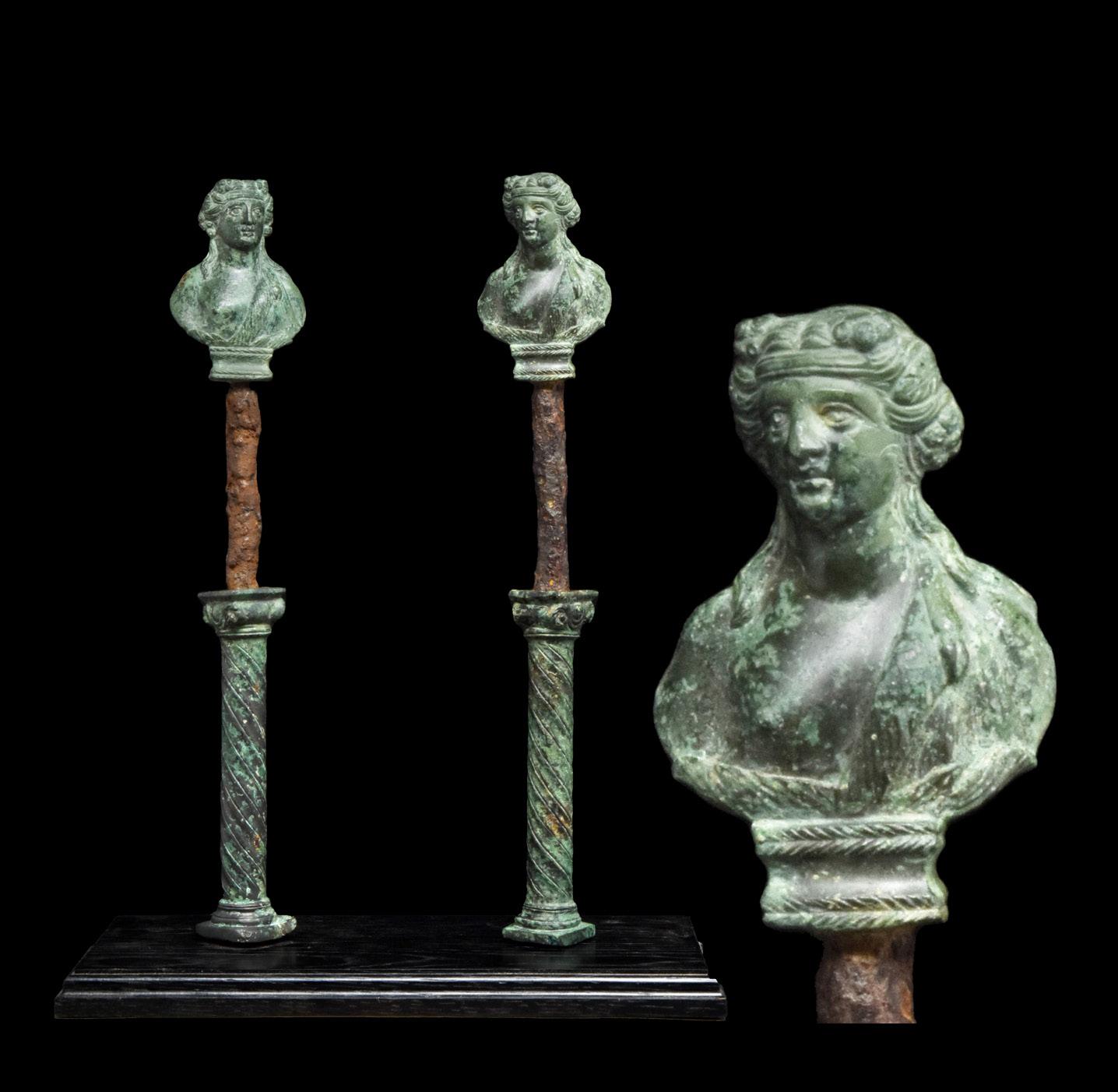
Ca. 100-300 AD
Starting price: £7,500
A very fine bronze statuette of Ceres (Greek Demeter), the goddess of agriculture and fertility, depicted standing and wearing a long sleeveless Ionic chiton with himation around the head, fastened on the left side of the body; wearing a tutulus on her head, the right arm raised to hold a staff, the left arm covered by a mantle, the left hand probably originally held a sheaf of wheat, sandalled feet partially visible; finely modelled face; mounted on a custom-made display stand.
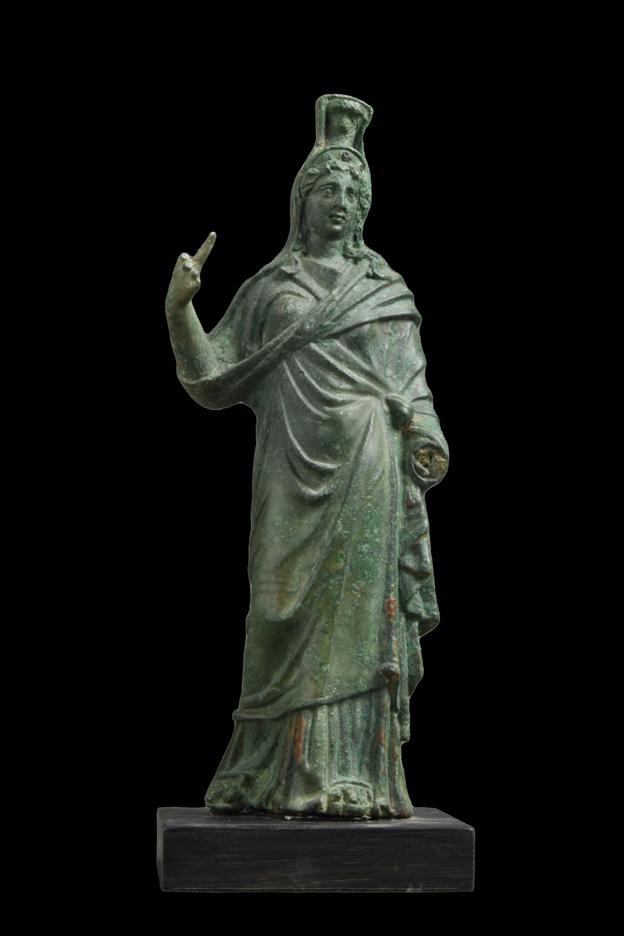
See Daremberg & Saglio, Dictionnaire des Antiquités Grecques et Romaines, Paris, 1873-1917, sub voce Ceres; see for a similar Roman statuette Reinach, S., Repertoire de la statuarie grecque et romaine, Paris, 1930, p.242, no.7, 243 no.1; for discussion on the use of such statues as Lares see Sharpe, H.F., ‘Bronze Statuettes from the Athenian Agora: Evidence for Domestic Cults in Roman Greece,’ in Hesperia: The Journal of the American School of Classical Studies at Athens, Vol. 83, no.1, January-March 2014, pp.143-187. Size: L: 205mm / W: 90mm; 536g.
Provenance: From the collection of a Kensington gentleman; previously in the Weber family collection, UK, 1980s.
67.
Ca. 100-300 AD
Starting price: £5,000
An outstanding pair of bronze and iron fittings, each one comprising a spiral fluted column with an iron rod projecting from the Ionic-variant capital that is surmounted by a bust of Bacchus wearing a goat pelt with a hoof falling over his shoulder. Aside from this, his chest is revealed with delineated nipples. Father Liber (Liber Pater) or Bacchus was the god the Romans identified with Dionysus, the Greek god of wine and fertility. He has come to be associated particularly with drunkenness and lascivious behavior. Thus, even today people speak of having “bacchic rites,” referring back to ecstatic and frenzied Dionysian or bacchic festivals such as those that take place in Euripides’ play the Bacchae. Size: L: 375mm / W: 300mm; 2.7kg.
Provenance: Ex. Christies New York, December 5th. 2012, Sale 2605, Lot. 75.

Ca. 100-300 AD
Starting price: £900
A pair of bronze chariot appliqués, each with a bust formed separately and mounted at the centre, each comprising a discoid body with domed inner ring decorated with concentric circles, busts modelled in the round presenting nude male figures, hollow from the neck down at the reverse, with semi-naturalistic detailing to the torsos, nipples, almond-shaped eyes, brows, noses, mouths and fleshy chins, hair arranged into short waves, rectangular slot to the back of each head for attachment; mounted on a custom-made display stand. Cf. The British Museum, museum number 1854,0717.53, for a comparable chariot fitting, dated c.1st century AD; s. also Gudea, N., Porolissum. Un complex arheologic daco-roman la marginea de nord a Imperiului roman. II. Vama romana (monografie arheologica”). Contributii la cunoasterea sistemului vamal din provinciile dacice Cluj-Napoca, 1996, p.180; Palagyi, T., Facsady, A., Romains de Hongrie, Lyon, 2002, nos.83-84. Size: L: 145mm / W: 140mm; 530g.
Provenance: London art gallery; ex. property of a gentleman from Vienna, from his private collection formed since the 1970s.
69.RARE ROMAN
Ca. 200-300 AD
Starting price: £15,000
A charming cast-bronze statuette of a bear standing on its two slender back legs and holding a round and shallow container to be filled with oil. The bear’s body is detailed by a series of incised impressions meant to imitate the curls in natural fur, whilst its face is rendered with naturalistic features. Oil lamps were the most common items in Roman Empire, and essential for the day to day life, as the only source of light. Size: L: 145mm / W: 140mm; 530g.
Provenance: Property of a London collector A.J. Acquired from Rasoul Gallery, Mayfair, 1996. Formerly in an old European family collection formed in the late 70s.

Ca. 200 AD
Starting price: £5,000
A cast bronze decorative tripod stand with an oil lamp. The feet are rounded, abstract forms that suggest the paws of an animal; a heavy, skirt-like form is around the legs. Above that is an elegant, columnar leg with various disc-like forms along its length. It is capped by a steep-walled, circular bowl with a spike through it to attach to the lamp. The lamp with head of Cupid, conjoined by a mirror. Size: L: 520mm / W: 198mm; 3kg.
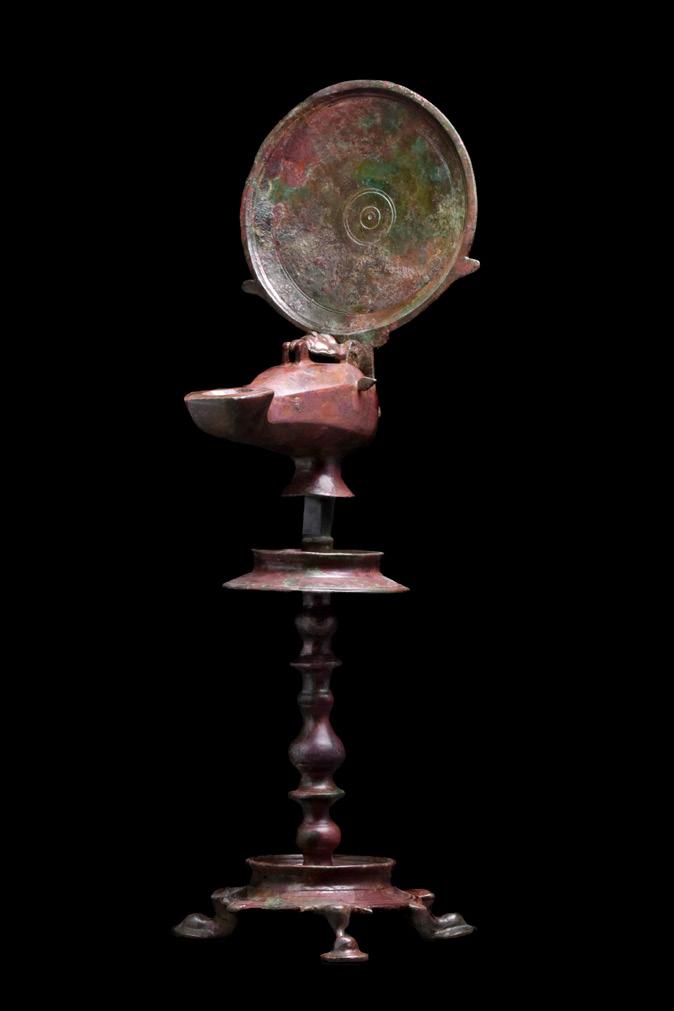
Provenance: Property of a North London professional; previously acquired on the UK art market in early 1990s; ex. Munro Walker collection.
Ca. 400-500 AD
Starting price: £1,800
A Late Roman bronze jug rising from a flared short foot. The vessel features an inverted piriform lower body with ribbing features, flaring to a gracefully-shaped neck and ending with a nicely formed mouth with a flat rim. The stylized figural handle connects the shoulder with a mouth and the base of the handle is decorated with a face mask, while the opposing end bears an image of a large palmette. Size: L: 370mm / W: 190mm; 2.32kg.
Provenance: Property of a West London gentleman; previously in a collection formed on the UK/ International art market in the 1990s.
Ca. 300 - 400 AD
Starting price: £1,800
A bronze jug with a flaring step rim, restricted neck, piriform body, and a long figural handle with a plate in the form of a head of a bearded man. Wine drinking was an important part of Roman culture. This beautiful vessel would have been used for the serving of wine, which was often consumed mixed with spices or honey. Size: L: 270mm / W: 150mm; 1.64kg.

Provenance: Property of a West London gentleman; previously in a collection formed on the UK/ International art market in the 1990s.
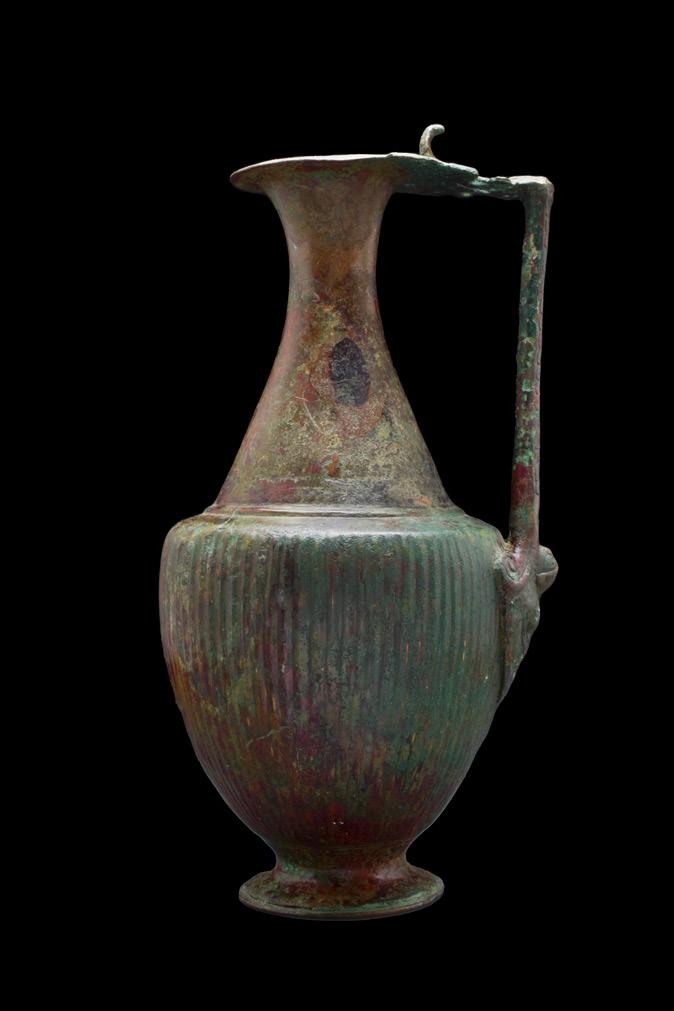
Ca. 200 AD
Starting price: £1,800
A silver kylix with a hemispherical bowl resting on a concave foot and two equally spaced loop handles. Decorated on the exterior with circumferential grooves just below the rim. Size: L: 60mm / W: 170mm; 275g.

Provenance: Private London collection (B.A.); formerly acquired in the 1970s from John Lees collection.
Ca.
Starting price: £5,000
A beautiful cast-bronze oil lamp in the shape of a right foot wearing a sandal. This type of lamp was widespread in the first two centuries AD. It is likely that they were associated with the Eastern cult of Serapis, and it is no coincidence that this type of lampstand was popular among the legionaries positioned on the outskirts of the Empire, who were among the first to adopt and then spread the cults of Eastern deities among the population of the Roman Empire. For a similar example, see Christie’s, Live Auction 2007, Antiquities, 4 Jun 2008, Lot 252. Scientific sources : cf. Siegfried Loeschcke, Lampen aus Vindonissa, Zurich (1919), pl. XXIII:1084-1085, p. 161F for a discussion; Bailey, Donald M. A Catalogue of the Lamps in the British Museum, IV, Lamps of Metal, and Stone, and Lampstands. London: British Museum Press, 1996. Size: L: 50mm / W: 165mm; 410g.
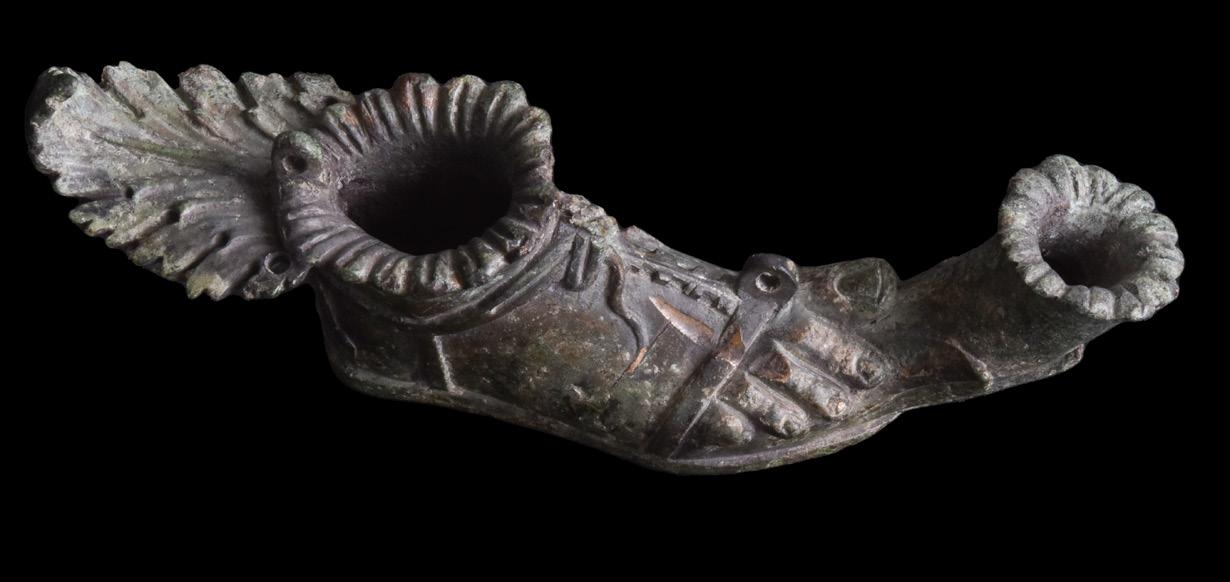
Provenance: Property of an European collector; bought from a UK gentleman collection, formed in the 1960s-1990s.

Ca. 300 BC - 400 AD
Starting price: £2,000
A large group of terracotta oil lamps of various types, including Greek, Roman, Islamic and Byzantine. The collection comes with a detailed book containg the paperwork for each one of them - including date, origin and place of acquisition. Each with a rounded body, a spout, and a central filling hole. Mostly with nice details and decoration. Size: L: 80-95mm / W: 50-65mm; 1.65kg.
Provenance: From the collection of a London doctor; previously in a part of a private collection, bought 1970/80s, Southport Lancashire.
76. ROMAN REDWARE MORTARIUM WITH RAM SPOUT Ca. 100-300 AD
Starting price: £900
A redware mortarium with a flanged rim and a conical shape. It tapers to a flat base. The interior has incised pattern of radiating lines in tondo. The raised bowl edge terminates in a cylindrical-shaped funnel in the form of a ram. For another Roman mortarium see National Museum Wales: 82.11H/24.1. Size: L: 123mm / W: 340mm; 1.8Kg.

Provenance: London Ancient Art Gallery 2000, Ex High Wycombe Estae Collection; Ex. UK art market 1990s. Exhibited: Olympia Art & Antiques fair, London June 2022.
77. HUGE ROMAN GLASS PLATE
Ca. 50-300 AD

Starting price: £3,000
A stunning glass plate in a greenish-blue fabric with an outward folded rim, hemispherical bowl and applied ring foot. Two dolphin-shaped applied handles are attached to each side of the plate, just below the rim. This beautiful piece corresponds to an Isings form 5 (C. Isings (1957), Roman Glass from Dated Finds) which was popular from the Claudian-Neronian period until the 3rd century. Roman glassmaking reached the farthest corners of the Empire and flourished until about 400 AD, when the Roman Empire started to disintegrate, finally falling in the late 5th century AD. This plate would have been used as fine tableware for serving food. Size: L: 290mm / W: 325mm; 670g.

Provenance: Important London collection of Ancient art; formed in 1970-80s then passed by descent. Exhibited: Olympia Art & Antiques fair, London June 2022.
78.
Ca. 100-300 AD
Starting price: £500
A rare, yellow-green coloured glass dish with a folded broad rim. The interior surface is plain whilst the outside is decorated with a floral pattern radiating from the centre of the base. Good condition. For more information, see Bayley, J., Freestone, I., & Jackson, C. (2015). Glass of the Roman World. Oxford And Philadelphia: Oxbow Books, 88; 135. Size: L: 60mm / W: 200mm; 247g.
Provenance: From the private collection of Mr. R. Unger; previously with a London gallery; acquired in the 1990s on the UK art market.
79.
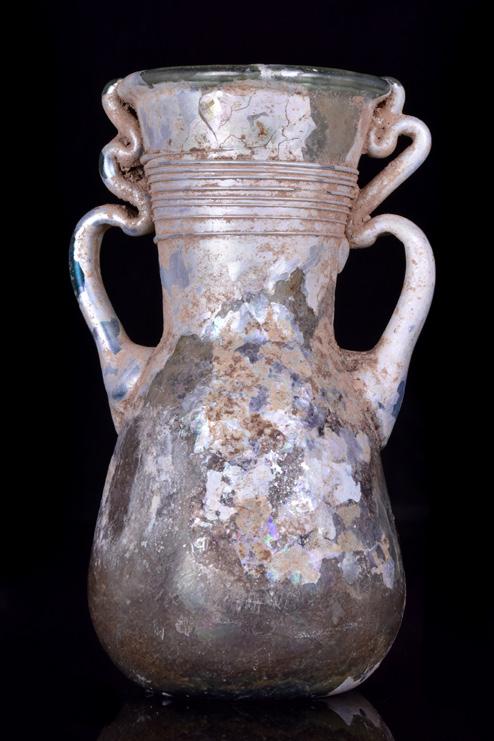
Ca. 200-300 AD
Starting price: £900
An elegant Ancient Roman blown light green glass jug. For a similar see Roman Glass in the Corning Museum Volume 1-3. For further reading on Roman glass: Bergman, S.; Ancient Glass, Carnegie Museum of Natural History, Pittsburgh. Bianchi, Robert S.; Reflections on Ancient Glass, from the Borowski collection. Size: L: 170mm / W: 90mm; 103g.
Provenance: Private London collection; acquired in the 1990s on the UK art market.

Ca. 200–300 AD
Starting price: £900
A blue-green, free-blown glass jug. Example of a similar Roman jug sold at Christie’s: Lot 567300. Size: L: 184mm / W: 110mm; 163.2g.
Provenance: Property of a North London gentleman; previously acquire on the UK/ European art market in the 1980s. Exhibited: Olympia Art & Antiques fair, London June 2022.
81.
Ca. 300 AD
Starting price: £900
A beautiful light blue jug with a globular body resting on a low ring foot, a cylindrical neck featuring a deep blue tooling, an outsplayed rim and thickened lip. Accretions inside. For a similar piece, see Harden, D. B. (1987). Glass of the Caesars. Milan: Olivetti. p. 147. Very rare type of handle with three knots; fantastic state of preservation. Size: L: 108mm / W: 72mm; 66.2g.
Provenance: From an old British collection, acquired on the UK art market in the 1980s.
82.
Ca. 200-300 AD
Starting price: £900
A one-handled jug in a translucent green palette with a conical body, a tall, tapering cylindrical neck, and strap handle with thumb rest in a darker green colour which joins the shoulder with the back of the trefoil spout. The body comprises several rows of concave hemispherical mould-blown decoration. Size: L: 153mm / W: 68mm; 113.8g.


Provenance: Private collection of a West London gentleman; previously in a collection formed on the UK/International art market before 2000.
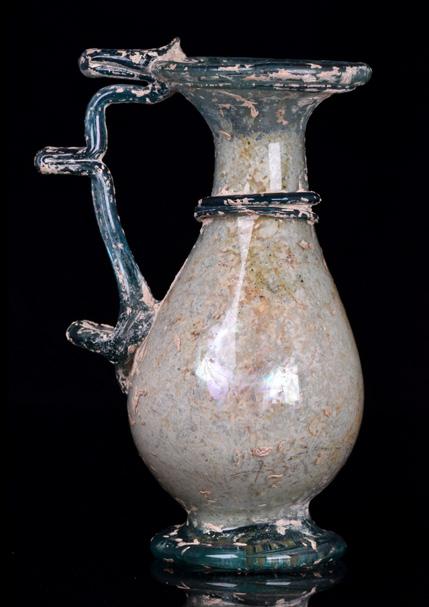
Ca. 100-200 AD
Starting price: £500
A beautiful blown flask with an ovoid-shaped body, funnel-shaped neck with ribbed horizontal decoration, and two vertical trailed handles. To find out more about glass objects in the Roman world, Bayley, J., Freestone, I., & Jackson, C. (2015). Glass of the Roman World. Size: L: 130mm / W: 83mm; 99.6g.
Provenance: From the private collection of an Essex gentleman; previously in an old British Collection, formed in the 1980s.

Ca. 300 AD
Starting price: £500
Translucent green; handles in the same color. For a very similar glass jar in the Museum of Metropolitan Art Collection, see accession number: 81.10.14. Size: L: 123mm / W: 110mm; 202.2g.
Provenance: Private UK collection; acquired in London before 2000.
Ca. 100-300 AD
Starting price: £1,000
A rock crystal intaglio bearing an engraved gryllos motif, comprising a bust of left-facing Minerva wearing a plumed helmet, and two bearded men, one in the nape of her neck, the other on top of the head, set in a possibly later gold ring comprising D-shaped hoop with amphora-shaped shoulders. Size: D: 18.54mm / US: 8 1/2 / UK: Q1/2; 14g.
Provenance: From the private collection of Mr. R. Unger; previously with a London gallery; acquired in before 2000 on the UK art market.
300 AD
Starting price: £500
A gold finger ring with a D-shaped hoop and a slightly raised, rectangular bezel bearing the inscription “FIDEM” (“Loyalty”). It is thought that inscriptions of this type express loyalty to the reigning emperor, indicating that this piece probably belonged to a Roman legionary or centurion. Excellent condition; wearable. For a comparable example, see Christie’s, Live Auction 1313, Ancient Jewelry, 11 December 2003, Lot 519. Size: D: 18.34mm / US: 8 1/4 / UK: Q; 4.44g.

Provenance: Private London collector, acquired on the Austrian Art market; formerly in an old USA collection, formed since the 1970s.

Ca. 100-200 AD
Starting price: £1,800
A rare gold ring with a circular hoop featuring an elliptical deep green jasper intaglio setting. The intaglio depicts the myth of Leda and the Swan, an important motif in classical art. Size: D: 12.78mm / US: 1 1/2 / UK: C; 11g.
Provenance: Property of a W. L. G.; previously in a collection formed on the UK/International art market in the 1980s.
Ca. 100-300 AD
Starting price: £1,800
An amazing gold ring comprising a slender hoop with elaborately decorated shoulders and raised bezel with banded agate intaglio depicting the bust of helmeted god Mars above advancing gryphon. Good, wearable condition. Size: D: 19.15mm / US: 9 1/4 / UK: S; 21.93g.
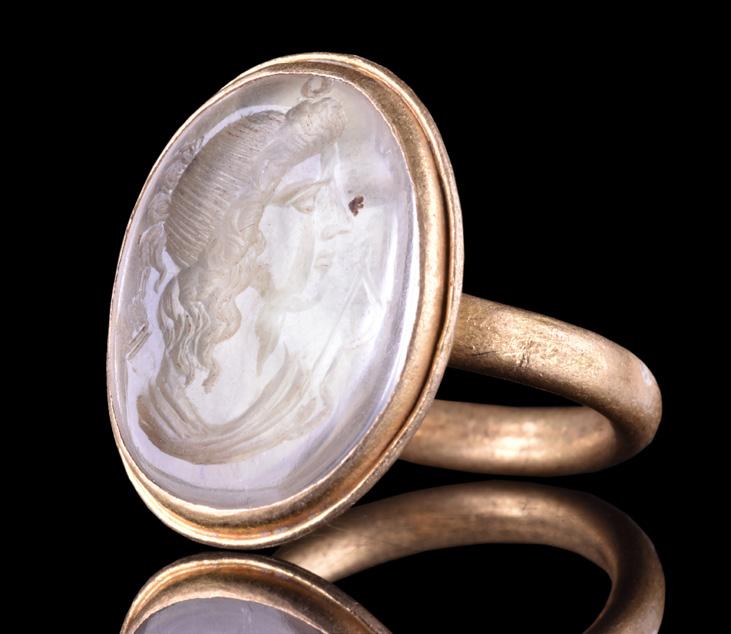


Provenance: From the private collection of Mr. R. Unger; previously with a London gallery; acquired in before 2000 on the UK art market.
89.
Ca. 100-300 AD
Starting price: £1,500
A gold finger ring composed of a tapering hoop with faceted shoulders supporting an amethyst intaglio engraved with a dynamic scene of a man riding a donkey. The ancient Romans considered jewellery to be an essential dressing accessory, for it provided a public display of their wealth. Size: D: 18.14mm / US: 8 / UK: P 1/2; 10.32g.

Provenance: From the private collection of Mr. R. Unger; previously with a London gallery; acquired in before 2000 on the UK art market.
90.
Ca. 100-200 AD
Starting price: £1,500
An oval rock crystal intaglio depicting a right-facing female bust, flanked by quiver and arrows. The latter led to identifying this female portrait as a depiction of the Roman goddess Diana. The intaglio is set in a possibly later gold ring comprising a simple yet elegant design.
Size: D: 17.32mm / US: 7 / UK: N 1/2; 6.78g.
Provenance: Property of a London collector; formerly in a Japanesse collection formed in the 1990s.
ROMAN GOLD RING WITH DONKEY RIDER AMETHYST INTAGLIO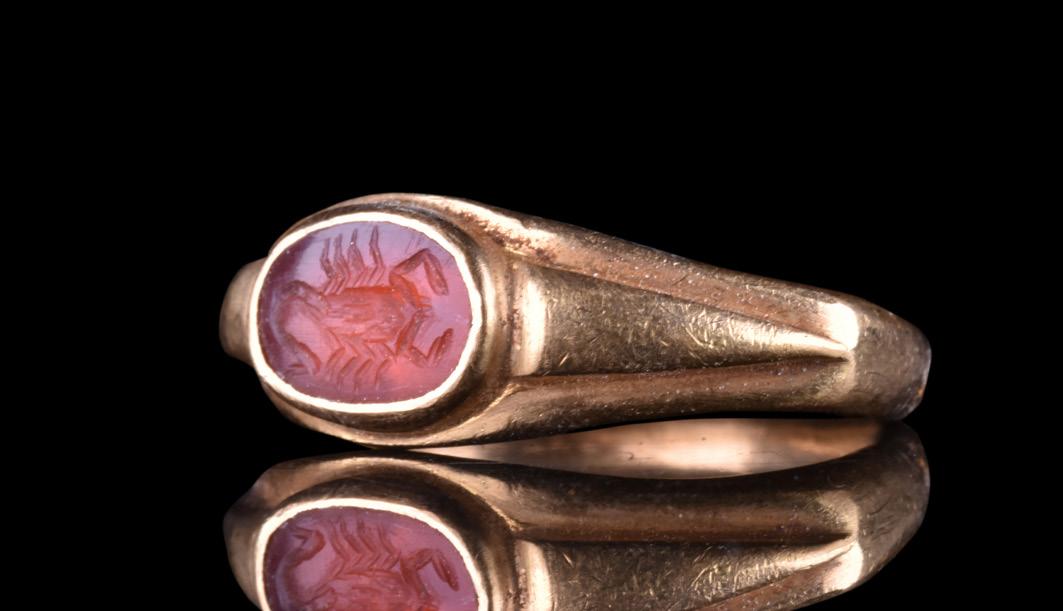
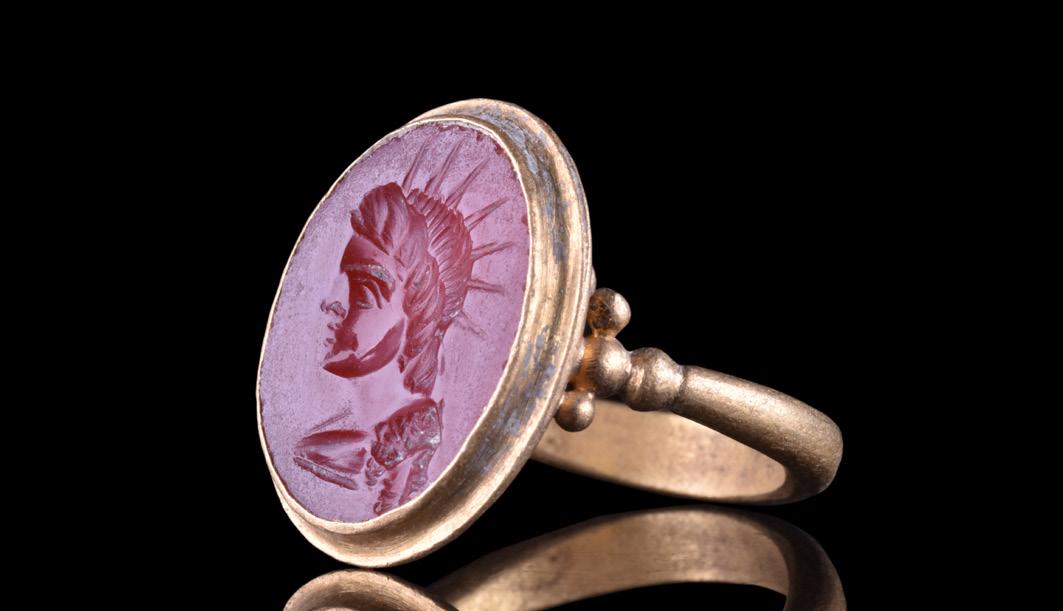
Ca. 200 AD
Starting price: £1,000
A red gem intaglio bearing an engraved bust of Sol Invictus wearing a radiate crown set in a possibly later gold ring with tapering hoop, and filigree shoulders. Sol Invictus (Latin “Unconquered Sun”) was a major divinity in Late Roman Religion. Sol Invictus was a patron of soldiers and became part of the official state religion in AD 274 under Emperor Aurelian. The cult continued into the 5th century. The connection between Sol and soldiers means that this item may well have belonged to a Roman legionary, who wore it in hope of protection during military campaigns. Superb condition. Wearable. Size: D: 17.93mm / US: 7 3/4 / UK: P; 7.6g.
Provenance: Property of a London collector; formerly in a Japanesse collection formed in the 1990s.
Ca. 100-200 AD
Starting price: £1,000
A gold ring with a circular band, flared shoulders, and an oval bezel set with a carnelian gem depicting a scorpion. The ring is in excellent condition and it is suitable for modern wear. The scorpion was the emblem of the Praetorian Guard, the Roman emperor’s personal army elite unit. Cf. Russell, A., Hellström, M. (2020). The social dynamics of Roman imperial imagery. Cambridge: Cambridge University Press. Cf. Gisela M. A. Richter, Catalogue of Engraved Gems Greek, Etruscan, Roman; Metropolitan Museum of Art, New York, Plate LXII, 533. Size: D: 16.71mm / US: 6 1/4 / UK: M; 12g.
Provenance: Property of a London collector; formerly in a Japanesse collection formed in the 1990s.
Ca. 1-100 AD
Starting price: £1,000
A finely rendered pair of gold earrings, each formed from a twisted wire hoop, which tapers towards one end and on the other displays an intricately decorated plinth on which a glass head with negroid features is placed and secured with gold wire from above. Size: L: 39.140.5mm / W: 18.3-21.4mm; 15.04g.

Provenance: From the private collection of Mr. R. Unger; previously with a London gallery; acquired in before 2000 on the UK art market.
Ca. 2nd century AD
Starting price: £1,000
A large sardonyx cameo with a finely carved depiction of a bust of Faustina II set in a gold pendant or brooch setting. She is portrayed in her right profile with delicate face details, and her hair is pulled back to a chignon. Annia Galeria Faustina the Younger (ca. 130 AD-175/176 AD) was a daughter of Roman Emperor Antoninus Pius and Roman Empress Faustina the Elder. She was a Roman Empress and wife to Marcus Aurelius. Size: D: 17.32mm / US: 7 / UK: N 1/2; 6.78g.
Provenance: Private London collection, formerly acquired on the US art market from I. G.; formerly in an old US collection formed before 1980s.
 WITH SCORPION CARNELIAN
WITH SCORPION CARNELIAN
USHABTI
New Kingdom, Ca. 1292 -1077 BC, 19th20th Dynasty, Ramesside Period
Starting price: £100
A mummiform shabti formed of painted pottery is wearing a bipartite or duplex wig that is painted black. Size: L: 210mm / W: 60mm; 245g.
Provenance: Private London collection; ex. B. Kickx and J. Peeters collections, pre 1978, Belgium.
Late Dynastic Period, Ca. 664-332 BC
Starting price: £100
A pale turquoise faience Egyptian shabti modelled with a tripartite wig and false beard. His arms are crossed and holding agricultural tools in his hands. A T-shaped panel of hieroglyphic text has been inscribed on the front of the shabti. Size: L: 195mm / W: 55mm; 265g.
Provenance: Private London collection; ex. B. Kickx and J. Peeters collections, pre 1978, Belgium.
97.
Ca. 664-525 BC
Starting price: £100
An ancient Egyptian funerary statuette with a mummy shaped body and back pillar standing on a small base plate. Including a vertical column of framed hieroglyphs engraved on the front. Size: L: 110mm / W: 30mm; 45g.


Provenance: Private London collection; ex. B. Kickx and J. Peeters collections, pre 1978, Belgium.
USHABTI
Late Dynastic Period, Ca. 664-332 BC
Starting price: £100
A mummiform figure in the form of an ushabti, moulded in a light-blue, glazed faience, wearing a tripartite wig and divine braided beard. The chest with folded arms, clenching a pick and hoe. Size: L: 128mm / W: 40mm; 70g.

Provenance: Private London collection; ex. B. Kickx and J. Peeters collections, pre-1978, Belgium.
USHABTI
Early Third Intermediate Period, Ca. 1070-945 BC
Starting price: £100
A mummiform ushabti wearing a pain tripartite wig and a divine beard. The front lappets of the wig have horizontal lines on the lower edge. The arms are crossed on the chest, and the hands hold a pick and a hoe. Size: L: (with stand) 210mm / W: 40mm; (with stand) 180g.

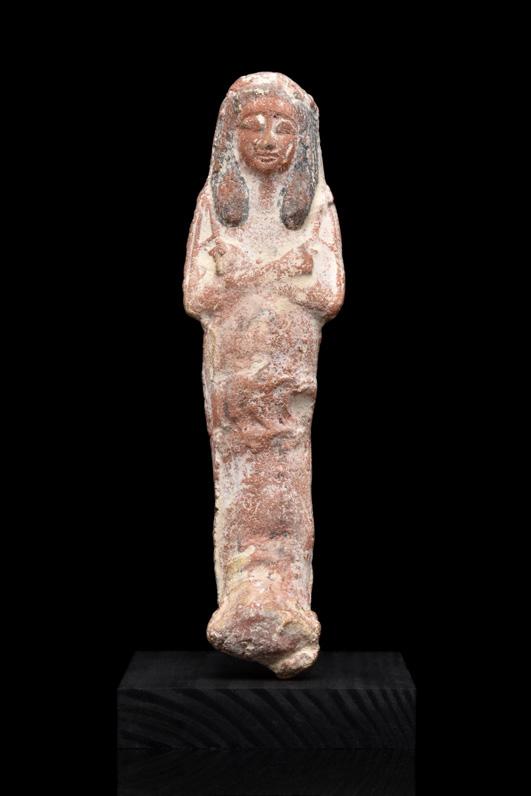
Provenance: Private London collection; ex. B. Kickx and J. Peeters collections, pre 1978, Belgium.
Late Dynastic Period, Ca. 664-332 BC
Starting price: £100
An ancient Egyptian blue faience ushabti. The mummiform figurine wears a tripartite wig, his crossed hands hold hoes. During the Late Period the tomb figures became known as ushabtis (‘answerers’), servants who would magically answer when called upon to perform agricultural duties for the Pharaoh in the afterlife Size: L: 150mm / W: 40mm; 110g.
Provenance: Private London collection; ex. B. Kickx and J. Peeters collections, pre 1978, Belgium.


Ptolemaic Period, Ca. 323 BC
Starting price: £100
An ancient Egyptian faience mummiform ushabti wearing a plain tripartite wig and plaited divine beard. The wig is worn low on the forehead and the ears, which are fairly well modelled, protrude over the side lappets of the wig. The arms are crossed on the chest, and the hands hold a pick and hoe. Size: L: 105mm / W: 30mm; 80g.
Provenance: Private London collection; ex. B. Kickx and J. Peeters collections, pre 1978, Belgium.
102.
Thinite Period, 1st-2nd Dynasty, Ca. 3100-2700 BC
Starting price: £500
An early marble vessel in piriform amphora-like shape which widens towards the neck with two central suspension holes for attachment. A rare object with beautiful light marble stone. For other examples of early Egyptian vessels see El-Khouli, A.; Egyptian Stone Vessels Predynastic Period to Dynasty III. Size: L: Without Stand 77mm / W: 39mm; With Stand 225.53g.
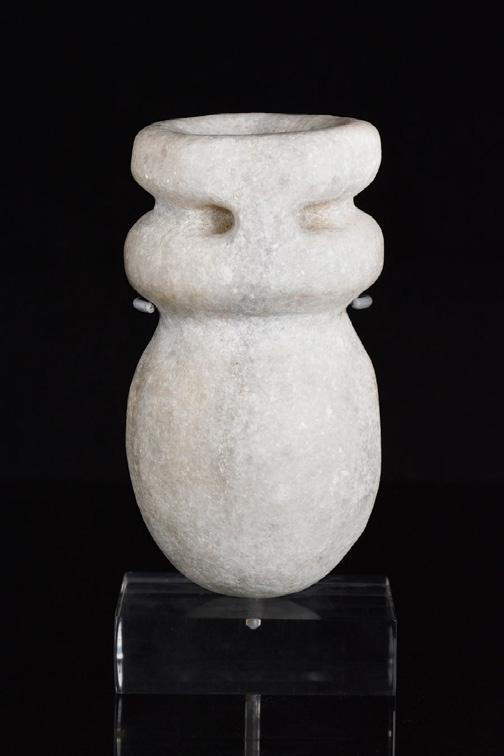
Provenance: London Art Market, Ex New York Gallery pre-2000.
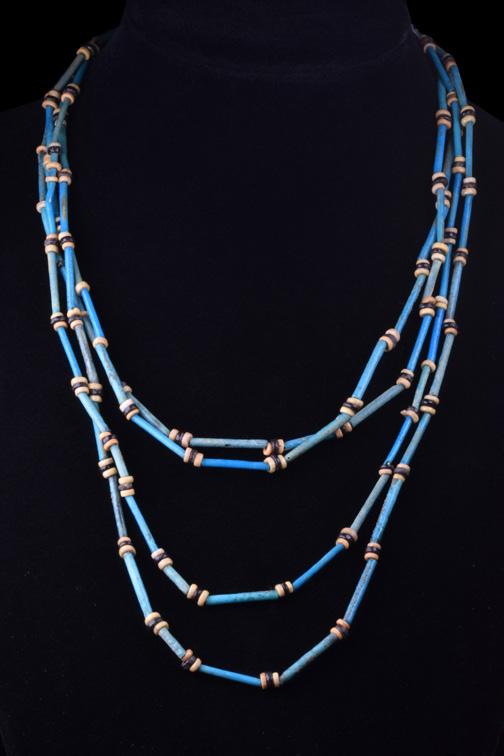
Late Period, Ca. 664-332 BC
Starting price: £200
A long necklace string made of tubular and spherical faience beads arranged in a symmetrical manner. Restrung on a modern thread and suitable for contemporary wear. Size: L: 2160mm / W: 4.9mm; 18.11g.
Provenance: Private UK collection; From an old London collection formed in the 1990s.
Late Period / Ptolemaic, Ca. 712-30 BC
Starting price: £100
A beautiful restrung necklace with tubular and discoid beads as well as a beautiful scarab. Scarabs were artistic depictions of the Egyptian dung beetle. In Egyptian mythology, these insects were linked to the Sun God Ra, who after his death in the Underworld, was reborn as a scarab. Size: L:235mm / W:mm ; 5.6g.

Provenance: Private UK collection; From an old London collection formed in the 1990s.

Late Period / Ptolemaic Dynasty, Ca. 664-30 BC
Starting price: £100
A necklace made of restrung glazed beads with a faience amulet as its pendant. The beads are a range of colours, and a mix of short round beads and long cylindrical ones. Size: L:250mm / W:mm ; 5.9g.
Provenance: Private UK collection; From an old London collection formed in the 1990s.
106.
Late Period, Ca. 663-323 BC
Starting price: £90
Blue glazed faience amulet of the dwarf god Bes. Plumed headdress containing a suspension hole, a gnarling, somewhat-leonine head, and the body of a squatting dwarf. Amulets of Bes were commonly worn to protect children and new mothers. Size: L:33mm / W:17mm ; 6g.
Provenance: From an old British collection of Ancient Art formed in the 1990s on the UK and European art market.

107.

Late Period, Ca. 663-323 BC
Starting price: £300
An ancient Egyptian mummy shroud of beadwork from the chest of a mummified person, consisting of a net of dark green barrel and light green tubular beads. Size: L: 255mm / W: 150mm; 94g.
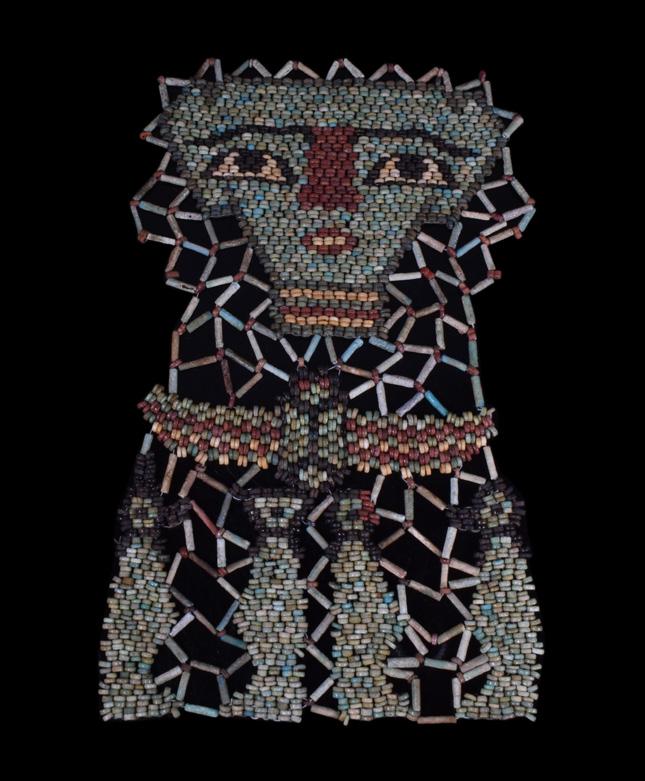
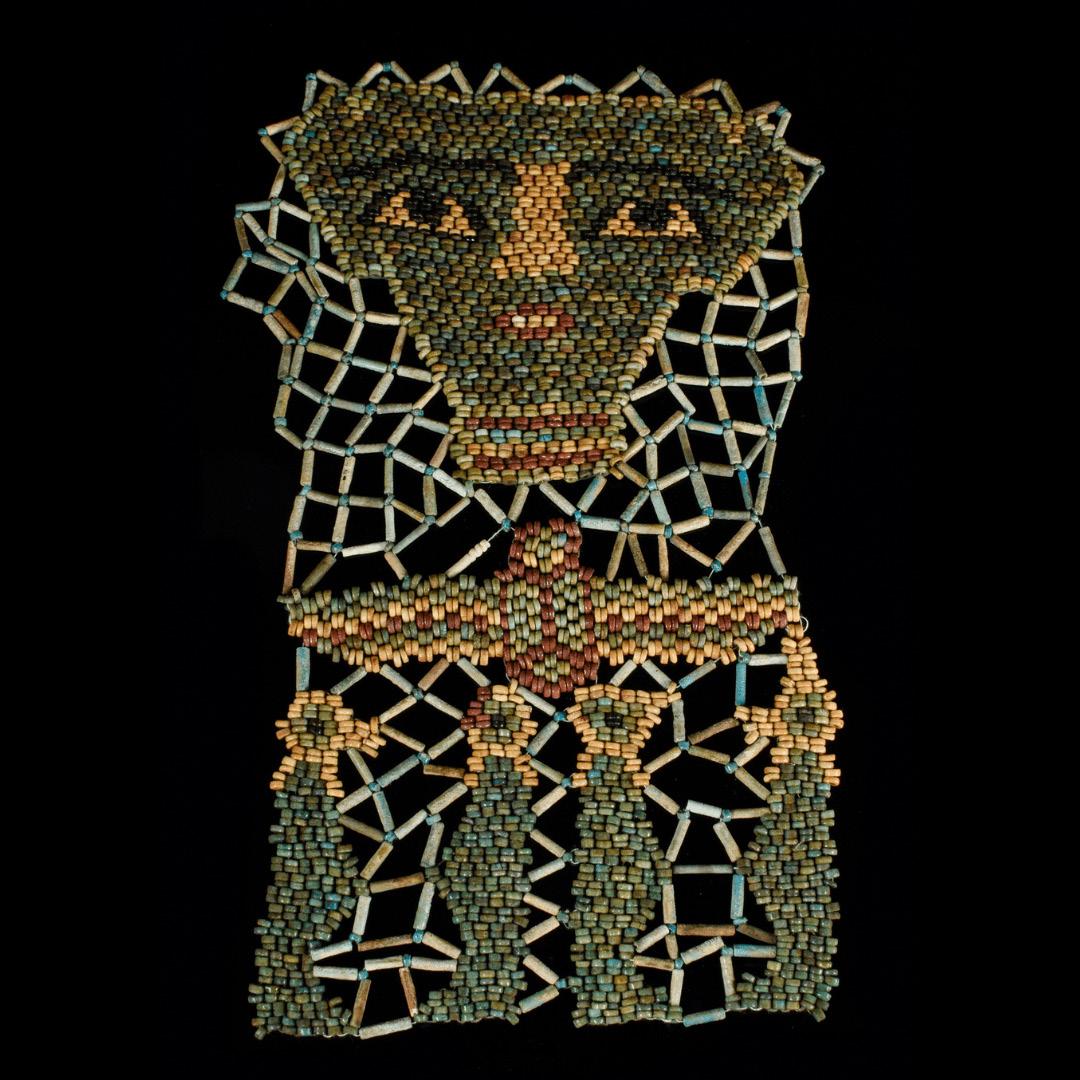
Provenance: From an old British collection of Ancient Art formed in the 1990s on the UK and European art market.
Late Dynastic / Ptolemaic Egyptian, Ca. 664-343 BC
Starting price: £300
An ancient Egyptian mummy shroud of beadwork from the chest of a mummified person, consisting of a net of dark green barrel and light green tubular beads. Size: L: 240mm / W: 145mm; 90g.
Provenance: From an old British collection of Ancient Art formed in the 1990s on the UK and European art market.
Late Period, Ca. 663-323 BC
Starting price: £200
An ancient Egyptian face mask formed of faience beads. Composed of turquoise, cream, black and red faience glazed composition beads, with cream for the sclera, and green glazed cylinders for the attachment to form a face. Size: L: 110mm / W: 130mm; 40.7g.
Provenance: From an old British collection of Ancient Art formed in the 1990s on the UKv and European art market.

111.
Ca. 600-500 BC
Starting price: £90
109.
Late Dynastic / Ptolemaic Egyptian, Ca. 664-343 BC
Starting price: £200
A beaded mummy mask made of delicate faience beads in green, white, yellow, black, and red. The face is highly stylised with large trapezoidal eyes, long, thin brows, a broad, undetailed nose, a small mouth, and lozenge-shaped protruding ears. Size: L: 120mm / W: 135mm; 50g.

Provenance: From an old British collection of Ancient Art formed in the 1990s on the UK and European art market.
A terracotta protome depicting a lovely visage of a goddess with well-modeled facial features wearing a decorative headdress. A protome is a type of bust made by pressing a thin layer of terracotta into a single mold. For a type, see The Metropolitan Museum of Art, Accession Number: 61.11.7. Size: L: 155mm / W: 120mm; 750g.
Provenance: Private British collection of Ancient Art; acquired from I.M. Chait, LA., CA., previously in an old 1980s US collection.
Ca. 700-500 BC
Starting price: £180
A salmon color pottery votive foot, depicted with simplified toes. Overall scattered mineral deposits and areas of surface encrustation. Possibly once part of a larger sculpture, intact. Size: L: 110mm / W: 130mm; 450g.

Provenance: Private UK collection; From an old London collection formed in the 1990s.
113.
Ca. 300-1 BC
Starting price: £180
A substantial ceramic bull’s head from a rhyton with naturalistic features; modelled with short horns, ears, frowning face, eyes, snout and fleshy muzzle. See Ebbinghaus, S., Animal Shaped Vessels of the Ancient World, Feasting with Gods, Heroes and Kings, Harvard Art Museums, 2018, p.314, for a sketch of a similar. Size: L: 165mm / W: 86mm; 408g.

Provenance: Private London collector; obtained from an important London W1, gallery; previously acquired 1970s-1980s.
114.

Early Cycladic, Ca. 3000-2800 BC
Starting price: £1800
A carved, bulbous jar having a rounded collar rim and four, carved equidistant small, perforated lugs around the shoulder. For similar vessels see The Museum of Cycladic Art. The term “Cycladic” refers to a group of Aegean islands where vessels like this were made. Size: L: 90mm / W: 110mm; 800g.
Provenance: Property of London Ancient Art Gallery; previously in US Art Gallery; Ex. Articurial, Paris, sale 2017; previously in private Munich collection, Germany; acquired on the Biritsh art market in 1990s. Exhibited: Olympia Art & Antiques fair, London June 2022.
115.
Ca. 700-600 BC
Starting price: £900
A pottery vessel formed in brown, black, and red with incised decoration, the ovoid body with linear bands and rays emerging from the base, the central register with incised scale pattern, the neck with rosette, the strap handle connects the shoulder with a flat, flaring rim. For a similar example, see The Museum of Fine Arts, Budapest, Inventory number 97.3.A. Size: L: 195mm / W: 110mm; 368g.
Provenance: Property of London Ancient Art Gallery; EX. Private Collection, Pennsylvania; acquired from the University of Pennsylvania Museum of Archaeology in 1965.

Ca. 700-600 BC
Starting price: £900
An Etruscan bucchero oinochoe in magnificent form with a bulbous base adorned with a register of incised linear lines, sitting on a short flared foot, with flaring rim, pinched large pouring spout, and sweeping, flat handle framed by pointed details where it meets the rim. For a similar see The British Museum 1840,0212.36. Size: L: 223mm / W: 142mm; 485g.
Provenance: London Anient Art Gallery 2000, ex of London Gallery, Ex New York Gallery.
Apulian, Ca. 350-300 BC
Starting price: £750
A rare red-figure kantharos. This tall stemmed cup has two sweeping high handles and a gently flared body that sits on a tiered foot with central fillet. Each side depicts a female head in left profile, wearing necklace and earringsdetails in added yellow and white. For a similar piece, see Christie’s, Live Auction 5399, Antiquities, 30 April 2008, Lot 145. Size: L: 165mm / W: 160mm; 282g.
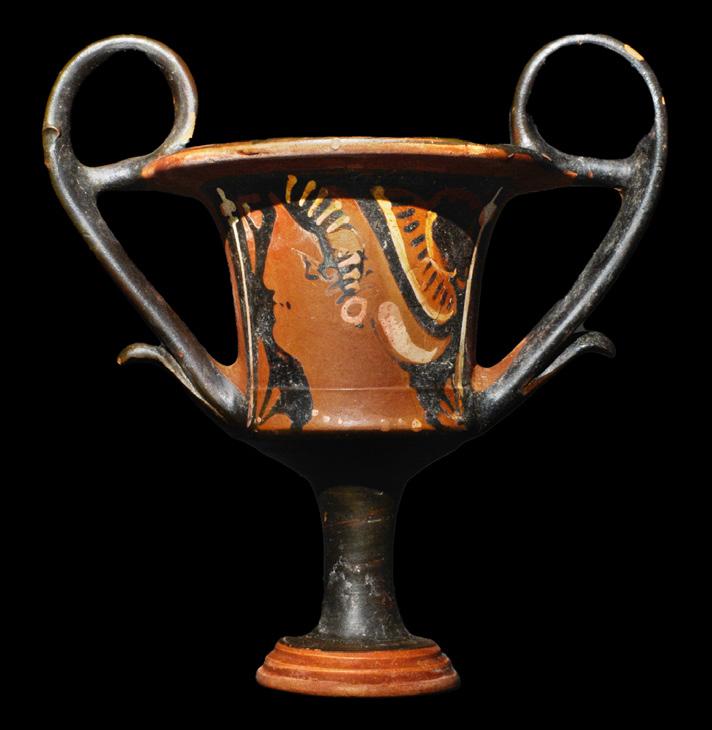

Provenance: Property of a central London Gallery; formerly in a South English estate collection; acquired in the 1990s from Andre de Munter, Brussels, Belgium; previously in an old European collection. Exhibited: Olympia Art & Antiques fair, London June 2022.
Ca. 400-300 BC
Starting price: £500
A ceramic askos of an elegant form, this ancient vessel used to pour small quantities of precious liquids such as oil, possessing a characteristic flattened spout and high strap handle, though this example’s near spherical body departs from more common flat forms. For a similar example but painted see The British Museum 1850,0823.1. Size: L: 253mm / W: 245mm; 2.5kg.

Provenance: Ex New York Gallery, Ex Private Collection New York, Ex Harmer Rook Nuismatists Ltd.
Ca. 400-300 BC
Starting price: £200
A Daunian askos referred to as a “duck” askos with a globular body with a cylindrical neck, a flaring mouth, and a wide strap handle, decorated with horizontal bands and waves, details in added brown and black pigment. For a similar see Bonhams, 3 July 2019, lot 21. Size: L: 215mm / W: 210mm; 1.9kg.
Provenance: Ex New York Gallery, Ex Private Collection New York, Ex Harmer Rook Nuismatists Ltd. Exhibited: Olympia Art & Antiques fair, London June 2022.
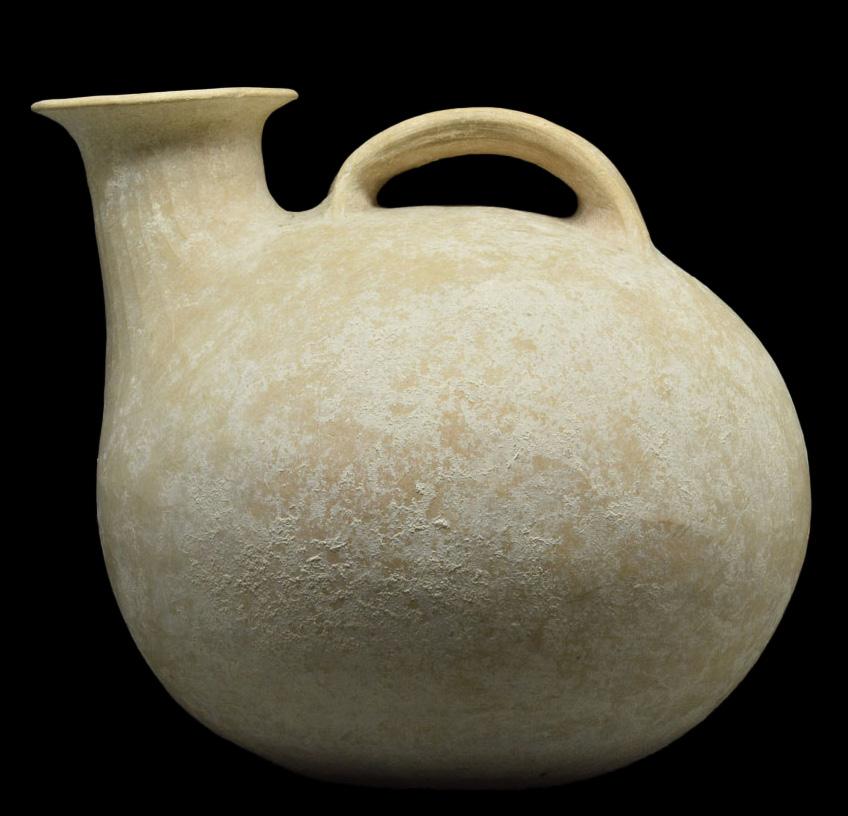
Ca. 350 BC
Starting price: £200
A lovely Daunian kyathos with a bulbous body tapering to a flat base. Narrowed neck leading to a broad, flat rim. The exterior of the vessel is embellished with black and brown painted bands and geometric motifs. Size: L: 230mm / W: 170mm; 890g.


Provenance: Property of a London Gallery; acquired from UK private estate collection; Ex. Art Ancient 2013. Exhibited: Olympia Art & Antiques fair, London June 2022.
Ca. Late 6th/early 5th century BC
Starting price: £200
A beautiful Daunian jar with a rounded body tapering to a cylindrical neck, an everted tubular rim, and a high looped strap ‘horned’ handle. For a similar Daunian jar in shape: Christie’s lot 4169120. Size: L: 230mm / W: 122mm; 714g.
Provenance: Ex NYC private collection; acquired on the USA Art market
Starting price: £200
A finely modelled wheel-thrown bichrome terracotta bell krater on a concave raised foot, the body decorated with horizontal bands and striations in red on cream. Size: L: 236mm / W: 230mm; 1.7kg.
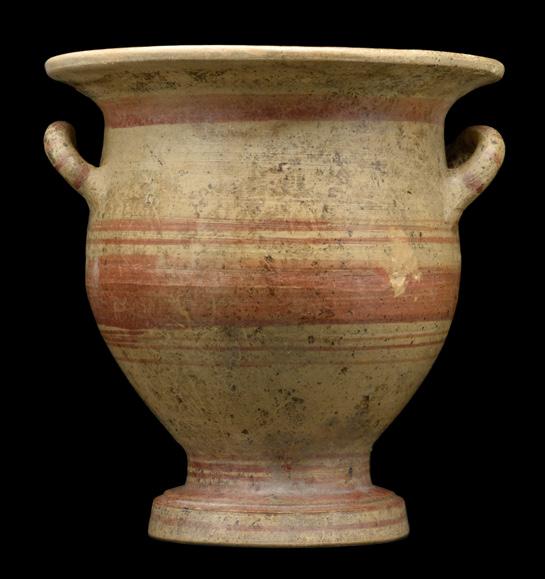
Provenance: Property of a central London Gallery; formerly in a South English estate collection; acquired in the 1990s from Andre de Munter, Brussels, Belgium; previously in an old European collection. Exhibited: Olympia Art & Antiques fair, London June 2022.
Ca. 1900 BC
Starting price: £200
A pottery jug with a strap handle, and an amphora-shaped body. Size: L: 190mm / W: 95mm; 380g.
Provenance: Ex High Wycome Estate Collection, Ex Dr Bron Lipkin Collection, Ex Mr David Giles collection.

Cypro-Geometric, Ca. 1050700 BC
Starting price: £200
A barrel jug of cream bichrome painted ware, the spherical body with encircling concentric decoration, with cross-hatched lozenge motifs beneath the handle and on the shoulder. Size: L: 230mm / W: 155mm; 770g.

Provenance: Private UK collection; From an old London collection formed in the 1990s.
Cypro-Geometric, Ca. 1050-700 BC
Starting price: £200
Of white painted ware, the spherical body with pronounced nipples and encircling concentric decoration, with cross-hatched lozenge motifs beneath the handle and on the shoulder. Size: L: 175mm / W: 140mm; 415g.
Provenance: Ex High Wycombe Estate collection 1990, Ex Wiltshire Gallery, Ex Private Collection Denmark. Exhibited: Olympia Art & Antiques fair, London June 2022.
Ca. 1300-1150 BC
Starting price: £200
A pottery vessel known as a milk bowl displays a tan-coloured ground that is embellished with six groups of vertical linear decorations cascading from a similarly patterned band at the top of the vessel. The bowl features a rounded base and a sizeable side handle oriented horizontally. For a similar example, see The British Museum, Museum number 1869,0604.46. Size: L: 95mm / W: 185mm; 330g.

Provenance: Ex High Wycombe Estate collection 1990, Ex Wiltshire Gallery, Ex Private Collection Denmark.
BC
Starting price: £200
A fine example of a coil-made, pottery jug with a trefoil spout, a strap handle, and an amphora-shaped body. Fine red bands are around the body, below the neck are displayed a geometrical decoration comprising triangular patterns and further linear bands, rendered in brown pigment. Cf. Ruth Amiran, Ancient Pottery of the Holy Land. Size: L: 175mm / W: 91mm; 370g.

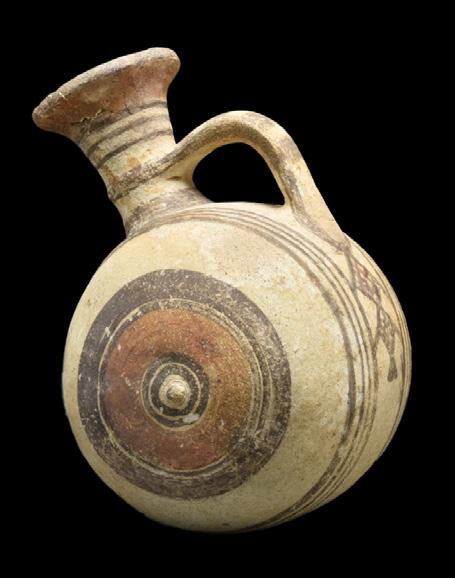

Provenance: Ancient Art Gallery in London, Ex High Wycombe Estate Collection acquiredd in 1990’s.
Late Bronze Age, Ca. 1600-1200 BC
Starting price: £500
Wheel-made red lustrous bottle with spindle-shaped body with tapered neck fluting near mouth with everted rim, tubular sectioned handle connecting neck and shoulders, splaying foot with concave base. Red lustrous ware ultimately thought to have Anatolian origin, finding its way into Cyprus during international trading era of Late Bronze Age. Cf. Karageorghis, Ancient Cypriote Art in the Severis Collection pl. 104. Size: L: 290mm / W: 70mm; 500g.
Provenance: Property of a London gallery; formely in High Wycombe Estate collection; formerly acquired on UK Art market; Ex. Christie’s lot no. 330 Oct. 1999.
125. CYPRIOT POTTERY BARRELCa. 300 BC
Starting price: £200
A terracotta Daunian Kalathos, the body decorated in with two bands of red painted wreaths, in between two red painted bands. Very fine condition. Paint is in original condition. Unrestored. For a similar example of Kalathos see Christie’s, December 9, 2005, lot 282. Also, April 29, 2019, lot 176. Size: L:165mm / W:250mm; 1.1kg.
Provenance: Property of a central London Gallery; formerly in a South English estate collection; acquired in the 1990s from Andre de Munter, Brussels, Belgium; previously in an old European collection. Exhibited: Olympia Art & Antiques fair, London June 2022.


Ca. 400-300 BC
Starting price: £300
A Messapian lebes gamikos, a delicately formed “marriage vase” with an inverted bell-shaped body and its characteristic pair of horizontal strap handles set on either shoulder. The centre is decorated with a band of stylised vines, with horizontal bands above and below. Size: L:164mm / W:173mm ; 765g.
Provenance: London Anient Art Gallery 2000, ex of London Gallery, Ex New York Gallery- Fortuna Fina Arts., Ex Ye Olde Curiousity Shoppe 2003.
Starting price: £300
A Daunian lebes gamikos - “marriage vase” with an inverted bell-shaped body and its characteristic pair of horizontal strap handles set on either shoulder. The mouth with a raised rim on which rests a discoid lid with a knobbed handle. The vessel sits on a low, circular foot. Both, the body and lid are decorated with a red-painted design of circumferential bands and petaloid motifs. Flawlessly intact. Size: L:140mm / W:145mm ; 370g.
Provenance: Property of a London gallery; formely in High Wycombe Estate collection; formerly acquired from Dr Peter Michael, Apolluxx Antiquities in Luxembourg in 2008. Exhibited: Olympia Art & Antiques fair, London June 2022.
Ca. 400-300 BC
Starting price: £200
A pottery plate with a cream background and red painted linear decoration in the tondo enclosed within a laurel band painted in the cavetto and radiating drops just below the rim.

Size: L:40mm / W:160mm ; 200g.
Provenance: Property of a London gallery; formerly in High Wycombe Estate collection; formerly acquired on the UK art market.
Ca. 600 BC
Starting price: £400
A beautiful pottery alabastron with a piriform body with a flat disk rim connected by a small loop with a neck. The exterior is adorned with a depiction of two large birds facing each other, each with elegantly outlined wings. For a similar example see The Metropolitan Museum of Art, Accession Number: 41.162.57. Size: L:85mm / W:40mm ; 60g.
Provenance: Property of a London gallery; formely in the collection of Nancy and Earl Keefer (USA).
Ca. 600-500 BC
Starting price: £300
A pottery aryballos with its characteristic round body, a short neck, and a rimmed mouth with slightly inward sloping sides. A small handle connects the mouth with the shoulder of the vessel. The exterior is decorated with depictions of a feline and a stag. The edge of the rim is decorated with evenly spaced dots and the neck with radiating lines. Aryballoi were used by athletes to store oils and perfumes and were specially designed to be carried comfortably on the wrist with a string threaded through a small loop attached to a jar. Size: L:45mm / W:50mm ; 30g.
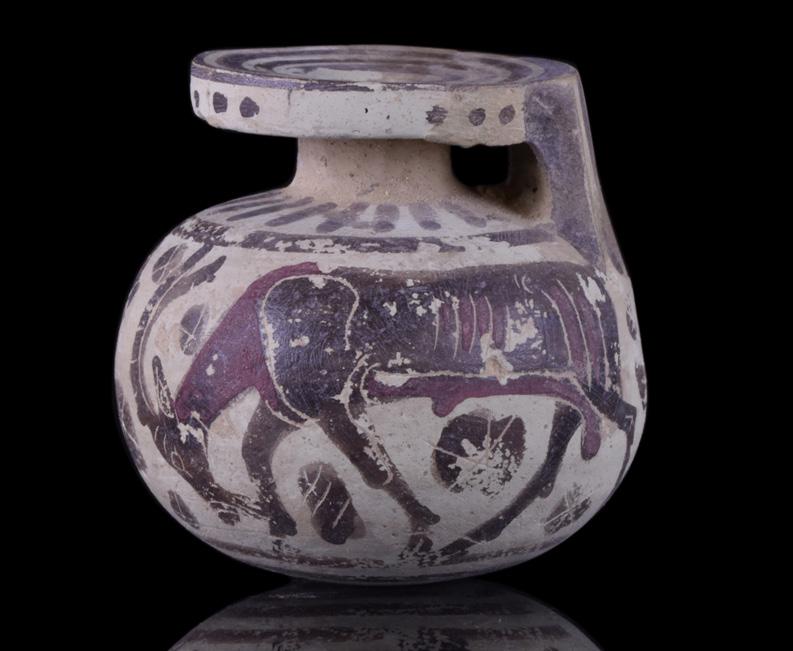

Provenance: Property of a London gallery; formely in the collection of Nancy and Earl Keefer (USA).

135.
ARYBALLOS Ca. 500 BC
Starting price: £300
A blackware aryballos with its characteristic round body, a short neck, and a rimmed mouth. A small handle connects the mouth with the shoulder of the vessel. The main body is decorated with ribbed features. Aryballoi were used by athletes to store oils and perfumes and were specially designed to be carried comfortably on the wrist with a string threaded through a small loop attached to a jar. Size: L:60mm / W:50mm ; 50g.
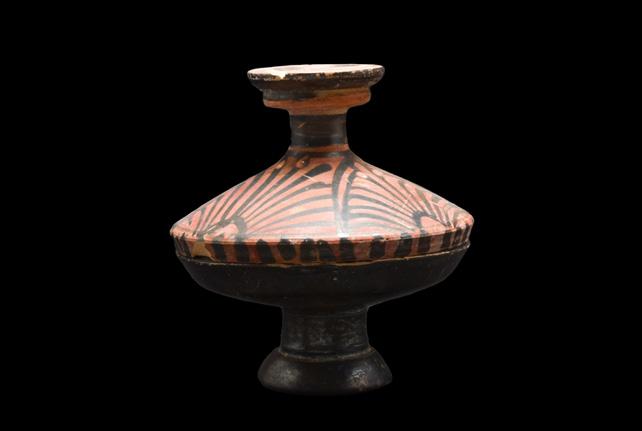

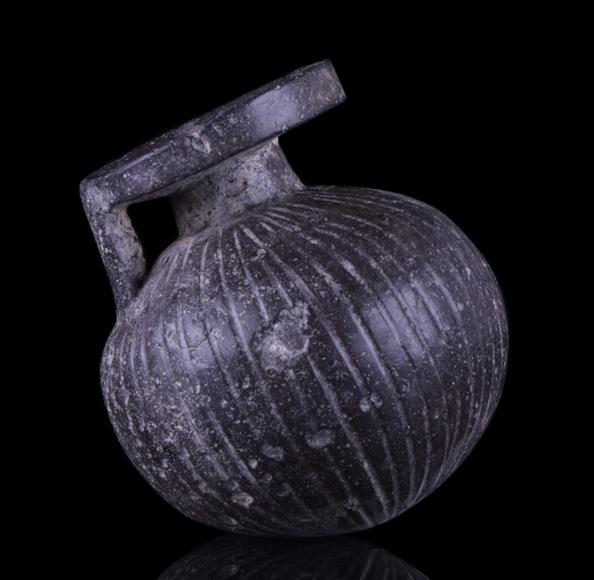
Provenance: Property of a London gallery; formely in the collection of Nancy and Earl Keefer (USA).
136.
BLACKWARE IMPASTO JAR Ca. 1100-700 BC
Starting price: £200
A well-formed blackware jar with twin symmetrical handles rising from the shoulder. The Villanovan culture is known mostly for their cremation burials, which were placed into hand-modeled impasto urns. Impasto is a rough, heavy, and unrefined brown clay. Size: L:124mm / W:139mm ; 445g.
Provenance: Ancient Art Gallery in London, Ex High Wycombe Estate Collection acquiredd in 1990, Ex Gallery in Essex.
580 - 560 BC
Starting price: £300
A terracotta kylix with a hemispherical bowl, short pedestal foot, and two equally spaced loop handles. Decorated in a bi-chrome finish that takes advantage of the rich contrasting play between the rich black glaze and buff red ground. This beautiful piece would have been used for wine drinking, usually during social occasions or banquets. Size: L:70mm / W:170mm ; 175g.

Provenance: Property of a London gallery; formely in the collection of Nancy and Earl Keefer (USA).
Ca. 400-300 BC
Starting price: £180
A stemless terracotta Greek kylix (drinking cup), covered in a rich black gloss. The large, shallow body rests on a low foot that concaves, revealing the natural hue of the clay. Two D-shaped handles protrude from opposite sides of the body. The tondo is decorated with palmette design.Size: L:60mm / W:270mm ; 460g.
Provenance: Property of a central London Gallery; formerly in a South English estate collection; acquired in the 1990s from Andre de Munter, Brussels, Belgium; previously in and old European collection.
Ca. 400-300 BC
Starting price: £500
A black-glazed pottery fishplate, having an integral ring foot, wide lower collar rim, and a central circular depression. Two red-brown bands painted on the upper edge border. With an old collection ticket, 1953. Size: L:25mm / W:176mm ; 395g.
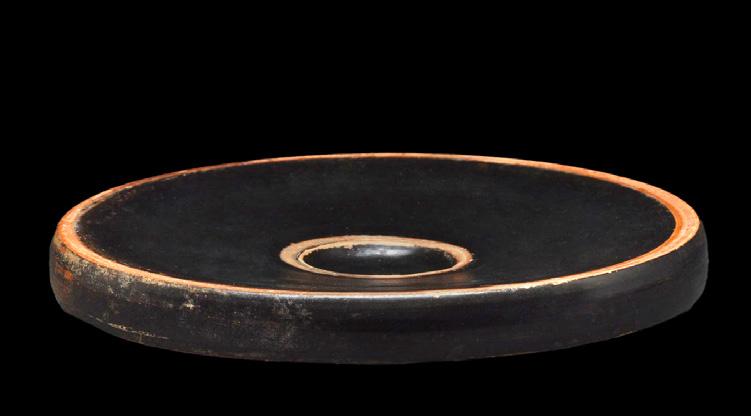

Provenance: London Art Market, ex, NYC collection; Ex. Edward H. Merrin Gallery, Inc., NYC., 1980s. Early descriptive label affixed on the underside, dated “28/3/53”, (1953 date of purchase.)
Ca. 340-325 BC
Starting price: £100
A ceramic lekanis of the red-figure lid decorated with palmette designs. This type of dish was used to store soaps and perfumes. Size: L:70mm / W:170mm ; 175g.
Provenance: Property of a central London Gallery; formerly in a South English estate collection; acquired in the 1990s from Andre de Munter, Brussels, Belgium; previously in and old European collection.
Attributable to the Group of the Phoenician Palmettes, Ca.Ca. 400-300 BC
Starting price: £400
A magnificent CAMPANIAN terracotta bell krater, executed in black slip. The vessel presents a pedestal base, bell-shaped body, applied handles, and a broad everted rim. Size: L:223mm / W:142mm ; 485g.
Provenance: Collection of Edmund Bourke, MD., Yonkers, NY. Acquired A. P., auction 48, lot 66, 2008, ex. Ancient Art International, Fl., ex. Brockway collection.
Ca. 400-300 BC
Starting price: £400
A fine wheel-thrown pottery lekythos with a low ring foot, a tall ovoid body, a discoid rim with a funnel mouth, and an applied arching handle. Size: L:193mm / W:87mm ; 288g.
Provenance: Private collection, London; acquired NYC collection, ex. Fortuna Fine Arts, NYC.
142.
Ca. 400-300 BC
Starting price: £300
Greek black-glazed kantharos with high attenuated twin handles and a high stemmed foot with a raised ridge. Size: L:201mm / W:185mm ; 370g.
Provenance: London art Gallery, Ex. Artemis Gallery, CO, 8/27/2014, lots 25 & 26. Ex. Harlan Berk Gallery, Chicago, IL.
Ca. 340-320 BC
Starting price: £200
An attractive blackware pottery oinchoe with a trefoil spout, Size: L:170mm / W:100mm ; 270g.

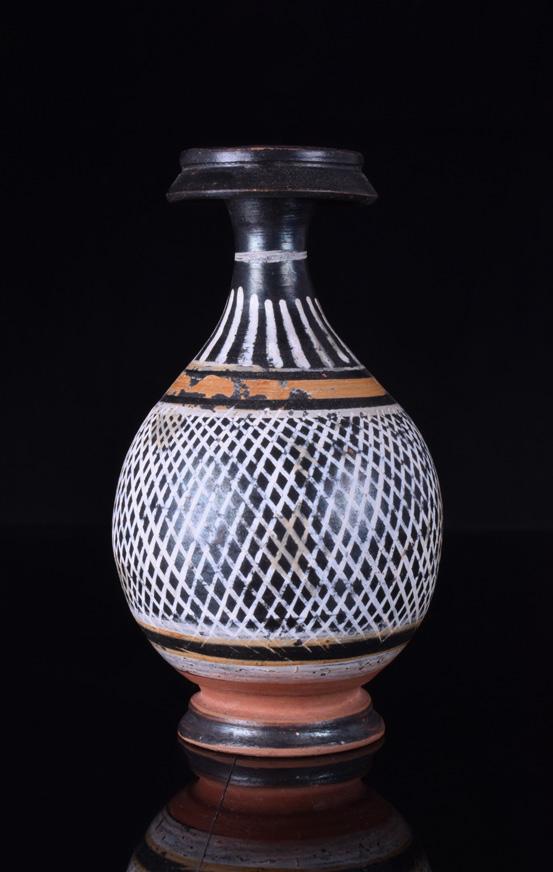
Provenance: Property of a central London Gallery; formerly in a South English estate collection; acquired in the 1990s from Andre de Munter, Brussels, Belgium; previously in and old European collection.
143.

Ca. 340-325 BC
Starting price: £200
A rare bottle created in a pottery workshop in the Apulia region of southern Italy where potters were known for introducing additional pigments to the red-figure painting technique. Size: L:120mm / W:70mm ; 105g.

Provenance: Private collection, London; acquired in Geneva from Alara gallery on 1990s.


Ca.400-300 BC
Starting price: £200
A Gnathian oinochoe with trilobate spout, constricted neck, piriform body, ring base and L-shaped handle. Size: L:170mm / W:100mm ; 360g.
Provenance: Property of a central London Gallery; formerly in a South English estate collection; acquired in the 1990s from Andre de Munter, Brussels, Belgium; previously in and old European collection.
Ca. 350-300 BC
Starting price: £300
A metallic black glazed pottery handled oil bottle having a tapered bulbous body, high angular handle, and pour spout, stylized lion head lugs at the sides of the channel spout. Size: L:195mm / W:85mm ; 332g.




Provenance: Property of a central London Gallery; formerly in a South English estate collection; acquired in the 1990s from Andre de Munter, Brussels, Belgium; previously in and old European collection.
Ca. 375–300 BC
Starting price: £500
A Gnathian-ware epichysis decorated with tongues on the neck, dots, zigzags and berried laurel band on the shoulder. Size: L:160mm / W:82mm ; 182.8g.
Provenance: Private FL. collection. Ex. Christies, NYC., 12/7/2000, lot 485.
Ca. 400 BC
Starting price: £500
A delicate, well detailed vessel known as a prochous, formed in a black-glazed, crafted with a tall bulbous body tapering into shaped spout and long handle behind. Size: L:190mm / W:70mm ; 160g.

Provenance: Property of a UK Ancient Art Gallery; previously in Collection of Mr. and Mrs. Robert Feuer, New York, acquired 1970s - 1980s.
Ca. 4th century BC
Starting price: £200
A pouring vessel known as a prochous. Size: L:60mm / W:113mm ; 360g.
Provenance: Property of a central London Gallery; formerly in a South English estate collection; acquired in the 1990s from Andre de Munter, Brussels, Belgium; previously in and old European collection.
A particularly nice and well-preserved example of a typical drinking cup from Southern Italy in the highly decorative Gnathian style. Size: L:100mm / W:140mm ; 135g.

Provenance: Property of a central London Gallery; formerly in a South English estate collection; acquired in the 1990s from Andre de Munter, Brussels, Belgium; previously in and old European collection.
A black glazed pottery pedestal cup, having a large loop, opposing handles with flat wide thumb rests. Lower tapered bulbous rim with a fluted edge. Simple white-painted stylized vine. One handle restored, one other with paint loss, and some very minor rim flakes. Size: L:130mm / W:200mm ; 325g.
Provenance: NYC collection, ex. Fortuna Fine Arts, NYC.
149. A GREEK GNATHIAN PROCHOUS WITH LION HEAD3rd century BC
Starting price: £100
Black glazed terracotta guttos on a small foot with a very wide and short body. On one side of the body, a long and thin spout extends upwards, finishing in an everted rim. On the side 90 degrees from this, a ring-handle sticks upwards. Size: L:60mm / W:130mm ; 125g.
Provenance: From the private collection of a Somerset gentleman; previously in an old British collection, formed in the 1980s on the UK /European art markets.
360-320 BC
Starting price: £100
A black-glazed terracotta guttos (oil-lamp filler) with a spool-shaped foot, a wheelshaped body, a protruding ring handle, and a cylindrical spout with an everted rim. The tondo features a stamped Gorgon with piercing eyes, a soft, round jaw line and flowing hair. Good condition. Size: L:118mm / W:75mm ; 168g.

Provenance: Property of a central London Gallery; formerly in a South English estate collection; acquired in the 1990s from Andre de Munter, Brussels, Belgium; previously in and old European collection.
Starting price: £500
A decorated pottery bowl of very fine detail with a pinkish hue, covered all over in a dark slip that ranges from dark brown to black. Size: L:87mm / W:120mm ; 155g.

Provenance: The Hanita and Aaron Dechter Collection, Los Angeles, acquired before 1989. Ex. Charles Ede, London (E8561). Published: K. Hamma, ed., The Dechter Collection of Greek Vases, San Bernardino, 1989, no. 52. Exhibited: San Bernardino, California State University; and Art Galleries, California State University, Northridge, The Dechter Collection of Greek Vases, 5 May-2 June 1989 and 26 February-30 March 1990.
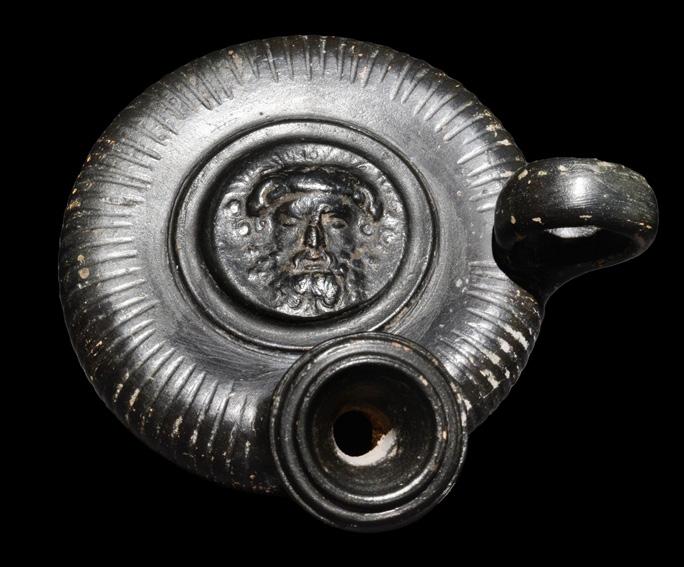
DUCK
Ca. 340-325 BC
Starting price: £200
A pottery askos presenting in the form of a ‘duck’ with a tiered foot, a bulbous body with a concave top, a petite strap handle, a projecting funnel-form mouth, and a perky tail on the opposite end. Cf. Museo Civico di Archeologia Ligure (Corpus Vasorum Antiquorum Genova 1.IV E, pl.1.15). Size: L:114mm / W:100mm ; 285g.
Provenance: Uk private collection, ex Estate of William G. Butler, NYC, acquired from Harmer Rooke Galleries, NYC. April 1978. Old Harmer Rooke certificate accompanies.
Ca. 340-325 BC
Starting price: £200
A pottery askos presenting in the form of a ‘duck’ with a tiered foot, a bulbous body with a concave top, a petite strap handle, a projecting funnel-form mouth, and a perky tail on the opposite end. Size: L:104mm / W:110mm ; 300g.
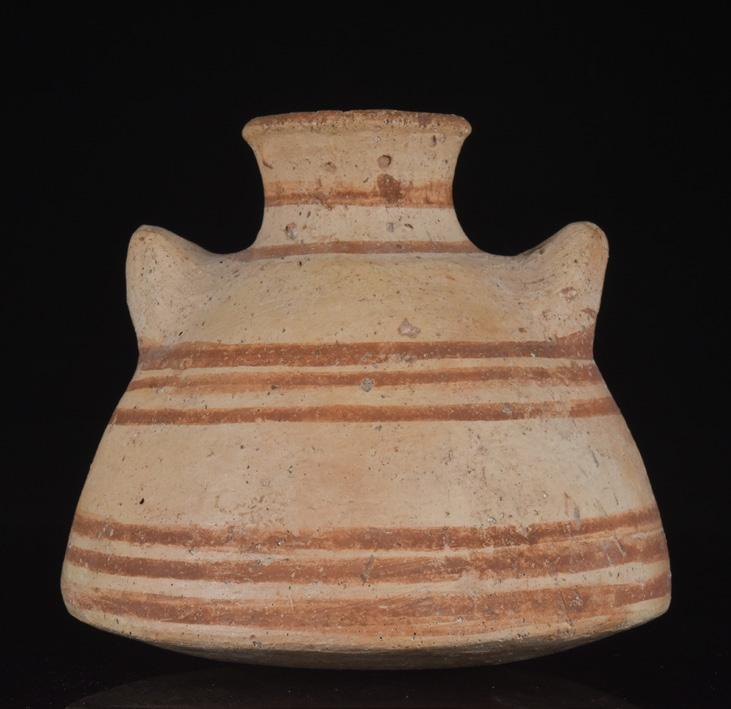

Provenance: Uk private collection, ex Estate of William G. Butler, NYC, acquired from Harmer Rooke Galleries, NYC. April 1978. Old Harmer Rooke certificate accompanies.
Late Bronze Age, Ca.1300 BC

Starting price: £300
A pyxis in buff terracotta; twin lug handles on the shoulders for suspension (suspension would help in evaporation of the liquid and aid cooling), a funnelled neck and standing on a flattened base; body decorated with faded decoration comprising bands of parallel painted lines in umber. Size: L:90mm / W:98mm ; 270g.
Provenance: Ancient Art Gallery in London, Ex High Wycombe Estate Collection acquiredd in 1990’s Ex Bron Lipkin Collection
155. GREEK HELLENISTIC MEGARIAN MOLD FORMED BOWL Eastern Mediterranean, Ca. 1st century BC - 1st century AD159.
BICHROME JUGLET - Ca. 1050-700 BC
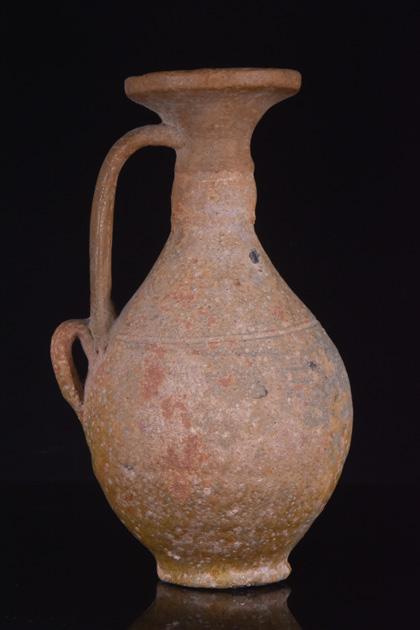
Starting price: £200
A decorated pottery juglet with painted salmon color wide band and dark brown painted concentric ring elements. Elegant rounded flared lips and an ear type single handle. Scattered light surface deposits. Intact, exc. cond. Nice example. Size: L:115mm / W:70mm ; 135g.
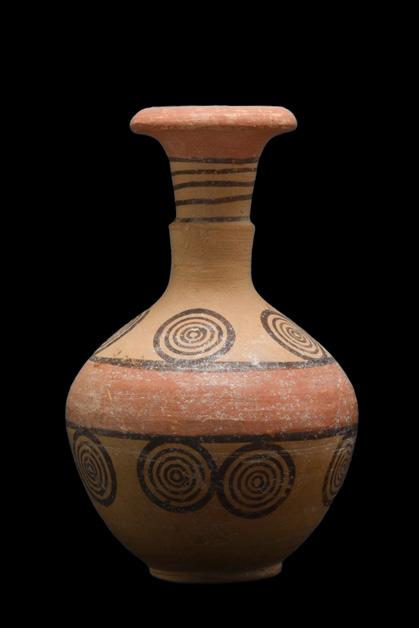
Provenance: Ancient Art Gallery in London, Ex NYC collection; Ex. Edward H. Merrin Gallery Inc., NYC., 1968-69.
160. HERODIAN GREEN GLAZED OINOCHOEJudea, Ca. 37 BC-70 AD
Starting price: £200
The body of this juglet is piriform and a small ridge is present just below the cylindrical neck. The rim is thick and everted with a single, arching handle attached form the upper body to the neck of the juglet with an applied loop just below. Standing on a small flat foot. Size: L:177mm / W:105mm ; 305g.
Provenance: London Art Market, Ex High Wycome Esate Collection from the 1990s, Ex Private Collection Netherlands. Exhibited: Olympia Art & Antiques fair, London June 2022.
161.
Ca. 5th-4th century BC
Starting price: £1,000
A bronze Graeco-Scythian type mirror featuring a circular face which was originally the reflective surface, a handle shaped like a fluted column and a standing horse to the base. Size: L:308mm / W:75mm ; 810g.
Provenance: Private UK collection; formerly acquired on the European art market.
162.
Ca. 100-300 AD
Starting price: £90
A beautiful lead votive mirror, with a circular disk and rectangular handle with scroll-shaped supports. Size: L:104.7mm / W:57.4mm ; 47.52g.

Provenance: Private London collector, acquired on the Austrian Art market; formerly in an old USA collection, formed since the 1970s.
Ca. 100-300 AD
Starting price: £500
163.

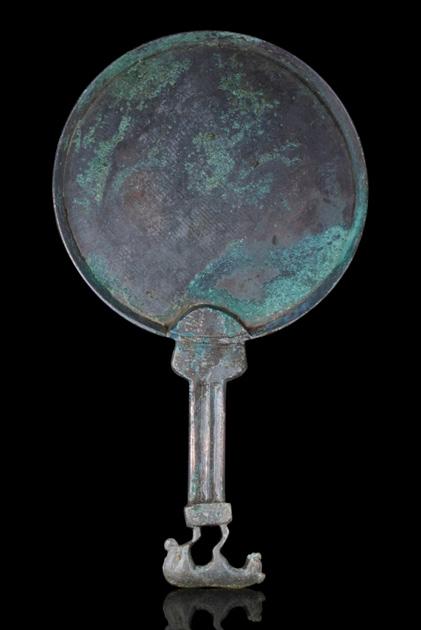
Ca. 100-300 AD
Starting price: £90
A lead votive mirror, with a circular disk and a flat, rectangular handle with small lateral supports. Size: L:101.5mm / W:59.7mm ; 39.44g.
Provenance: Private London collector, acquired on the Austrian Art market; formerly in an old USA collection, formed since the 1970s.
A massive cast-bronze fitting coming from a chariot depicting a male figure with youthful features (possibly the god Apollo, the Roman and Greek god of music and dance). He wears chlamys fastened at the right shoulder. His face with attentive, eyes, a broad nose, and slightly smiling lips. Size: L:165mm / W:130mm ; 1.72kg.
Provenance: Private UK collection; From an old London collection formed in the 1990s.
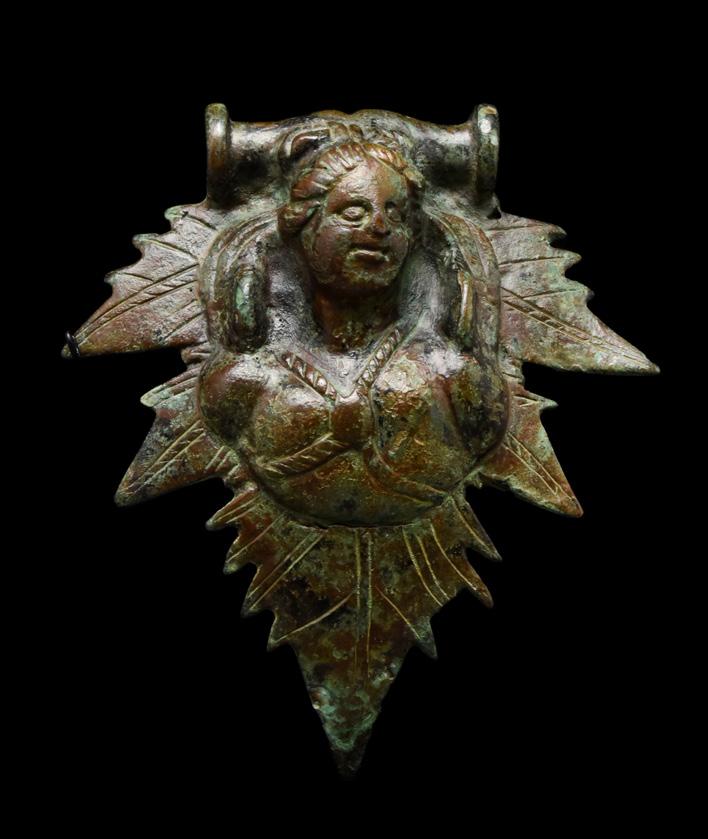

Ca. 100-300 AD
Starting price: £300
Large cast bronze hydria attachment depicting the bust of a siren having a fancy hairdo, expressive facial features, wearing a belted chest plate, and surrounded with a multi-leaf decoration. Overall blue-green patina with a red-brown oxide ground. Intact. Size: L:115mm / W:100mm ; 200g.
Provenance: Private FL. collection, acquired from Rosen Antiques, NYC., 1990.
166.
Ca. 200-300 AD
Starting price: £2,000
A bronze door knock shaped as a lion head handle cast in high relief within a circular border. The animal’s head modelled with a prominent browline and eyes, a ring in its gaping jaw. Size: L:335mm / W:285mm ; 1.58kg.

Provenance: Private London collection; ex. Collection of Edmund Bourke, MD., Yonkers, NY. Ex. Ye Olde Curiositie Shoppe, Arnold Saslow, South Orange, NJ., 9/14/2007.
167.
Ca. 1st–2nd century AD
Starting price: £200
A superbly cast lion protome with the rich full mane of overlapping wavy locks, the lion’s mouth open wide, the muzzle naturalistically rendered, the deep-set lidded eyes beneath the modelled ridged brows. In the classical world, lions symbolized power, wealth, and might. Size: L:58mm / W:51mm ; 73.5g.
Provenance: Private FL. collection, ex. Bonhams, 11/8/2001, lot # 135.
168.


Ca. 100-300 AD
Starting price: £1,000
A bronze olpe rising from a ring foot. The vessel features a globular lower body tapering to a gracefully-shaped neck and ending with a flared rim. A small looped handle connects the shoulder with the neck. A beautiful patina enhances the entire surface. Size: L:90mm / W:70mm ; 160g.
Provenance: Property of an European collector; bought from a UK gentleman collection, formed in the 1960s-1990s.
169.
Ca. 100-300 AD
Starting price: £100
A bronze die for casting mounts in the form of a bust of Cupid (Greek Eros) with fleshy features and curly hair. His chubby cheeks portray the features of youth, his stylised wings between his shoulders. In Roman mythology, Cupid was the god of love. Size: L:34.8mm / W:26.8mm ; 62.61g.

Provenance: Private London collector, acquired on the Austrian Art market; formerly in an old USA collection, formed since the 1970s.
170.
Ca. 100-300 AD
Starting price: £200
A bronze figurine of a young Eros, depicted in a standing pose, naked. He is striding forward with his left leg advanced, his right arm stretched holding a patera. His eyes articulated, his lips parted, and a cascade of wavy hair frames his chubby face. He carries a quiver on his back. Size: L:63.4mm / W:39.5mm ; 37.5g.


Provenance: Private London collector, acquired on the Austrian Art market; formerly in an old USA collection, formed since the 1970s.
171.
Ca. 1-200 AD
Starting price: £200
A cast bronze statuette of goddess Venus standing with her weight on her right leg, the left leg bent at the knee and slightly advanced, leaning into her right hip, her slender torso nude; her both arms bent; her head turned to her right, her gaze slightly downturned; her hair arranged in an intricate coiffure and topped with a stephane. Size: L:65.7mm / W:33.9mm ; 48.83g.
Provenance: Private London collector, acquired on the Austrian Art market; formerly in an old USA collection, formed since the 1970s.
Ca. 100-300 AD
Starting price: £100
A free-standing bronze statuette of the god Priapus shown with a long beard, standing with erect phallus and a pile of fruit, symbolizing his influence over fertility and abundance. Priapus was the son of Dionysus or Hermes and Aphrodite. Size: L:48.9mm / W:16mm ; 26.18g.

Provenance: Private London collector, acquired on the Austrian Art market; formerly in an old USA collection, formed since the 1970s.
100-200 AD
Starting price: £90
A cast bronze phalera formed as a lion’s mask. The animal’s head with prominent brow and eyes, and open mouth. This was likely to have been worn on the breastplate of a soldier or formed part of a chariot fitting. Size: L:32mm / W:28.8mm ; 26.07g.
Provenance: Private London collector, acquired on the Austrian Art market; formerly in an old USA collection, formed since the 1970s.
Ca. 100-200 AD
Starting price: £200
A cast bronze figurine of an eagle perching on an integral stand. Expertly cleaned and conserved, with a smooth patina. An aquila (eagle) was a prominent symbol used in ancient Rome, especially as the standard of a Roman legion. Size: L:58.9mm / W:39.5mm ; 94.58g.
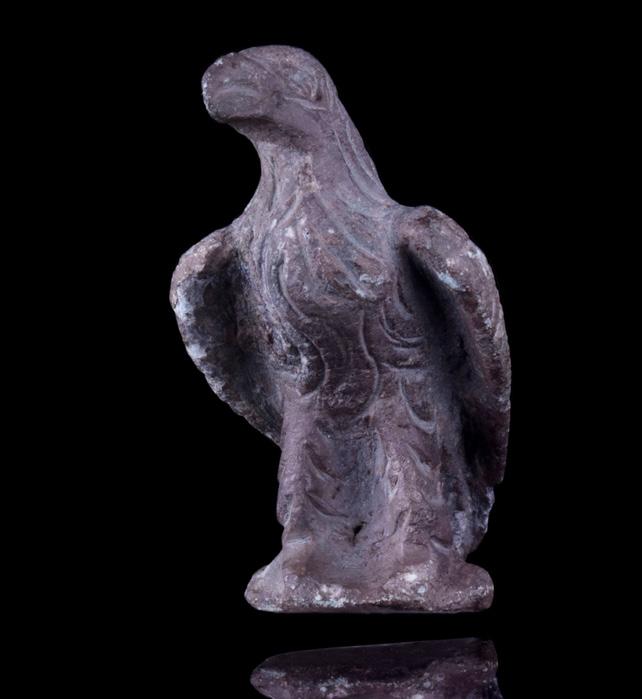
Provenance: Private London collector, acquired on the Austrian Art market; formerly in an old USA collection, formed since the 1970s.
175. ROMAN BRONZE EAGLE
RINE Ca. 100 AD
Starting price: £200
A realistically modelled bronze eagle figurine, standing on a base, long wings folded, the wingtips crossed, feather detailing to the body and wings. An aquila (eagle) was a prominent symbol used in ancient Rome, especially as the standard of a Roman legion. Size: L:43.4mm / W:28.5mm ; 54.06g.
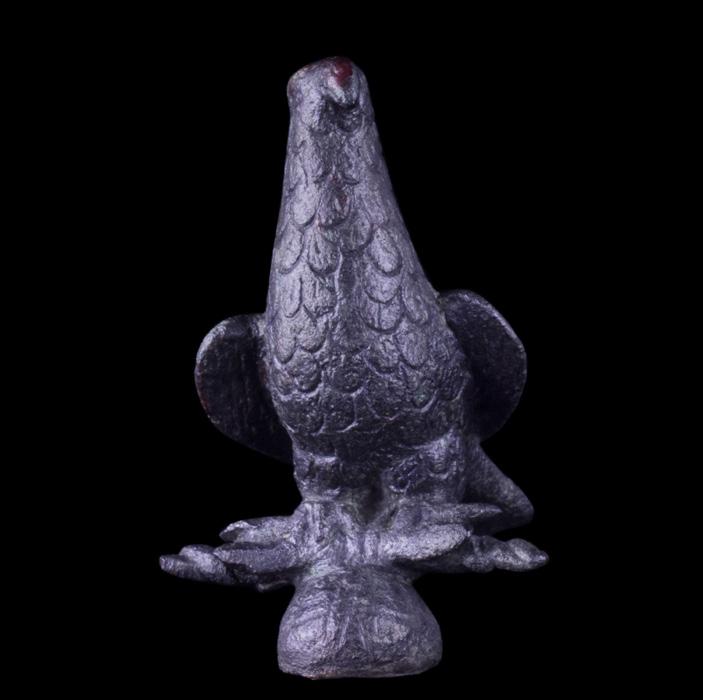
Provenance: Private London collector, acquired on the Austrian Art market; formerly in an old USA collection, formed since the 1970s.
176.ROMAN
Ca. 100-200 AD
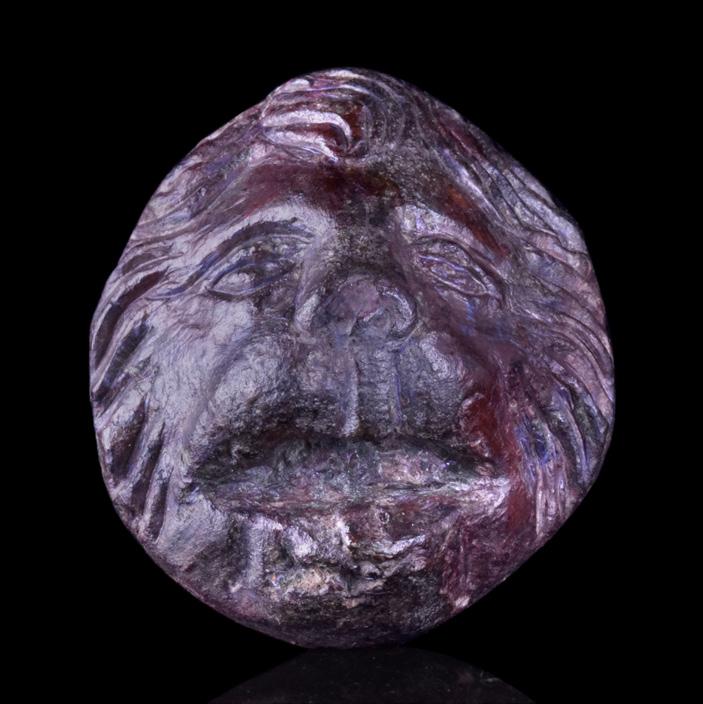
Starting price: £200
A beautiful bronze panther brooch with a slender, stretched body with recessed circles to accept enamel inlays. Catchplate to the reverse. In ancient Greek mythology, the panther was commonly associated with the god Dionysus, who used a panther as his preferred mount. For a comparable example, see The British Museum, Registration number1924,0502.1. Size: L:39.7mm / W:17.4mm ; 11.14g.
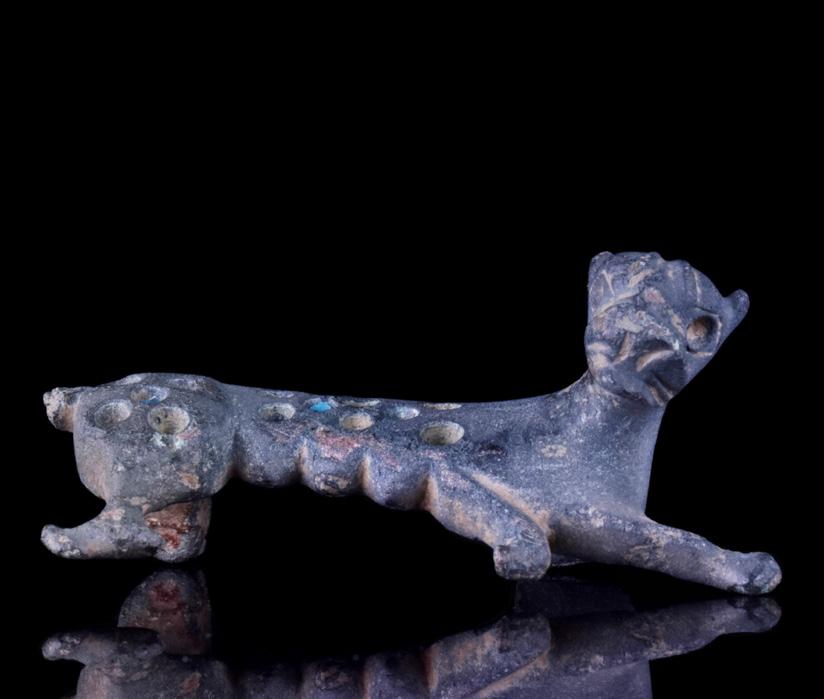
Provenance: Private London collector, acquired on the Austrian Art market; formerly in an old USA collection, formed since the 1970s.
177.
Ca. 1-100 AD
Starting price: £1,500
A sheet-bronze cheekpiece from a Coolus type helmet. This type of helmet was usually hammered from bronze and it was most popular during the period of Gallic Wars (58-50 BC) and remained in service until the 1st Century AD. Cf. Coolus type helmet in the collection of the British Museum, Registration number 1950,0706.1. Size: L:175mm / W:mm ; 200g.
Provenance: Property of a London collector; acquired on European art market prior 2005; formerly in German collection.
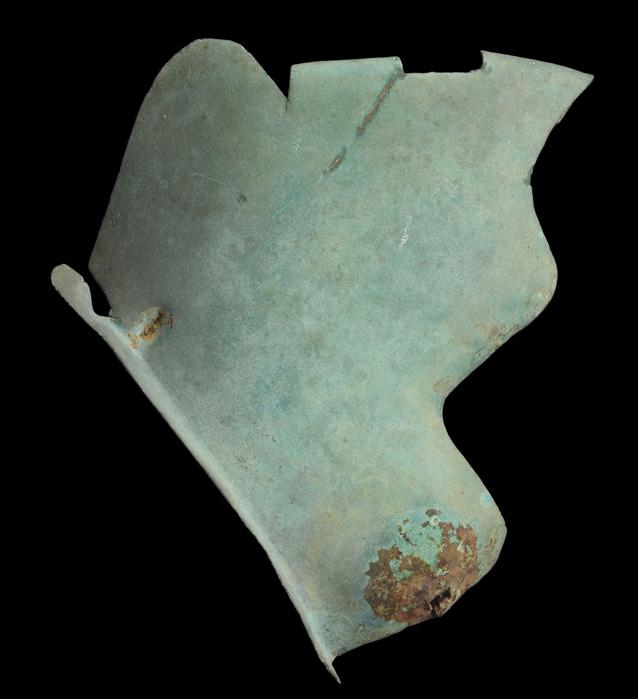
178.
Ca. 800-600 BC
Starting price: £100
A socketed bronze spearhead comprising a substantial lentoid-section blade with raised midrib, and a long shaft. Hoplites were the citizen-soldiers of Ancient Greece, where each city state was fiercely independent and could only be sustained through the military power of its male inhabitants.

Size: L:275mm / W:34mm ; 290g.
Provenance: Private UK collection; From an old London collection formed in the 1990s.
179.
Ca. 100-300 AD
Starting price: £100
A rare set of five Roman surgical tools composed of a double-ended fork, spoon, spatula, and probes. Each tool with a long, round section shaft, one twisted. Professionally mounted on a custom-made stand. Each Roman legion had its own medical team skilled in surgical procedures and this instrumentarium possibly was used on the battlefield to treat the wounded legionnaires. Size: L:130-160mm / W:44694mm ; 335g.

Provenance: Private UK collection; From an old London collection formed in the 1990s.
180.
Ca. 100-300 AD
Starting price: £900
A solid silver spoon with a wide bowl attached to a long round-section handle finished with a pointed finial for use in extracting snails from their shells. For a similar example, see The British Museum, Museum number 1994,0408.127. Size: L:187mm / W:32mm ; 19.6g.

Provenance: Private UK collection; From an old London collection formed in the 1990s.
181.
Ca, 100-300 AD
Starting price: £300
An outstanding silver bowl with a slightly rounded base, straight rim and a broad, deep body. Bowls of this kind were used for pouring libations to the gods and for drinking on more ordinary occasions. Size: L:38mm / W:115mm ; 105g.


Provenance: Property of a West London gentleman; previously in a collection formed on the UK/International art market in the 1980s.
182. ROMAN SILVER BOWL
Ca, 100-300 AD
Starting price: £300
A silver wine bowl with a hemispherical body and smooth walls. Banqueting was a major part of the aristocratic culture in antiquity and required a range of specialised utensils and vessels such as this one. Such items could also have religious purposes, used when making offerings to the gods. Size: L:30mm / W:100mm ; 65g.
Provenance: Property of a West London gentleman; previously in a collection formed on the UK/International art market in the 1980s.

Ca. 1200-800 BC
Starting price: £1,000
A hammered-bronze vessel of a wide, circular form with its walls gently tapering to a flat base. The mid-section is adorned with a triple register of raised bosses. To one side a rivetted strap handle is attached. Size: L:70mm / W:160mm ; 130g.
Provenance: Property of an European collector; bought from a UK gentleman collection, formed in the 1960s-1990s.
Ca. 300-400 AD
Starting price: £180
A wheel-thrown redware pottery dish of a squat form that rests atop a flat base. The center of the basin is decorated with a four-pointed star surrounded by four stylised concentric bullseye patterns. Size: L:60mm / W:305mm ; 1.17kg.

Provenance: Property of a London Ancient Art Gallery; formerly in the famous Alison Barker collection, a retired London barrister; acquired between early 1960s to 1990s.
Ca. 300-400 AD
Starting price: £500
A fine redware jug, with a rounded body and applied decoration including a youthful Bacchus drinking from a wine cup, and four palm fronds. The top of the neck is decorated with two concentric grooves. Size: L:140mm / W:90mm ; 340g.
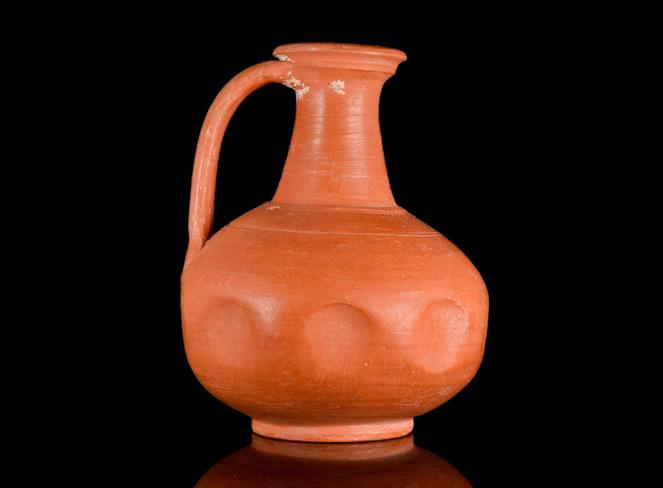

Provenance: Private collection of a California attorney, acquired from Tetragon Gallery, London, 2000.
187.
Circa 300 – 200 AD
Starting price: £750
A pottery vessel in the form of a jug with a bulbous shaped body decorated with indented imprints. The vessel has a tall neck and everted rim, a single handle connected from the base to the neck. The base is sat on a narrow foot. Size: L:140mm / W:90mm ; 340g.
Provenance: Property of a UK Ancient Art Gallery; formerly private collection of a California attorney, acquired from UK Art Gallery, London, 2020.
185.
Ca. 300-400 AD
Starting price: £180
A large terracotta shallow plate, ‘Terra sigillata’ is a type of fine ware Roman pottery identifiable by its red glossy surface slip, which was made in specific areas of the Roman Empire, such as North Africa, Gaul, and Central Italy. Size: L:50mm / W:302mm ; 980g.

Provenance: Property of a London Ancient Art Gallery; formerly in the famous Alison Barker collection, a retired London barrister; acquired between early 1960s to 1990s.
Circa 100-200 AD
Starting price: £750
A terra sigillata (Samian Ware) red gloss ware pottery bowl with moulded decoration around the exterior surface. The decoration depicts rosettes and floral buds in a repeating pattern. The bottom is bulbous with an inscription in Greek referring to the Greek god Apollo who amongst other things was connected to healing and diseases; this could possibly be a bowl used with the name of Apollo in order to provide good luck and health to those in medical need. Size: L:140mm / W:90mm ; 340g.
Provenance: Property of a UK Ancient Art Gallery; formerly private collection of a California attorney, acquired from UK Art Gallery, London, 2020.
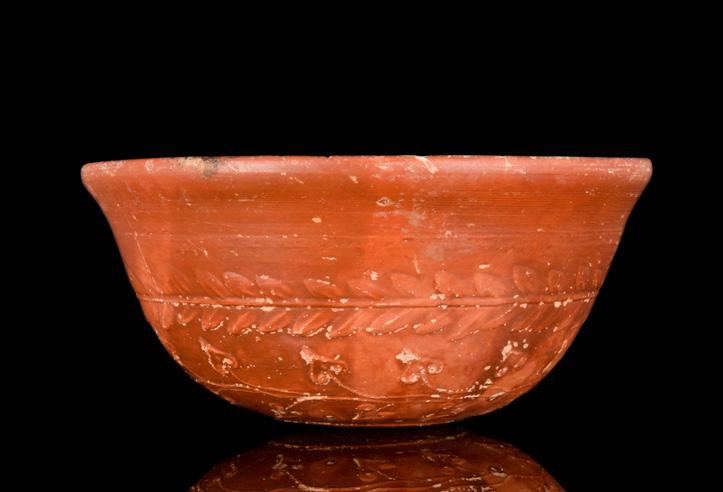
189. NABATAEAN TERRACOTTA PERFUME BOTT Ca. 100-200 AD
Starting price: £200
A finelly modelled red terracotta perfume bottle, featuring a long, cylindrical body, tapering into a deep-set mouth and overturned rim. Size: L:134mm / W:74mm ; 150g.
Provenance: Ancient Art Gallery in London, Ex High Wycombe Estate Collection acquiredd in 1990’s.
190. RARE ROMAN POTTERY SKYPHOS Ca. 100 BC - 100 AD
Starting price: £200
The mold-made body is decorated with a pine-cone or petal-like motif, with a smooth foot, rim, and the ribbed ring handles each with moulded thumb-piece. For a similar glazed example, see The British Museum, museum number 1931,0514. Size: L:70mm / W:134mm ; 115g.
Provenance: Ex High Wycombe Collection, Ex Wiltshire Gallery, Ex Private German Collection.
191. ROMAN GALLO POTTERY BOWL Ca. 100-300 AD
Starting price: £200
A red pottery bowl in globular form decorated with a moulded barbotine scale pattern, standing on a small pedestal foot. For a similar styles see The Metropolitan Museum of Art 17.194.872. Size: L:68mm / W:100mm ; 240g.
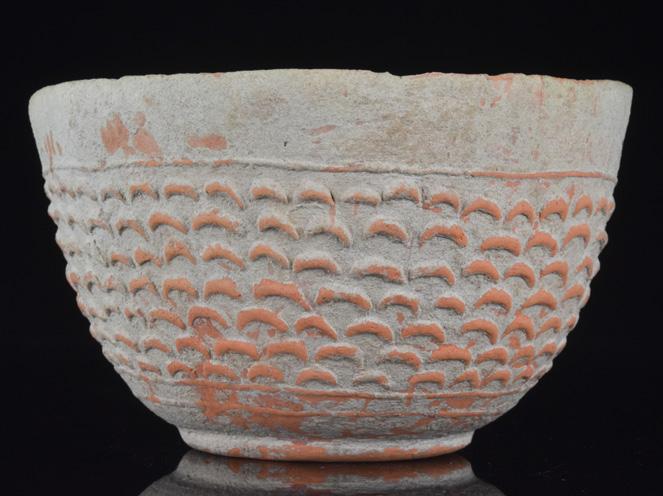

Provenance: Ex High Wycome Estate Collection, Ex London Gallery Collection, Ex UK Art Market Acquired Prior to 1980
192.


Ca. 100-300 AD
Starting price: £200
A charming vessel presenting with a tall piriform body rising to a petite flared mouth, a single strap handle and a short concave foot. Size: L:85mm / W:75mm ; 55g.
Provenance: Ex High Wycombe Collection, Ex German Gallery Ex, Private Collection From North Netherlands.
193.
Ca. 100-300 AD
Starting price: £300
A mould-made terracotta oil lamp with concave discus bearing a relief image of a defeated gladiator facing right. He is depicted in a seated position, he wears a helmet and holds a gladius in his right hand. Size: L:110mm / W:82mm ; 80g.
Provenance: Private UK collection; From an old London collection formed in the 1990s.
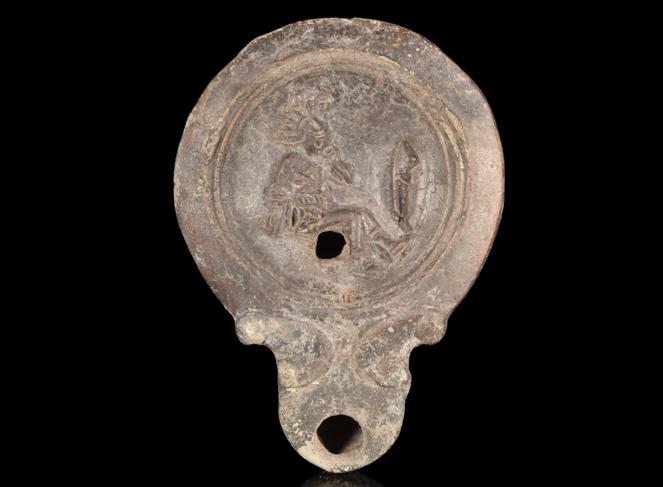
Ca. 200-300 AD
Starting price: £300
A terracotta oil lamp of a discoid body, looped handle, small nozzle, rounded spout, and a recessed discus bearing an erotic scene in relief. Size: L:103mm / W:75mm ; 74g.


Provenance: Private UK collection; From an old London collection formed in the 1990s.
Ca. 100-200 AD
Starting price: £200
A ceramic lamp depicting a horsedrawn chariot. The filling hole on the discus and a wide spout adorned with pair of volutes. Size: L:25mm / W:67mm ; 60g.
Provenance: Private UK collection; from an old London collection formed in the 1980s.
Ca. 100-200 AD
Starting price: £100
A mould-made terracotta oil lamp with concave discus bearing a relief image of a standing heron facing left. Size: L:75.1mm / W:55.8mm ; 45.63g.
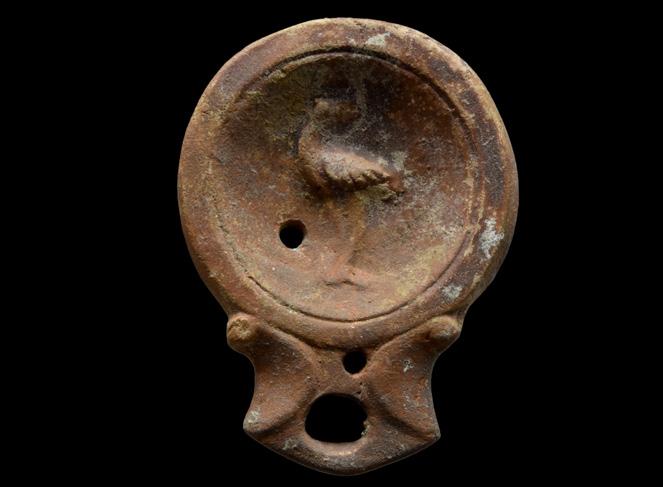

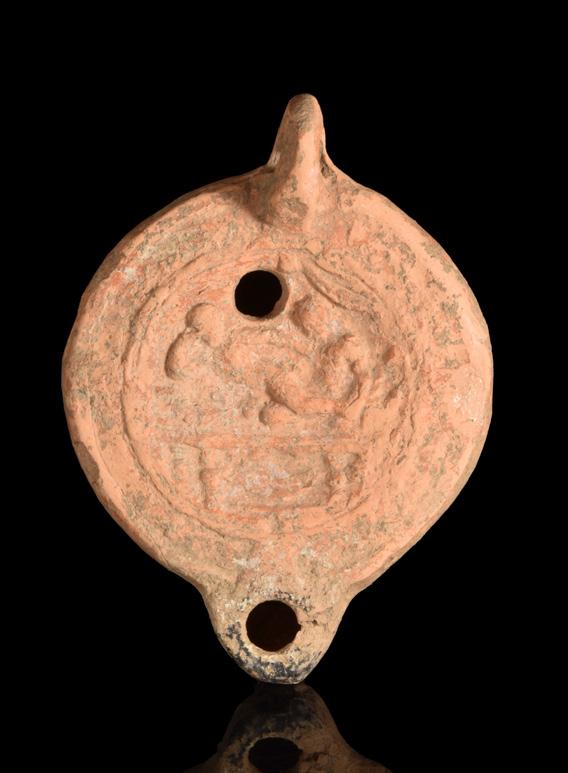
Provenance: Property of a North London gentleman; previously acquire on the UK/ European art market in the 1980s.
Ca. 1st-4th century AD
Starting price: £300
A Roman oil lamp taking the form of a Satyr or, perhaps, the deity Priapus. Mould-made, this lamp presents an intricate and unusual form, with a large grotesque face capturing the eye. Size: L:170mm / W:80mm ; 336g.
Provenance: Acquired from a London gallery; Formerly with Arnos Jumperz, Leverkusen Germany. His collection was formed before 1994 and passed by descent to his family.
196.
Ca. 100-200 AD
Starting price: £100
A figural terracotta oil lamp with a single handle. The discus is framed by two concentric rings, in the middle is a frontal portrait with a high headgear and horns. Size: L: 101mm / W: 70mm; 54.7g.
Provenance: Acquired from a London gallery; formerly with Arnos Jumperz, Leverkusen Germany. His collection was formed before 1994 and passed by descent to his family.
199. ROMAN GLASS PLATE

Ca. 50-200 AD
Starting price: £500
A beautiful light green, blown glass dish with a rounded lip on a low round foot. Comparative piece: Harden, D. B. (1987). Glass of the Caesars. Milan: Olivetti. p. 98. Size: L:53mm / W:235mm ; 278.3g.
Provenance: Private collection of a London gentleman; previously in a collection formed on the UK/International art market since the 1970s.
Ca. 100-300 AD
Starting price: £900
A beautiful bottle formed in translucent green glass, the body globular with a slightly outsplayed vertical rim, with a hollow horizontal flange below, made by folding slender cylindrical neck. For a similar see The Metropolitan Museum: 17.194.128. Size: L:205mm / W:115mm ; 200g.
Provenance: London Anient Art Gallery 2000, ex of London Gallery, Ex New York Gallery- Fortuna Fina Arts.
201.


Ca. 100-200 AD
Starting price: £500
A large heavy blown glass flask with a globular body, long tubular neck, and flat base, with wheel cut banding over the entire body and neck, with a rolled rim. Size: L:175mm / W:137mm; 166.88g.
Provenance: Private London collection; acquired in the 1990s on the UK art market. Exhibited: Olympia Art & Antiques fair, London June 2022.
202.
Ca. 200-300 AD
Starting price: £500
An elaborately modelled glass flask in light green with long everted neck and bulbous shaped body, the neck has a wheel made trailing decoration which has been applied afterwards. Size: L:170mm / W:100mm; 99g.
Provenance: Private London collection; acquired in the 1990s on the UK art market.
Ca. 100–200 AD
Starting price: £500
A free-blown sprinkler flask of transparent aquamarine glass featuring a cylindrical flaring neck and a funnel-shaped mouth. The globular body is decorated with small, pinched knobs. Size: L:108mm / W:87mm ; 135.5g.

Provenance: David Ruskin Collection, Oxford 1970 004.
204.
Ca. 100-300 AD
Starting price: £200
A rare glass amphora or amphoriskos with flaring rim, tapering neck, flaring shoulder and truncated conical body; two fine strap handles are applied to the rim and the shoulder; much of the exterior is covered in a thin horizontal trail. Size: L:110mm / W:40mm ; 45g.
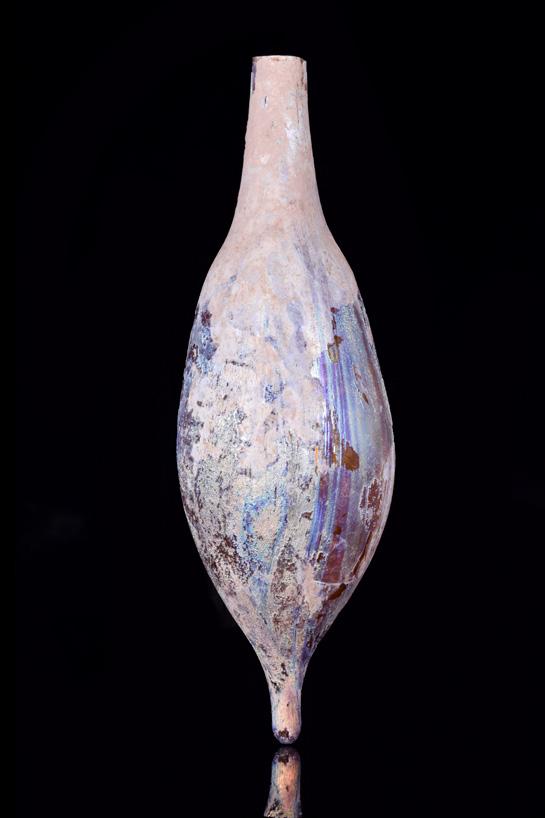


Provenance: Property of a London businessman; formerly in an old English collection; acquired in the 80s and 90s.
205. ROMAN GLASS UNGUENTARIUM
Ca. 1st-3rd century AD
Starting price: £200
An amphora shaped vessel with an ovoid body with a strand of glass pulled out at the bottom to form a tip and a tall tubular neck. Size: L:140mm / W:42mm ; 28.35g.
Provenance: Property of a West London gentleman; previously in a collection formed on the UK/International art market in the 1990s.
206.
Ca. 300-400 AD
Starting price: £200
A beautiful cylindrical, multicolour (black, blue, white, green) alabastron tapering towards the mouth. Alabastra were an ancient form of vessel, used to contain cosmetics, oils and perfumes. Size: L:168mm / W:16mm ; 33g.
Provenance: Property of a London gentleman, formerly acquired in Europe in the 1970s.
Ca. 300-400 AD
Starting price: £300
A finely modelled double balsamarium in dark green glass; The vessel is composed of two conjoined tubular phials with slightly flared and thickened rims. Size: L:170mm / W:63mm; 64g.
Provenance: Private London collection; acquired in the 1990s on the UK art market.
Ca. 300-400 AD
Starting price: £200
A finely modelled double Balsamarium in pale green glass. The vessel is composed of two conjoined tubular phials with slightly flared and thickened rims. Size: L:185mm / W:73mm; 84g.
Provenance: Private London collection; acquired in the 1990s on the UK art market. Exhibited: Olympia Art & Antiques fair, London June 2022.
Ca. 200-400 AD

Starting price: £200
A fine Ancient Roman cosmetic container blown from pale green glass with nice purple silver iridescence evident. The vessel features a slender piriform body with trailing ribbed decoration. It stands on a splayed foot. Size: L:115mm / W:50mm ; 79.2g.
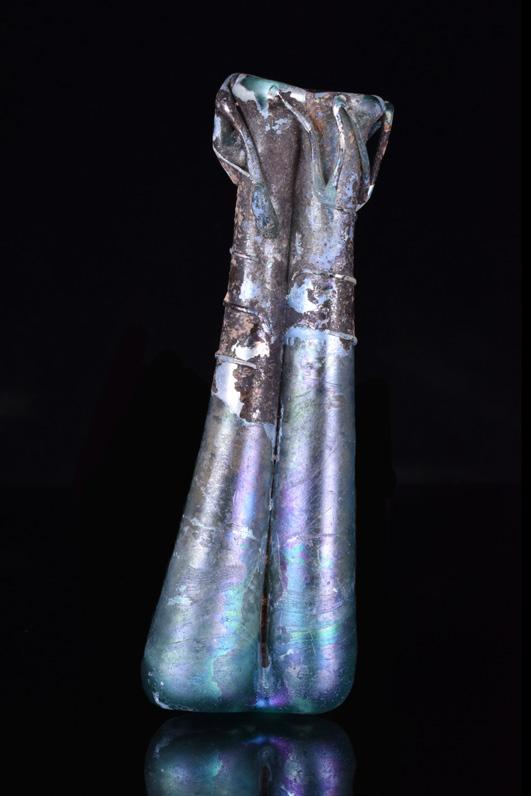
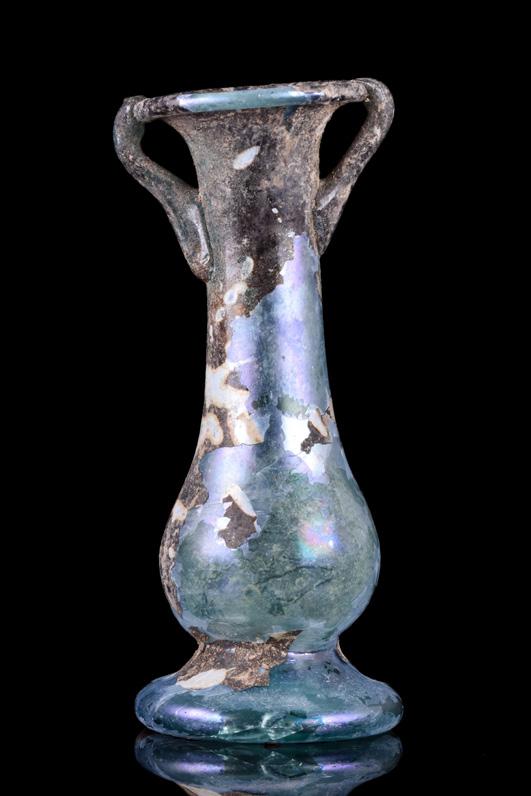
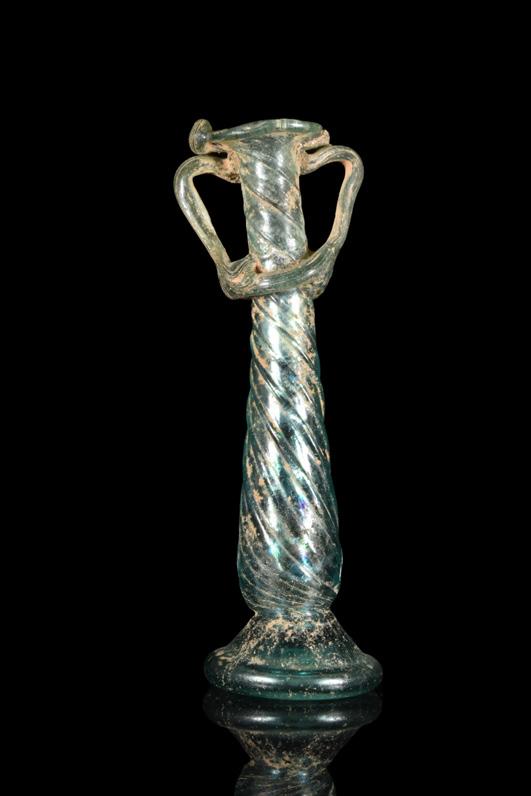
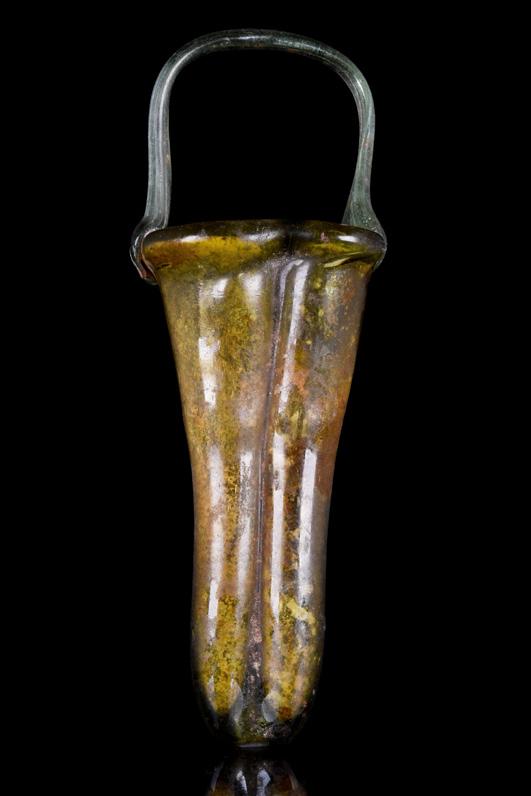
Provenance: From an old British collection, acquired on the UK art market in the 1980s.
210.
Ca. 4th–5th century AD
Starting price: £200
A glass unguentarium with a piriform body standing on an applied disc base featuring an everted mouth and applied handles that join the shoulder to the rim. Size: L:115mm / W:50mm ; 79.2g.


Provenance: Private UK collection; From an old British collection formed in the 1990s;
211.
UNGUENTARIUM
Ca. 200–300 AD
Starting price: £200
A double-tube glass balsamarium with decorative applied trails, green-clue tinge. Size: L:145mm / W:48mm ; 73.5g.
Provenance: Property of a West London gentleman; previously in a collection formed on the UK/International art market before 2000.
212. ROMAN GLASS DOUBLE
UNGUENTARIUM
Ca. 200-300 AD
Starting price: £200
A double-tube glass balsamarium with decorative applied trails, green-clue tinge. Size: L:92mm / W:38mm ; 43.85g.
Provenance: Property of a West London gentleman; previously in a collection formed on the UK/International art market before 2000.
213. ROMAN GLASS DOUBLE UNGUENTARIUM
Ca. 200-300 AD
Starting price: £200
A double-tube glass balsamarium with decorative applied trails, brilliant iridescence. Size: L:113mm / W:43mm ; 21.8g.
Provenance: Property of a West London gentleman; previously in a collection formed on the UK/International art market before 2000.


Ca. 1st-3rd century AD
Starting price: £200
Blown glass flask with a roughly cuboid body and an elongated neck that flares outwards towards the top. Deep green-brown hue. Size: L:120mm / W:70mm ; 45g.
Provenance: From the private collection of Mr. R. Unger; previously with a London gallery; acquired in before 2000 on the UK art market.
Ca. 200-300 AD
Starting price: £200
A beautiful translucent green jar with bulbous body, handles in same colour, an outsplayed rim, folded over and in, and smoothed into the side of the mouth, a broad funnel-shaped neck, a narrow shoulder. Size: L:83mm / W:93mm ; 75.9g.
Provenance: Private collection of a West London gentleman; previously in a collection formed on the UK/International art market before 2000

Ca. 100-300 AD
Starting price: £100
A glass flask with a spherical body, a short funnel-shaped neck and a wide, flanged profile mouth. Some weathering and incrustation occur throughout the flask; the outside shows a beautiful iridescence. Size: L:70mm / W:60mm ; 40g.
Provenance: Private UK collection; From an old London collection formed in the 1990s.
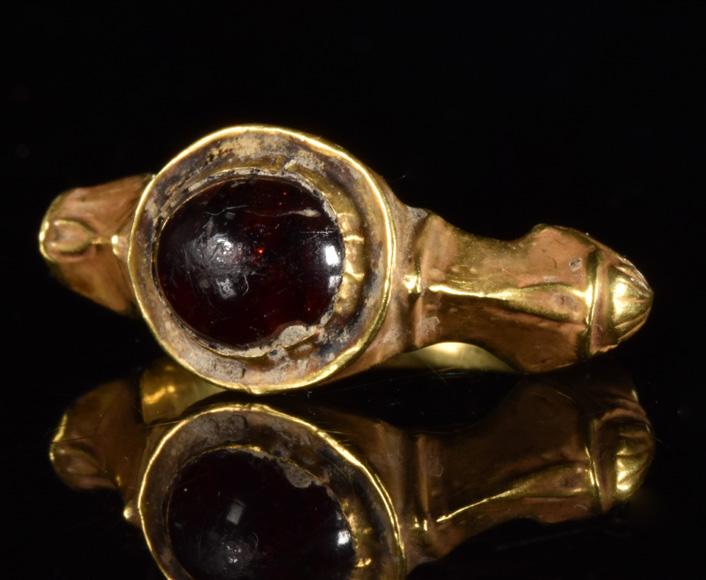
Ca. 400-200 BC
Starting price: £300
A gold finger ring composed of a round hoop with hunched shoulders and an integral bezel cell with garnet cabochon inset. Excellent condition, wearable. Size: D: 17.12mm / US: 6 3/4 / UK: N; 2g.
Provenance: From an old British collection, acquired on the UK art market in the 1980s.
216.
Ca. 400-500 AD
Starting price: £200
A well blown ancient Roman greenish blue glass flask, featuring a bulbous globular body, cylindrical neck, and wide rim. Size: L:107mm / W:45mm; 74g.
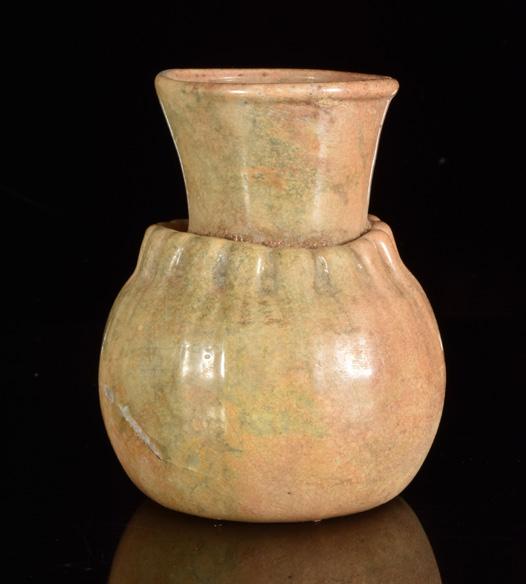
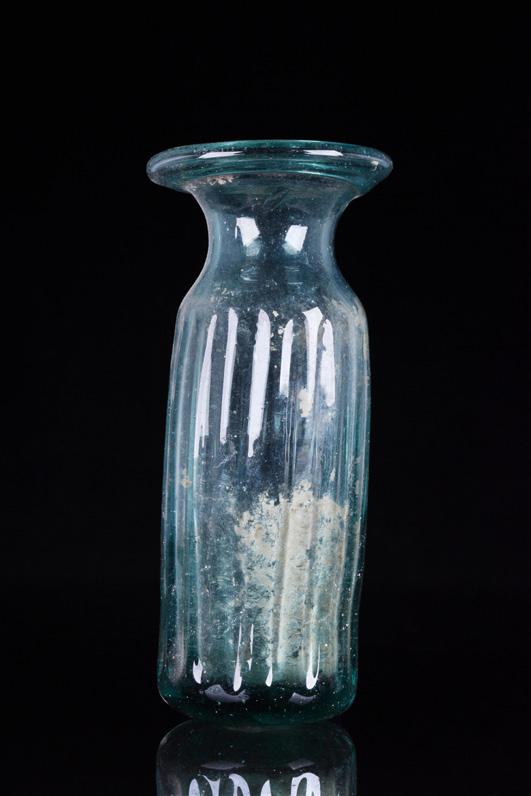
Provenance: Private London collection; acquired in the 1990s on the UK art market.
Hellenistic, Ca. 200-1 BC
Starting price: £500
A gold wire bracelet with a round-section shank, knot clasp, and coiling around each terminal. Absolutely could be worn but rather as a slip-on bangle. The twist coil accents and tangled spirals give this bracelet a simple, near contemporary look. Size: L:76mm / W:9mm ; 19.82g.
Provenance: Private London collection; Previously with I.G.; acquired from an East Coast, USA collector prior to 1979. Exhibited: Olympia Art & Antiques fair, London June 2022.

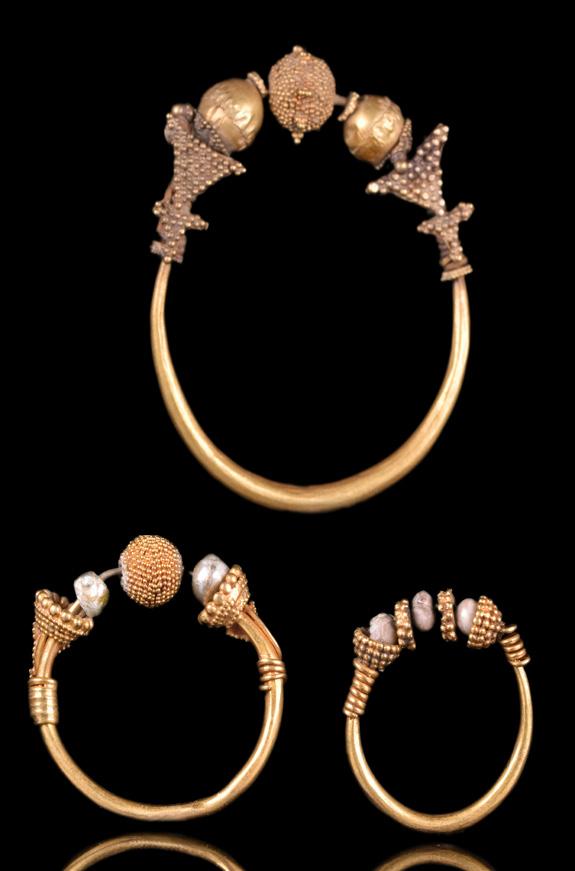
Ca. 100-300 AD
Starting price: £900
A substantial pair of Ancient Roman gold earrings featuring a large convex shaped bead which looks like a vessel, with a beautiful pendant decorated with fine granulation on its rim. Size: Set of 2: L:44mm / W:15mm; 9.3g.
Provenance: Private London collection of Ancient Art; previously with a London art dealer; acquired from a Japanese collection (1970-2010). Exhibited: Olympia Art & Antiques fair, London June 2022.
Ca. 100 BC - 300 AD
Starting price: £2,700
A beautiful necklace comprising biconical and barrel-shaped beads. For a comparison see Christie’s, lot 154, Oct 1, 2014. For a similar see Cf. M. Spaer, Ancient Glass in the Israel Museum, Beads and Other small objects, Jerusalem, 2001, p. 109, no. 156, pl.12. Size: L:256mm / W:63mm ; 65g.
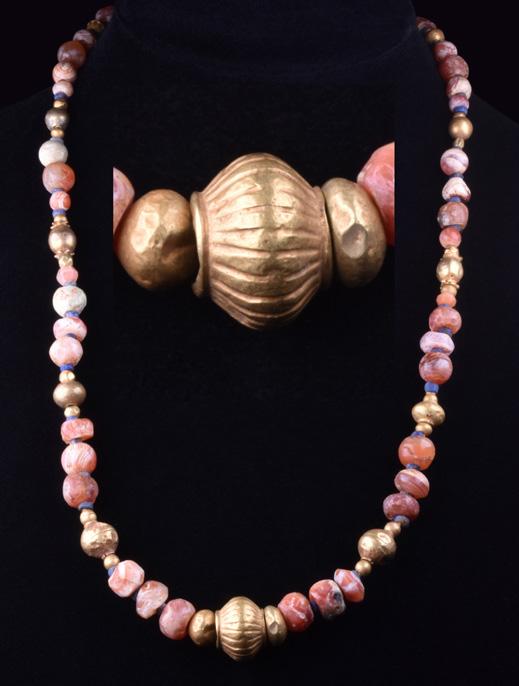

Provenance: Property of a private London collector, acquired pre 2000.
Ca. 400 BC
Starting price: £300
A restrung necklace comprising large carnelian beads, interspersed with small lapis lazuli and gold beads. Necklaces were part of the feminine costume in the Hellenistic world and were used both for aesthetic purposes and to communicate social messages of status and wealth. Size: L:575mm / W:17.3mm ; 43.93g.
Provenance: Property of a West London gentleman; previously in a collection formed on the UK/International art market since the 1970s.
224.
Ca. 400 BC
Starting price: £300
Ca. 400 BC
Starting price: £300
A restrung necklace comprising lapis lazuli beads, interspersed with biconical and spherical gold beads. Necklaces were part of the feminine costume in the Hellenistic world and were used both for aesthetic purposes and to communicate social messages of status and wealth. Size: L:515mm / W:12.4mm ; 21.78g.


Provenance: Property of a West London gentleman; previously in a collection formed on the UK/International art market since the 1970s.
A restrung necklace comprising variously shaped glass beads, interspersed with gold beads and pendants. Necklaces were part of the feminine costume in the Hellenistic world and were used both for aesthetic purposes and to communicate social messages of status and wealth. Size: L:570mm / W:12.1mm ; 20.31g.
Provenance: Property of a West London gentleman; previously in a collection formed on the UK/International art market since the 1970s.
GREEK GOLD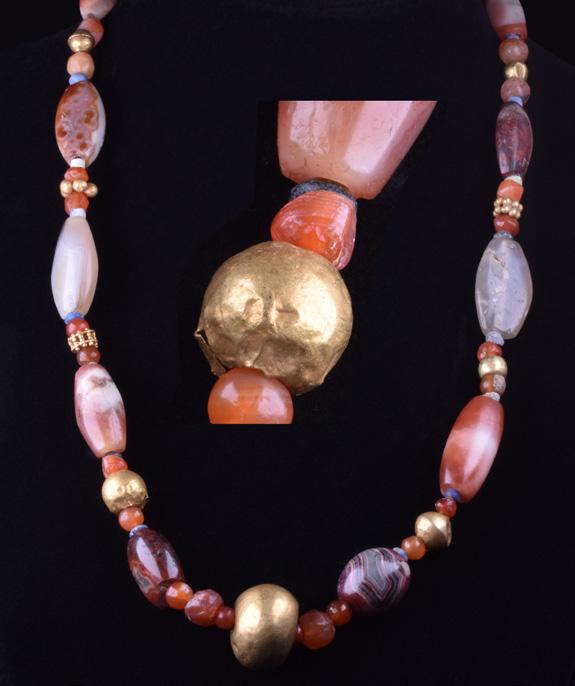
Ca. 400-300 BC
Starting price: £300
A beautiful necklace composed of variously shaped carnelian and gold beads arranged in a symmetrical manner. Restrung on a modern thread and suitable for contemporary wear.
Size: L:605mm / W:21.8mm ; 88.2g.
Provenance: Property of a West London gentleman; previously in a collection formed on the UK/International art market since the 1970s.

Hellenistic, Ca. 300-200 BC
Starting price: £400
A beautiful necklace made of raw crystal and garnet beads spaced with high karat, barrel-shaped, fluted yellow gold beads. Size: L:248mm / W:30mm ; 67.56g.
Provenance: Private London collection; Previously with I.G.; acquired from an East Coast, USA collector prior to 1979. Exhibited: Olympia Art & Antiques fair, London June 2022.

Ancient Roman, Ca. 1-100 AD
Starting price: £400
A petite necklace of small glass and gold beads. The necklace has been strung in vaguely graduated sizes. Size: L:218mm / W:18mm ; 15.82g.
Provenance: Private London collection; Previously with I.G.; acquired from an East Coast, USA collector prior to 1979. Exhibited: Olympia Art & Antiques fair, London June 2022.
Ca. 300 BC
Starting price: £200
An amphora-shaped pendant of a central wired shaft threaded with a piriform coral stone secured at the bottom with a small bead. To the top, a suspension ring, flanked by a pair of S-curved dolphins with fanned tails. Size: L:21.9mm / W:10.7mm ; 2.07g.
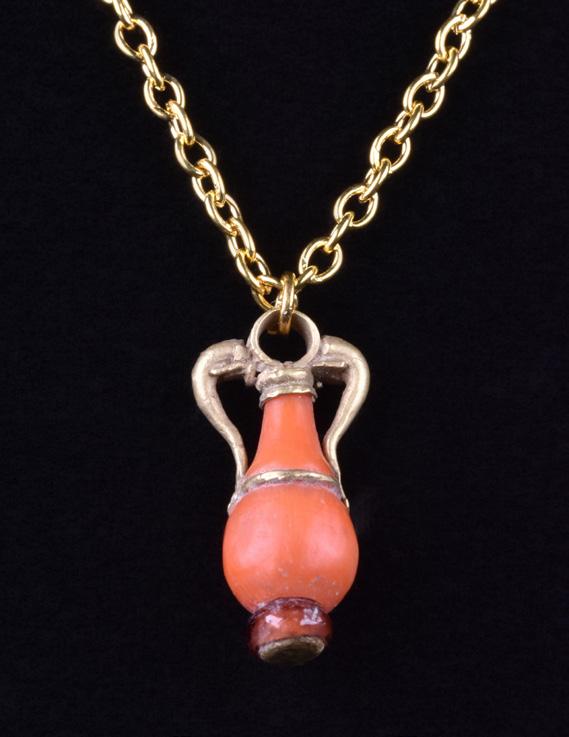
Provenance: Property of a West London gentleman; previously in a collection formed on the UK/International art market since the 1970s.
Ca. 500-300 BC
Starting price: £500
A gold circular pendant with concentric filigree decoration flanking a central large garnet cabochon. The reverse is flat and unworked. Restrung on a modern thread and suitable for contemporary wear. Size: L:28.1mm / W:26mm ; 10.3g.

Provenance: Property of a North London gentleman; previously acquire on the UK/European art market in the 1990s.
Ca. 1-100 AD
Starting price: £500
A bronze ring with a round hoop widening at the shoulders and set with a gilded bezel cell bearing a carnelian intaglio engraved with a bust of a bearded Serapis, a syncretic deity of Hellenistic Egypt, combining the features of some Egyptian and Greek gods. Size: D: 16.1mm / US: 5 1/2 / UK: K 1/2; 11g.
Provenance: Property of a North London gentleman; previously acquire on the UK/European art market in the 1990s.

230. ROMAN BRONZE RING WITH PENTAGRAM Ca. 1-200 AD

Starting price: £100
A bronze ring with a round hoop with incised decoration on the shoulders, and flattened, circular bezel bearing a pentagram within a circle. For more information on Roman rings, see: Cf. Ruseva-Slokoska, L. Roman Jewellery, Sofia, 1991. Good condition; wearable. Size: D: 17.12mm / US: 6 3/4 / UK: N; 5.81g.
Provenance: From the private collection of a South London art professional; previously in a collection formed on the UK/European art market in the 1980s;
231. ROMAN BRONZE SEAL RING WITH STYLISED TIBERIUS PORTRAIT Ca. 1st century AD
Starting price: £100
A rare bronze finger ring formed of a round, slender hoop gently expanding to support a circular flat bezel bearing a right-facing stylised bust of Emperor Tiberius - the second emperor of Rome (14-37 AD), as the successor of Imperator Caesar Augustus. Good condition. Size: D: 15.39mm / US: 4 1/2 / UK: I 1/2; 1.93g.
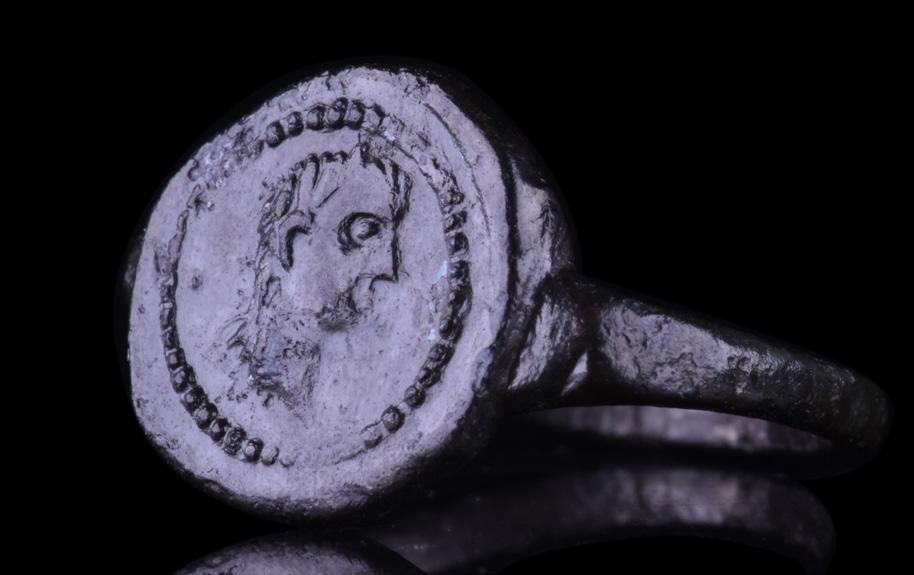
Provenance: From the private collection of a South London art professional; previously in a collection formed on the UK/European art market in the 1980s;
232. ROMAN BRONZE RING WITH X PATTERN Ca. 200 AD
Starting price: £100
A cast bronze legionary ring with round hoop and an integral bezel engraved with ‘X’ pattern, representing number 10 in Latin, possibly standing for the 10th Legion. Very well preserved, wearable ring. Size: D: 17.73mm / US: 7 1/2 / UK: O 1/2; 5.13g.
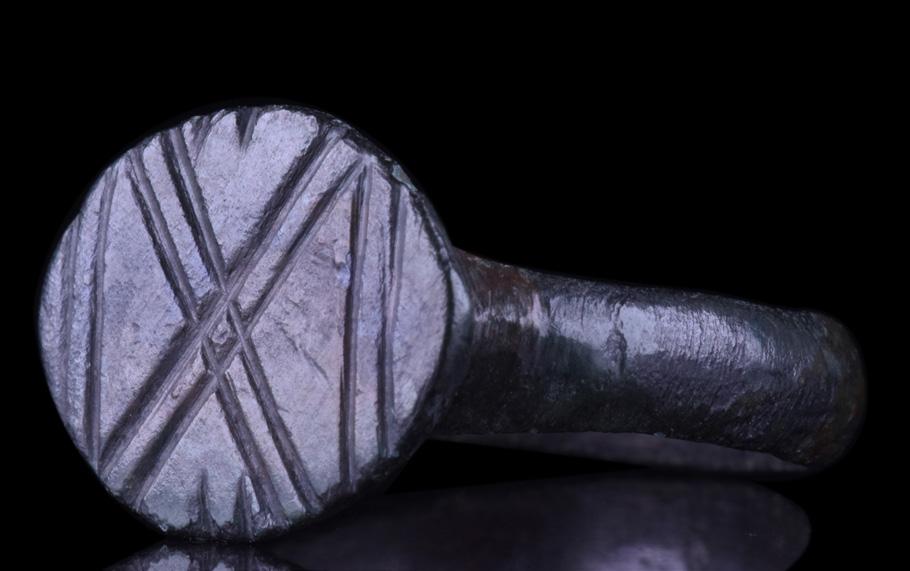
Provenance: From the private collection of a South London art professional; previously in a collection formed on the UK/European art market in the 1980s.
233. ANCIENT ROMAN SILVER BRACELET Ca. 100-300 AD
Starting price: £100
A fine open-type bracelet composed of a silver band with its ends embellished with small notches. A beautiful and wearable piece of fine Roman jewelry! Size: L:67mm / W:68.7mm ; 40.41g.
Provenance: From the private collection of a South London art professional; previously in a collection formed on the UK/European art market in the 1980s;
234. ANCIENT ROMAN SILVER BRACELET Ca. 100-300 AD
Starting price: £150
An elegant, penannular bracelet made of silver. The body is smooth, round-section, with incised designs around its terminals. A beautiful and wearable piece of fine Roman jewelry. Size: L:67.8mm / W:57.4mm ; 35.97g.
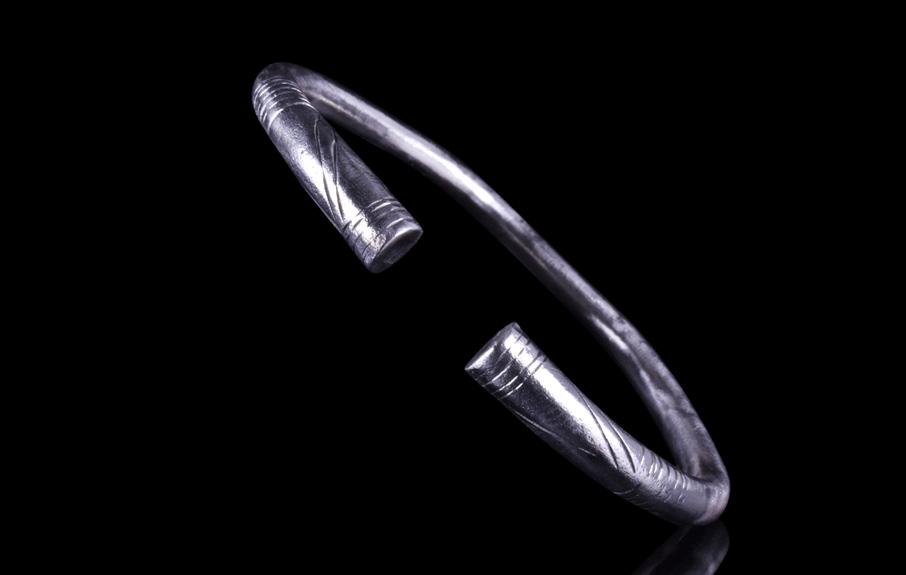
Provenance: Property of a West London gentleman; previously in a collection formed on the UK/International art market since the 1970s.

234A.
Ca. 100-200 AD
Starting price: £100
A bronze disk brooch with openwork decoration forming abstract geometric patterns and a well-preserved pin and catchplate on the reverse. Brooches were an important element of Roman dress, used to fasten clothing but they also served as dress accessories in their own right. Size: L:81mm / W:81mm ; 64g.
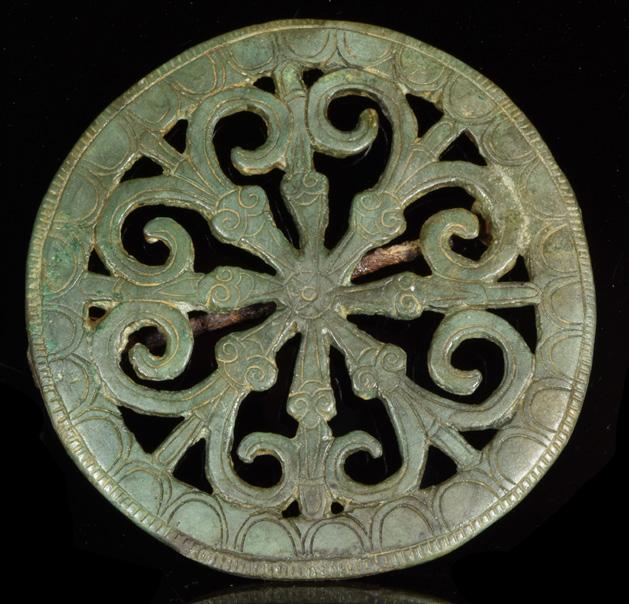
Provenance: Private UK collection ; From an old Oxford collection formed in the 1980s.
Ca. 100-300 AD
Starting price: £100
A bronze disk brooch with openwork decoration forming ROMA inscription. Catch-plate with a pin on the reverse. Brooches were an important element of the Roman dress, used to fasten clothing but they also served as dress accessories in their own right. Size: L:48.6mm / W:49.5mm ; 20.81g.
Provenance: From the private collection of a South London art professional; previously in a collection formed on the UK/ European art market in the 1980s.
235. ROMAN MOSAIC DISC
Ca. 300 AD
Starting price: £200
A beautiful flat circular broach featuring a central raised boss and a concentric ring decoration inlaid with coloured enamelling in a green, red, and light blue palette; two circular additions on the sides, one of which is a loop; excellent condition. Size: L:33mm / W:43mm ; 12.6g.
Provenance: From an old British collection formed in the 1980s.
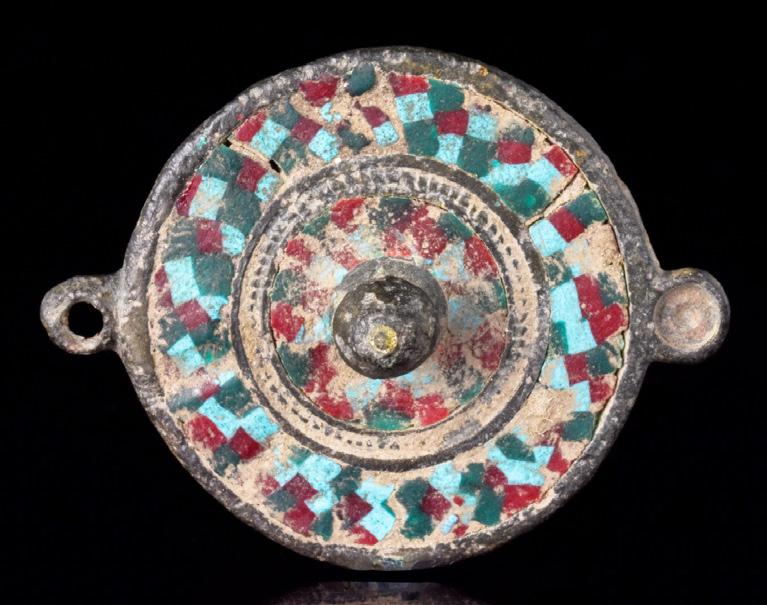

300 AD
Starting price: £200
A beautiful esagonal broach featuring small decorative peripheral lugs with coiled decoration, the rim decorated with an hatched pattern, and a recessed central ring encased by a blue panel decorated with white and red circles; excellent condition. Size: L:35mm / W:35mm ; 6.8g.
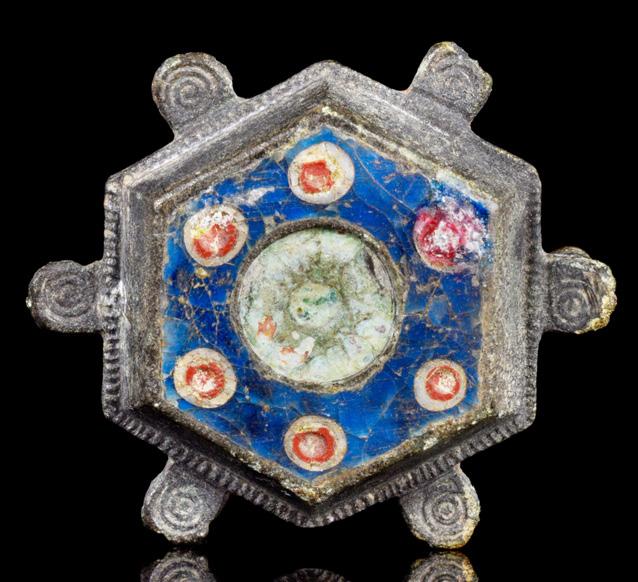
Provenance: From an old British collection formed in the 1980s.
Ca. 100-200 AD
Starting price: £200
Bronze brooch in the form of a fly or cicada, with broad, curving wings and stylised head. The catch plate and hinge are still present on the reverse. Zoomorphic brooches were common under the Roman Empire, and are typically associated with Gaul and Britain, where they may have been an important part of dress amongst military communities. Size: L:61mm / W:24mm ; 14.3g.
Provenance: From the private collection of an Essex gentleman; previously in an old British Collection, formed in the 1980s.

Ca. 100 AD
Starting price: £200
A silver fibula brooch with an anchor-shaped body decorated with spheres to each finial. Spring mechanism with a pin and a catch plate to the back. Size: L:52.2mm / W:32.3mm ; 31.4g.
Provenance: From the private collection of a South London art professional; previously in a collection formed on the UK/European art market in the 1980s.

200-300 AD
Starting price: £100
A bronze open work plate brooch in the shape of a wheel, also known as a “Wheel of Fortune”, depicting the Sun symbol in the centre. Good Condition. Cf. Richard Hattatt (2000), A Visual Catalogue of Richard Hattatt’s Ancient Brooches. Oxbow Books, p. 357, item 1626. Size: L:36.6mm / W:39.5mm ; 11.59g.
Provenance: From the private collection of a South London art professional; previously in a collection formed on the UK/ European art market in the 1980s.
100-300 AD
Starting price: £100
A bronze brooch in a form of a swastika with four stylised horse head terminals, and a catch-plate on the reverse. The swastika was a symbol of lightning bolts in Roman art and is therefore associated with the thunder god, Jupiter. Size: L:31.6mm / W:33.5mm ; 9.37g.
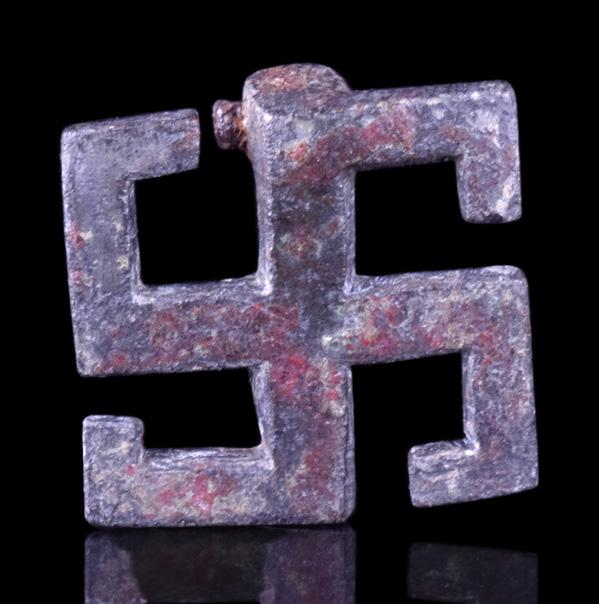

Provenance: From the private collection of a South London art professional; previously in a collection formed on the UK/European art market in the 1980s.
100-300 AD
Starting price: £100
A bronze openwork swastika brooch with a catchplate on the reverse. The swastika was a symbol of lightning bolts in Roman art and is therefore associated with the thunder god, Jupiter. Size: L:24.5mm / W:24.8mm ; 9.07g.

Provenance: From the private collection of a South London art professional; previously in a collection formed on the UK/European art market in the 1980s.
242.
BROOCH Ca. 100-300 AD
Starting price: £100
A bronze S-shaped brooch with a catch plate on the reverse. Good condition. This object conveys the pervasiveness of a Celtic aesthetic in the Empire’s western provinces in the first centuries AD. Size: L:36.6mm / W:18.8mm ; 7.56g.
Provenance: From the private collection of a South London art professional; previously in a collection formed on the UK/European art market in the 1980s.
243.
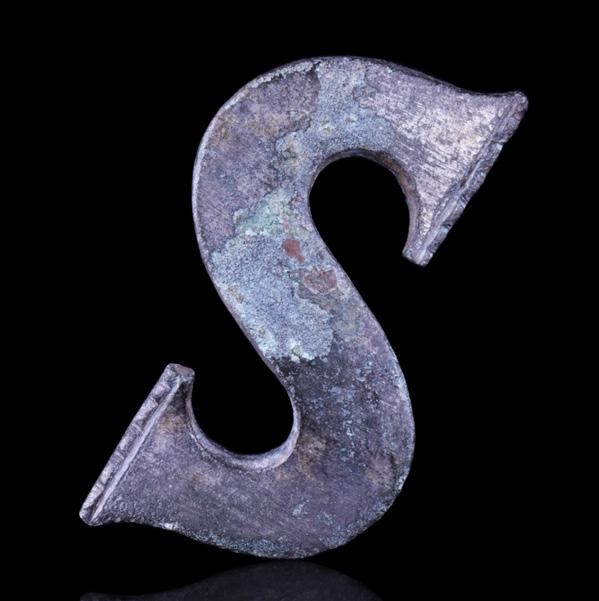
Ca. 200-300 AD
Starting price: £100
An axe-shaped brooch with an asymmetric blade stretching downwards. This broach is probably reflecting the martial nature of societies on the edge of the Roman world, and closest to the uncivilised lands of the Barbaricum (Barbarian lands). Fair condition. Size: L:32.3mm / W:21.2mm ; 6.82g.

Provenance: From the private collection of a South London art professional; previously in a collection formed on the UK/European art market in the 1980s.
244. ROMAN

Ca. 100-300 AD
Starting price: £100
A nice bronze plate brooch of a grazing horse on a baseline. The animal is modelled in the half-round with a looped tail. Catch plate to the reverse. Good condition. For comparable brooches, see Richard Hattatt (2000), A Visual Catalogue of Richard Hattatt’s Ancient Brooches. Oxbow Books, p. 359. Size: L:34.3mm / W:25.4mm ; 11.53g.
Provenance: From the private collection of a South London art professional; previously in a collection formed on the UK/European art market in the 1980s.
Starting price: £100
A bronze herm pendant of a quadrangular post narrowing downwards, and at the top ending with a bust of a man with his hair swept back and a large loop protruding from the top of his head. Size: L:117mm / W:25.6mm ; 80.06g.
Provenance: From the private collection of a South London art professional; previously in a collection formed on the UK/European art market in the 1980s.
Starting price: £100
Four Roman glass bracelets of various sizes in a green, black, and blue palette. In contrast with the paucity of black glass vessels, a wide range of dark-coloured glass jewellery is known to have been produced in large quantities, in particular during the late Roman period (Loeschke, S. (1925). Frühchristliche Werkstätte für Glassschmuck in Trier. 337–360. Trierer Heimatbuch, Trier). Examples, particularly on the Continent, show that mostly children, and in particular female juveniles, wore black glass bracelets, Bayley, J., Freestone, I., & Jackson, C. (2015). Glass of the Roman World. Oxford And Philadelphia: Oxbow Books, 196). Good condition, wearable. Size: L:SET OF 4: 58MM, 83mm / W:58MM, 76mm ; 60g.
Provenance: From an old Oxfordshire collection formed in the 1990s.


Late Roman, Ca. 300-500 AD
Starting price: £100
A group of five glass bracelets (also referred to as bangles) comprising monochrome glass strains bent into a loop. Colours in this group include: 1) black, 2) blue. These versatile objects might also have been used to adorn women’s elaborate hairstyles and/or to decorate horses. Glass bangles had a long lifespan and were also worn in the Middle Ages under Rome’s successor state, the Byzantine Empire, where women often wore dresses which revealed their arms, making bracelets an especially appropriate accessory choice. Size: L:63.5-70.2mm / W:64.5-71.7mm ; 73.19g.
Provenance: Property of a West London gentleman; previously in a collection formed on the UK/International art market since the 1970s.

Ca. 200 AD
Starting price: £900
A carnelian intaglio engraved with a scene of Leda and the Swan set in a possibly later gold ring. Leda, a princess from Aetolia, who would later become the queen of Sparta, was carried off by Zeus, king of the gods, in the form of a swan. According to a later mythological tradition, their sexual union would lead to the birth of Helen and Polydeuces, two major figures in Greek mythology.
Size: D: 17.12mm / US: 6 3/4 / UK: N; 2g.
Provenance: From the late Alison Barker collection, a retired London barrister; from her collection formed 1960s-1990s.


Ca. 100 AD
Starting price: £500
A gold finger ring composed of a slender round hoop with an applied bezel cell set with a stone intaglio engraved with gryllos - a grotesque combination. Size: D: 16.92mm / US: 6 1/2 / UK: M 1/2; 4g.
Provenance: Property of a North London gentleman; previously acquire on the UK/European art market in the 1990s.
Ca. 100-200 AD
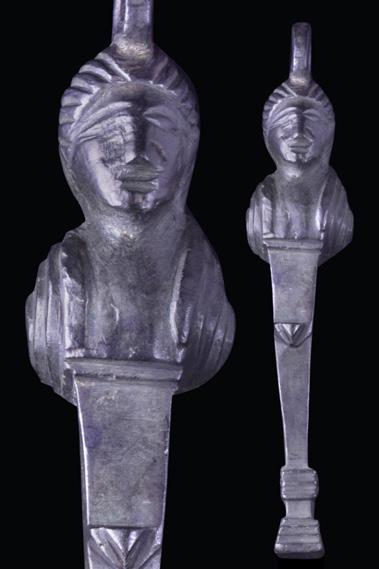
Starting price: £300
A gold finger ring of a thin hoop with fine granules to each shoulder. The bezel centred by an intaglio depicting a figural representation of Cupid facing left. In Roman mythology, Cupid (known as Eros to the Greeks) was the god of love. Size: D: 16.51mm / US: 6 / UK: L 1/2; 2g.
Provenance: Property of a North London gentleman; previously acquire on the UK/European art market in the 1990s.
251. ROMAN GOLD RING WITH VENUS STONE INTAGLIO Ca. 100-300 AD
Starting price: £500
A beautiful gold finger ring with a circular hoop and a slender bezel set with a stone intaglio engraved with a depiction of partially robed Venus, turned left. The ancient Roman deity of beauty, love, desire, and sex, Venus is often perceived as the equivalent of the Greek goddess Aphrodite. Size: D: 14.68mm / US: 4 3/4 / UK: J; 2g.

Provenance: Property of a North London gentleman; previously acquire on the UK/European art market in the 1990s.
252. ROMAN GOLD RING AND CARNELIAN INTAGLIO DEPICTING FORTUNA REDUX Ca. 100-300 AD
Starting price: £500
A gold ring with oval-shaped carnelian intaglio engraved with a standing profile figure of Fortuna, her head facing right, she is holding a steering oar and cornucopia. From the Roman Republic onwards it became customary for all the chief magistrates and senators, to wear gold rings, known in Latin as annulus aureus, as a way to distinct themselves from the mass of the people. Size: D: 14.48mm / US: 3 1/2 / UK: G; 8g.

Provenance: Property of a North London gentleman; previously acquire on the UK/European art market in the 1990s.
253. ROMAN GOLD RING WITH ROCK CRYSTAL INTAGLIO Ca. 100-300 AD
Starting price: £300
A gold finger ring composed of a slender round hoop expanding to form a circular bezel set with a rock crystal gem engraved with a with a portrait of a young male facing left. Good condition; wearable. To learn more about Roman Rings see Ruseva-Slokoska, L. Roman Jewellery, Sofia, 1991. Size: D: 15.9mm / US: 5 1/4 / UK: K; 2g.

Provenance: Property of a North London gentleman; previously acquire on the UK/European art market in the 1990s.
254. ROMAN GOLD RING WITH INSCRIBED CARNELIAN INTAGLIO Ca. 300-400 AD
Starting price: £500
A D-shaped gold finger ring of a flat-section hoop with nicely sculpted shoulders forming a bezel set with and a garnet gemstone inscribed possibly with Christian monogram. Size: D: 17.93mm / US: 7 3/4 / UK: P; 5.27g.
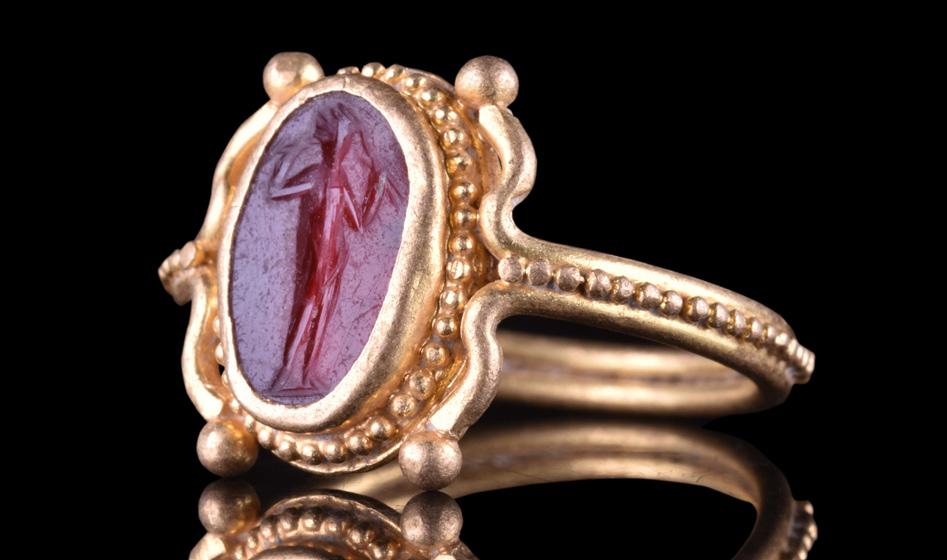
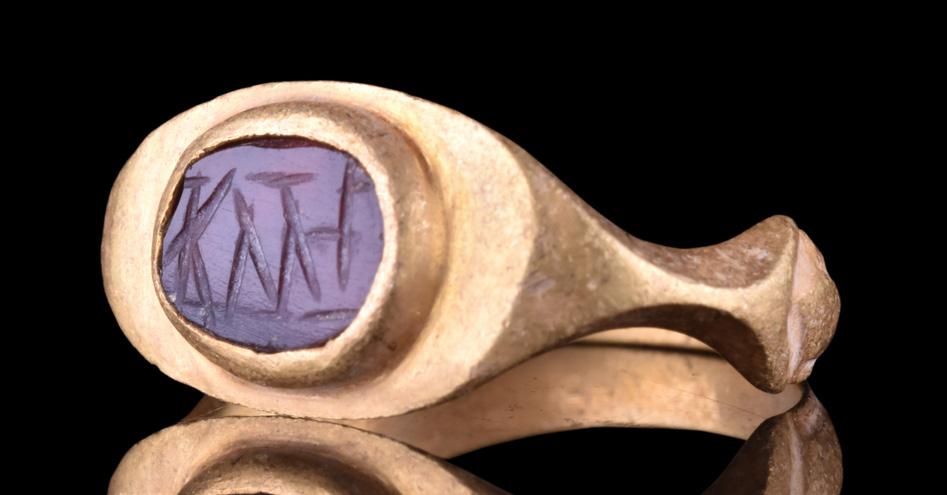
Provenance: From the private collection of a South London art professional; previously in a collection formed on the UK/European art market in the 1980s.
255. ANCIENT ROMAN STANDING VENUS INTAGLIO IN GOLD RINGCa. 100-300 AD
Starting price: £750
An oval-shaped carnelian intaglio with an engraved depiction of the standing goddess Venus with her both hands raised, set in a spectacular gold ring of a possibly later period, with a round, grooved hoop filled at both sides with fine granules. Size: D: 19.15mm / US: 9 1/4 / UK: S; 5.81g.
Provenance: From the private collection of a Central London gentleman; previously in a collection formed on the UK/European art market before 2000.
256.
Ca. 1-300 AD
Starting price: £400
A gold ring with a circular hoop, pairs of fine granules on the shoulders, and an oval-shaped intaglio with a ‘dextrarum iunctio’ (‘joining together of the right hands’) motif. Size: D: 17.73mm / US: 7 1/2 / UK: O 1/2; 2.35g.
Provenance: From the private collection of a South London art professional; previously in a collection formed on the UK/European art market in the 1980s.
257.
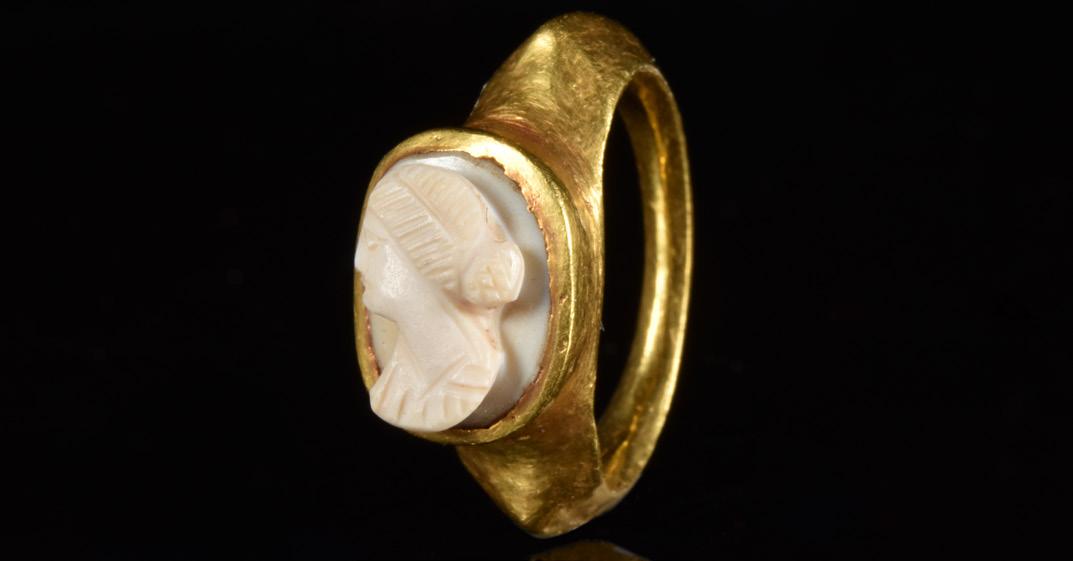
Ca. 200 AD
Starting price: £900
A beautiful cameo depicting a bust of Julia Domna, the Roman empress from 193 to 211 as the wife of Emperor Septimius Severus. She is portrayed in her left profile with delicate face details and a carefully draped robe. Size: D: 13.26mm / US: 2 / UK: D; 8g.
Provenance: From an old British collection, acquired on the UK art market in the 1980s.
258.
Ca. 100-300 AD
Starting price: £500
A beautiful gold finger ring formed of a band slightly rounded on the outside and flat to the inside, and an applied large bezel set with an emerald gemstone. Gemstone restored. Size: D: 18.34mm / US: 8 1/4 / UK: Q; 4.09g.

Provenance: From an old British collection, acquired on the UK art market in the 1980s.
259.

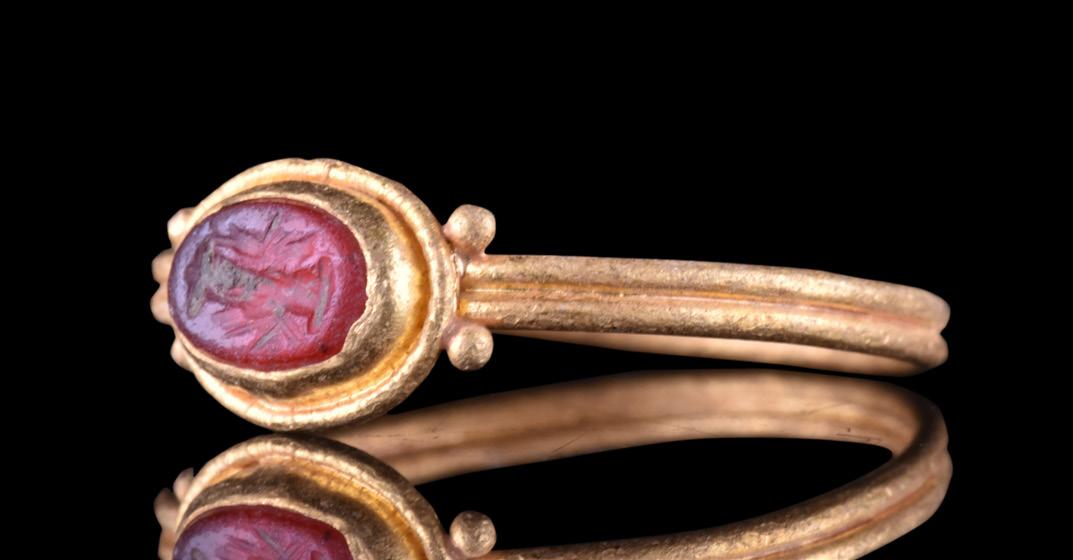
Ca. 100-200 AD
Starting price: £200
A simple yet elegant gold finger ring of a circular, slender hoop expanding to a flat bezel engraved with a palm branch oriented horizontally. Each offshoot of the branch terminates in a rounded finial. Size: D: 15.29mm / US: 4 1/4 / UK: I; 1.71g.
Provenance: From an old British collection, acquired on the UK art market in the 1980s.
260.
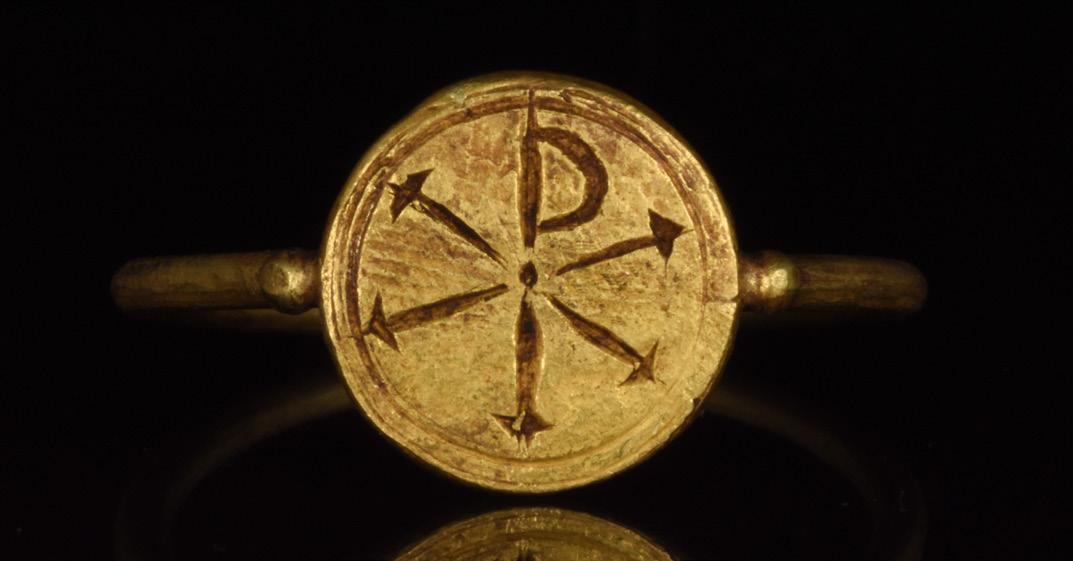
Ca. 300-400 AD
Starting price: £750
An elegant gold hoop with an attached circular plate bezel flanked by spherical baubles. The bezel features an incised Chi-Rho motif. Size: UK: T US: 9 1/2; 3.95g.
Provenance: From an old British collection acquired on the UK art market in the 1970s.
261. ROMAN GOLD EARRINGS WITH GRANULATION
Ca. 100-300 AD
Starting price: £900
A substantial pair of Ancient Roman gold earrings featuring a large convex shaped bead which looks like a vessel, with a beautiful pendant decorated with fine granulation on its rim; below this is decorated with a central tri-clustered granulation, with five granules creating a pyramid. The ancient Romans considered jewellery to be an essential dressing accessory, for it provided a public display of their wealth. Size: Set of 2: L:44mm / W:15mm; 9.3g.
Provenance: Private London collection of Ancient Art; previously with a London art dealer; acquired from a Japanese collection (1970-2010).
262.

Ca. 100-300 AD
Starting price: £500
A delicate pair of Roman gold earrings, each with a hoop with a small loop from which hang a gold drop, comprising inset circular red gems and cobalt blue and emerald-green glass circular beads. Many rich Roman women owned expensive jewellery. They wore precious stones such as opals, emeralds, diamonds, topaz and pearls set as earrings, bracelets, rings, brooches, necklaces and diadems. Repaired. Size: L:76mm / W:9mm ; 19.82g.
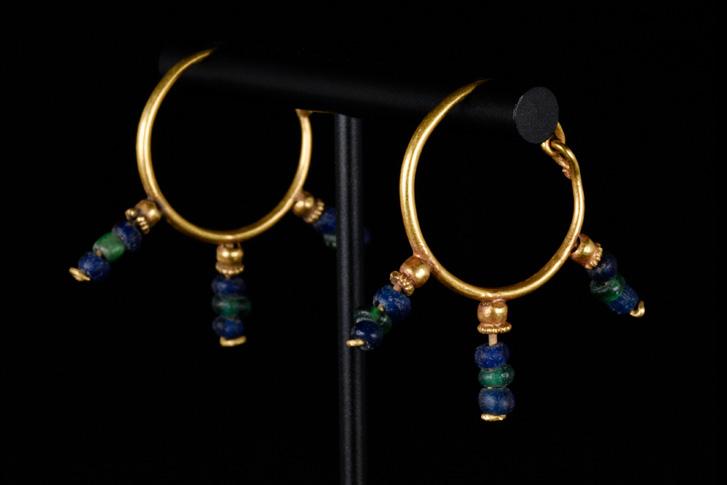

Provenance: From an old British collection, acquired on the UK art market in the 1980s.
263. ROMAN GOLD CAMEO EARRINGS
Ca. 1st-5th century AD
Starting price: £900
Pair of cameos depicting Medusa facing forward, set into gold earring bezzels with the suspension loop above and a stout gold trapezium below with three strands of colourful beads suspended from it. Size: L:47mm / W:14mm ; 4.07g.
Provenance: From an old British collection, acquired on the UK art market in the 1990s.
264.

Ca. 1-300 AD
Starting price: £500
A pair of gold hoop earrings comprising medium hoops, each with three strands of glass and gold beads. These beautiful pieces probably belonged to a Roman noblewoman. Excellent condition. Size: L:33mm / W:39mm ; 5.1g.
Provenance: Important London collection of Ancient art; formed in 1970s then passed by descent.
Hellenistic, Ca. 2nd-1st century BC
Starting price: £500
22K Gold Earrings. Openwork design bearing cabochon garnets in a triangular pattern. Excellent condition and wearable. Size: 30mm, Weight: 5.8g.

Provenance: From the property of an East Coast Collector, acquired prior to 1979. Published: To Dress in Gold, cat. no 63.
266.
Ca. 100 AD
Starting price: £500
A matched pair of rare gold pendants shaped as a bird’s claw. The surface of each gold pendant is decorated with a fine granulated pattern. The three endings of each pendant display a small gold bead. There is an integral hoop at the top for attachment to a clasp. Aristocratic Roman women owned expensive jewellery. Information about jewellery is gathered from inscriptions and statues as well as excavated material. We also have several references to jewellery in contemporary literature – usually by male satirists (e.g. Juvenal, Satires VI, 457) complaining about women’s extravagance in this respect. Size: L:Set of 2: 23mm / W:16mm ; 5.2g.


Provenance: Private UK Collection; From an old London collection formed in the 1990s.
267.

Ca. 100-200 AD
Starting price: £500
An oval-shaped highly patinated Roman glass, set in possibly later 22k gold pendant with an elegant filigree border; an integral suspension loop bearing a filigree diamond design. For more information about Roman jewellery production, see Higgins, R. (1980). Greek and Roman jewellery. London: Methuen. Size: L:47mm / W:33mm ; 9.3g.
Provenance: Private London Collection of Ancient Art.
268.
Ca. 100-200 AD
Starting price: £500
A hollow-formed gold pendant shaped like a tapering cylinder with applied filigree detailing and small gold dots; there is an integral loop on top whilst the bottom is a small gold dome with a central finial. Johns (1996, 129) argues that there is no doubt that this type of pendant is a highly stylised representation of the club of Herakles, depicted in Roman art as a heavy, tapered club with protruding knots (stylised here as dots). Size: L:31mm / W:6mm ; 2.5g.
Provenance: Previously with R.U., Parthenon Gallery, London; Formely in the 1970s Collection.
269. ROMAN SILVER GORDIAN III ANTONINIANUS PENDANT Ca. 238-244 AD
Starting price: £100
A silver coin of Gordian III Antoninianus within a modern handmade circular sterling silver setting. The coin shows on the obverse the laureate, draped and cuirassed bust of Gordian III facing right. On the reverse is Pax seated and holding an olive branch. The pendant makes a stunning statement piece necklace. Excellent condition; wearable. Size: L:30.7mm / W:23.9mm ; 6g.


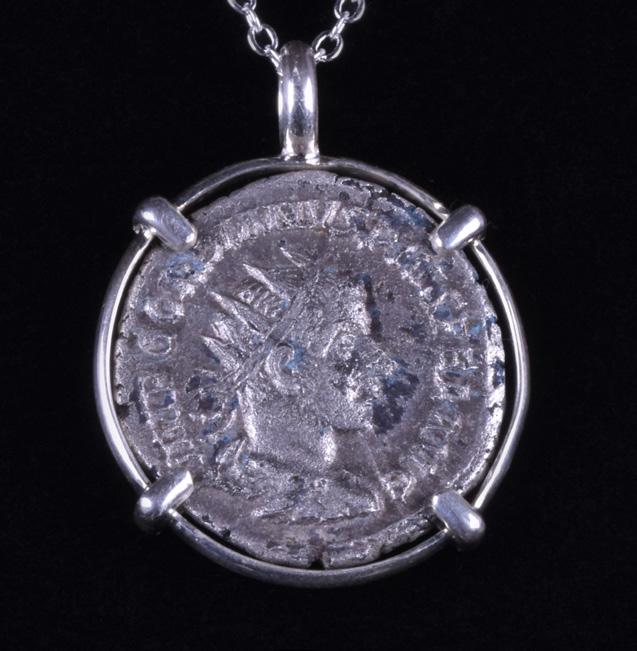
Provenance: From the private collection of a South London art professional; previously in a collection formed on the UK/European art market in the 1980s.
270. ALEXANDER THE GREAT SILVER DRACHM COIN PENDANT Ca. 295-275 BC
Starting price: £100
A silver coin / drachm of Alexander the Great within a modern handmade circular sterling silver setting. The coin shows on the obverse the head of young Herakles facing right and wearing his characteristic lion’s skin headdress. On the reverse is Zeus seated and holding an eagle and a sceptre. These coins were minted after the death of Alexander the Great, the king of Macedonia and conqueror of much of the known world as far east as India, in order to pay homage to him and lay claim to his legacy. The pendant makes a stunning statement piece necklace. Excellent condition; wearable. Size: L:30.5mm / W:21mm ; 5.88g.
Provenance: From the private collection of a South London art professional; previously in a collection formed on the UK/European art market in the 1980s.
271. ALEXANDER THE GREAT SILVER TETRADRACHM COIN PENDANT Ca. 295-275 BC
Starting price: £100
A silver coin / tetradrachm of Alexander the Great within a modern handmade circular sterling silver setting. The coin shows on the obverse the head of young Herakles facing right and wearing his characteristic lion’s skin headdress. On the reverse is Zeus seated and holding an eagle and a sceptre. These coins were minted after the death of Alexander the Great, the king of Macedonia and conqueror of much of the known world as far east as India, in order to pay homage to him and lay claim to his legacy. The pendant makes a stunning statement piece necklace. Excellent condition; wearable. Size: L:43.7mm / W:36mm ; 21g.
Provenance: From the private collection of a South London art professional; previously in a collection formed on the UK/European art market in the 1980s.
Ca. 100 BC - 100 AD
Starting price: £900
Large and rare silver necklace made of several twisted rods held together by rings, three phallic pendants are attached to the centre. Celtic society, like all patriarchal societies, had the cult of the penis at its core, to the extent that the human body was seen as a phallic object or symbol. Amulets were worn extensively by the Celts, the principal forms in use being phallic, coral, the serpent’s “egg” perhaps as protection against the evil eye. For more information on the Celtic Religion, see MacCulloch, J.A. (1911). The Religion of the Ancient Celts. Morrison & Gibb Limited, Edinburgh and on the Celts in general see Stead, I. M. (1997). Celtic Art. Harvard University Press. Size: L:600mm / W:mm ; 260g.
Provenance: From the private collection of a Cambridgeshire gentleman; previously in an old British collection, formed in the 1980s on the UK /European art markets.

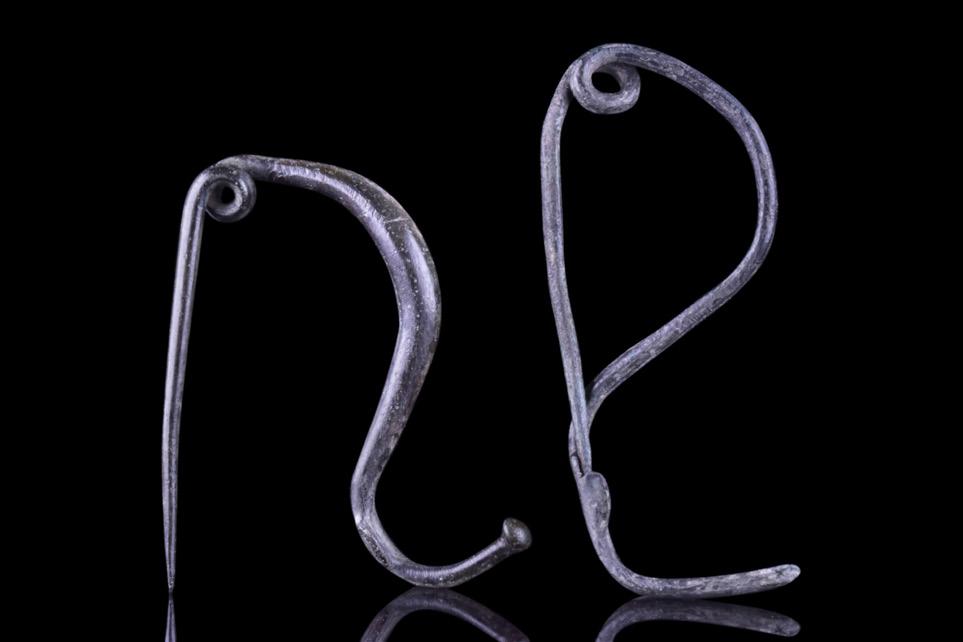
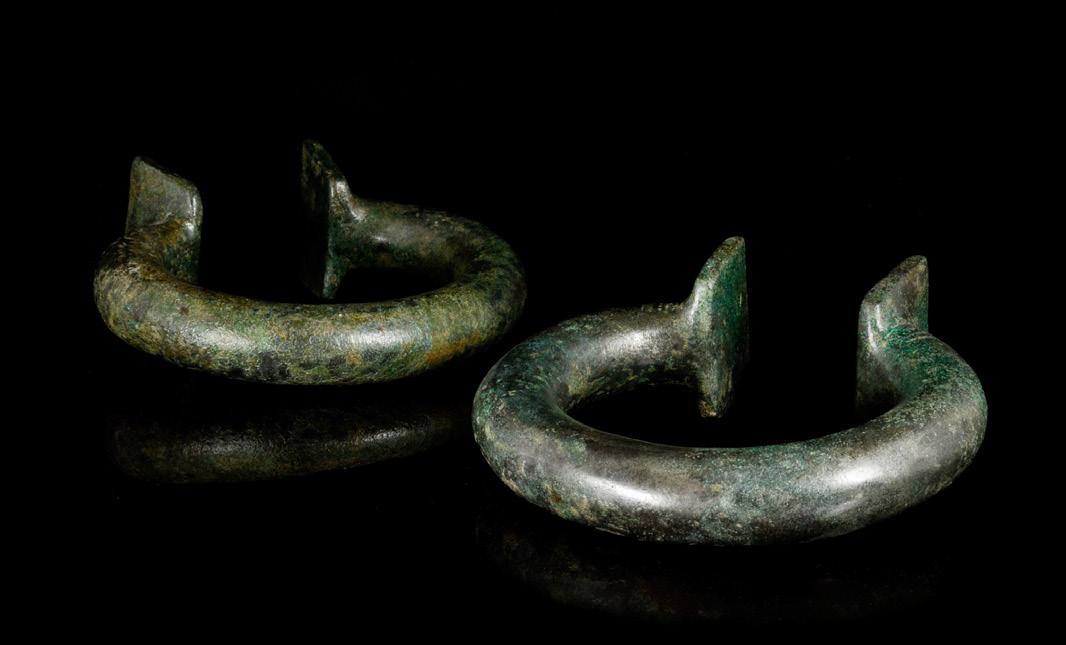
Ca. 1000-600 BC
Starting price: £900
A pair of thick and heavy cast bronze bracelets or arm rings with circular sections and square, recurved terminals with incised decoration. In the Bronze Age bracelets and arm rings were used not only as jewellery but also as ritual objects of high value, which allowed their owners to store wealth before the invention of coinage. Such items are discovered in burials as grave gifts or found in large hoards, and an important part of the Bronze Age cultures in both Europe and Asia. Good condition; a beautiful patina. Size: L:Set of 2: 125mm / W:125mm ; 2kg.
Provenance: Property of an established London gallery; acquired from a private estate collection formed before 2000.
Ca. 300 BC
Starting price: £500
An interesting pair of La Tène I type bow brooches, each with a deep bow, pin to reverse, and a foot with a lateral catch. The La Tène culture is a predominantly Celtic culture belonging to the Iron Age, also known as Iron Age II. It developed between ca. 450 and 25 BC. Its name comes from the La Tène archaeological site discovered in 1857 at Marin-Epagnier, on the shores of Lake Neuchâtel in Switzerland. Size: L:40.2-50.5mm / W:21.333.5mm ; 8g.
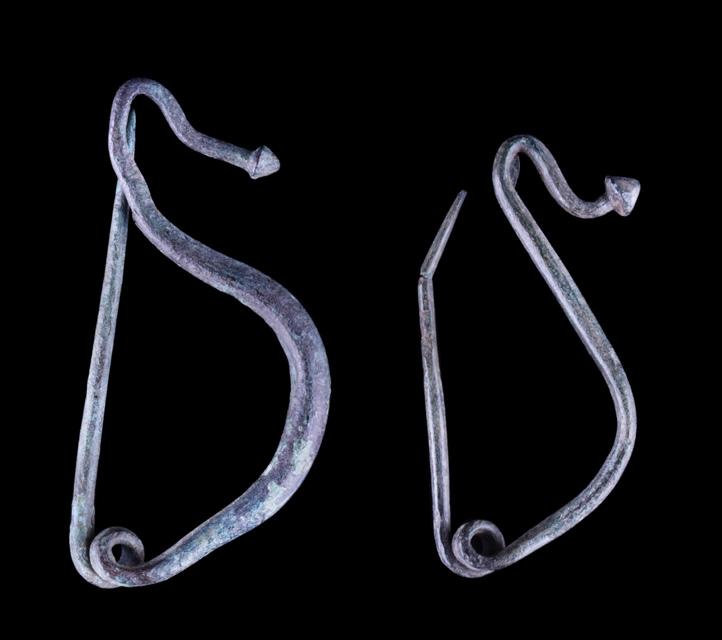
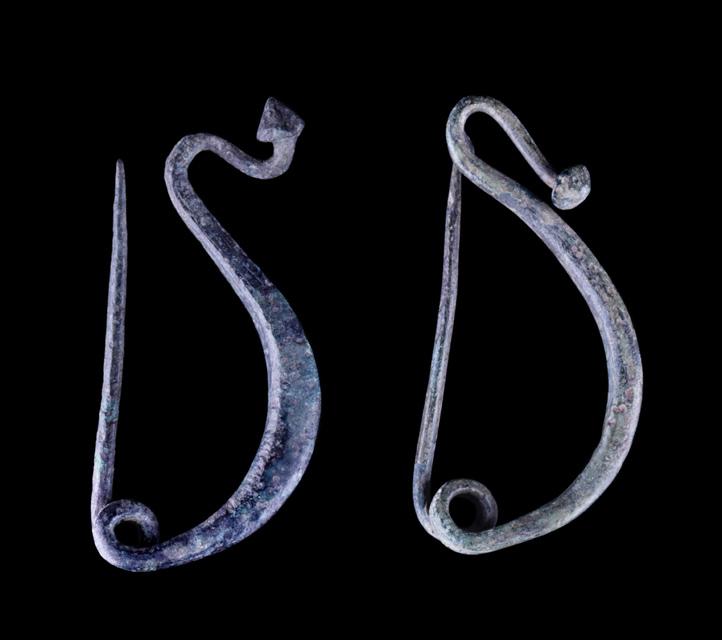
Provenance: From the private collection of a South London art professional; previously in a collection formed on the UK/European art market in the 1980s.
274B.
Ca. 300 BC
Starting price: £100
A pair of La Tène I type bow brooches, each with a deep bow, sprung head, and a pin to reverse. The La Tène culture is a predominantly Celtic culture belonging to the Iron Age, also known as Iron Age II. It developed between ca. 450 and 25 BC. Its name comes from the La Tène archaeological site discovered in 1857 at Marin-Epagnier, on the shores of Lake Neuchâtel in Switzerland. Size: L:37.9-40mm / W:18.1-18.7mm ; 9.56g.
Provenance: From the private collection of a South London art professional; previously in a collection formed on the UK/European art market in the 1980s.
274C. CELTIC LA TENE BRONZE PAIR OF BROOCHES
Ca. 300 BC
Starting price: £100
A pair of La Tène I type bow brooches, each with a deep bow, sprung head, and a pin to reverse. The La Tène culture is a predominantly Celtic culture belonging to the Iron Age, also known as Iron Age II. It developed between ca. 450 and 25 BC. Its name comes from the La Tène archaeological site discovered in 1857 at Marin-Epagnier, on the shores of Lake Neuchâtel in Switzerland. Size: L:36.5-42mm / W:17.4-19.4mm ; 6.61g.
Provenance: From the private collection of a South London art professional; previously in a collection formed on the UK/European art market in the 1980s.
275.
Ca. 1000-800 BC
Starting price: £500
A stunning large bronze spearhead with a leaf-shaped blade, prominent midrib, conical shoulder decorated with five horizontal ribs, terminating in a circular socket. This spear is a beautiful stand out example of Celtic Bronze Age Craftsmanship. Size: L: 225mm / W: 40mm; 130g.
Provenance: From the private collection of Mr. R. Unger; previously with a London gallery; acquired in the 1990s on the UK art market.
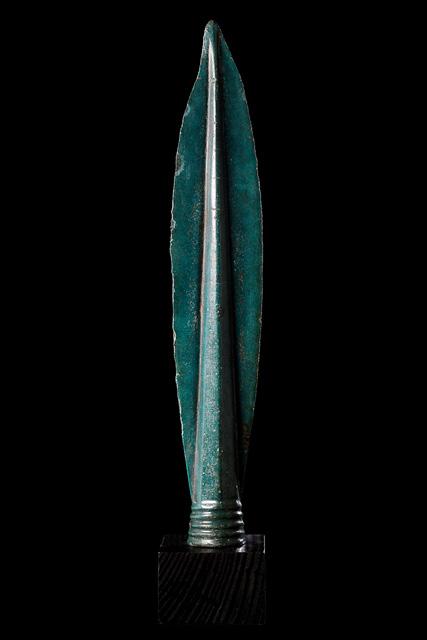
Starting price: £18,000
A two-part lidded marble reliquary - in the form of a small sarcophagus whose cover simulates a gabled roof bearing undecorated corner acroteria. On the front of the lower section is an engraved Greek cross with concentric circles occupying the negative spaces created by each of its angles. Below the cross is a small opening that serves as an exit point for the corresponding libation hole in the center of the gable. An outstanding and quite rare example of an early Byzantine reliquary modeled on the form of late Roman sarcophagi. Cf. Rom und Byzanz, no. 14, p. 26. For a full discussion, see S. Eyice, “Reliquaries en form de sarcophage en Anatolie et a Istanbul, “Istanbul Arkeoloji Muzeleri Yilligi 15-16 (1969), pp. 97-144.
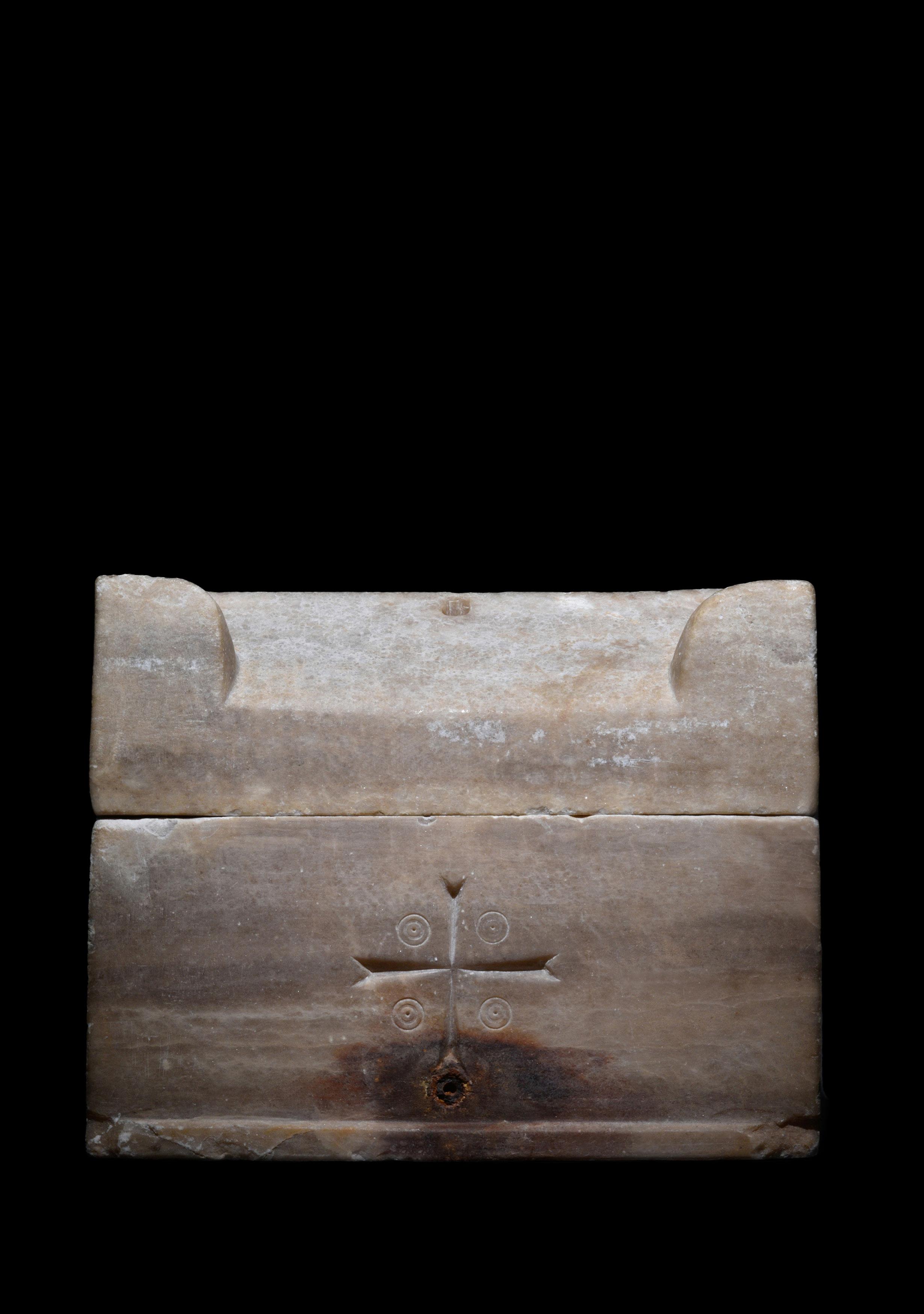
Size: L:300mm / W:380mm ; 30kg.
Provenance: Private East Coast, USA collection; ex-Richard Wagner Collection, Cape Cod, Massachusetts, USA, 1970’s. Published in “Beloved By Time: Four Millennia of Ancient Art” (Fortuna Fine Arts Ltd., New York, 2000) no. 207, p. 118.
Ca. 1100-1400 AD
Starting price: £5,000
An exquisite cast copper-iron processional cross composed of two flared sections pinned together in the center with a cast-bronze medallion. The lateral arms have pointed finials on their upper corners, and on top is an intricate bronze crucifix finial flanked by palmettes. From each arm hangs a pair of suspended rock crystal beads, and a large tang projects from beneath the vertical arm. The circular bronze medallion is ringed with faint silvering and displays an image of the Virgin Mary and the infant Christ. A pointille Greek inscription on the obverse side reads, “SOFRONIYO,” possibly an inexact genitive name form of “Sofronios,” perhaps the individual responsible for dedicating the cross. Another inscription on the horizontal arms, though faded on the left arm, reads, “…IA KONYA,” perhaps a reference to the modern city of the same name. Published in “Venerable Traditions: Works of Art from the Ancient World.” Fortuna Fine Arts, Ltd., New York, 2007.

Size: L:685mm / W:325mm ; 885g.
Provenance: East Coast collection, New York Gallery, New York City, New York, USA, before 2010; ex-Janet Zakos collection, Switzerland, acquired in the 1980s.
Starting price: £18,000
A colossal two-handed sword, possibly of German workmanship, straight double-edged blade with wide and shallow fuller, two punched armourer’s marks to each side depicting a Latin cross surmounting a sickle, both sides of the blade with incised inscription in uncial letters ‘INRI’ with reference to the titulum of the cross of Our Lord, letter ‘I’ on one side forming a monogram with the letter ‘R’ over the latter ‘I’; two incised bronze figures to both sides, one resembling a stylised Passau Wolf; a wide diamond-section bronze quillon with rounded finials, possibly a later replacement; long tang with wooden grip, copper-alloy wire wrapping to each end; bronze facetted pear-shaped pommel, the rivet button possibly a later replacement. See Foulkes, C., Inventory and survey of the Armouries of the Tower of London, 2 volumes, London, 1916; Dudley, S.H.G., Armourers Marks, London, 1959; Dufty, A.R., European swords and daggers in the Tower of London, London, 1974; Newman, P.R., Within the inventories in the Tower of London Armoury, a large number of swords among the possessions of King Henry VIII are listed, such as the grete slaghe swords, which must have been the age denomination for the two-handers, like this specimen. Probably employed only for ceremonial purposes.

Size: L:2075mm / W:455mm ; 6.35kg.
Provenance: Property of a Surrey gentleman; acquired from a Sussex collector; formerly from an old country house in East Sussex.
Starting price: £15,000
A long Migration period iron sword formed by the forge-welding process, comprising a lentoid-section parallel-sided blade with a broad tapering tip. A rectangular lower guard of inset garnet cloison set in a stepped pattern. The long hilt at the mid-section is decorated with a gold circular plaque set with spiraling garnets and the hilt is finished with a small gold pommel with a central inset. At the time of the fall of the Roman Empire, other cultures began to evolve, grow and eventually prosper and their culture and art thrived. The Merovingians (476-750 AD) were one such group and they are traditionally reckoned as the “first race” of the kings of France.

Size: L:1050mm / W:105mm ; 785g.
Provenance: Formerly in a collection of a European collector; previously in a Belgian collection of Mr. R. Bogaert, 1970s-1990s.
Ca. 1350 AD
Starting price: £5,000
This late Medieval sword comprises of a long slender triangular blade with a fuller, three quarters of its length and an undamaged tang. The cross guard and pommel are replete and although there is a little surface pitting on the pommel and the blade, this only serves to enhance the majesty of this sword! A little surface corrosion on the blade enhances the pattern welding of this most perfect, tapered, and elegant artefact. The pommel is round, with a central protuberance on both sides. This has been categorised as a Type “K” by Oakshott a renowned academic specialising in Medieval sword Typology. The cross guard is slim, level on the top, curved underneath with flattened drop edges to each end. This is a common type of cross guard and has been categorised as a type “6”. The blade is narrow and tapers to an almost needle point. It is double edged with a central fuller, medium width, traveling centrally down the blade. The grip is short making this an excellent thrusting weapon for close quarter combat. This type of blade is of the type “XIIa”, a perfect example in its class. The item comes with an academic report written by Russel Scott; famous lecturer, reenactor and expert of Viking and medieval artefacts. His report also includes an X-ray fluorescence analysis suggesting the ancient origin of the object. Size: L:870mm / W:180mm ; 980g.

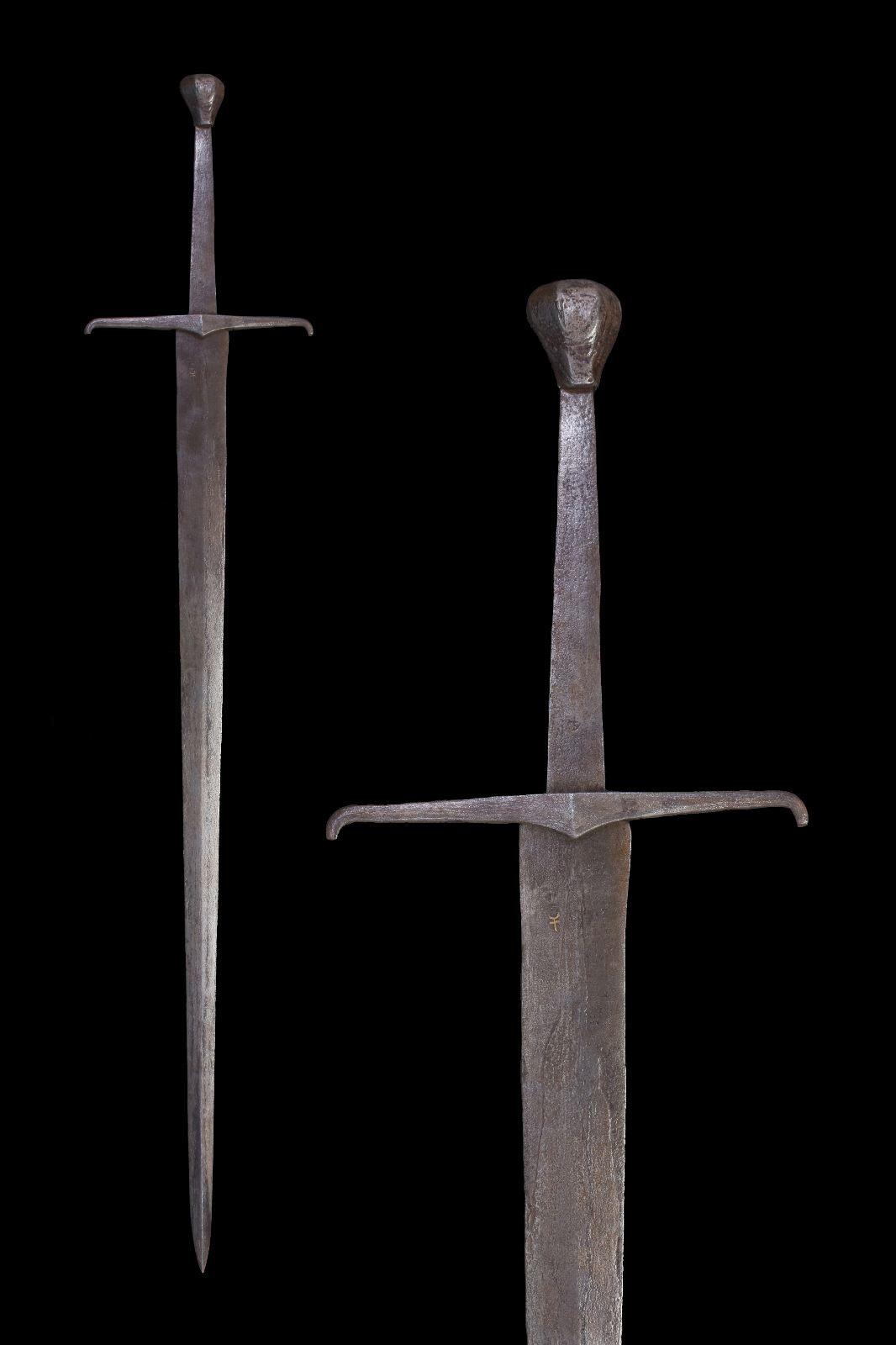

Provenance: Property of a European collector. Formerly in the collection of Earl Mitchell, London 1990s.
Starting price: £4,000
This sword is the epitome of épées, a truly magnificent example. The pommel is very elegant and appropriately called a ‘scent bottle stopper’, probably due to the similarity in shape. This well-known pommel, Type T2 could be found fitted to the swords dated to just prior to the Renaissance period. The blade tapers to a needle point from the cross guard to tip. Rather than sporting a fuller, further elegance is provided by forging the blade into a diamond section. Oakshott would have no hesitation in cataloguing the blade as a Type XVa and dating it to between mid-14th century and mid-15th century. The dates fit well with those of the other fittings. The blade itself has no patination or pitting. It has been stripped back to bare metal in an attempt to emulate the appearance of the sword when originally in use. The blade sides have no nicks but does have a ‘wavey’ edge. This is a typical feature that appears when a blade is sharpened with a hand-held sharpening stone, rather than a modern grinders wheel. This feature thus serves to further enhance the appearance of this already rather wonderful sword. The face of the blade displays evidence of fire welding, particularly as a lazy V feature near the throat of the blade and parallel lines, almost like growth lines in a piece of wood, near the tip. The item comes with an academic report written by Russel Scott; famous lecturer, reenactor, and expert of Viking and medieval artefacts. Size: L:1070mm / W:205mm ; 1.33kg.
Provenance: Property of a European collector. Formerly in the collection of Earl Mitchell, London 1990s.
Ca. 1400-1450 AD
Starting price: £3,000
This is an excellent and somewhat complete sword from the late Medieval period. The pommel is a circular disc, with a raised circular collar on each face. The condition is excellent and, uniquely, the sword’s tang protrudes through the pommel. Oakshott would label this pommel as a type J and date it to between mid-14th century and mid15th century. The cross guard, is a flat bar, embellished by dropping the bar at the ends and in the middle. This produces an overall pleasing effect. Oakshott would label the cross guard as a Type 8 and date it to between ca.1400 and 1450. The blade is very elegant, needle-pointed with a taper along its whole length and a diamond section. A stunningly elegant blade. The classification of Type XV seems appropriate, with its short grip and dating of between 1350 and 1500. The grip has survived although the material is not clear. There is a central ring around the middle of the swords tang, this appears to be covered by what is most likely leather, as leather would emphasise any features underneath the binding in this way. The sword has no patination or nicks. It displays a naked surface, emulating the swords original appearance. Consequently the appearance is excellent. The dating is between ca.1400 and ca.1450, all in all a wonderful sword. The item comes with an academic report written by Russel Scott; famous lecturer, reenactor, and expert of Viking and Medieval artefacts.
Size: L:870mm / W:180mm ; 980g.
Provenance: Property of a European collector. Formerly in the collection of Earl Mitchell, London 1990s.
Ca. Mid-13th century - start of the 15th century AD
Starting price: £3,000
This fine Medieval sowrd features a pommel of an unusual design. It is circular when viewed from the front and sides, but displays a thick cross-like section when viewed from above. In Oakshott’s typology, only one pommel fits this description, a Type G1 dated to early 15th century to mid-16th century. The cross guard is relatively simple, yet functional. The blade and fittings are all pitted, the blade edges are nicked and the tip, where the metal is particularly thin, is partially nibbled away. Yet, this all adds to the charm of this unusual and unique sword. Typology-wise, Oakshott classifies it as a type XIIa, wielded across Europe between the mid13th century and the start of the 15th century. The dating of the cross guard does overlap the dating of the blade. The date of the pommel, however, does not. It suggests that sometime in the 15th century to mid-16th century the original pommel, possibly a ‘Disc pommel’ was exchanged for one that was rather more decorative, and perhaps a little lighter; a Type G1 pommel. The addition of this pommel can be seen to enhance the sword. The item comes with an academic report written by Russel Scott; famous lecturer, reenactor, and expert of Viking and medieval artefacts. Size: L:1100mm / W:210mm ; 1.06kg.
Provenance: Property of a European collector. Formerly in the collection of Earl Mitchell, London 1990s.


Starting price: £4,000
An excellent set comprising a leather belt with bronze fittings including a D-shaped buckle with a pin, chevron mount and interlinking pieces with a ring, and a forged-iron long sword with a broad blade tapering to a sharp point. The handle has elaborate silver inlays across a guard and a pommel. The cross guard is of a simple rectangular, flat shape but curves slightly downwards at each end. The hilt is short, one-handed, and ends in a circular pommel with raised boss. The era known as the Viking age lasted for more than 300 years, from the late 8th century to the late 11th century. The history of the Vikings is closely linked to their role as masters of the sea. They were feared as fierce and ruthless invaders; this fine set probably belonged to a Viking chieftain who led his warriors in search of fortune.Size: L:950mm / W:75mm ; 810g.
Provenance: Property of a European collector. Formerly in the collection of Earl Mitchell, London 1990s.
285. VIKING IRON SWORD - FULL REPORT Ca. 10th Century AD
Starting price: £2,000
This sword of the Viking era is largely intact, with the pommel, lower cross guard, blade, and tang all complete. The surface overall is pitted, and the sword blade edges have some sections of the edge missing, however, this blade is of the order of a thousand years old, and the condition is therefore quite acceptable. The pommel is flat, without any surface features or inlay, it is roughly triangular in shape. The cross guard is narrow and straight and nicely complements the pommel. The blade is long and narrow, sharp on both edges, with a gently curving around a central fuller. The fuller is relatively narrow and cuts into the blade for 6/7th. of its length. The blade tip is rounded but nevertheless would have been sharp. Primarily a chopping weapon, the sword could be used for thrusts as well. The item comes with an academic report written by Russel Scott; a famous lecturer, reenactor, and expert on Viking and medieval artifacts. His report also includes an X-ray fluorescence analysis suggesting the ancient origin of the object. Size: L:800mm / W:80mm ; 815g.
Provenance: Property of a European collector. Formerly in the collection of Earl Mitchell, London 1990s.
286. VIKING IRON SWORD - FULL REPORT Ca. 10th Century AD Starting price: £2,000
A wonderful example of a Hiberno-Norse sword, typically originating in the Irish Sea area about a thousand years ago. It is a double-edged sword, with medium fuller, tang, lower cross guard, and upper cross guard. Both cross guards are straight, whilst the blade edges are nicely profiled; straight, then gently tapered, then drawing to an acute point. This blade type, nicely fits into the Geibig typology, suggesting a blade that is a type “5”. The sword has no pommel cap just a plain bar serving as the upper crossguard. These are generally identical to, but slightly smaller than the lower cross guard. Such a pommel was catalogued by Petersen as a type “M”. There is some surface pitting and spalling which has revealed the underlying pattern welded nature of the blade. The item comes with an academic report written by Russel Scott; a famous lecturer, reenactor, and expert on Viking and medieval artifacts. His report also includes an X-ray fluorescence analysis suggesting the ancient origin of the object.


Size: L:730mm / W:10mm ; 635g.
Provenance: Property of a European collector. Formerly in the collection of Earl Mitchell, London 1990s.
Ca. 900-1000 AD
Starting price: £1,800
A rare Viking period iron helmet; formed of triangular sections; attached with iron rivets passing through this overlap to secure them in position; the rivets worked flat into the surface of the helmet, almost invisible from the outside but detectable on the inner surface; the inverted lower rim furnished with an additional series of rivets, probably to accommodate a lining; the plate-junction at the apex with loop, allowing a plume or horsehair streamer to be inserted, or a conical covering plate to be attached. Reference: Curtis, H. M., 2,500 Years of European Helmets, North Hollywood, 1978; Denny, N. & Filmer-Sankey, J., The Bayeux Tapestry, London, 1966; Kirpicnikow, A. N., Russische Helme aus dem Frahen Mittelalter Waffen- und Kostamkunde, 3rd Series, Vol. 15, pt. 2, 1973; Menghin, W. The Merovingian Period - Europe Without Borders, Berlin, 2007, p.326-7, item I.34.4. The item comes with an academic report written by Russel Scott; famous lecturer, reenactor and expert of Viking and medieval artefacts. Size: L:200mm / W:225mm; 955g.
Provenance: Allegedly found in 1942 in Germany. Brought to England in 1945. Various English private collections. In last collection until 2018, when bought by the current owner.

Ca. 900-1000 AD
Starting price: £18,000
Silver chain, 80 cm long, with a two-part reliquary cross which shows traces of gilding. The construction and imagery of the front reveal Byzantine influence. Centrally, a stylised Christ with his hands in a prayer gesture. At the ends of the arms of the cross medallions with saints. The back with ornamental Viking decoration. Eyelets at the top and bottom. If you open the cross you will find a fold-out Thor’s Hammer inside, which is decorated on one side with typical nordic punchmarks. The inner surfaces of the cross halves are also geometrically decorated. Intact. Item comes with a professional historical report from Ancient Report Specialists. The item comes with a full investiation report from an independant Belgian laboratory (Hebolabo), suggesting its age and authenticity.

Size: L:54mm, 28mm / W: 35mm, 12mm; 92g.
Provenance: Property of a European collector; previously in a collection of J. Hatzenbuehler, Germany, 1970s.
289. POST MEDIEVAL GOLD RING WITH DIAMOND Circa 1800 AD
Starting price: £1,000
A slender gold ring with teardrop shaped bezel decorated with a sparking diamond. The band with ribbed decoration and with an inscription. Size: D: 15.8mm / US: 5 1/8 / UK: K; 3.7g.
Provenance: Property of a London Ancient Art Gallery; formerly in the famous Alison Barker collection, a retired London barrister; acquired between early 1960s to 1990s. Exhibited: Olympia Art & Antiques fair, London June 2022.
290. CRUSADERS GOLD RING WITH TEMPLAR CROSS Ca. 1100-1300 AD
Starting price: £1,000
A beautiful gold ring with a circular hoop and flattened bezel bearing a punched Greek cross bordered by four dots. This ring may have belonged to a crusader, perhaps a knight, as a mark of his status. The elegance of this particular item also means that it may have belonged to a member of the Knights Templar, an elite Catholic military order founded in AD 1119 with the aim of defending the newly reconquered Holy Land.
Size: US 9 / UK S; 3.52g.
Provenance: Property of L.C.; previously in a collection formed on the UK/International art market in the 1980s.
291. CRUSADERS GOLD RING WITH TEMPLAR CROSS Ca. 1100-1300 AD
Starting price: £1,000
A beautiful gold ring with a circular hoop and flattened, discoid bezel bearing an incised Maltese cross within a dashed circle. This ring may have belonged to a crusader, perhaps a knight, as a mark of his status. The elegance of this particular item also means that it may have belonged to a member of the Knights Templar, an elite Catholic military order founded in AD 1119 with the aim of defending the newly reconquered Holy Land.



Size: UK: P, US: 7 1/2; 4.97g.
Provenance: Property of L.C. .previously in a collection formed on the UK/International art market in the 1980s.
292. HEAVY MEROVINGIAN GOLD AND GARNET BUCKLE37 GRAMS Ca. 500-700 AD

Starting price: £3,000
A gold belt or shoe buckle comprising a round-section loop, and a curved tongue with the tip resting on the loop. The Merovingians (476-750 AD) were one such group and they are traditionally reckoned as the “first race” of the kings of France. For a comparable example, see Bonhams, Antiquities, London, 1 May 2013, Lot 248, sold for £ 1,250. Size: L:40.2mm / W:32.5mm ; 36.61g.
Provenance: Property of a West London gentleman; previously in a collection formed on the UK/International art market since the 1970s.
293. HEAVY MEROVINGIAN GOLD AND GARNET STRAP END - 20 GRAMS
Ca. 500-700 AD
Starting price: £2,000
A gold buckle comprising a round-section loop, and a pair of rectangular plaques, each decorated with five bosses arranged in a line. Plaques are conjoined to the rear with a riveted gold cell with a beaded border and set with a beautiful garnet cabochon. Good condition.
Size: L:39.5mm / W:19.3mm ; 20.07g.
Provenance: Property of a West London gentleman; previously in a collection formed on the UK/International art market since the 1970s.
294. VIKING
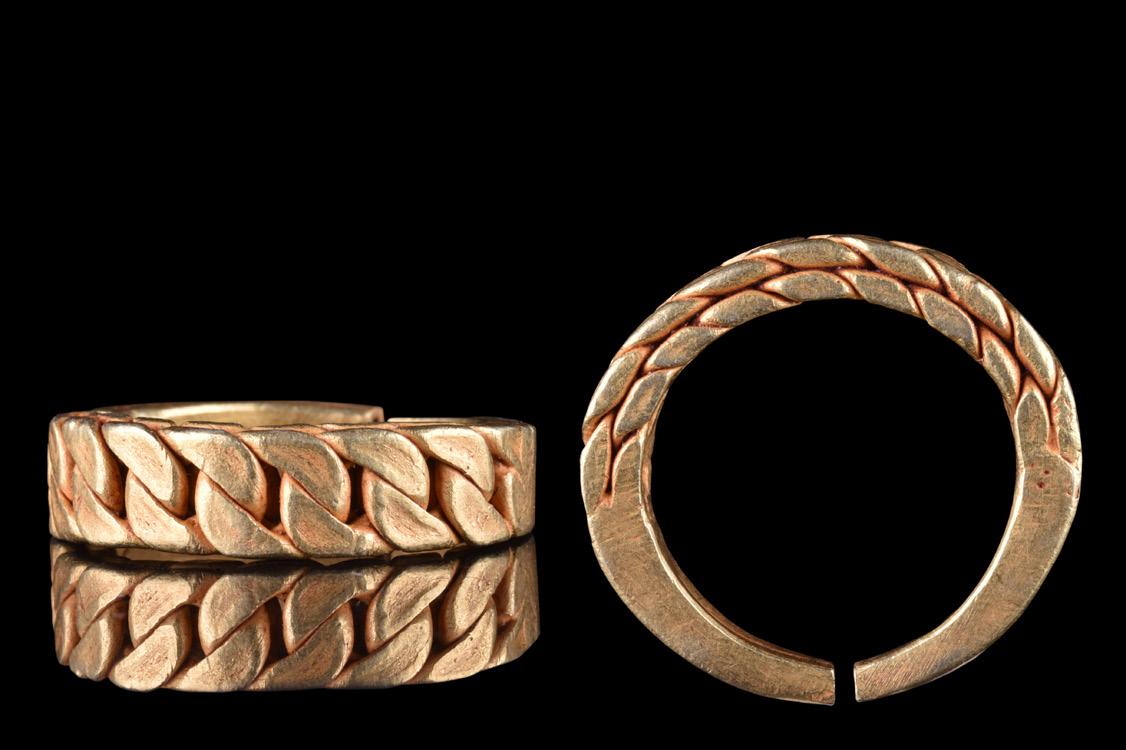
Ca. 900-1100 AD
Starting price: £1,000
A rare type of hack-gold ring formed of a circular hoop with a braided median section and tapering arms. This ring was intended to evoke the form of a snake. In Norse mythology, Jormungand also called the “Midgard Serpent” is a snake or dragon who lives in the ocean that surrounds Midgard, the visible world.
Size: D: 19.35mm / US: 9 1/2 / UK: S 1/2; 10.6g.
Provenance: Property of a West London gentleman; previously in a collection formed on the UK/International art market since the 1970s.
295.
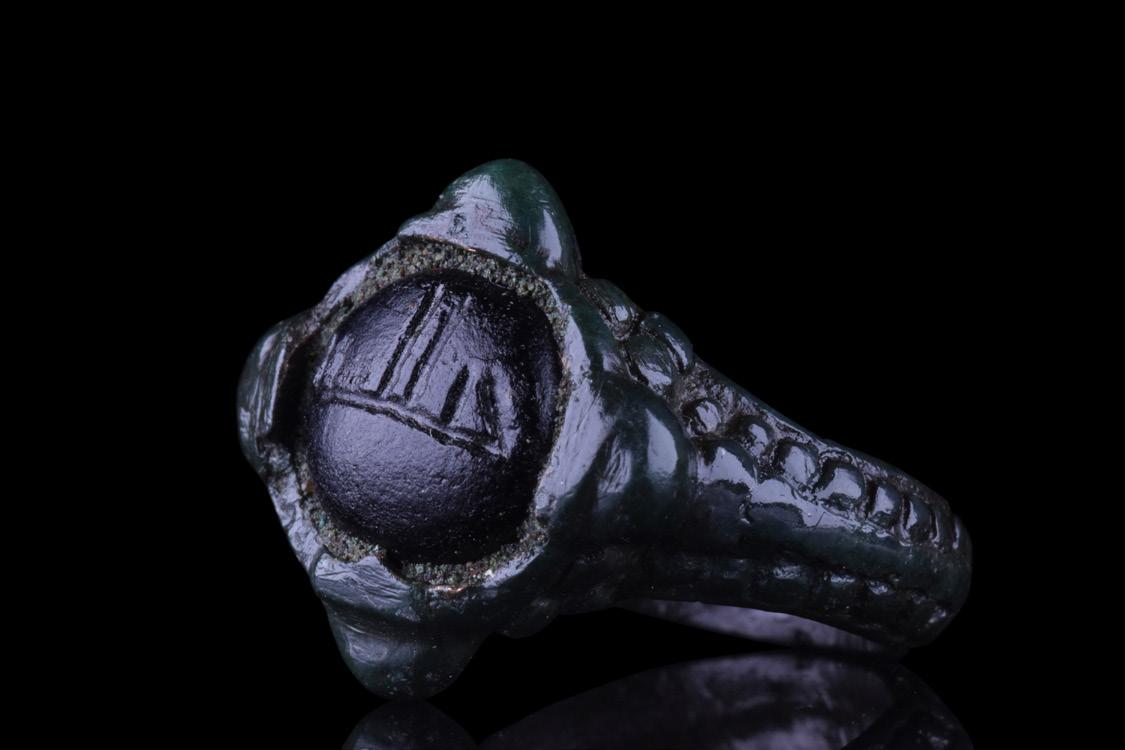
Ca. 900-100 AD
Starting price: £500
A bronze finger ring with a circular hoop, and a lozenge-shaped bezel onto which is mounted a large, oval dark gem inscribed in Kufic calligraphy “Sovereignty” (Arabic ‘Mulk’). A similar ring can be found in The Statens Historiska Museum, SHM34000.

Size: D: 15.09mm / US: 4 / UK: H 1/2; 9.78g.
Provenance: From an old British collection formed in the 1990s; previously acquired in Germany.
Ca. 900-1000 AD
Starting price: £15,000
A set of eight silver pendants made in open mold lost wax casting technique, frequently used in the Viking Age. The set comprises: (type 1) six cast silver openwork pendants with a Borre-style design of a gripping beast, an animal (cat?) with gripping paws with an enmeshed body, inside a circular frame further decorated with four protruding animal heads. Suspension loop with a central ridge and double median groove. The ribs of some of the pendants are nicked to imitate the filigree wire. The backsides of the pendants are undecorated. Given the number of recovered pendants of this type, it must have been a prevalent object at the time; (type 2) one large silver open-work discoid pendant with an integral T-shaped tubular loop; raised gusseted rim enclosing a pair of S-shaped beasts with billeted bodies and comma-shaped tails, enmeshed gripping paws clutching the edge and their own bodies. Despite the long period of overlap of Borre and Jellinge art styles, there are only a few examples of their fusion. Type 1 is the principal and most popular motif of the Borre style, while a typical Jellinge style beast is more slender with long, S-shaped body and ribbon decoration. This pendant, featuring a fusion of these styles, is formed as a circle with a pair of Jellinge-style beasts with ribbon-shaped bodies in profile and heads with open jaws and extended tongues. However, each is provided with gripping paws and an enmeshed body, which are typical features of the Borre style. The back of the pendant is undecorated; (type 3) a diamond-shaped open-work silver pendant in Borre style symmetrical design, depicting two animal heads with gripping paws. The back of the pendant is undecorated.

The item comes with a full investigation report from an independent Belgian laboratory (Hebolabo), suggesting its age and authenticity. For similar examples, see The British Museum, Museum numberL 1999.1001.1; Historical Museum Sweden: 564336 SHM: 34000: Bj 791Lot. 564336, Historiska Museum, Stockholm, Inventory Number: 4516.
Size: L:40-50mm / W:35-45mm ; 200g.
Provenance: Property of a European collector, London, since 2015; formerly in the Nicholas Wright collection, previously in an old private Duch collection.
297. MEDIEVAL BROAD BLADED DAGGER WITH ROUND POMMEL
Ca. 13th-15th century AD
Starting price: £250
An iron dagger with a broad triangular blade, straight cross guard, and flat-section tapering tang finished with a discoid pommel.
Size: L:470mm / W:105mm ; 470g.
Provenance: Ex. European collection formed between 2000 to 2020.
298.
Ca. 15th-16th century AD
Starting price: £650
An iron Bollock dagger / knife. The handle is of wood and a hilt plate survives between the cross guard and blade. There is a Maltese cross inlay/ makers mark on the blade. Size: L:395mm / W:70mm ; 320g.
Provenance: Ex. European collection formed between 2000 to 2020.
299. MEDIEVAL BROAD BLADED DAGGER
Ca. 13th-15th century AD
Starting price: £200
An iron dagger with a broad triangular blade, long cross guard, slightly curved downwards and flat-section tapering tang finished with a round pommel. Size: L:400mm / W:115mm ; 410g.

Provenance: Ex. European collection formed between 2000 to 2020.

Ca. 13th-15th century AD
Starting price: £200
A short iron sword comprising a slender blade with pronounced midrib, a short flat cross guard, and a flat square pommel at the end of a tang . Size: L:445mm / W:65mm ; 205g.



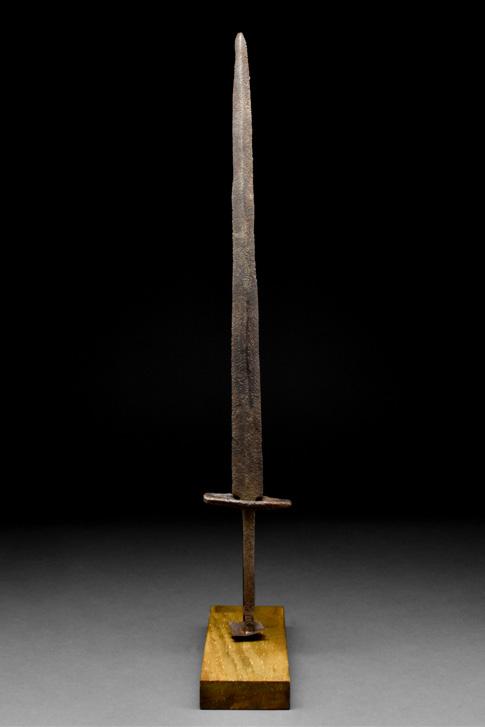

Provenance: Ex. European collection formed between 2000 to 2020.
301.
Ca. 13th-15th century AD
Starting price: £250
A short iron single-edged dagger/knife, with a straight cross guard and tapering tang to floret button pommel.
Size: L:390mm / W:105mm ; 395g.
Provenance: Ex. European collection formed between 2000 to 2020.
302. LATE MEDIEVAL DAGGER / STILETTO WITH ROUND CROSS GUARD AND POMMEL
Ca. 14th-15th century AD
Starting price: £350
An iron dagger / stiletto with a slender blade tapering to a point, and a tang finished with a discoid pommel inlaid with decorative motifs. Size: L:395mm / W:70mm ; 320g.
Provenance: Ex. European collection formed between 2000 to 2020.
303.
Ca. 14th-15th century AD
Starting price: £200
An iron dagger/stiletto featuring a double-edged slender blade with a button-shaped cross guard, rectangular-section tang finished with a circular pommel. Size: L:340mm / W:40mm ; 230g.

Provenance: Ex. European collection formed between 2000 to 2020.
304.
Ca. 13th-15th century AD
Starting price: £200
A long iron dagger comprising a slender blade with a midrib, a straight cross guard, and a rounded/cylindrical pommel. Size: L:365mm / W:65mm ; 175g.
Provenance: Ex. European collection formed between 2000 to 2020.

Ca. 13th-15th century AD
Starting price: £200
A short iron double-edged dagger with a straight sculptured cross guard and tapering tang to rod-shaped pommel. Size: L:335mm / W:90mm ; 270g.
Provenance: Ex. European collection formed between 2000 to 2020.
309.

Ca. 900-1100 AD
Starting price: £150
306.

Ca. 14th-15th century AD
Starting price: £200
An iron dagger or poniard comprising a slender blade, midrib, a short cross guard with balls on both ends. There is a cross-like mark on the blade which may be a makers mark. Size: L:300mm / W:55mm ; 140g.
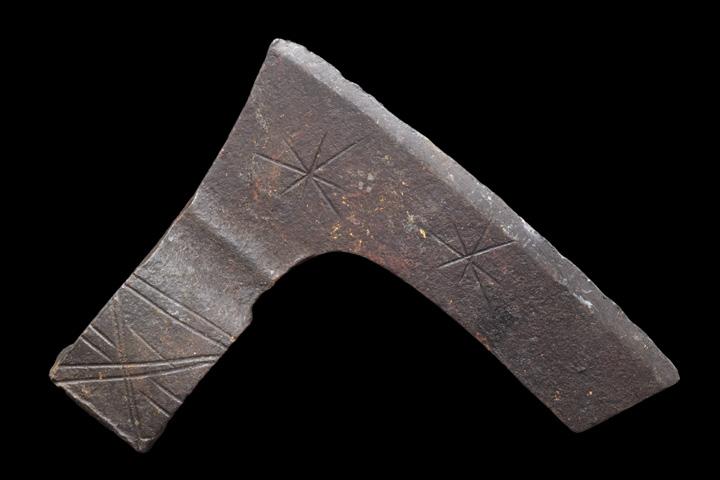
Provenance: Ex. European collection formed between 2000 to 2020.
A hand-forged iron axe head with a broad blade flaring to the curved cutting edge, with an eared socket with an oval-shaped aperture. For a similar example, see The British Museum, Museum number 1909,0626.8. Size: L:190mm / W:180mm ; 665g.



Provenance: Property of a UK art professional; Formerly acquired on the European art market from pre-2000 collections.
310.
307.
Ca. 900-1100 AD
Starting price: £300
A bronze mace head with a pearshaped head with incised decoration. Cavalry shaft-mounted weapons like battle hammers, maces, and axes were often very small and mounted on long handles. Size: L:90mm / W:45mm ; 310g.
Provenance: From an old British collection formed in the 1990s; previously acquired in Germany.
308. VIKING
SPEARHEAD Ca. 900-1100 AD
Starting price: £100
An iron spearhead with a beautifully shaped blade, raised midrib, sharp edges tapering to a pointed tip, and tubular socket. Size: L:300mm / W:50mm ; 830g.
Provenance: Property of a UK art professional; Formerly acquired on the European art market from pre-2000 collections.
900-1100 AD
Starting price: £150
An iron bearded axe head with an elongated, heavy blade and a round socket. One side of the blade features etched star motifs. Further information on Viking axes can be found in Petersen, Jan (1919). De Norske Vikingesverd. Kristiania. Size: L:220mm / W:180mm ; 655g.
Provenance: Property of a UK art professional; Formerly acquired on the European art market from pre-2000 collections.
311.
Starting price: £200
An iron axe head with a broad blade flaring to the curved cutting edge, with an eared socket with a round aperture. Commonly referred to as the Danish axe. Axes were commonly used within the Viking communities, almost everything was formed of wood making it unsurprising that many axes existed for constructing ships, houses, carts, as well as other objects. The axe was also one of the choice weapons of the battlefield due to its light weight. Size: L:120mm / W:175mm ; 295g.
Provenance: Property of a UK art professional; Formerly acquired on the European art market from pre-2000 collections.
312. VIKING IRON BEARDED BATTLE AXE
Ca. 900-1100 AD
Starting price: £200
An iron bearded axe head with an elongated blade and a socket. In bearded axes, the main part of the axe blade extends below the butt of the axe, creating a large cutting blade and allowing a fighter to hook onto the shields or weapons of their opponents. Further information on Viking axes can be found in Petersen, Jan (1919). De Norske Vikingesverd. Kristiania. Size: L:140mm / W:125mm ; 445g.
Provenance: Property of a UK art professional; Formerly acquired on the European art market from pre-2000 collections.
313. VIKING IRON BATTLE AXE
Ca. 900-1100 AD
Starting price: £200
A forged-iron axe head of a sizeable form with a long neck, a verticle blade with flared tips, and a wide socketing shaft with slightly flared upper and lower edges. The bearded axe, or Skeggøx (from Old Norse Skegg, “beard”, and øx, “axe”) was common from the 6th century AD onwards in Scandinavia but made most famous by the Vikings, who used these axes in battles to terrible effect. Size: L:220mm / W:180mm ; 655g.
Provenance: Property of a UK art professional; Formerly acquired on the European art market from pre-2000 collections.
314. VIKING IRON BEARDED BATTLE AXECCa. 900-1100 AD
Starting price: £200
An iron bearded axe head with an elongated, curved blade and tapering cheek. The bearded axe, or Skeggøx (from Old Norse Skegg, “beard”, and øx, “axe”) was common from the 6th century AD onwards in Scandinavia but made most famous by the Vikings, who used these axes in battles to terrible effect. In bearded axes, the main part of the axe blade extends below the butt of the axe, creating a large cutting blade and allowing a fighter to hook onto the shields or weapons of their opponents. Size: L:120mm / W:175mm ; 295g.
Provenance: Property of a UK art professional; Formerly acquired on the European art market from pre-2000 collections.
315. VIKING IRON BATTLE AXE


Ca. 900-1100 AD
Starting price: £200
An iron axe head with a curved blade, slim cheek, and an elliptical shaft-hole. Axes were commonly used within the Viking communities, almost everything was formed of wood making it unsurprising that many axes existed for constructing ships, houses, carts, as well as other objects. Size: L:200mm / W:110mm ; 710g.
Provenance: Property of a UK art professional; Formerly acquired on the European art market from pre-2000 collections.
316. VIKING IRON BATTLE AXE
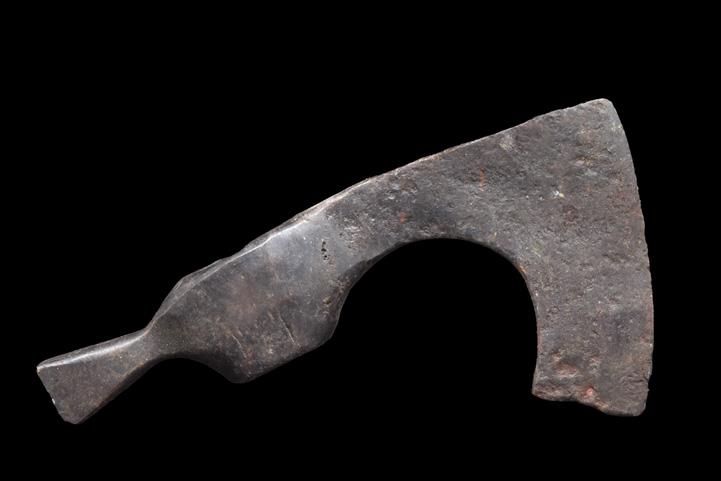
Ca. 900-1100 AD
Starting price: £200
A hand-forged, iron axehead with substantial curved blade and elliptical shaft-hole. The era known as the Viking age lasted for more than 300 years, from the late 8th century to the late 11th century. The history of the Vikings is closely linked to their role as masters of the sea. They were feared as fierce and ruthless raiders. Further information on Viking axes can be found in Arbman, H. Birka I: Die Gräber, Uppsala. Size: L:120mm / W:90mm ; 220g.
Provenance: Property of a UK art professional; Formerly acquired on the European art market from pre-2000 collections.
317. VIKING IRON BEARDED BATTLE AXE Ca. 900-1100 AD
Starting price: £200
An iron battle axe with a broad blade, tapering cheek and a round socket. The bearded axe was common from the 6th century AD onwards in Scandinavia, but made most famous by the Vikings, who used these axes in battles to terrible effect. In bearded axes, the main part of the axe blade extends below the butt of the axe, creating a large cutting blade and allowing a fighter to hook onto the shields or weapons of their opponents. Size: L:180mm / W:100mm ; 840g.

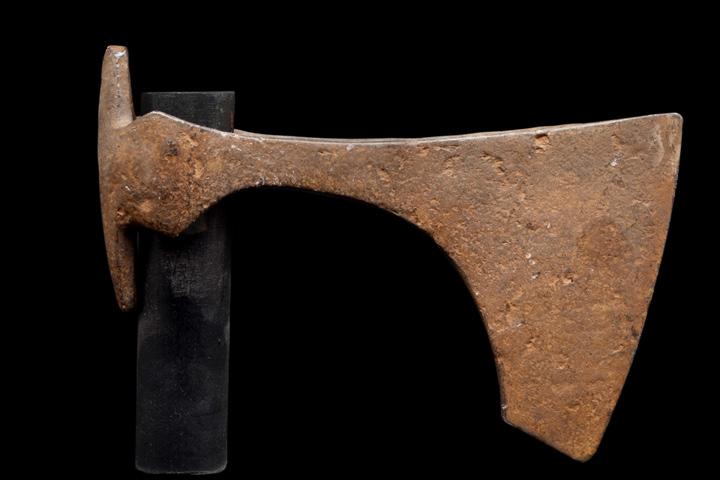
Provenance: Property of a UK art professional; Formerly acquired on the European art market from pre-2000 collections.


Ca. 900-1100
Starting price: £200
An iron axe head with a curved cutting edge, narrow circular socket, and a hammer to the rear. The blade to one side and the hammer to the other side suggest its use as a multi-purpose tool. For more information on Viking axes, see Hubbard, B. (2016) The Viking Warrior. London: Amber Books Ltd, 139-141. Size: L:180mm / W:60mm ; 290g.
Provenance: Property of a UK art professional; Formerly acquired on the European art market from pre-2000 collections.
Starting price: £500
A nice boat-shaped stone axe head with a square butt and rectangular in section, the ground socket with expanding edge has a hole drilled in to accept a haft. During the Neolithic period, stone axes were a widely used tool for multiple different tasks; to clear forests for early farming to make space to grow crops and keep animals. Axes were also used to prepare different parts of the animals they killed. They would butcher the meat and prepare the skins. When needed, they were used as a weapon. Size: L:110mm / W:40mm ; 395g.

Provenance: Private UK collection; From an old London collection formed in the 1990s.
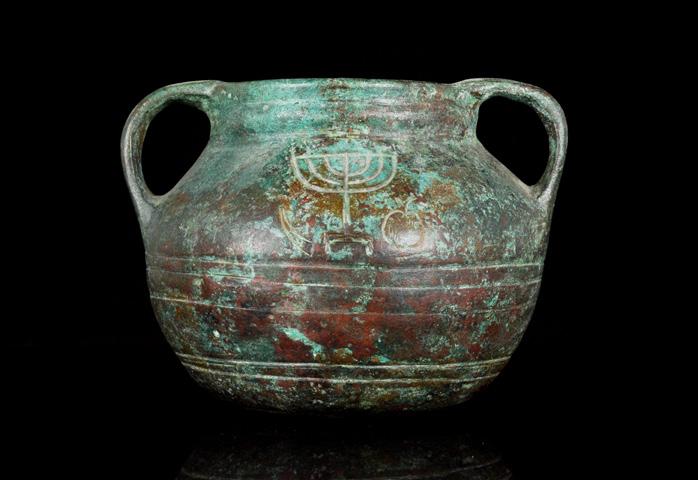
Holy Lands, Ca. 500 AD
Starting price: £500
A finely patinated bronze vessel with twin handles in the form of a jar, the body is globular in form with the rim tapering down to the centre of which then turns into a bulbous-shaped body. The front of the vessel is elegantly formed with an incised motif of the menorah symbol alongside a stylised apple with stork. This vessel is directly associated with the Judean faith. This rare and possibly important object has been formed with excellent precision and is aesthetically pleasing to the eye. Size: L:180mm / W:100mm ; 840g.
Provenance: From the important collection of a London doctor A.R; passed by descent to his son; formerly acquired the 1980s on the UK art market.
Ca. 800
Starting price: £500
A rare Byzantine bronze oil lamp holder formed by two sets of chains which are interlinked by bronze discs and hooks for hanging; the chains interlink connecting to a discoid open-work cross pendant. Good condition; on a custom made stand.
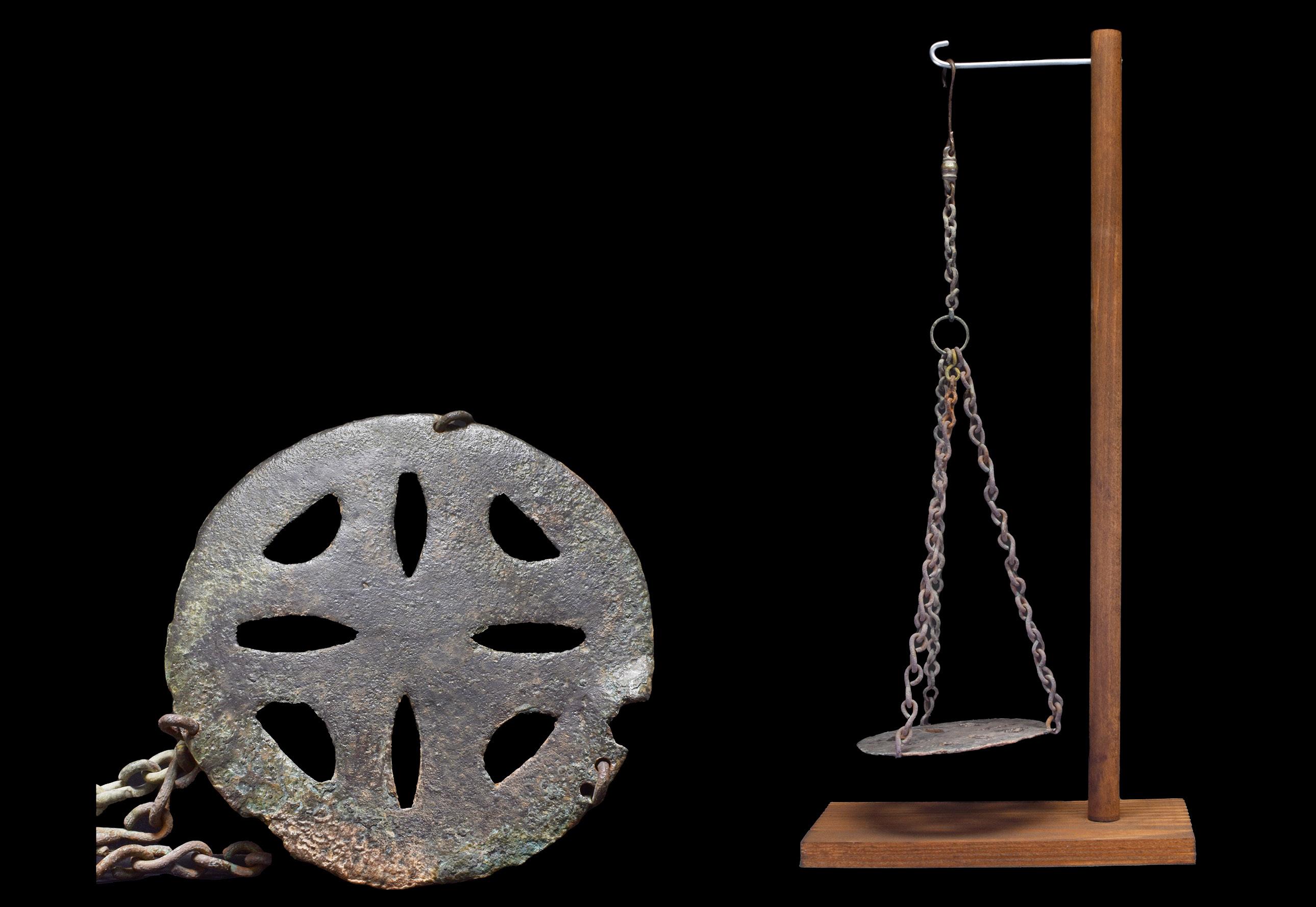
Size: L:550mm / W:160mm ; 940g.
Provenance: Private UK collection; From an old London collection formed in the 1990s.
Starting price: £8,000
A gilt-bronze Ringerrike style ‘Great Beast’ finial for Viking Long-ship weather vane or other similar nautical piece of equipment, formed in the round as a standing quadruped with scrolls to the hips and shoulders, raised head with eye; rivetted at the feet for attachment to a rectangular plate now detached, the plate with eight rivet spikes for attachment to the underside. Fine condition.

Literature: For ship-vanes of Ringerike style see Graham-Campbell, J. Viking Art, London, 2013, items 138-140; for a discussion of Viking-period weather vanes and their re-use ad badges of nobility in Normandy, see Engström, J. & Nykänen, P., New Interpretations of Viking Age Weathervanes in Fornvännen, vol. 91, 1996; Lindgrén, S., Viking Weather-Vane Practices in Medieval France in Fornvännen, vol. 91, 1996 and Lindgrén, S. iking Weather-Vane Practices in Medieval France in Fornvännen, vol. 78, 1983. The navigation techniques in use in Iron Age Northern Europe were very sophisticated, as would be expected from people bordering the Baltic, North Sea and North Atlantic where boat- and ship-building traditions have been perfected over more than a thousand years. A carved wooden panel from Bergen, Norway, shows a number of Viking longships at sea, some with weathervanes mounted on the stempost. They are mounted vertically with the beast on the outer end. Gilded bronze weathervanes appear on the roofs of medieval churches in Sweden, Norway and Finland where they are often regarded as ornamental: symbols of access to resources and craftsmanship for the important families who endowed such buildings. These weathervanes in many cases originally adorned ships and were used as part of the navigational equipment. They may have inspired the medieval Norman custom of attaching a gilded weathervane or cock to church roofs, which eventually spread to secular buildings such as castles in France and Italy where their use was restricted to certain ranks of nobility (Lindgrén, 1983”). Weathervanes were used for determining the strength and direction of the wind, in conjunction with the sólarsteinn (sunstone) Icelandic feldspar which polarises sunlight and allows the sun’s position to be determined in overcast conditions. A wooden bearing-dial fragment was found in Greenland - a destination colonised by Icelanders in the 11th century - with the ‘horizon’ divided into 32 sectors. This would give an accuracy of about 11 degrees per sector, which would make landfall using latitude sailing a straightforward matter. Engström & Nykänen (1996) suggested that the vanes were decorated with holes or markers on the outer edge which enabled the helmsman to make an assessment of the sun’s height from the position and length of the shadow, and thus to work out his position by rule of thumb. These holes may have been used to attach streamers as a visual aid. The ships equipped with these weathervanes may have been the ‘flagships’ of their fleets, taking the lead in navigation and in manoeuvring. The dragon on the weathervane may thus have signified the position of the fleet’s leader, and may even have given rise to the name drakka (dragon) for the largest type of Viking period ship.
Size: L:70mm / W:65mm ; 115g.
Provenance: Property of an European collector; bought from a UK gentleman collection, formed in the 1960s-1990s.
323. VIKING NECK TORC WITH TASSLES Ca. 900-1100 AD
Starting price: £500
Beautiful bronze torc featuring a wide, flat neck piece decorated with incised geometric motifs, from which dangle dozens of metallic tassels. Torcs such as this one would also have served as important symbols of rank and wealth. Size: L:75mm / W:160mm ; 150g.

Provenance: Private UK Collection; From an old Oxford Collection formed in the 1980s.
324. VIKING BRONZE CLOTH PINS WITH CHAIN Ca. 700-1000 AD
Starting price: £300
A stunning pin set comprising of a matched pair of bronze cruciform pins with long round-sections and a bronze box-link chain attached to interlink them. Size: L:1110mm / W:67mm ; 179g.

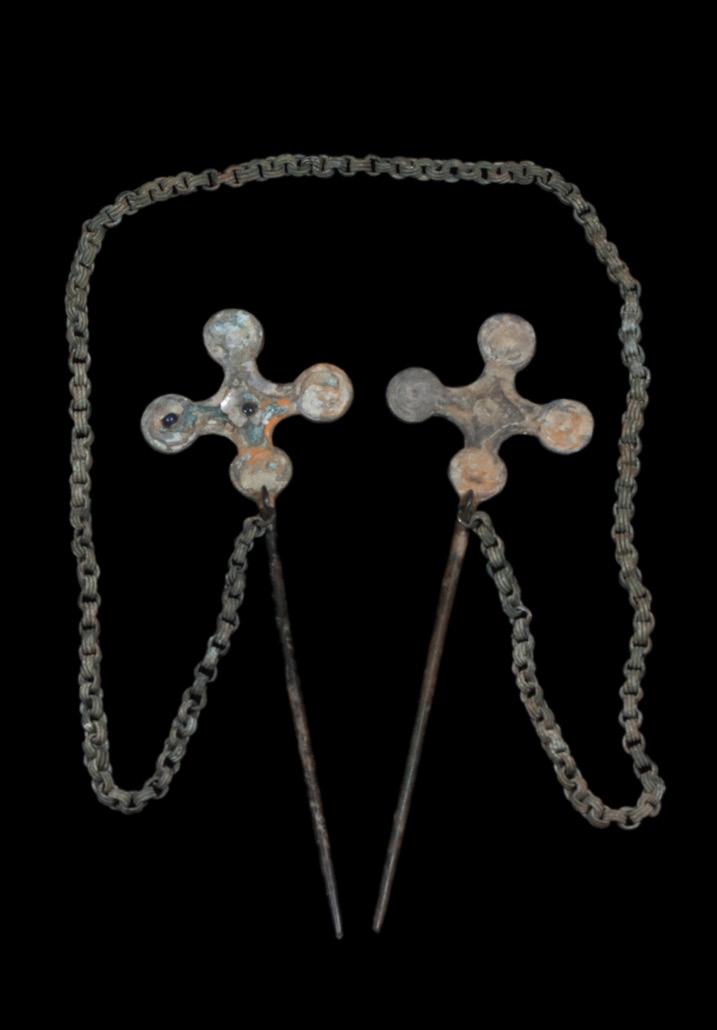
Provenance: Private UK Collection; From an old London Collection formed in the 1990s.
325. PAIR OF LARGE GOTHIC BRONZE RADIATE-HEADED BROOCHES
Ca. 500-600 AD
Starting price: £500
A pair of bronze radiate bow brooches, with a semi-circular head featuring five radiating knobs; the head is connected by an arched bow to a polygonal plate and a bulging sub-rectangular terminal. The whole of the front of the brooch is covered with incised ring and dot motifs; the reverse is undecorated. Size: L:Set of 2: 170mm / W:85mm ; 193.5g.
Provenance: Private UK collection; From an old Oxford collection formed in the 1990s. Exhibited: Olympia Art & Antiques fair, London June 2022.
326. VIKING GOLD-GILT SILVER RING Ca. 900-1100 AD
Starting price: £200
A silver ring with a D-shaped hoop and flattened, rectangular bezel bearing a gilded interlaced design. Excellent condition, wearable. The era known as the Viking age lasted for more than 300 years, from the late 8th century to the late 11th century. The history of the Vikings is closely linked to their role as masters of the sea. They were feared as fierce and ruthless invaders; this ring probably belonged to a Viking warrior who left his home to travel and fight in search of fortune. Size: D: 19.76mm / US: 10 / UK: T 1/2; 3.3g.
Provenance: Private UK collection; From an old London collection formed in the 1990s.
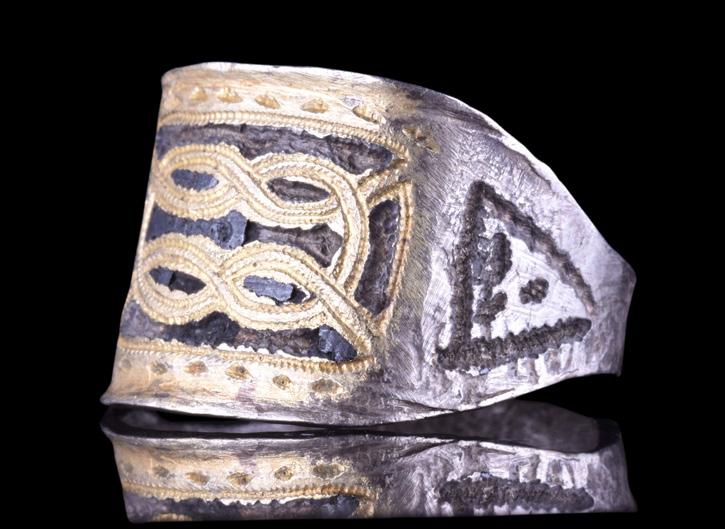
327. CRUSADERS SILVER RING WITH GOLD INLAID CROSS
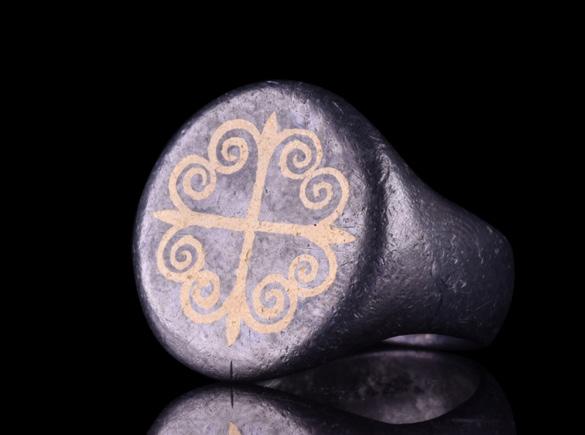
Ca. 1100-1400 AD
Starting price: £300
A silver ring with D-shaped hoop and circular bezel featuring an elaboarate gold inlaid cross. The Cross, the principal symbol of Christianity, recalling the Crucifixion of Jesus Christ. Good condition, wearable. Size: D: 18.34mm / US: 8 1/4 / UK: Q; 10.36g.
Provenance: From the private collection of a South London art professional; previously in a collection formed on the UK/European art market in the 1980s.
328.
Ca. 800-1000 AD
Starting price: £900
A reliquary cross pendant cast in two separate pieces and hinged at the top and bottom. The obverse face is engraved with a standing and robed orant figure depicted with outstretched arms. On the reverse, a stylised cross motif. This type of cross can be opened to hold a small relic or a prayer document. For a comparison see The British Museum, Museum number 1929,0713.7. This item is in wearable condition and it comes with a modern necklace cord. Size: L:92mm / W:55mm ; 75g.


Provenance: Private UK collection; From an old London collection formed in the 1990s.
329.
Ca. 800-1000 AD
Starting price: £400
A reliquary cross pendant cast in two separate pieces and hinged at the top and bottom. Both faces are engraved with a standing and robed orant figure depicted with outstretched arms. This type of cross can be opened to hold a small relic or a prayer document. For a comparison see The British Museum, Museum number 1929,0713.7. This item is in wearable condition and it comes with a modern necklace cord. Size: L:47.3mm / W:21.5mm ; 8.36g.

Provenance: Private UK collection; From an old London collection formed in the 1990s.
Ca. 800-1000 AD
Starting price: £200
A cast-bronze reliquary cross pendant composed of two cruciform plaques that fit together, a hinged mechanism to the top and bottom, and a loop for suspension. Both faces display the crucified Christ in relief. This type of cross can be opened to hold a small relic or a prayer document. Relics, as the physical remains of saints or objects associated with Christ, held tremendous power in medieval Christianity. For a comparison see The British Museum, Museum number 1985,0305.1. This item is in wearable condition and it comes with a modern necklace cord. Size: L:55.2mm / W:22.7mm ; 16g.
Provenance: Private UK collection; From an old London collection formed in the 1990s.
Ca. 800-1000 AD
Starting price: £500
A cast-bronze reliquary cross pendant composed of two cruciform plaques that fit together. This item is in wearable condition and it comes with a modern necklace cord. Size: L:165mm / W:80mm ; 275g.
Provenance: Private UK collection; From an old London collection formed in the 1990s.
Ca. 800-1000 AD
Starting price: £200
A finely modelled reliquary cross composed of two cruciform plaques that fit together using a hinge mechanism. This item is in wearable condition and it comes with a modern necklace cord. Size: L:54.9mm / W:22.6mm ; 24g.
Provenance: Private UK collection; From an old London collection formed in the 1990s.


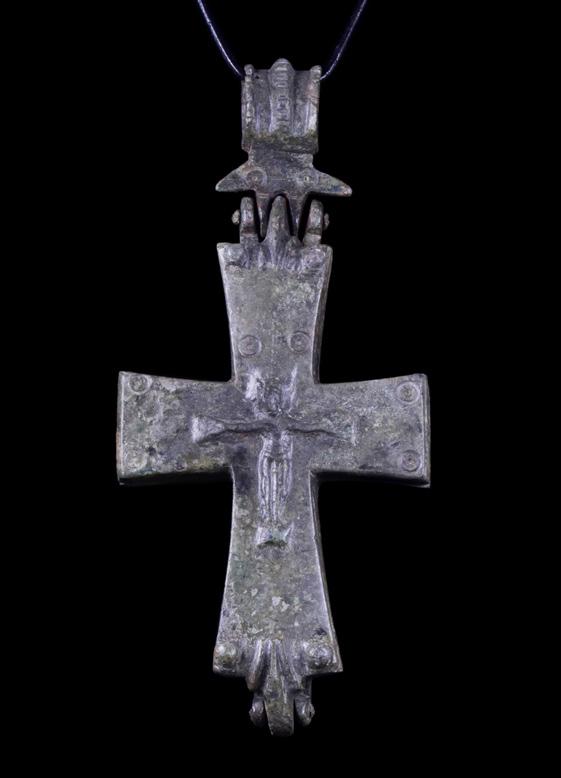
Ca. 800 AD
Starting price: £200
A bronze cruciform pendant in the form of a Latin cross decorated with a depiction of Jesus. This item is in wearable condition and it comes with a modern necklace cord. Size: L:39.7mm / W:21.9mm ; 3.89g.
Provenance: Private UK collection; From an old London collection formed in the 1990s.

GEORGE
Ca. 1000 AD
Starting price: £300
A cast-bronze two cruciform plaques, one is decorated with the engraved image of nimbate Saint George, with his arms raised in the Orans position. To the upper edge, the Greek inscription (George) confirms the identity of the Saint. The other plaque with perforated junction and concentric circles motifs to each arm. Size: L:85mm / W:60mm ; 75g.
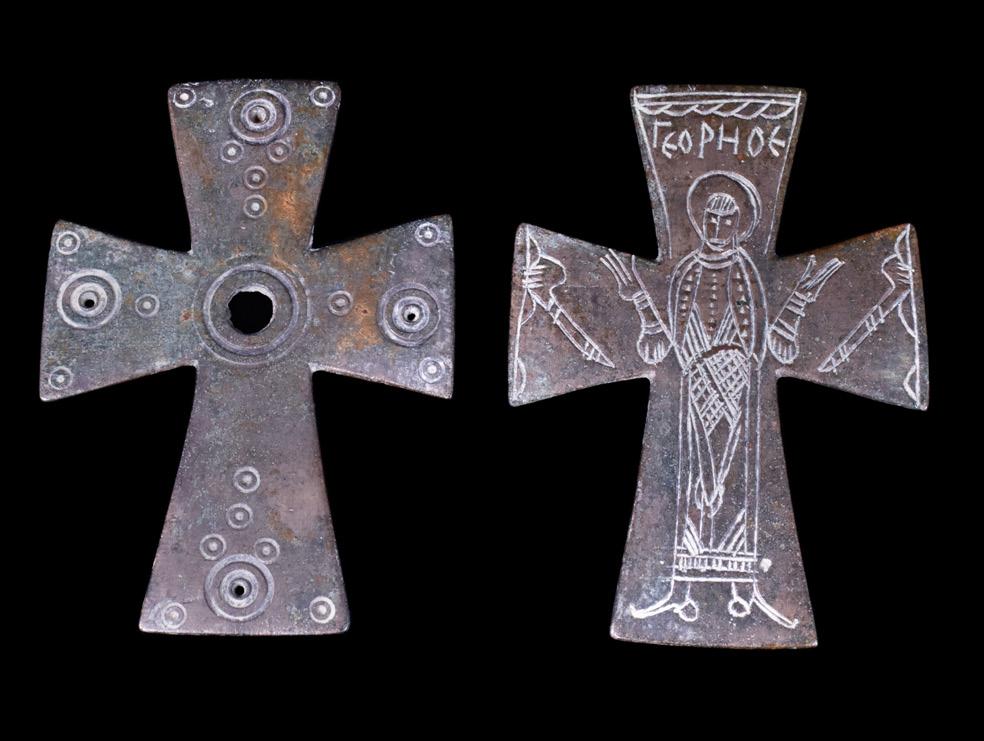
Provenance: Private UK collection; From an old London collection formed in the 1990s.
Ca. 1100-1300 AD
Starting price: £100
A bronze cruciform pendant. It’s wearable and it comes with a modern necklace cord. Size: L:52.4mm / W:31.2mm ; 9.29g.
Provenance: Private UK collection; From an old London collection formed in the 1990s.
336.

Ca. 800-1000 AD
Starting price: £200
A bronze cruciform pendant with scalloped arms. This item is in wearable condition and it comes with a modern necklace cord. Size: L:39.4mm / W:27.1mm ; 5.87g.
Provenance: Private UK collection; From an old London collection formed in the 1990s.

Ca. 1100-1400 AD
Starting price: £1100
A bronze cruciform pendant with scalloped arms and an integral circular suspension loop. The obverse features sets of five recesses to each arm, possibly to accept an inlay. The Crusades were military expeditions that began in the late 11th century AD. This item is in wearable condition and it comes with a modern necklace cord. Size: L:70.5mm / W:49mm ; 16.27g.
Provenance: Private UK collection; From an old London collection formed in the 1990s.
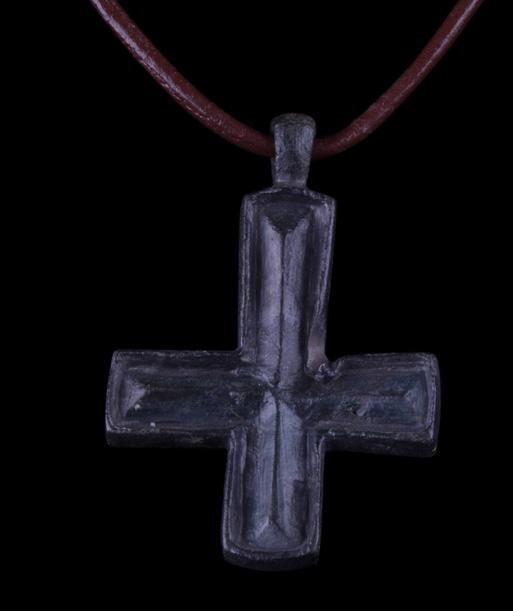
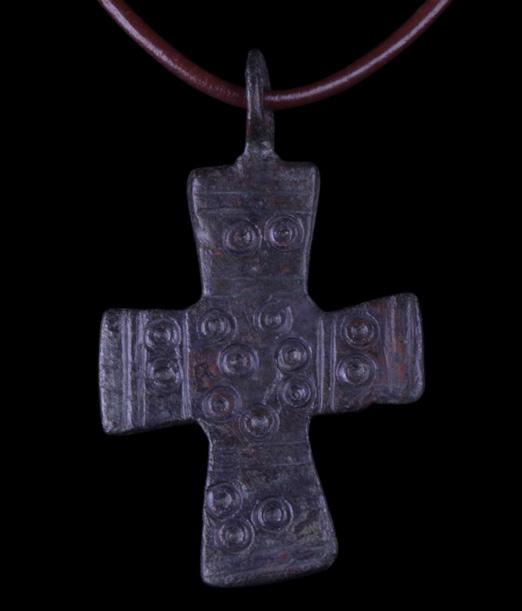
Ca. 1100-1400 AD
Starting price: £100
A bronze cruciform pendant with arms tapering in towards the center. At the junction, there is a Maltese Cross in relief. The suspension loop makes this piece wearable and it comes with a modern necklace cord. This item is in wearable condition and it comes with a modern necklace cord. Size: L:39.7mm / W:24.4mm ; 5.38g.
Provenance: From the private collection of a South London art professional; previously in a collection formed on the UK/European art market in the 1980s.
Viking Age, Ca. 900-1100 AD
Starting price: £100
A bronze cross pendant comprising four flat arms decorated with concentric circles representing Sun motifs. Good condition. Size: L:44.6mm / W:26.5mm ; 6.79g.

Provenance: From the private collection of a South London art professional; previously in a collection formed on the UK/European art market in the 1980s.
Starting price: £100
A bronze pendant in the form of a cross with a rounded suspension loop at the top. The front bears a moulded relief of a cross. This beautiful item may have belonged to a crusader knight, who traveled to the Holy land to defend his faith. This item is in wearable condition and it comes with a modern necklace cord. Size: L:37.6mm / W:26.6mm ; 8.29g.

Provenance: From the private collection of a South London art professional; previously in a collection formed on the UK/European art market in the 1980s.
1200 AD
Starting price: £100
A bronze archer’s ring comprising a circular hoop and projecting triangular guard. The exterior of the guard is covered in extensive incised geometric motifs. An archer’s ring was worn on the thumb to protect the skin when the bowstring was drawn. Excellent condition; beautiful patina. Size: D: 21.79mm / US: 12 1/2 / UK: Z; 7.9g.
Provenance: From the private collection of a South London art professional; previously in a collection formed on the UK/European art market in the 1980s.
Ca. 1100-1400 AD
Starting price: £100
A solid bronze ring comprising a circular band, shield-shaped shoulders linearly decorated, and a large round bezel engraved with a cross inscribed within a circle flanked by a decorative band. Good condition. For more information on Crusader period rings, see Pollio, T.N. (2018). Ancient Rings - An Illustrated Collector’s Guide. McFarland, Incorporated, Publishers, 88-99. Good condition, wearable. Size: D: 17.73mm / US: 7 1/2 / UK: O 1/2; 7g.
Provenance: From the private collection of a South London art professional; previously in a collection formed on the UK/European art market in the 1980s.

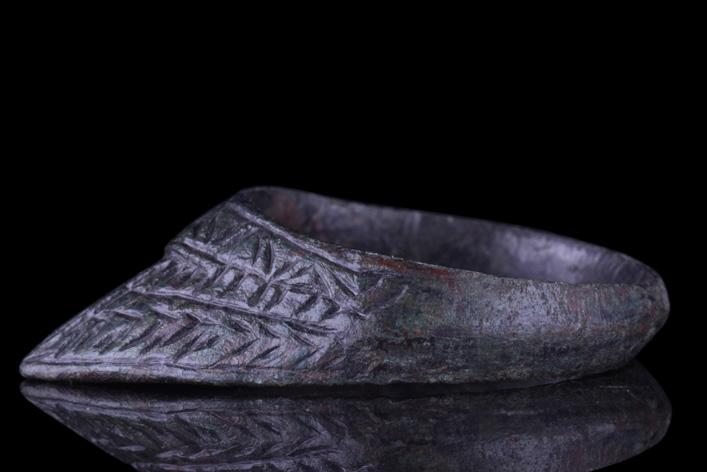
Starting price: £200
Beautifully decorated bronze bracelet. Flat with raised figurative designs and edges. Penannular with some green patina. Wearable. Jewellery was an important part of viking culture, for men and women alike. Contrary to modern ideas of vikings, historical chroniclers like English monk John of Wallingford recorded that the vikings took great interest in their physical appearance. Moreover, jewellery was used as a status indicator, so precious materials and elaborate designs were favoured. Size: L:50mm / W:62mm ; 24g.
Provenance: Property of a North London gentleman; previously acquire on the UK/European art market before 2000.

Ca. 8th-12th century AD
Starting price: £100
Beautifully decorated bronze bracelet. Flat with raised figurative designs and edges. Penannular with some green patina. Wearable. Jewellery was an important part of viking culture, for men and women alike. Contrary to modern ideas of vikings, historical chroniclers like English monk John of Wallingford recorded that the vikings took great interest in their physical appearance. Moreover, jewellery was used as a status indicator, so precious materials and elaborate designs were favoured. Size: L:50mm / W:61mm ; 24g.
Provenance: Property of a North London gentleman; previously acquire on the UK/European art market before 2000.

Ca. 600 AD
Starting price: £500
A gold finger ring composed of a thin hoop with pairs of fine granules to each shoulder and a large bezel set with a garnet cabochon engraved with a depiction of a maltese cross with smaller crosses to each finial. Size: D: 16.31mm / US: 5 3/4 / UK: L; 2g.
Provenance: Property of a North London gentleman; previously acquire on the UK/European art market in the 1990s.
Starting price: £1,000
A beautiful gold finger ring featuring a circular hoop with expanded shoulders and a nicely decorated trumpet-shaped bezel with ribbed collar, set with blue glass cabochon. Above, the conical-shaped box projection is flanked by scrolls and decorated with garnet. For a similar see, The Metropolitan Museum of Art, Accession Number: L.2015.72.39. Size: D: 21.39mm / US: 12 / UK: X 1/2; 11.46g.
Provenance: From the private collection of a Central London gentleman; previously in a collection formed on the UK/European art market before 2000.
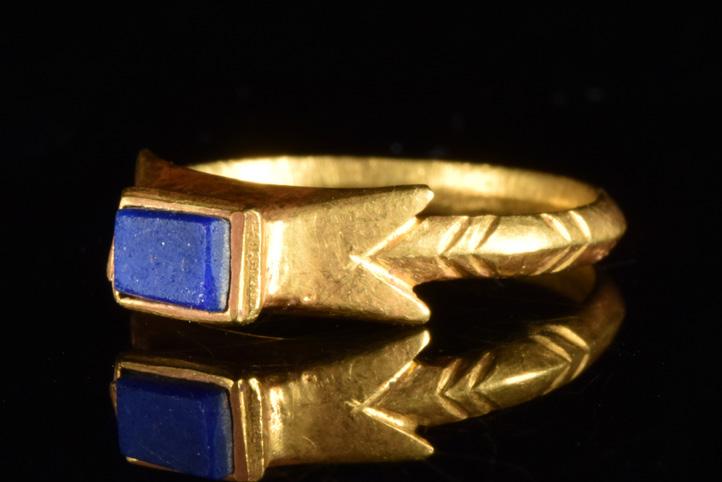

Ca. 1300-1400 AD
Starting price: £500
A slender gold stirrup-type ring with a carinated and incised hoop, and a decorative bezel with lapis lazuli stone to the apex. Size: D: 13.67mm / US: 2 1/2 / UK: E; 2g.
Provenance: Property of a North London gentleman; previously acquire on the UK/European art market in the 1990s.

Ca. 400-500 AD
Starting price: £1,000
A gold finger ring of a round hoop widening to the faceted shoulder bearing an inscription “ZOH XAPA” - meaning ‘ZOH’ - life, ‘XAPA’joy, happiness. Size: D: 19.15mm / US: 9 1/4 / UK: S; 4g.
Provenance: Property of a North London gentleman; previously acquire on the UK/European art market in the 1990s.

Ca. 600 AD
Starting price: £500
A gold finger ring having a tapered shank with a fine ringed border bezel set with a garnet cabochon. A nice and sturdy example suitable for wearing. The medieval empire of Byzantium was justly famous for the elegance of its jewellery, whether in precious metals for the aristocracy or in bronze for people further down the social ladder. This gorgeous piece may once have belonged to a Byzantine noblewoman or princess. Size: D: 17.32mm / US: 7 / UK: N 1/2; 4.62g.
Provenance: Property of a West London gentleman; previously in a collection formed on the UK/International art market since the 1970s.

Ca. 1100-1300 AD
Starting price: £500
A stunning pair of gold earrings each with a wide hoop, fine catch plate, and circular openwork body comprising a cross design framed by four concentric registers of elegant filigree decorations arranged in geometric patterns. Suspended from the body are three filigree pendants each threaded with three stone beads in various colours. These beautiful items may once have belonged to a Byzantine noblewoman. Excellent condition; wearable. Size: L:67mm / W:33mm ; 10.83g.
Provenance: Property of a professional London art expert; obtained from an old British collection formed in the 1970-80s.
Ca. 600 AD
Starting price: £500
A matched pair of gold earrings, each a tapering hoop, hook-and-clasp closure, and a single elongated pendant comprising glass and pearls spherical beads attached to a cord of woven gold wire. These beautiful pieces would probably have once adorned the ears of a Byzantine noblewoman. Size: L:76.1-77.7mm / W:18.418.8mm ; 6.55g.

Provenance: From an old British collection, acquired on the UK art market in the 1980s.
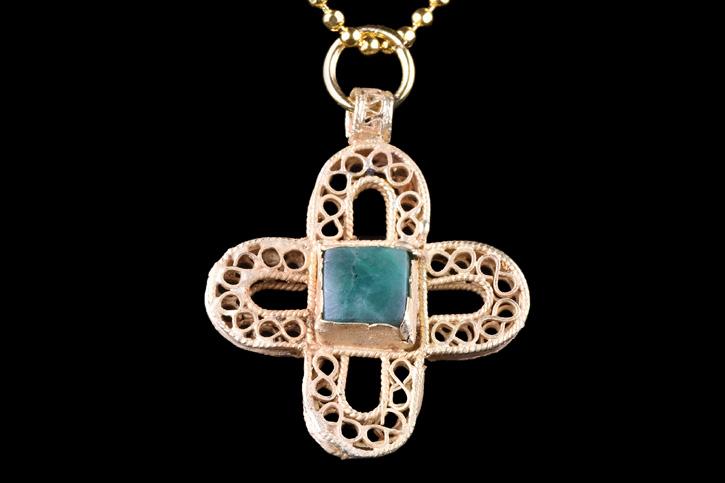
Ca. 800-1000 AD
Starting price: £500
A beautiful gold cross with intricate repeating curvilinear scrollwork decoration and a suspension loop. The centre of the cross comprises a square-shaped emerald setting. Crosses are the principal symbol of the Christian religion, recalling the Crucifixion of Jesus Christ and the redeeming benefits of his Passion and death.
The cross is thus a sign both of Christ himself and of the faith of Christians. This item is in wearable condition and it comes with a modern necklace cord. Size: L:21.5mm / W:17.9mm ; 1.5g.
Provenance: Property of a North London gentleman; previously acquire on the UK/European art market in the 1990s.
Ca. 600-800 AD
Starting price: £300
A wearable, religious gold pendant in a circular form with a beaded border enclosing a relief decoration of two doves facing each other and perching o a trefoil-shaped tendril. In Christianity, the dove is a symbol of the Holy Spirit, also it was the dove that brought the olive branch to Noah on the Ark. This item is in wearable condition and it comes with a modern necklace cord. Size: L:22.5mm / W:20.1mm ; 2g.
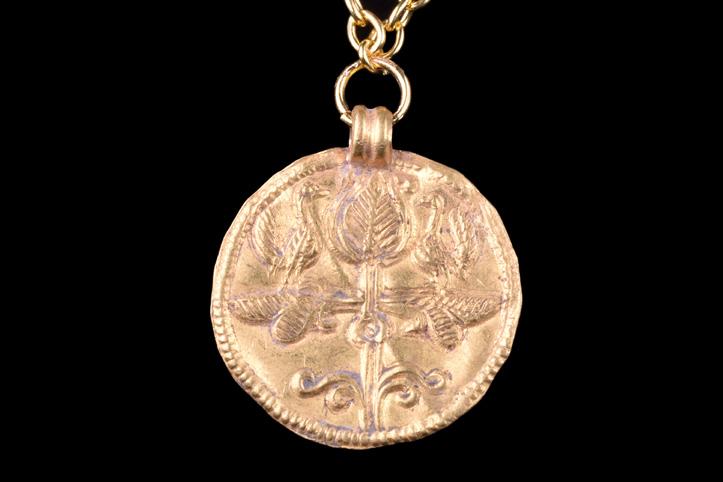
Provenance: From an old British collection, acquired on the UK art market in the 1980s.
352.
500-600 AD
Starting price: £500
An elaborate pair of gold earrings, each comprising a hinged wire hoop with a pin closure and a large sphere richly adorned with filigree decoration. The medieval empire of Byzantium was justly famous for the elegance of its jewellery, whether in precious metals for the aristocracy or in bronze for people further down the social ladder. These gorgeous pieces may once have belonged to a Byzantine noblewoman or princess. Size: L:26.7-29.1mm / W:16.616.8mm ; 5.14g.

Provenance: From an old British collection, acquired on the UK art market in the 1980s.
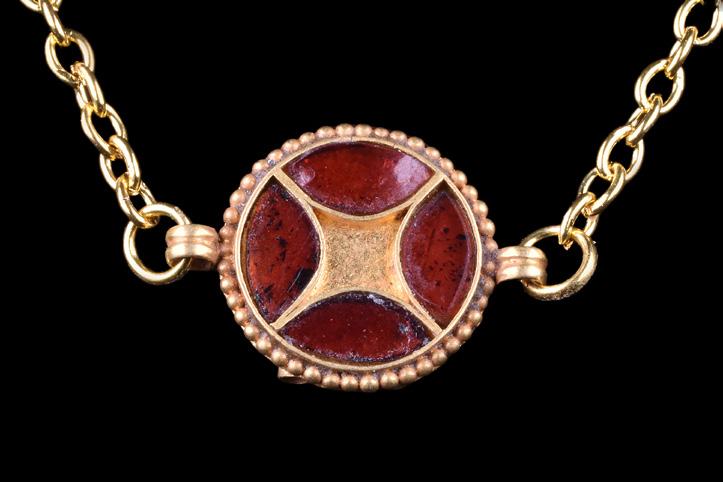
Ca. 500-700 AD
Starting price: £500
A beautiful circular gold pendant inset with garnets, framed with a beaded edge and flanked by a pair of opposing suspension loops. The reverse features two parallel bars. This fine item is in wearable condition and it comes with a modern necklace chain. For more information on Merovingian art, see Effros, B. & Moreira, I. (2020). The Oxford Handbook of the Merovingian World. Oxford University Press, 916ff. Size: L:18.9mm / W:13.9mm ; 1.52g.
Provenance: From an old British collection, acquired on the UK art market in the 1980s.
Neo-Classical, Ca. 1800-1900 AD
Starting price: £500
A lovely brooch composwed of an Alexander III the Great silver, authentic 4th C BC drachm, set in fine 18K yellow gold with a halo of white single cut diamonds. Size: L:28mm / W:6mm ; 10.53g.

Provenance: Private London collection; Previously with I.G.; acquired from an East Coast, USA collector prior to 1979. Exhibited: Olympia Art & Antiques fair, London June 2022.
357.
AD
Starting price: £500
A carnelian intaglio of ovoid form, skillfully incised with a depiction of God Mars wearing his military attire, set in an elaborately ornamented gold brooch setting composed of a twisted inner border and an openwork design made of fine coils decorated with filigree, and six coral cabochons alternating with floral-shaped plaques topped with three granules. Pin and catch plate to the reverse. Mars is the god of war in Roman religion and mythology and his Greek counterpart is Ares. Though he is primarily known as the god of war, he is also known as a guardian of agriculture, the god of spring, fertility, virility, and growth in nature. Size: L:52mm / W:43mm ; 17.37g.
Provenance: Property of a London Art gallery; formerly acquired on the US Art market; previously in US collection I. G. formed before 1970.
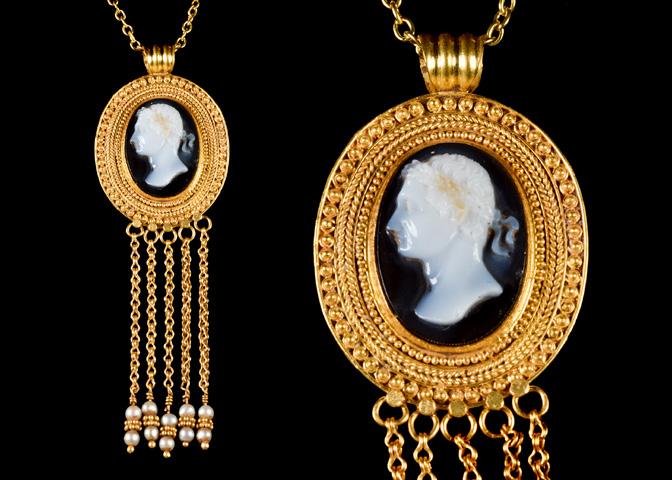
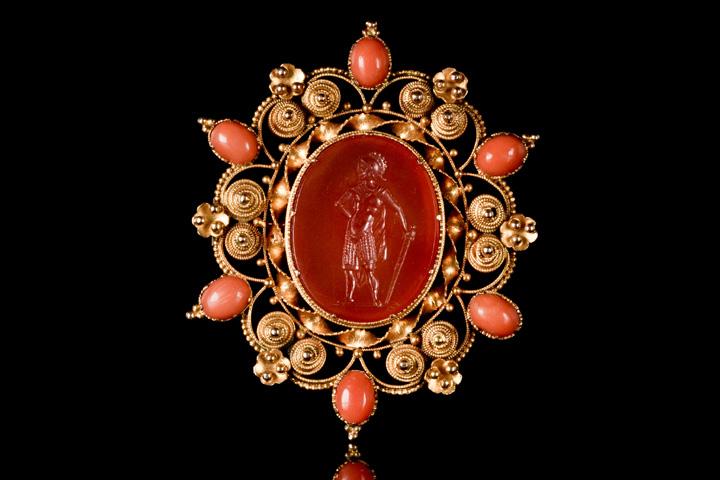
Starting price: £500
A gold discoid pendant with an intricately decorated border of concentric filigree bands enclosing a central sardonyx cameo of a left-facing male bust wearing a laurel wreath. Possibly depicting one of the early Roman Emperors. On the bottom edge are five long chains terminating in pearl beads spaced by a double collar of filigree. This item is fully wearable and it comes with a modern necklace cord. Size: L:93mm / W:29mm ; 21.52g.
Provenance: Property of a London Art gallery; formerly acquired on the US Art market; previously in US collection I. G. formed before 1970.

Starting price: £500
A
Size: L:50mm / W:70mm ; 24g.
votive figure of a bull in a layer of sheet silver. The animal is standing in a naturalistic position, the thick muscular neck with the dewlap handing from the neck to between the forelegs and extending beneath the body, the large head with a prominent rounded muzzle, large oval shaped eyes deeply recessed for inlays (now missing), beneath a heavy brown with incised ridged details. The head detailing small curving horns, two small-folded ears beneath the horns. For similar see: Bonhams, 16th April 2015, lot 44. For a gold example see: Musee de Louvre, Paris, acc. No. AO 14680. The bull votive may stand for the god Baal in animal form who in his human shape is also depicted with horns.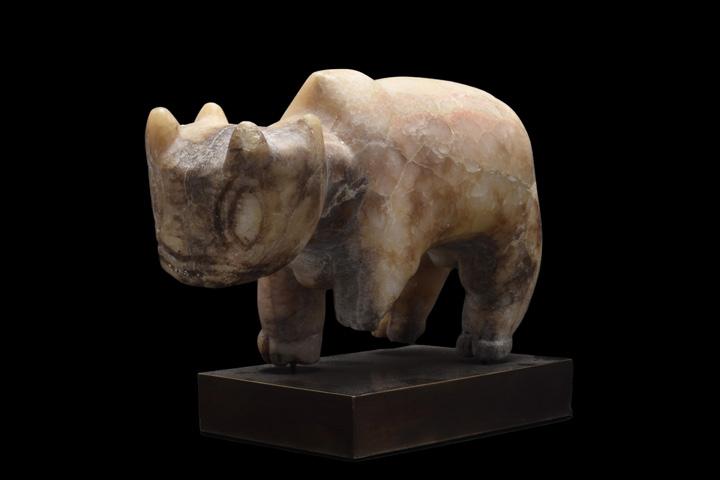
Ca. 300 BC - 100 AD
Starting price: £300
A finely carved alabaster freestanding bull figure depicted standing alert on all four legs with nicely detailed hooves. The animal is naturalistically modelled with a heavy body, short horns, small ears, nostrils, and eyes down. Qataban, was one of the ancient kingdoms of Yemen that thrived in the Baihan Valley. It was located to the west of Hadramaut and to the east of the Sabaean kingdom. Like many other kingdoms of South Arabia, its economy was centered on the trade in frankincense and myrrh. Size: L:140mm / W:210mm ; 3.14kg.
Provenance: Private collection of a West London gentleman; previously in a collection formed on the UK/International art market in the 1980s.
361.
Qataban, Ca. 300 BC - 100 AD
Starting price: £300
An alabaster funerary stele with a slightly tapering profile towards the bottom, with a high relief bovine head projecting from the slab. The animal’s head features ribbed brows, eyes down, small horns, and pronounced nostrils. Bands of mineral inclusions flow across the surface of the stone. For a similar example, see Sotheby’s, Ancient Sculpture and Works of Art Part I, 7 December 2021, Lot 12. Size: L:250mm / W:130mm ; 3.36kg.

Provenance: Private collection of a West London gentleman; previously in a collection formed on the UK/International art market in the 1980s.
363.
Ca. 3000-2500 BC
Starting price: £500
362.

Ca. 300 BC
Starting price: £300
A funerary stele, polygonal in form, sculpted in low relief with a face head with almond-shaped eyes, a prominent long triangular nose, a small, pursed mouth, and protruding rounded ears. For more on South Arabian funerary stelae: Cf. St. J. Simpson, Queen of Sheba, Treasures from Ancient Yemen, British Museum, 2002, pp. 192-197; cf. J. Schiettecatte et al., San’a’ National Museum, Part III Collection of Funerary Stelae from the Jawf Valley, Sanaa, 2008, nos 409 and 411. Size: L:255mm / W:165mm ; 6.52kg.
Provenance: Private collection of a West London gentleman; previously in a collection formed on the UK/International art market in the 1980s.
A large terracotta vessel sitting upon a flat circular base from which a globular body rises upwards and terminates in a wide opening with a rounded and everted rim. The exterior of the vessel features multiple registers of polychrome geometric and leaves designs painted with exceptional attention to detail. Size: L:450mm / W:310mm ; 7.39kg.
Provenance: Important collection from Oxford; ex. D. Ruskin; formerly in a gallery; ex. British collection formed in the 1970s.


Ca. 3rd Millennium BC
Starting price: £500
A finelly modelled vessel which has been wheel made with a globular base. Its black glaze radiating with a zoomorphic incised pattern encircling the base which has been delicately carved. The decoration is rounded connecting at a point mirroring a snake trail. The bowl conical in shape forming an everted rim and round bottom for placing in sand. Size: L:110mm / W:210mm ; 1Kg.
Provenance: London Ancient Art Gallery; formelry acquired from Fortuna Fine Arts, New York, USA.
Ca. 1st Millennium BC
Starting price: £500
A beautiful necklace of carnelian and agate graduated beads highlighted by 6 hollow coinlike beads and one large bead; all seven in 23K yellow gold. Size: L:257mm / W:42mm ; 47.15g.

Provenance: Private London collection; Previously with I.G.; acquired from an East Coast, USA collector prior to 1979. Exhibited: Olympia Art & Antiques fair, London June 2022.
366.

Ca. 400-600 AD
Starting price: £1,000
A rare gold finger ring comprising a highly decorative hoop of a flat-section band, expanding to support an oval-shaped bezel engraved with a script and three rosettes, one with a lunar crescent at the center. Size: D: 19.76mm / US: 10 / UK: T 1/2; 13.17g.
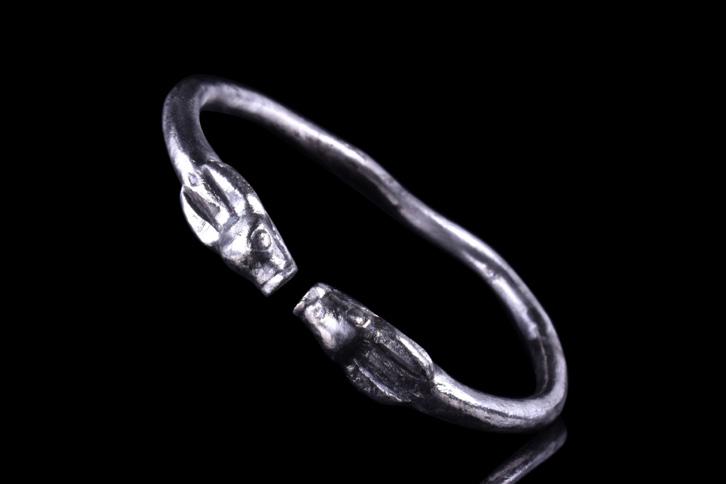
Provenance: Private collection of a West London gentleman; previously in a collection formed on the UK/International art market in the 1980s.
367.
Ca. 1000-800 BC
Starting price: £800
A hollow-formed gold ring with a rounded outer face with a slight carination and a flat inner face, with tapered and overlapping finials. These types of penannular rings are usually referred to as ‘hair rings’ or ‘lock rings’ and were also used as a form of currency for trade. Size: D: 19.15mm / US: 9 1/4 / UK: S; 8.64g.
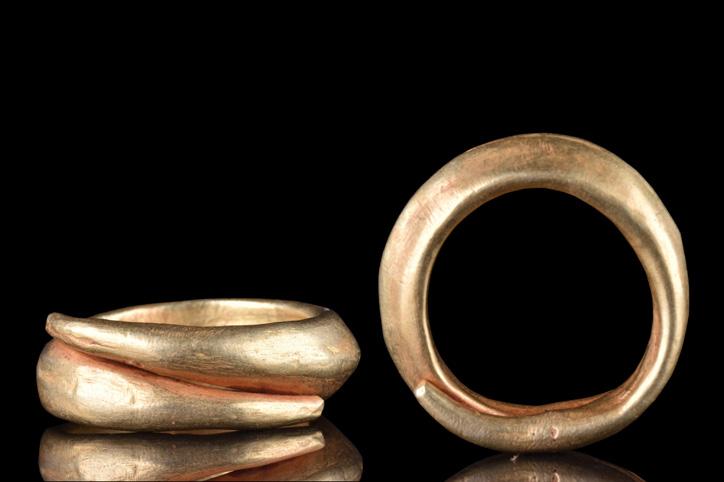
Provenance: Private collection of a West London gentleman; previously in a collection formed on the UK/International art market in the 1980s.
368.
Ca. 550-330 BC
Starting price: £200
A beautiful bracelet made of a hollow shank formed of silver sheet. The shank features a round-section body with terminals in the shape of animal heads facing each other. Each head with incised eyes, and a truncated snout. Excellent condition. The Achaemenid Empire (the first Persian empire) was an ancient empire founded by Cyrus the Great, stretching from the Balkans and Eastern Europe to the Indus Valley and covering 5.5 million square kilometers at its height. This empire is also famous for being the antagonist of the Greek city-states during the Greco-Persian wars. Size: L:70mm / W:54.4mm ; 37.17g.
Provenance: Private UK collection; From an old British collection formed in the 1990s.
Ca. 550-330 BC
Starting price: £200
A beautiful bracelet made of a hollow shank formed of silver sheet. The shank features a round-section body with terminals in the shape of animal heads facing each other. Each head with incised eyes, and a truncated snout. Excellent condition. The Achaemenid Empire (the first Persian empire) was an ancient empire founded by Cyrus the Great, stretching from the Balkans and Eastern Europe to the Indus Valley and covering 5.5 million square kilometers at its height. This empire is also famous for being the antagonist of the Greek city-states during the Greco-Persian wars. Size: L:71.1mm / W:58mm ; 38.36g.
Provenance: From an old British collection, acquired on the UK art market in the 1980s.
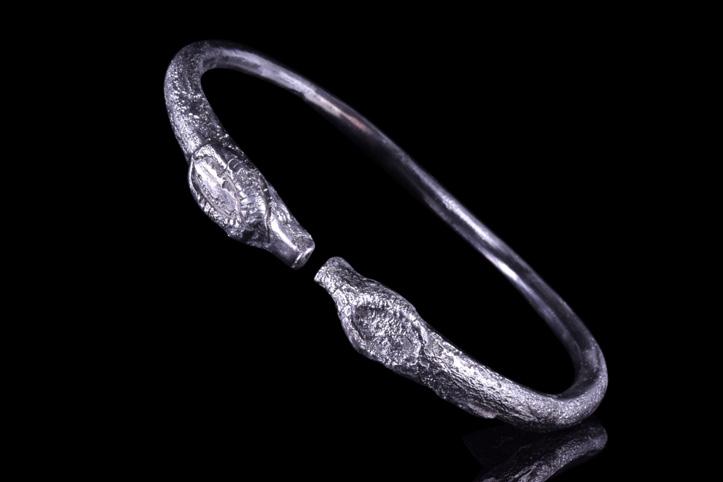
370. TANG DYNASTY BODHISATTVA MARBLE TORSO Ca. 618–907. Chinese Tang Dynasty (or later). Starting price: £3,000
A beautiful marble torso of a bodhisattva elegantly adorned with an astonishing jewelled harness made up of long strands of pearllike clusters and multifaceted beads. The pearl harness descends along the torso’s spine until its waist. The pearl cabochons derive from Central Asian traditions. A scarf is draped diagonally around the back of the torso from the right-hand side shoulder to the left-hand side hip. Size: L:365mm / W:335mm ; 27kg.

Provenance: Collection of Chinese Stone Figures. Ex Collection of Roger Moss; The C Roger Moss OBE, 1936 - 2020 collection formely the President of “The oriental ceramics Society”, these stone sculptures were acquired during his life in Hong Kong 1980 - 2003.
371. TANG DYNASTY SEATED BODHISATTVA MARBLE TORSO Ca. 618–907. Chinese Tang Dynasty (or later). Starting price: £3,000
A beautiful marble statue of a seated bodhisattva depicted wearing voluminous robes elegantly draped over his wide shoulders and broad, muscular chest and cascading in deep folds over his pendant legs, falling to the sides of his seat and continuing down his back; the remains of his left arm resting on one thigh. Bodhisattvas are common figures in Buddhist literature and art. A bodhisattva is one who seeks awakening (bodhi) hence, an individual on the path to becoming a Buddha
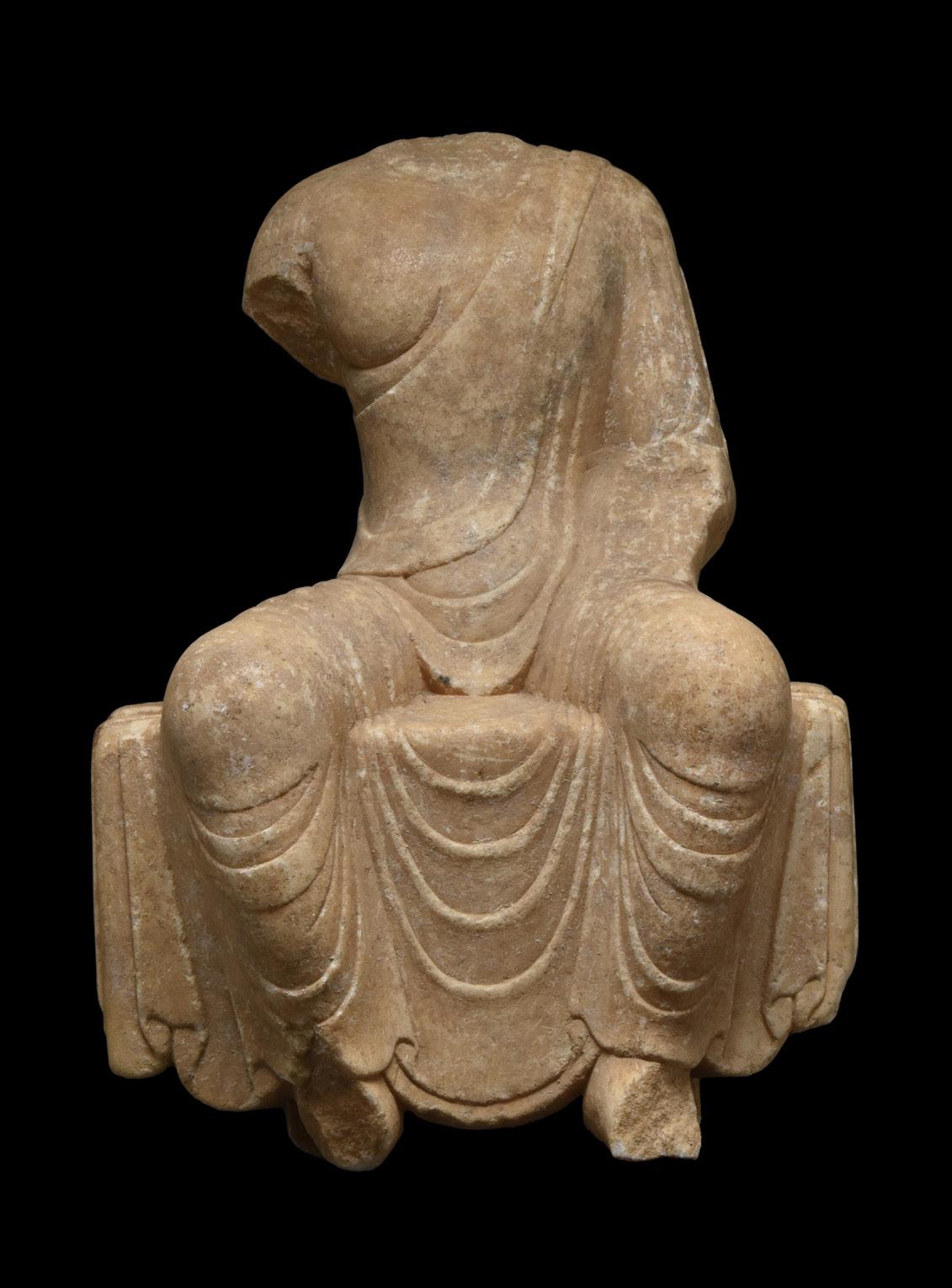
Perhaps the most striking feature of this marble fragment is its realistic portrayal of a seated figure revealed beneath drapery. The remains of his thick neck and developed pectoral muscles appear above his inner garment that crosses from his left shoulder downwards to the right hip. The voluminous outer garment spreads in unevenly spaced pleats and folds that suggest the natural effects of gravity as they fall across the arms, pendant legs and the front edge of the seat supporting him. Size: L:300mm / W:220mm ; 15.9kg.
Provenance: Collection of Chinese Stone Figures. Ex Collection of Roger Moss; The C Roger Moss OBE, 1936 - 2020 collection formely the President of “The oriental ceramics Society”, these stone sculptures were acquired during his life in Hong Kong 1980 - 2003.

Starting price: £10,000
A grey schist carving of a standing Buddha. This excellent figure is backed by a circular halo and dressed in a flowing Kasaya (monastic robe). The head features thick, rich lips, an aquiline nose, half-closed eyes with well-defined eyelids, arched brows, an urna on the forehead, prominent ears and carefully modelled, wavy hair, culminating in an ushnisha. The figure stands atop a rectangular base. Gandhara was an ancient region in the Peshawar basin in the north-west of the ancient Indian subcontinent. The Kushan period (c. 75-451 AD) of Gandharan art, to which this schist figure belongs, was the golden age of artistic production in the area. For further information on Gandharan art, see Jongeward, D. 2019, Buddhist Art Of Gandhara in the Ashmolean Museum. Oxford, Oxford University Press. For a similar see The Metropolitan Museum of Art, Accession Number: 67.154.5.
Size: L:790mm / W:270mm ; 33.40kg.
Provenance: From an Oxfordshire art professional, M.D. from 2010s; previously in an old Canadian collection, A.F. based in Ontario and formed in the 1970s.

Starting price: £900
A remarkable example of Kushan artistry, richly carved in grey schist, combining naturalism of the classical Greek style with the Asian serenity of Buddhist art. A finely polished dark grey schist statue representing a Bodhisattva, his head now missing, his hands raised in Anjali Mudra pose, the pose of greeting and respect. The robe elegantly draping over both sides of his shoulders, undulating in high relief across the torso, gathering in folds over the legs, he is adorned with braided necklace and stylised bracelet. Size: L:700mm / W:200mm; 20kg.
Provenance: From the collection of a London gentleman; formerly acquired in early 2000s in France; previously in 1970s European collection.
Starting price: £3,000
A schist stone head of a Buddha. He is depicted with wavey hair gathered up in a topknot above a headband. His face characteristically has drooping, half-closed eyes, characteristic of his depictions under the Kushan Dynasty, and he is shown with a slender, wavey moustache above his full lips. His forehead is decorated with the dot called the Urna, which represented the third eye that saw beyond the material limits of the world. The Buddha form was used to depict both the original Buddha Gautama as well as anyone who became a Buddha by achieving Nirvana. The Buddha was not expressed in sculpture in Gandhara before the 1st century AD, before which he was only alluded to with symbols. From this time though, Gandharan art depicted Buddhas with a captivating mix of traditional Buddhist iconography and style, and the naturalism and soft features of Classical art, since this region was greatly influenced by the conquests of Alexander the Great many centuries earlier and the subsequent Greek settlers. For more information on Gandharan art, see Jongeward, D. (2019). Buddhist Art Of Gandhara in the Ashmolean Museum. Oxford, Oxford University Press. Size: L:390mm / W:265m; 12.90kg.
Provenance: From the collection of a London gentleman; formerly acquired in early 2000s in France; previously in 1970s European collection.

375. CHINESE HAN DYNASTY TERRACOTTA PAIR OF SEATED FIGURES PLAYING LIUBO - TL TESTED Ca. 206 BC - 220 AD
Starting price: £3,000
A set comprising two players and a Liubo board with playing pieces. Both figures are shown in a seated position. They are dressed in long, voluminous robes and their faces display strong emotions accompanying the game. Between them, there is a liubo board with pawns placed on it. Liubo was a popular game in the Han dynasty, involving two players. Although the exact rules of the game are now lost, many scholars assume that it had some kind of astrological, fortune-telling, or other significance. For a comparable example, see The Metropolitan Museum of Art, Accession Number: 1992.165.23a, b. This set has been precisely dated by means of a Thermo Luminescence analysis carried out by Ralf Kotalla, an independent German Laboratory. The samples collected date the piece to the period reflected in its style, whilst also showing no modern trace elements. The TL certificate with its full report will accompany this object.

Size: L:65-345mm / W:225-315mm ; 14.04kg.
Provenance: From the private collection of a Somerset gentleman; previously in an old British collection, formed in the 1980s on the UK /European art markets.
376. CHINESE TANG DYNASTY TERRACOTTA SOGDIAN RIDER ON CAMEL - TL TESTED Ca. 618-907 AD
Starting price: £3,000
An earthenware mingqi of a foreign rider on a camel modelled in a standing pose. The rider is depicted with his body facing outwards, his head turned slightly as if facing a target, he has stylised aquiline nose, elongated earlobes, prominent cheekbones, and deep-set eyes surmounted by lashed eyebrows, with an impressive beard. His hair carefully dressed; his hands raised. The camel is yellowish in colour with patches of red. The muscles are rendered in great detail on the neck and hind quarters. The Sogdians were an Iranian people whose homeland, Sogdiana, was located at the center of several of those routes, in present-day Uzbekistan and Tajikistan. This piece has been precisely dated by means of a Thermo Luminescence analysis carried out by Ralf Kotalla, an independent German Laboratory. The samples collected date the piece to the period reflected in its style, whilst also showing no modern trace elements. The TL certificate with its full report will accompany this object.

Size: L: 760mm / W 55mm ; 20kg.
Provenance: From the private collection of a Somerset gentleman; previously in an old British collection, formed in the 1980s on the UK /European art markets.
Late Shang/Early Western Zhou Dynasty, Ca. 12th-11th Century BC
Starting price: £3,000
Cast in relief with taotie masks and leiwen, on three bird-shaped flattened profile legs, bas-relief cast zoomorphic pattern with a triage of conical-shaped motifs with circle nodule centre, linked with floral motifs with central nodule. some restoration. For futher reading see: Liu Yang, Ancient Ritual Bronzes from the Shanghai Museum, p.80-81. Shang Rituals Bronzes in the Arthur M Sackler collections.The item has undergone X-ray fluorescence analysis to confirm the metallurgical content suggesting its ancient origin and lack of modern trace elements. This item shows signs of restoration. Size: L:255mm / W:195mm ; 1.6kg.
Provenance: East Anglian private collection; formerly acquired in the early 1990s in Hong Kong. Exhibited: Olympia Art & Antiques fair, London June 2022.
Late Shang Dynasty, Ca. 1300-1100 BC
Starting price: £4,000
A bronze cauldron, generally known as a ding. The object comprises a rectangular body with a shelved rim and two horizontal handles. The upper part of the body is intricately decorated with a bas-relief cast zoomorphic pattern. The body is supported by four robust cylindrical legs with some decoration. This beautiful object may have been used for ritual banqueting among the aristocracy of the Late Shang Dynasty, who ruled over the lower and middle Yellow River Valley in the 2nd millennium BC. For a comparable example, see The Metropolitan Museum of Art, Accession Number: 49.135.2. In order to confirm its authenticity, this piece has undergone X-Ray Fluorescence analysis by an independent Belgian Laboratory. The samples collected show the chemical composition to reflect the typical metal contents of the described period, whilst also showing no modern trace elements in the patina. This item shows signs of restoration. Size: L:280mm / W:200mm ; 4.23kg.


Provenance: East Anglian private collection; formerly acquired in the early 1990s in Hong Kong.
Eastern Zhou Dynasty/Warring States Period, Ca. 475-221 BC
Starting price: £3,000
The heavily-cast vessel, with a spherical body, supported on three feet (which resemble bird-shaped feet) decorated by taotie masks. The spout in the form of a zoomorphic animal, possibly a dragon with pronounced eyes, appears to pass through the shoulder of the kettle after emerging from the mouth of a similar dragon, which forms the arched handle decorated with leiwen pattern. The flat-topped circular cover is set with a loop finial, and the smooth polished surfaces with malachite and ferrous encrustation. Some restoration. For another example of a Tripod kettle see: Arthur M. Sackler Collections, is illustrated by Jenny So, Eastern Zhou Ritual Bronzes, vol. III, 1995, pp. 406-7, no. 84. Richard A. Pegg and Zhang Lidong, The MacLean Collection: Chinese Ritual Bronzes, Chicago, 2010, pl. 48.The item has undergone X-ray fluorescence analysis to confirm the metallurgical content suggesting its ancient origin and lack of modern trace elements. This item shows signs of restoration. Size: L:185mm / W:210mm ; 1.3kg.
Provenance: East Anglian private collection; formerly acquired in the early 1990s in Hong Kong. Exhibited: Olympia Art & Antiques fair, London June 2022.
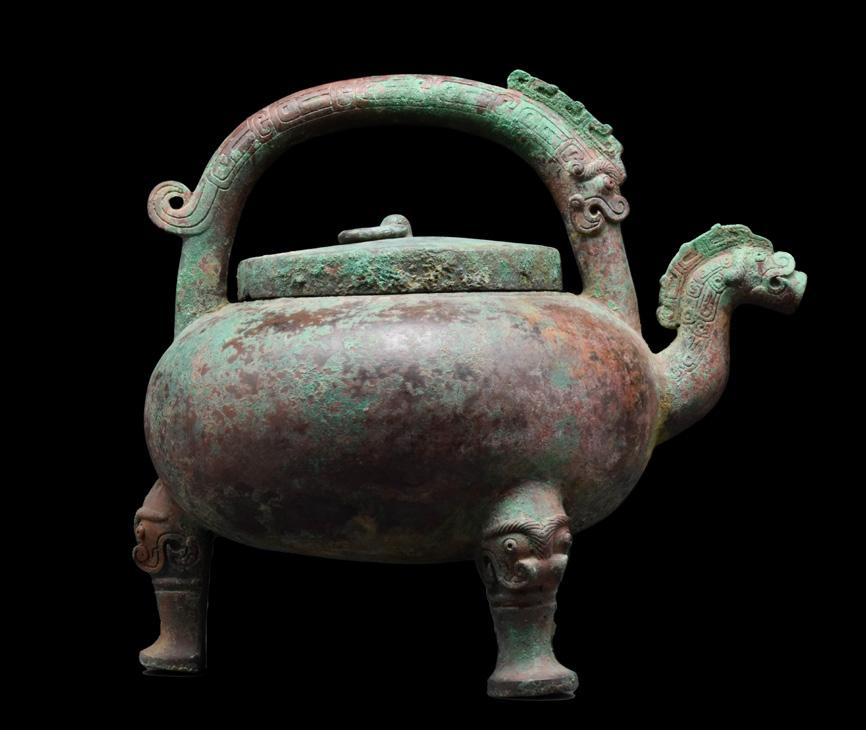
380. ARCHAIC BRONZE RITUAL WINE VESSEL (JUE)

Late Shang Dynasty, circa 11th Century BC
Starting price: £2,000
This rare and unique vessel contains a U-shaped body rising from three splayed triangular blade tripod legs to a pointed rim opposite a guttered spout flanked by a pair of posts capped with conical finials, the exterior with finely modelled taotie masks bulging eyes, The design typically consists of a zoomorphic mask, divided by three crenelated vertical flanges, one side set with a lop handle issuing from bovine mask, the surface with malachite encrustation. Ritual wine vessels of this shape (jue) are the earliest surviving form of bronzes in ancient China. They functioned as cups for drinking fermented-millet beverages in rituals to the ancestors. Such vessels from the early Erligang period are thinly cast. For similar see: Wang Tao and Liu Yu, A Selection of Early Chinese Bronzes with Inscriptions from Sotheby’s and Christie’s Sales, Shanghai, 2007, pl. 250. This item shows signs of restoration. Size: L:185mm / W:175mm; 865g.
Provenance: Private collection of a London doctor; formerly in a Somerset Estate collection; acquired from Hong Kong galleries in the early 1990s.
381.
Ca. 300 BC
Starting price: £900
A flat stone offering table with one edge ending in a bovine head with its head down. Through the upper face of the altar and the bull’s head, runs a lengthways channel for pouring libation. For a similar example, see The British Museum, Museum number 141580. Size: L:75mm / W:385mm ; 11.92kg.

Provenance: From the collection of a London gentleman; formerly acquired in early 2000s in France; previously in 1970s European collection.
382. SOUTH ARABIAN ALABASTER FACE STELE Ca. 300 BC
Starting price: £300
An alabaster funerary stele sculpted in high relief with a male head with eyes, recessed for inlays, prominent eyebrows merging into a long triangular nose, and a small, pursed mouth. For a similar example, see The British Museum, Registration number 1985,0223.34. Size: L:190mm / W:150mm ; 5.41kg.
Provenance: Private collection of a West London gentleman; previously in a collection formed on the UK/International art market in the 1980s.

383.
Central Asia, Ca. 2nd millennium BC
Starting price: £200
A pottery female figure seated upon a flare-base seat, playing a stringed musical instrument, held on her left thigh, with left hand. Simple facial applique detail, and her ample breasts are adorned with fine, layered necklaces. Right hand missing, loss to left wrist, repaired break at waist and reattached to seat. Interesting subject matter. Size: L:120mm / W:45mm ; 85g.
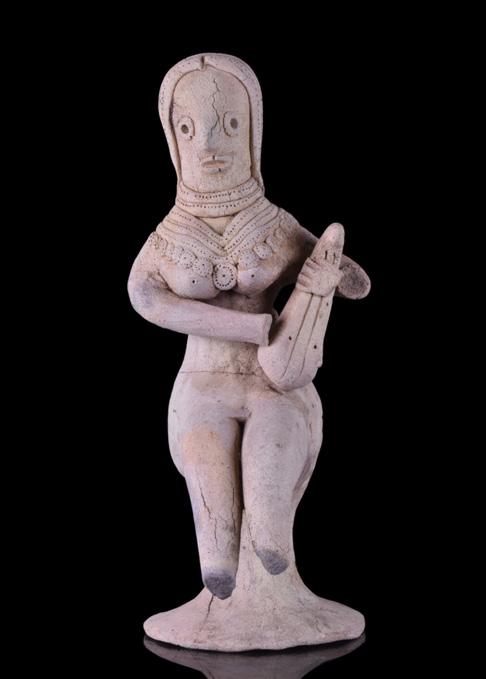
Provenance: Ex. Arte Primitivo, auct. 66, lot # 116, ex. Rosen Antiques, NYC., Private NYC collection, acquired about 1980.
384.
MASK Ca. 3500 BC
Starting price: £300
A pottery grotesque head with a prominent nose and grimacing mouth, depicting Humbaba. In Sumerian and Akkadian mythology, Humbaba was a giant and guardian of the Cedar Forest in the “Land of the Living”. He appears in several Sumerian myths, such as the Epic of Gilgamesh. Size: L:80mm / W:75mm; 155g.
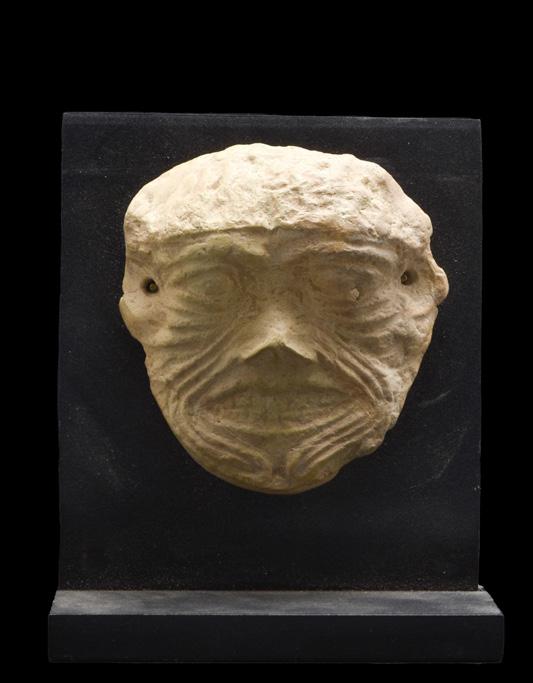
Provenance: Property of London gallery; acquired on the US art market.
385. WESTERN ASIATIC STONE EYED IDOL Ca. 3700-3500 BC
Starting price: £1,500
An attractive grey-coloured stone Tell Brak Eye Idol consisting of a bell-shaped body, supporting two drilled circular eyes. Idols of this kind are common in Sumer, the earliest known civilization in Western Asia. Wide eyes are symbolic of piety to the gods in much of Mesopotamian art. Excellent condition. For a similar example, see Christie’s, Live Auction 9380, Antiquities, 13 June 2000, Lot 433. Size: L:73mm / W:40mm; 106.26g.

Provenance: Private London collection; formerly in the 1970s European collection.
386. WESTERN ASIATIC STONE EYED IDOL Ca. 3700-3500 BC
Starting price: £1,500
A rare alabaster Tell Brak Eye Idol consisting of a flat trapezoidal body, recessed at the top for the neck and surmounted by two engraved almond shaped eyes and eyebrows. The Eye Temple at Tell Brak, where thousands of similar stone figurines were uncovered dates back to the IV millenium BC. The true meaning and function of these mysterious artifacts remains unknown. For a similar example, see The Metropolitan Museum of Art, Accession Number: 51.59.10. Size: L:78mm / W:43mm; 53.13g.
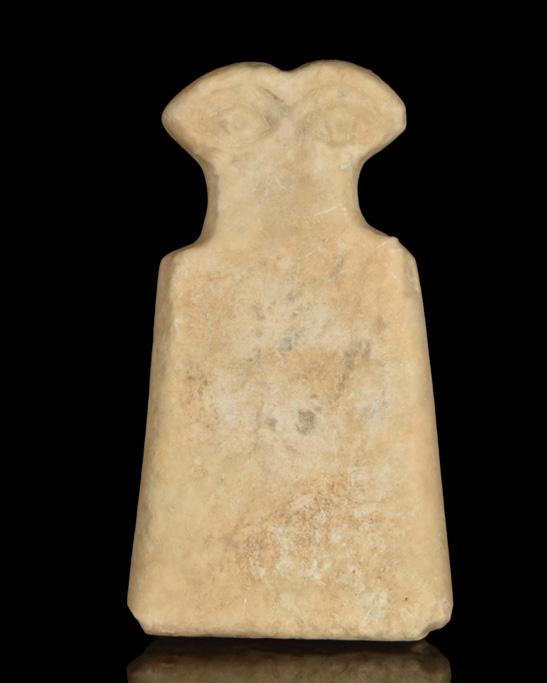
Provenance: Private London collection; formerly in the 1970s European collection.
387. ANCIENT BRONZE URARTU BELT Ca. 1000–650 AD
Starting price: £2,500
Western Asiatic, Urartu. A rare, intact bronze belt made of a wide lateral bronze band embellished with geometric, floral decoration as well as depictions of animals all over. The borders are decorated with circles. These wide bands are joined by a thin band of bronze at the back and a closure at the front fashioned in the shape of two interlaced snakeheads with incised decoration. For more information on ancient belts, see Moorey, P. R. S. (1967). Some Ancient Metal Belts. Their Antecedents and Relatives. Iran 5, pp. 83ff. & Calmeyer, P. in Reallexikon der Assyriologie III, 1957-71, pp. 689-93. Size: L:385mm / W:98mm; 380g.
Provenance: Ex-Davis collection, Houston, Texas, acquired before 2013 from various auction houses in London and New York. Exhibited: Olympia Art & Antiques fair, London June 2022.
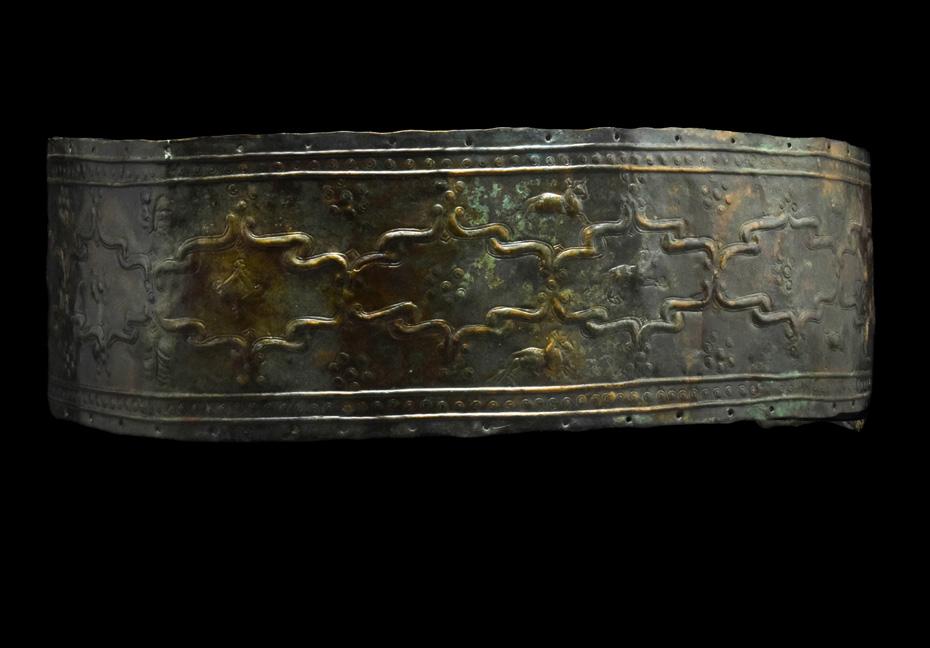
388. WESTERN ASIATIC DECORATED SHIELD UMBO SHIELD Ca. 1600-800 BC. Starting price: £200
A bronze shield boss also known as an umbo, of a circular form, with a raised and pierced domed centre and a broad flat flange nicely decorated with repoussé technique. Size: L:130mm / W:130mm; 50g.


Provenance: Property of a London gallery; formerly acquired on the US art market.
389. WESTERN ASIATIC DECORATED SHIELD UMBO SHIELD Ca. 1600-800 BC. Starting price: £200
A circular shield boss (umbo) with a raised central section pierced for attachment. The surrounding flange is decorated with a repoussé pattern. Size: L:130mm / W:130mm ; 50g.
Provenance: Property of a London gallery; formerly acquired on the US art market.
390. SASANIAN DECORATED SILVER BOWL Ca. 224–651 AD. Starting price: £300
A hemispherical bowl hammered from one sheet. The interior is decorated with a medallion showing a gilded animal surrounded by a circle of geometric motifs. For more information, please see Harper, Prudence Oliver and Meyers, Pieter (1981). Size: L:46mm / W:125mm ; 89g.

Provenance: Acquiried from M.A.; Previously in a collection formed on the UK/International art market since the 1970s.
391. PSEUDO TRANS JORDAN POTTERY AMPHORA Ca. 3100-2900 BC. Starting price: £100

A Holy Land storage vessel with a spherical body and two ledge handles. The vessel has a wide, slightly out-turned mouth, decorated below with a band of prick dots. Two prominent ledge handles, gently crimped appearance to the edges, are situated at the waist. Standing on a flat base. For similar see: Cf. Ruth Amiran, Ancient Pottery of the Holy Land. Size: L:149mm / W:135mm ; 390g.
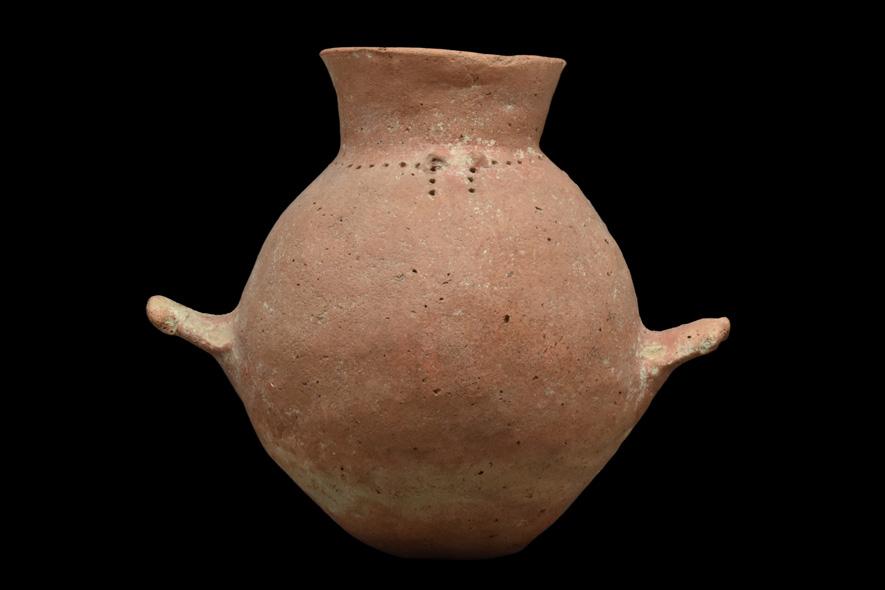
Provenance: Ex High Wycome Estate Collection, Ex German Gallery, Ex Private gallery Mist H.S from Den Bosch Collected between 1969 - 1990.
392. PSEUDO TRANS JORDAN POTTERY AMPHORA Ca. 3100-2900 BC.
Starting price: £100
A Holy Land storage vessel with a spherical body and two ledge handles. The vessel has a wide, slightly out-turned mouth, decorated below with a band of prick-dots. Two prominent ledge handles, gently crimped appearance to the edges, are situated at the waist. Standing on a flat base. Size: L:223mm / W:250mm ; 1.4Kg.
Provenance: Ex High Wycombe Estate Collection, Ex London Gallery, Ex Important London collection acquired in the 1970s.
393. HOLY LAND EARLY BRONZE AGE AMPHORA WITH NODULES

Ca. 3100-2900 BC.
Starting price: £100
A storage vessel formed of a light terracotta with a spherically shaped body and seven protruding nodules for decoration. The vessel has a wide, slightly out-turned mouth. Standing on a flat base. Cf. Ruth Amiran, Pottery of the Holy Lands. Der Konigs Weg; 9000 Jahre Kunst und Kultur, Koln 1987. Size: L:220mm / W:180mm ; 2.1Kg.
Provenance: Ex High Wycombe Estate Collection, Ex Dr Bron Lipkin, From Large Swiss Collection.
394. SYRO-HITTITE POTTERY BEAKER
Ca. 2nd millennium BC.
Starting price: £100
A pottery beaker with globular-shaped body with four individual protruding faces with stylised round applied eyes and open mouths, the long neck everting into a concave rim, standing on a pedestal foot. Size: L:125mm / W:110mm ; 310g.
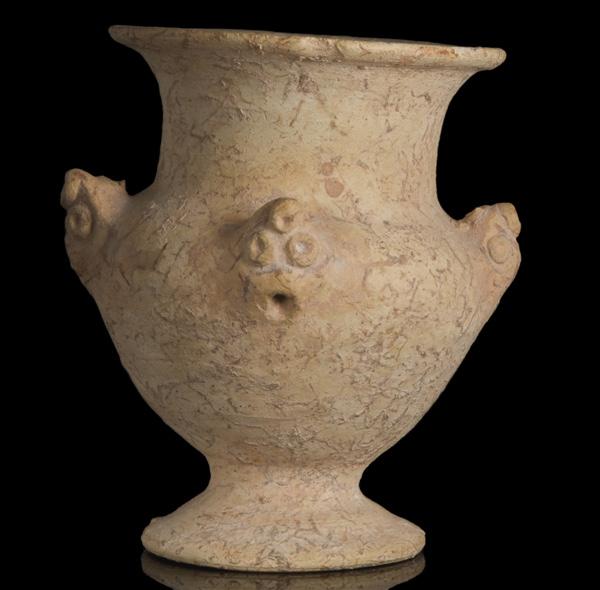
Provenance: Ancient Art Gallery in London, Ex High Wycombe Estate Collection acquiredd in 1990’s Ex Cambridgeshire Gallery.
395.
Middle Bronze Age, Ca. 1950-1730 BC.
Starting price: £100
A fine example of a coil-made red burnished pottery jug with globular, almost amphora-like body, with a trefoil spout and strap handle. For a similar see Ruth Amiran: Ancient Pottery of the Holy Land from its beginnings in the Neolithic period to the end of the Iron Age. Size: L:270mm / W:140mm ; 1kg.


Provenance: Property of a London gallery; formely in High Wycombe Estate collection; formerly acquired on the UK Art market.
396. AMLASH POTTERY SPOUTED JAR
Ca. 1st millennium BC.
Starting price: £100
A pottery jar with bulbous shaped body and long protruding spout with applied loop underneath. The body with a long extending neck which tapers to a slight angle with rounded rim and an applied strap handle which connects the neck to the base. Standing on three nodule legs. Size: L:195mm / W:126mm ; 365g.
Provenance: London Ancient Art gallery, Ex High Wycombe Estate Collection from 1990, Ex French Gallery.
397.
Middle Bronze Age IIA, Ca. 2000-1730 BC.
Starting price: £100
A burnished cream slip pottery jug with a piriform body and button-shaped base. The surface is decorated with a series of brown-painted concentric circles and horizontal bands. Size: L:135mm / W:86mm ; 220g.
Provenance: London Art Market, Ex High Wycombe Estate collection 2000, Ex Mr David Giles Collection.
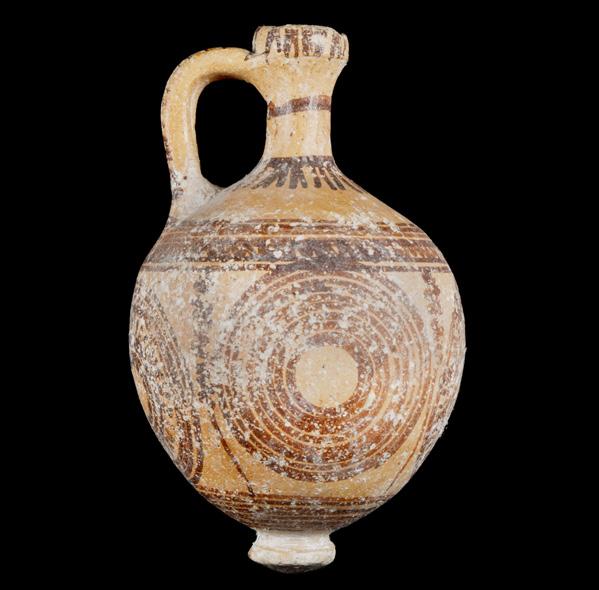
398. BRONZE AGE HOLY LANDS TERRACOTTA BOWL
Ca. 1600-1400 BC.
Starting price: £200
A nicely modelled terracotta bowl, featuring smooth sloping sides and finger-pinched decoration. The thin walls of the bowl flare upwards into a wide mouth with a slightly everted rim. The bowl sits on a circular, flattened base. For similar examples of Holy Land pottery, cf. Ruth Amiran, Ancient Pottery of the Holy Lands. Size: L:380mm / W:185mm ; 2.64kg.


Provenance: From an old British collection, acquired on the UK art market in the 1980s.
399. HOLY LAND CREAM BUFF BOWL
Middle Bronze IIB-C, Ca. 1730-1550 BC. Starting price: £100
A finely sculpted, pottery bowl in cream buff with a carinated shoulder from which the walls of the body taper into a neck with sloping sides. Standing on a ring foot. For a similar see Ruth Amiran, Ancient Pottery of the Holy Lands, plate 27. Size: L:152mm / W:245mm ; 1Kg.
Provenance: Ex High Wycombe Estate Collection, Ex Wiltshire Gallery, Ex J.Birkin, London UK.
400. INDUS VALLEY TERRACOTTA VESSEL WITH IBEXES Ca. 3000-2500 BC Starting price: £100
A fine example of a monochrome Indus Valley civilization pot with a bulbous body rising from an undecorated conical-shaped base. The exterior’s decoration consists of a black-painted register of running ibexes, surrounded by geometric motifs. The Indus Civilization: a Contemporary Perspective. Walnut Creek, CA: AltaMira Press. Size: L:170mm / W:195mm ; 1.03kg.



Provenance: Property of a London gallery; formely in High Wycombe Estate collection; formerly acquired on the UK Art market.
401. INDUS VALLEY TERRACOTTA VESSEL WITH LEAVES
Ca. 3000 BC Starting price: £100
A nice example of a squat bowl with a biconvex body on a ring base and a short, raised rim. The upper part of the body is decorated with five polychrome peepal leaves. They are separated by stylised geometric motifs and framed by a simple upper and lower linear border. Cf. N. Satyawadi, 1994. Proto-Historic Pottery of the Indus Valley Civilisation: Study of Painted Motifs, New Delhi. Size: L:60mm / W:170mm ; 415g.
Provenance: Property of a London gallery; formely in High Wycombe Estate collection; formerly acquired on the UK Art market.
402. INDUS VALLEY TERRACOTTA POLYCHROME VESSEL
Ca. 3000 BC
Starting price: £100
A terracotta bowl or vessel, comprising a biconvex body resting on a ring foot. The upper portion of the buff coloured vessel is decorated with polychrome abstract motifs. The lower section is undecorated. The Indus Valley Civilisation was an important Bronze Age culture which arose in ca. 3300 BC and lasted until ca. 1300, though its heyday, to which this ceramic vessel belongs, was in the 3rd Millennium BC. Size: L:135mm / W:210mm ; 865g.
Provenance: Property of a London gallery; formely in High Wycombe Estate collection; formerly acquired on the UK Art market.
Iron Age II, C.a 1050-800 BC
Starting price: £100
With a globular round body, a ring base, a carinated shoulder, a rounded rim and a basket handle. A tubular spout emerges from the body of the pitcher. It is made of burnished grey clay. The body of the pitcher was likely made in two separate pieces on a wheel, with the spout and handle added later. Cf. Muscarella, Oscar W. 1974. “The Iron Age at Dinkha Tepe, Iran.” Metropolitan Museum Journal 9, pp. 61-62. Size: L:154mm / W:180mm ; 515g.
Provenance: Property of a London gallery; formely in High Wycombe Estate collection; formerly acquired on the UK Art market.
404.

Ca. 3000- BC
Starting price: £200
A bowl of globular shaped proportion; the base sloping to a narrow ring foot decorated with an incised line of decoration. The bowl is thick walled with a sloping rim. This bowl has a nice polished surface which provides a shinning appearance. Size: L:200mm / W:95mm ; 280g.
Provenance: Ancient Art Gallery in London, Ex High Wycombe Estate Collection acquiredd in 1990’s.
405.
Ca. 3rd Millennium BC
Starting price: £200
A Holy Land jug set on a low ring foot with a squat, globular body and a long vertical handle that begins at the widest part of the body and ends on the wide neck just below the everted rim. This is a very common thick-walled jug-form used to store oils. During this period pottery finishing techniques improved: potters used a remarkable amount of red slip, applied by hand, and smoothed with an irregular burnish. Size: L:104mm / W:110mm ; 205g.

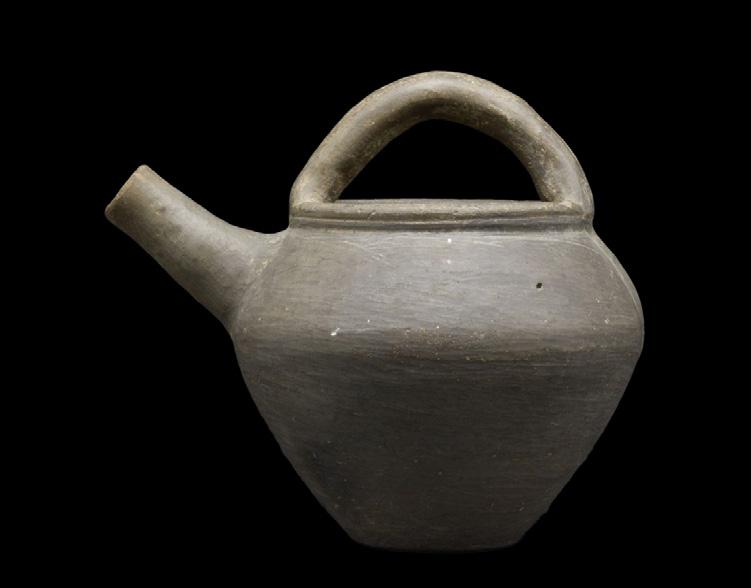
Provenance: Ancient Art Gallery in London, Ex High Wycombe Estate Collection acquiredd in 1990’s.
406.
Ca. 600-800 AD
Starting price: £180
A Judeo-Aramaic terracotta bowl of a flaring body densely inscribed with lines of incantations against evil spirits. Bowls like this example were traditionally buried face down under houses to catch demons and thus protect the house; they are also known as incantation bowls or demon bowls. For a similar see the British Museum, Registration Number 1957,0925.1. Size: L:135mm / W:210mm ; 865g.
Provenance: Property of a London gallery; formely in High Wycombe Estate collection; formerly acquired on the UK Art market.
Ca. 600-800 AD
Starting price: £180
A Judeo-Aramaic “devil trap” terracotta bowl with black lines of inscription spiraling around the interior. Bowls like this example were traditionally buried face down under houses to catch demons and thus protect the house; they are also known as incantation bowls or demon bowls. Size: L:70mm / W:170mm ; 340g.

Provenance: From the collection of a London gentleman; formerly acquired in early 2000s in France; previously in 1970s European collection.
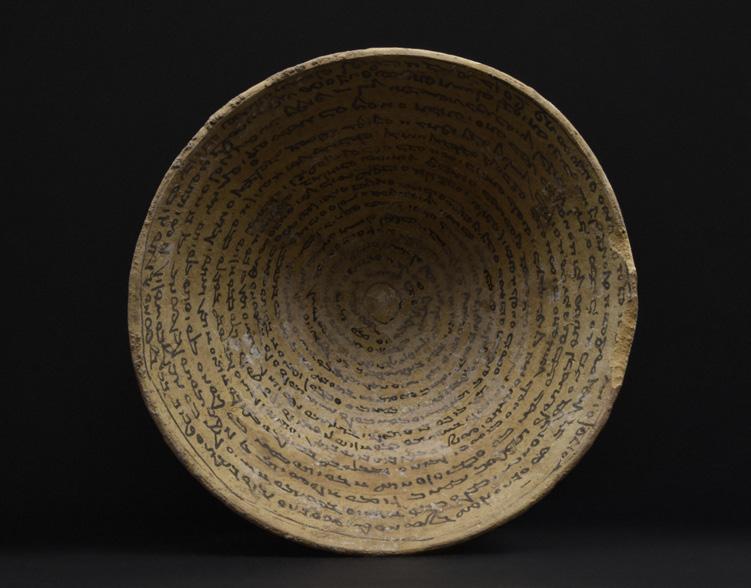
408. ARAMAIC POTTERY INCANTATION DEVIL TRAP BOWL Ca. 600-800 AD
Starting price: £180
A Judeo-Aramaic terracotta bowl of a flaring body densely inscribed with lines of incantations against evil spirits. It is written in black ink spiraling around the interior. Bowls like this example were traditionally buried face down under houses to catch demons and thus protect the house; they are also known as incantation bowls or demon bowls. For a similar see the British Museum, Registration Number 1957,0925.1. Size: L:70mm / W:170mm ; 270g.
Provenance: From the collection of a London gentleman; formerly acquired in early 2000s in France; previously in 1970s European collection.
409. ARAMAIC POTTERY INCANTATION DEVIL TRAP BOWL Ca. 600-800 AD
Starting price: £180
A Judeo-Aramaic “devil trap” terracotta bowl with black lines of inscription spiraling around the interior. Bowls like this example were traditionally buried face down under houses to catch demons and thus protect the house; they are also known as incantation bowls or demon bowls. Size: L:80mm / W:165mm ; 325g.
Provenance: From the collection of a London gentleman; formerly acquired in early 2000s in France; previously in 1970s European collection.
410. ARAMAIC POTTERY INCANTATION DEVIL TRAP BOWL Ca. 600-800 AD
Starting price: £180
A Judeo-Aramaic terracotta bowl of a flaring body densely inscribed with lines of incantations against evil spirits. It is written in black ink spiraling around the interior. Bowls like this example were traditionally buried face down under houses to catch demons and thus protect the house; they are also known as incantation bowls or demon bowls. For a similar see the British Museum, Registration Number 1957,0925.1. Size: L:65mm / W:165mm ; 280g.
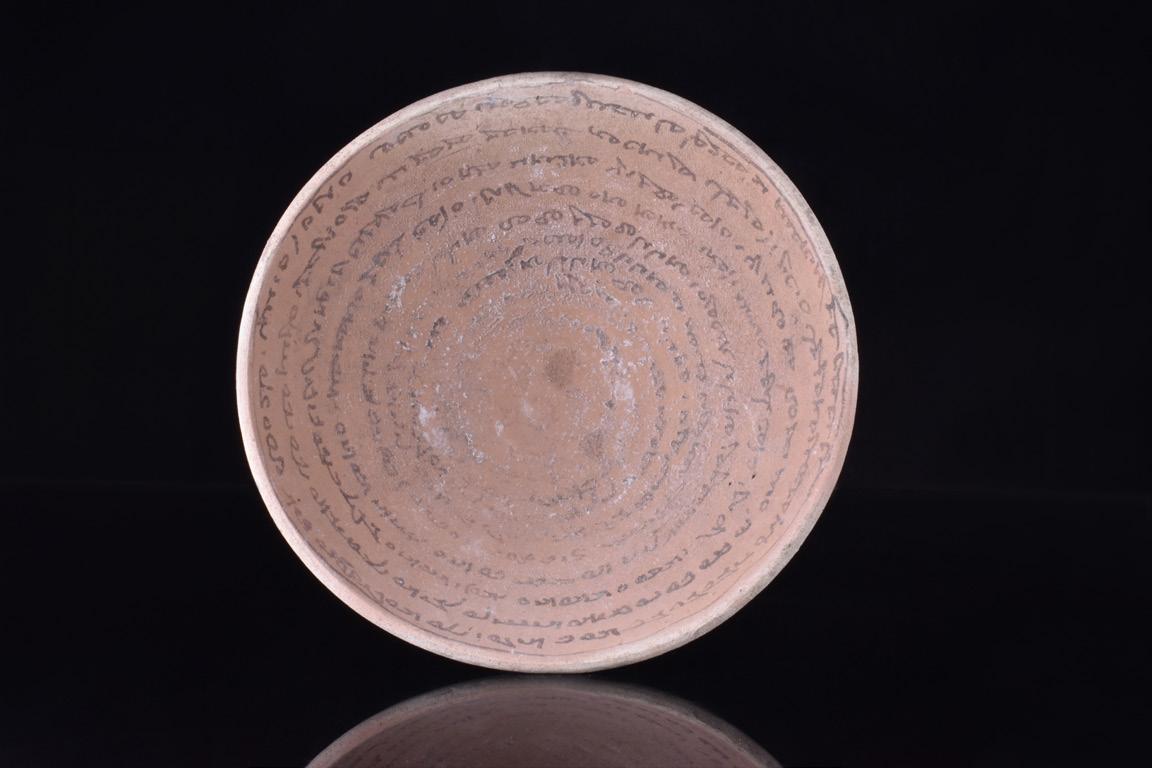
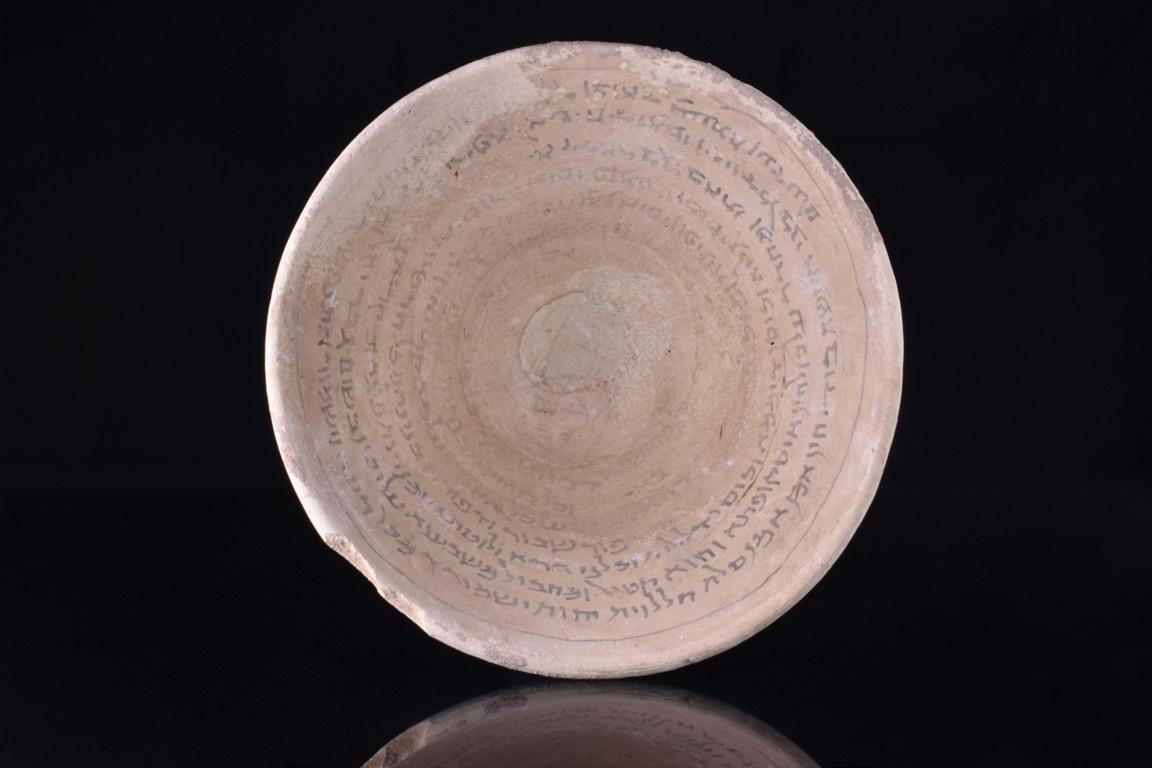
Provenance: From the collection of a London gentleman; formerly acquired in early 2000s in France; previously in 1970s European collection.

411. NEO-SUMERIAN INSCRIBED BRICK OF UR-NAMMU, KING OF UR Ca. 2112-2095 BC
Starting price: £1,800
A nearly rectangular in shape brick fragment, inscribed with a central square of four columns of cuneiform text, “Ur-Nammu, king of Ur, who built the temple of Nanna”. Ur-Nammu was a Sumerian king from 2112 to 2095 BC. He founded the III Dynasty of Ur and was the founder of the temple of Nanna, the Mesopotamian god of the moon and wisdom.

Size: L:100mm / W:400mm ; 11.4kg.
Provenance: Property of a North London gentleman; previously acquired on the UK/European art market in the 1970s.
3100-2900 BC
Starting price: £1,800
A pictographic tablet, rectangular in form, with lines of proto-cuneiform written in columns, recording the administrative account with entries of food supplies. For a similar example, see The Metropolitan Museum of Art: 1988.433.3. Size: L:80mm / W:70mm ; 110g.


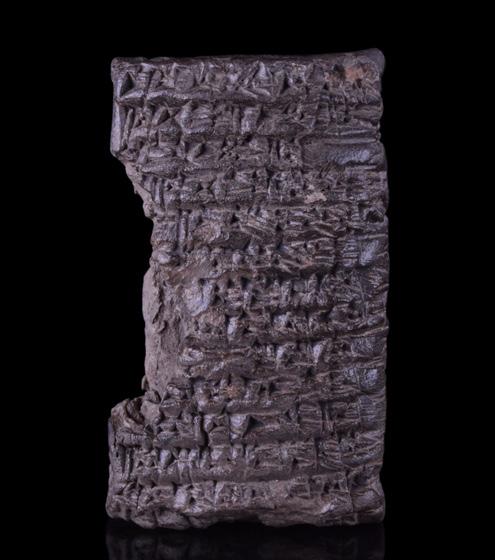


Provenance: Property of a North London gentleman; previously acquired on the UK/European art market in the 1970s.
Ca. 560 BC
Starting price: £900
A terracotta temple foundation brick of Babylonian King Nebuchadnezzar II, rectangular with thirteen columns of cuneiform text mentioning the foundation of a temple by Nebuchadnezzar II. For similar examples, see Christie’s Sale 5951, Antiquities Including the Plesch Collection of Ancient Glass, 28 April 2009, London, South Kensington; also The British Museum. Size: L:205mm / W:130mm ; 750g.
Provenance: Acquired in 2003 in Paris from A. Kotlar, in his collection since the 1970s; formerly in a French collection since the 1950s.
Starting price: £400
A rectangular clay tablet with columns of cuneiform text. Clay cuneiform tablets were small enough to be portable and durable when dried, also allowed for the transmission of information across time and space. Size: L:100mm / W:135mm ; 425g.
Provenance: Property of London gallery; formerly in a private collection L. H., Staffordshire; previously in a private collection since 1980s.
415. BABYLONIAN CLAY CUNEIFORM TABLET Ca. 1900 BC
Starting price: £200
A rectangular-shaped clay tablet, written in cuneiform. The inscriptions on the tablet refer to administrative and legal affairs. Cuneiform script is one of the oldest types of writing, originated in the Middle East around 3500 BC. Size: L:70mm / W:40mm ; 90g.
Provenance: Property of a North London gentleman; previously acquired on the UK/European art market in the 1970s.
416.
1900-1600 BC
Starting price: £200
A rectangular tablet made of clay would have been inscribed either with a tax register or a name list. Clay cuneiform tablets were small enough to be portable and durable when dried. Size: L:95mm / W:70mm ; 260g.

Provenance: Property of a North London gentleman; previously acquired on the UK/European art market in the 1970s.
417. BABYLONIAN CLAY CUNEIFORM TABLET Ca. 1900 BC
Starting price: £200
A clay cuneiform tablet in a light brown fabric with a written script on both sides. Cuneiform (from cuneus, Latin for “wedge”) writing, which derives its name from the distinctive shape of its letters. Size: L:90mm / W:62mm ; 195g.
Provenance: Property of a North London gentleman; previously acquired on the UK/European art market in the 1970s.
418.
1900-1600 BC
Starting price: £200
A rectangular-shaped clay tablet, written in cuneiform. The inscriptions on the tablet refer to administrative and legal affairs. Cuneiform script is one of the oldest types of writing, originated in the Middle East around 3500 BC. Size: L:55mm / W:40mm ; 60g.
Provenance: Property of a North London gentleman; previously acquired on the UK/European art market in the 1970s.
 BABYLONIAN CLAY CUNEIFORM TABLET Ca.
BABYLONIAN CLAY CUNEIFORM TABLET Ca.
BABYLONIAN CLAY CUNEIFORM TABLET Ca.
BABYLONIAN CLAY CUNEIFORM TABLET Ca.
419.
1900 BC
Starting price: £200
A clay cuneiform tablet in a light brown fabric with a written script on both sides. Cuneiform (from cuneus, Latin for “wedge”) writing, which derives its name from the distinctive shape of its letters, is one of the earliest forms of writing and developed in ancient Mesopotamia in the 4th millennium BC. Size: L:50mm / W:42mm ; 45g
Provenance: Property of a North London gentleman; previously acquired on the UK/European art market in the 1970s.
420. BABYLONIAN CLAY CU-

Ca. 1900-1800 BC
Starting price: £200
A roughly rectangular-section ceramic tablet, bearing cuneiform script to both faces. Documents such as they were used or a multitude of things including administrative and accountancy. Size: L:85mm / W:50mm ; 145g
Provenance: Property of a North London gentleman; previously acquired on the UK/European art market in the 1970s.
Western Asiatic, Ca. 1200-700 BC
Starting price: £500
An attractive ceremonial axe head with flared blade and wide, cylindrical shaft tube. On the back, a solid bronze animal climbs the poll of the axe. The diligently worked-out muscular body is fixed on the shaft. Bronze weaponry production flourished from the 2nd millennium BC to about 700 BC when it was gradually replaced by iron. Swords, mace heads, spears, and arrows were exchanged via trade and war and are discovered in both civic and ritual contexts. Size: L:145mm / W:100mm ; 650g.

Provenance: Property of a North London gentleman; previously acquired on the UK/European art market in the 1970s.
424.
Ca. 1500-1000 BC
Starting price: £500
421.

Starting price: £200
A rectangular tablet made of clay, inscribed either with a tax register or a name list. Clay cuneiform tablets were small enough to be portable and durable when dried and also allowed for the transmission of information across time and space. Size: L:70mm / W:40mm ; 70g
Provenance: Property of a North London gentleman; previously acquired on the UK/European art market in the 1970s.
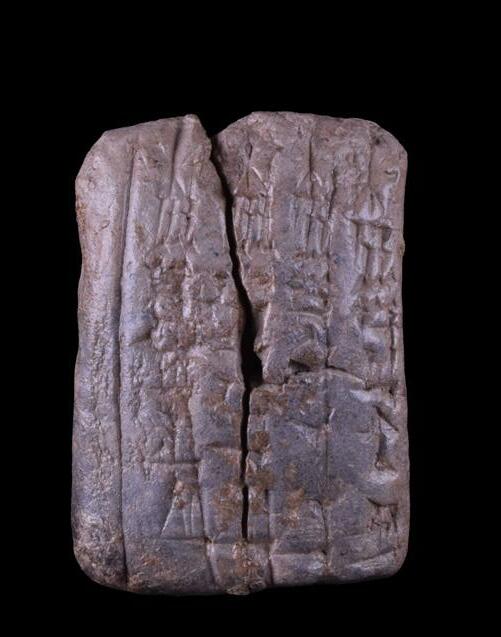
Starting price: £200
A rectangular-section ceramic tablet, bearing cuneiform script. Documents such as they were used or a multitude of things including administrative and accountancy. Size: L:60mm / W:42mm ; 60g
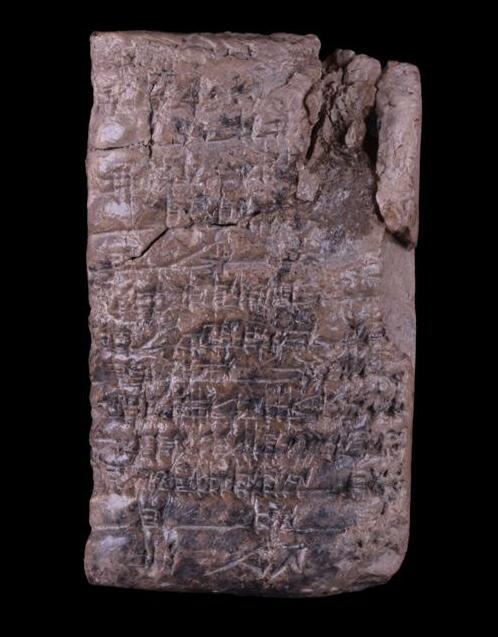
Provenance: Property of a North London gentleman; previously acquired on the UK/European art market in the 1970s.
A bronze axe head featuring a curved blade with a tapering cheek, and a pick end with four spikes. An axe such as this one would have been an important symbol of rank, and have served a purpose in warfare, but also in religious contexts as axes were common votive offerings in shrines. Size: L:190mm / W:60mm ; 355g.

Provenance: Property of a West London gentleman; previously in a collection formed on the UK/International art market in the 1980s.
425. BRONZE AGE BRONZE ADZE AXE Ca. 2000-700 BC
Starting price: £200
A double axe-head cast in bronze. The weapon features a short cylindrical shaft hole with two horizontal bands, a flattened top with a vertical crescent-shaped blade with sides that broaden out towards the cutting edge and a smaller horizontal blade to the back. Beautiful green patination covers the surface. Size: L:200mm / W:100mm ; 1.86kg.
Provenance: Property of a West London gentleman; previously in a collection formed on the UK/International art market in the 1980s.

426. BRONZE AGE BRONZE AXE HEAD
Ca. 1500-1000 BC
Starting price: £200
A cast bronze war axe head featuring a cylindrical shaft and a flattened blade, drawn out from the top of the shaft, broadens out towards the cutting edge which is slightly convex. Beautiful green and olive patination covers the surface of the weapon. Size: L:180mm / W:95mm ; 820g.

Provenance: Property of a West London gentleman; previously in a collection formed on the UK/ International art market in the 1980s.
427. BRONZE AGE BRONZE ADZE
Ca. 2000-700 BC
Starting price: £200
A bronze axe head with a curved blade, tapering cheek, and a wedge-shaped adze to the rear. The shaft long and cylindrical. Size: L:245mm / W:90mm ; 1.64kg.

Provenance: Property of a West London gentleman; previously in a collection formed on the UK/ International art market in the 1980s.
428.
Ca. 3rd millennium BC
Starting price: £200
A cast bronze mace head/cudgel of a tubular shape. The upper part is decorated with 9 rows of raised chevrons, separated by a series of vertically orientated bands and framed above and below by three raised bands. A mace head such as this one would have been an important symbol of rank, and have served a purpose in warfare, but also in religious contexts as mace heads were common votive offerings in shrines. Reference: O. W. Muscarella, Bronze and Iron. Ancient Near Eastern Artifacts in The Metropolitan Museum of Art, New York, 1988, item 516, p. 391. Size: L:235mm / W:30mm ; 460g.
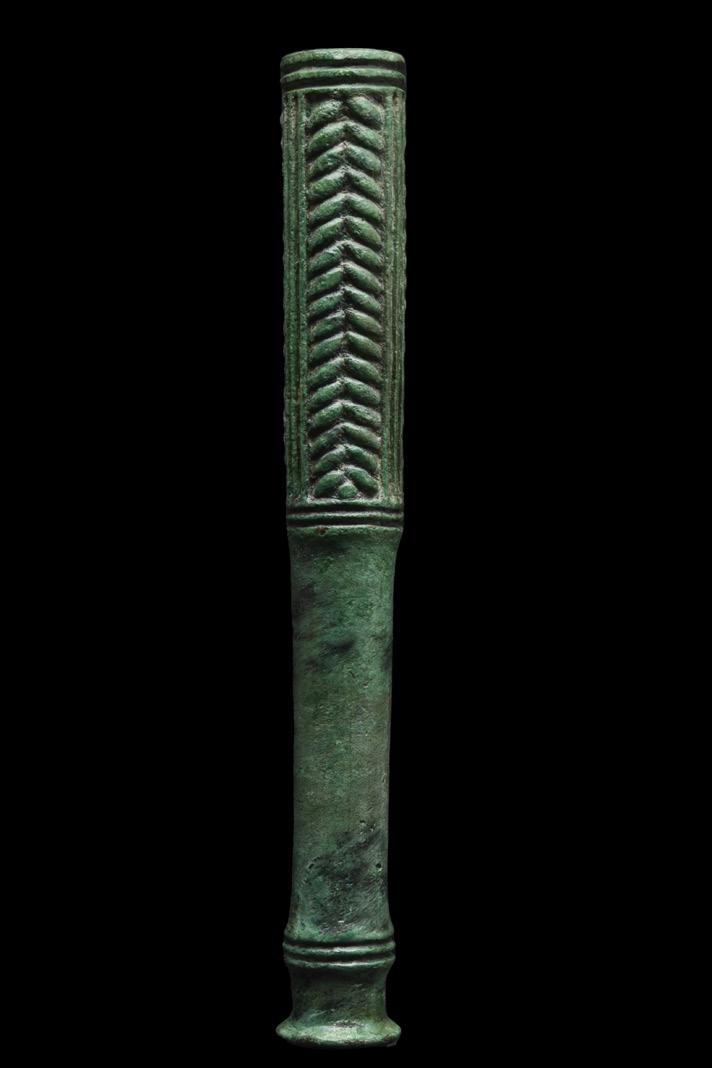

Provenance: From the collection of a London gentleman; formerly acquired in early 2000s in France; previously in 1970s European collection.
Ca. 3rd millennium BC
Starting price: £200
A fine example of a cast bronze mace head with a cylindrical body, probably placed around a wooden or less decorated metal staff. The upper half is decorated with panels of seventeen raised chevrons. The lower half is plain and the shaft hole is collared. Reference: O. W. Muscarella, Bronze and Iron. Ancient Near Eastern Artifacts in The Metropolitan Museum of Art, New York, 1988, item 516, p. 391. Size: L:240mm / W:30mm ; 520g.
Provenance: From the collection of a London gentleman; formerly acquired in early 2000s in France; previously in 1970s European collection.
Ca. 3rd millennium BC
Starting price: £200
A cast bronze mace head/cudgel of a tubular shape. The upper part is decorated with panels of 13 rows of raised chevrons, separated by a series of vertically orientated bands and framed above and below by three raised bands. A mace head such as this one would have been an important symbol of rank, and have served a purpose in warfare, but also in religious contexts as mace heads were common votive offerings in shrines. Reference: O. W. Muscarella, Bronze and Iron. Ancient Near Eastern Artifacts in The Metropolitan Museum of Art, New York, 1988, item 516, p. 391. Size: L:220mm / W:30mm ; 430g.

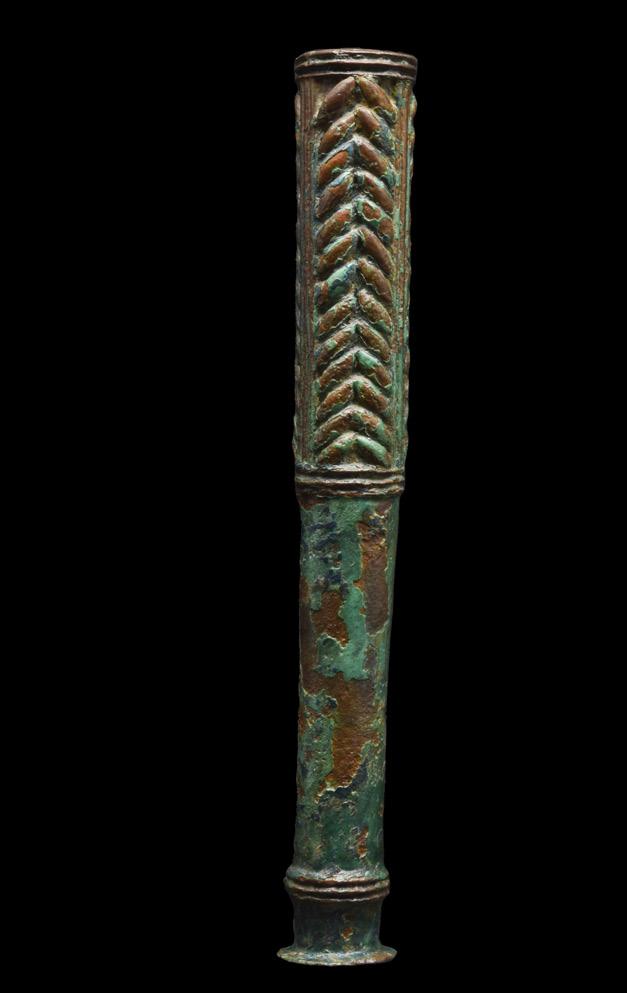
Provenance: From the collection of a London gentleman; formerly acquired in early 2000s in France; previously in 1970s European collection.
Qing Dynasty, Ca. 1644-1912 AD
Starting price: £500
Stunning upright Chinese scholar stones (also known as Gong Shi, meditation stone and spirit rock) of significant mass and volume is gracefully balanced on the wood display stand. The dark stone, with the pronounced white veins and wrinkled surface texture. Selected by human, this stone features an extraordinary vertical mushroom form with a sky window on the top part. For a similar see The Metropolitan Museum. 2009.512.1a.b Size: L:720mm / W:750mm; 30+kg.
Provenance: From the private collection of a Somerset gentleman; previously in an old British collection, formed in the 1980s on the UK / European art markets.
432. A LIMESTONE STANDING BUDDHA SCULPTURE
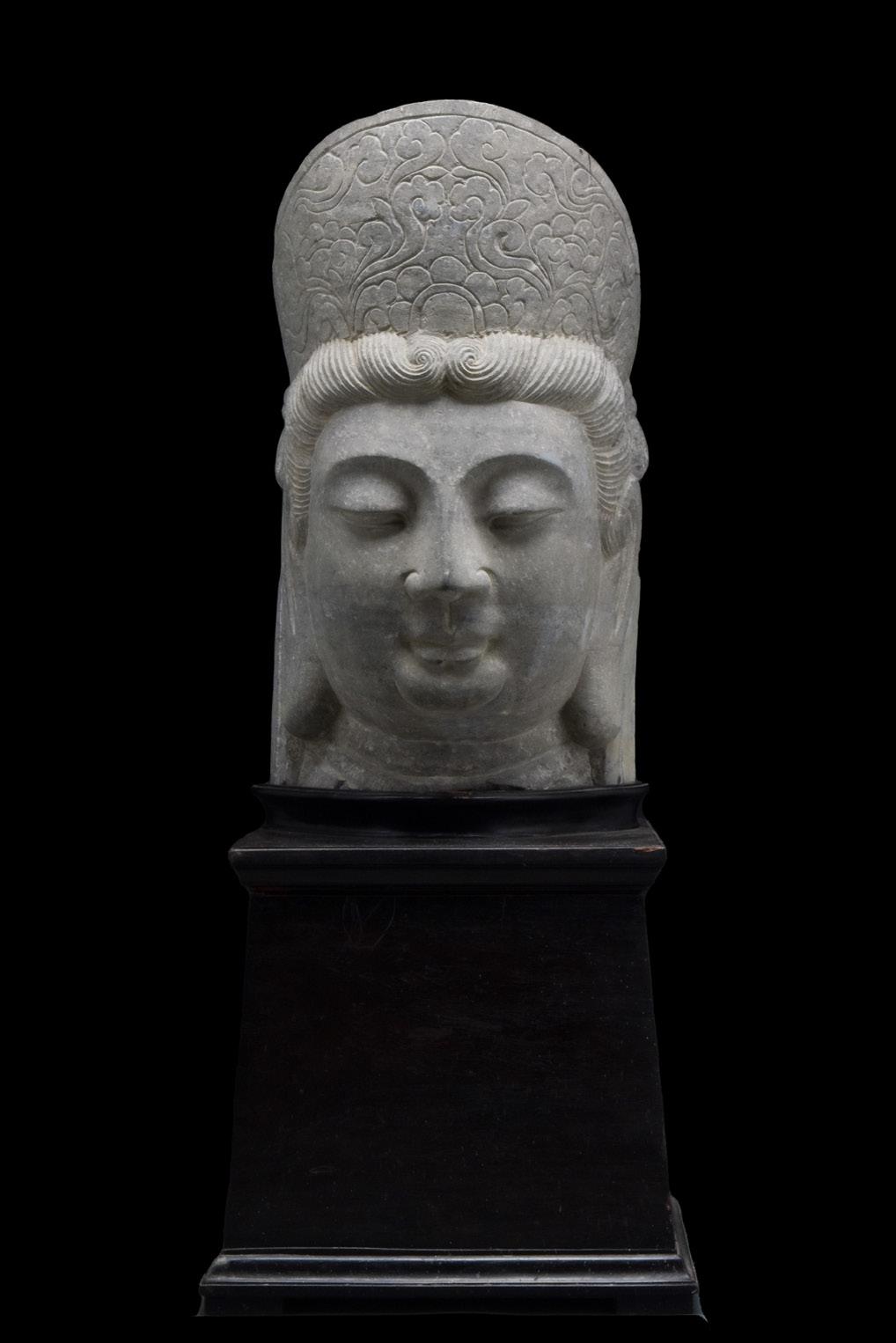
Northern Qi Dynasty, Ca. 550-577 AD (or later)
Starting price: £3,000
The slender, elegant figure is depicted in a standing pose, originally on top of a socle, with right hand raised in abhaya mudra, and the left hand lowered as it holds the edge of his diaphanous, layered robes that cling to the contours of the body as they fall to just above the ankles, the graceful folds indicated by single or double carved lines. The face is carved with a serene expression, and the hair is dressed in whorl-like curls that also cover the domed ushnisha. A halo adorned his shoulders with stylised lotus petals surround the head. For similar see: H. Munsterberg, Sculpture of the Orient, New York, 1972, pl. 83. Size: L:1110mm / W:260mm ; 30+kg.
Provenance: From the private collection of a Somerset gentleman; previously in an old British collection, formed in the 1980s on the UK /European art markets.
433. A SCHIST HEAD OF CROWNED GUANYIN

Liao Dynasty, Ca. 907-1125 BC (or later)
Starting price: £2,000
A large schist head of Guanyin Buddha, carved with a small urna in the centre of the forehead, the face with heavily lidded eyes and angular nose, the ears with pendulous lobes, wearing an elaborately carved pond crown. Mounted on a custom-made display stand. Guanyin was associated with compassion and venerated by Mahayana Buddhists and followers of Chinese folk religions. She is known as the ‘Goddess of Mercy’. Size: L: 440mm / W: 350ww; 20+Kg.
Provenance: From the private collection of a Somerset gentleman; previously in an old British collection, formed in the 1980s on the UK /European art markets.
434.

Ca. 200-300 AD
Starting price: £900
A richly carved in grey schist, combining naturalism of the classical Greek style with the Asian serenity of Buddhist art. He displays a serene expression recalling the compassionate disposition of the bodhisattva, who remains in the mortal realm to help sentient being free themselves from its grip of suffering. The head is finely shaped, the nose in aquiline, an elaborate coiffure that radiates from the top of the head and is fashioned in a loosely parted topknot, he has long curly hair and a moustache. The bodhisattva is adorned with braided necklace, the forehead is centred by an incised urna. Size: L:260mm / W:160mm ; 4.3kg.
Provenance: From the collection of a London gentleman; formerly acquired in early 2000s in Belgium; previously in 1970s European collection.
Ca. 618-907 AD
Starting price: £3,000
A hollow-moulded terracotta horse modelled in a standing pose, with one foreleg lifted. The animal’s neck is beautifully arched with its mouth agape as if calling to its fellows. The horse’s mane is modelled in detail and is shown flowing down its neck. The trappings and musculature are equally well rendered. The tail is depicted docked and bound in the traditional fashion. The white slip remains, with additional pigments, used to pick out details of the features, such as floral details on the trappings, and the saddle blanket. The horse is placed on a rectangular base. This piece has been precisely dated having undergone Thermo Luminescence analysis by Ralf Kotalla, an independent German Laboratory. The samples collected date the piece to the period reflected in its style, whilst also showing no modern trace elements. Its TL certificate with full report will also accompany this lot. Size: L:640mm / W:660mm ; 19.7kg.
Provenance: From the private collection of a Somerset gentleman; previously in an old British collection, formed in the 1980s on the UK /European art markets.

436. CHINESE TANG DYNASTY TERRACOTTA HORSE - TL TESTED Ca. 618-907 AD
Starting price: £3,000
A beautiful terracotta horse with a long neck artistically turned up, standing on an integral falt base. The animal has a chestnut-coloured body, short mane and docked tail. Warhorses were the pride of the Tang, a dynasty of prosperity, military expansion, and artistic achievement. For more information on the importance of horses in China, see: Cooke, B. (ed.) (2000). Imperial China - The Art of the Horse in Chinese History: Exhibition Catalogue. Kentucky Horse Park, Lexington. For more general information on the Tang Dynasty, see: Benn, C. (2002). Daily Life in Traditional China: The Tang Dynasty. Westport: Greenwood Press and Watt, J. C. Y., et al. (2004). China: Dawn of a Golden Age, 200-750 A.D. Exhibition catalogue. New York: Metropolitan Museum of Art. Cf. Christie’s, Live Auction 5614, Asian Art, 15 December 2010, Lot 278. This piece has been precisely dated by means of a Thermo Luminescence analysis carried out by Ralf Kotalla, an independent German Laboratory. The samples collected date the piece to the period reflected in its style, whilst also showing no modern trace elements. The TL certificate with its full report will accompany this lot. Size: L:690mm / W:655mm ; 17.88kg.

Provenance: From the private collection of a Somerset gentleman; previously in an old British collection, formed in the 1980s on the UK /European art markets.
437. CHINESE HAN DYNASTY FEMALE DANCER - TL TESTED Ca. 202BC - 220AD Starting price: £1,000
A well-modelled, pottery standing female dancer with arms stretched out, the hands well hidden within the long, voluminous sleeves of the tight-fitting robe, the face carved with delicate features and the hair pulled back behind the ears and gathered into a long ponytail down below the shoulders. The elegant clothing comprises a flowing, long-sleeved robe decorated with red on the neckline. The figure retains most of the original white slip and there is additional decoration in pink and black to show the facial features and the hair. The potters have succeeded in imparting a vibrant sense of fluidity to the standing figure, displaying realism in the stance and adding movement and dimension by the curves of the long-draped sleeves. For a comparison piece of the standing dancers, see Christie’s, Chinese and Japanese Ceramics and Works of Art, Live Auction 2624, 19 May 2004, Lot 414A. To find out more about the Han dynasty and its material culture, see Miller, A. R. (2021). Kingly Splendor: Court Art and Materiality in Han China. New York: Columbia University Press. This piece has been precisely dated by means of a Thermo Luminescence analysis carried out by Ralf Kotalla, an independent German Laboratory. The samples collected date the piece to the period reflected in its style, whilst also showing no modern trace elements. The TL certificate with its full report will accompany this lot. Size: L:550mm / W:280mm ; 6.12kg.
Provenance: From the private collection of a Somerset gentleman; previously in an old British collection, formed in the 1980s on the UK /European art markets.

TESTED
Ca. 202BC - 220AD
Starting price: £1,000
A large terracotta figure of a warrior, wearing decorated armour over his thigh-length robe painted in red pigment and shortened black painted trousers, his face is well defined holding a serene expression, his eyes, nose, and mouth well-articulated, a pointed moustache sits above his lip, his lips small and narrow in a red blood-like tone, his eyes rounded, eyebrows long. The warrior’s right arm is bent at the elbow, his hand perforated ready to hold a spear. Cf. The Portland Art Museum, Accession Number 2004.114.10A-E. This piece has been precisely dated by means of a Thermo Luminescence analysis carried out by Ralf Kotalla, an independent German Laboratory. The samples collected date the piece to the period reflected in its style, whilst also showing no modern trace elements. The TL certificate with its full report will accompany this lot. Size: L:53mm / W:18mm ; 3.42kg.

Provenance: From the private collection of a Somerset gentleman; previously in an old British collection, formed in the 1980s on the UK /European art markets.
439.
TESTED
Ca. 202BC - 220AD
Starting price: £3,000
A huge pottery model of a guard dog in a seated position, facing forwards with head alert and ears pricked up. The dog wears an elaborate harness and a collar. Cf. Christie’s, Asian Decorative Arts, Live Auction 9338, 14 March 2002, Lot 443. This piece has been precisely dated having undergone Thermo Luminescence analysis by Ralf Kotalla, an independent German Laboratory. The samples collected date the piece to the period reflected in its style, whilst also showing no modern trace elements. Its TL certificate with the full report will also accompany this lot. Size: L:495mm / W:170mm ; 6.75kg.
Provenance: From the private collection of a Somerset gentleman; previously in an old British collection, formed in the 1980s on the UK /European art markets.

440. CHINESE HAN DYNASTY BLACK RABBIT - TL TESTED
Ca. 202BC - 220AD
Starting price: £1,000
A hollow-formed terracotta rabbit figure with a black pelt and coral-pink pigmentation on the nose and inner ears. In the Chinese tradition, the rabbit is the luckiest of animals and symbolises elegance, beauty, and mercy. This piece has been precisely dated having undergone Thermo Luminescence analysis by Ralf Kotalla, an independent German Laboratory. The samples collected date the piece to the period reflected in its style, whilst also showing no modern trace elements. Its TL certificate with the full report will also accompany this lot. Size: L:295mm / W:190mm ; 2.78kg.
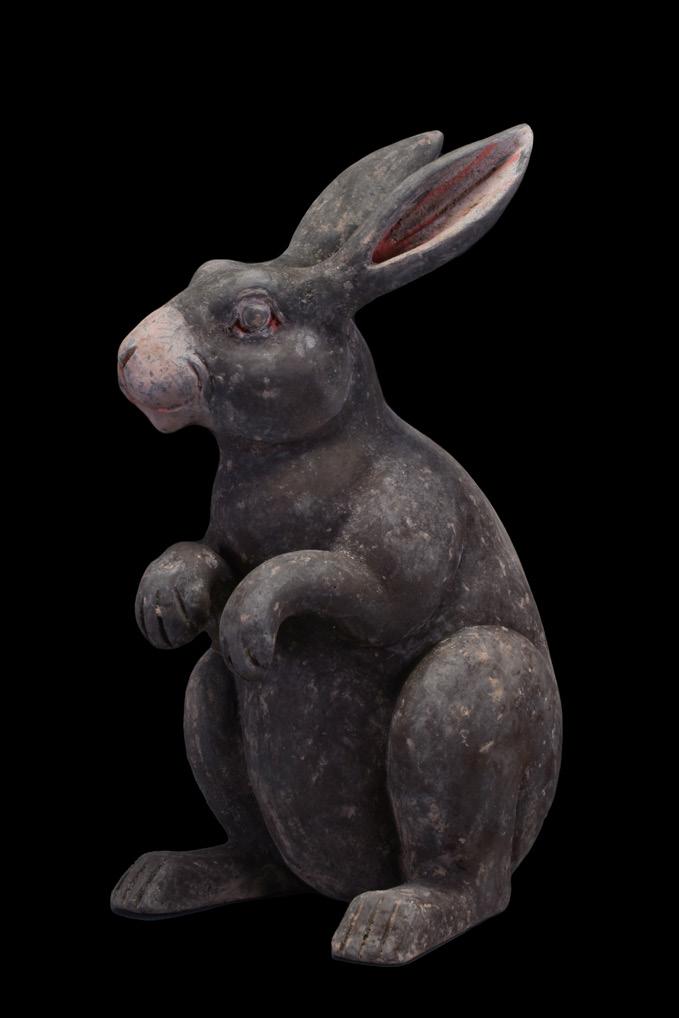
Provenance: From the private collection of a Somerset gentleman; previously in an old British collection, formed in the 1980s on the UK /European art markets.
441. NORTHERN WEI TERRACOTTA TILE
WITH BUDDHA - TL TESTED Ca. 386-534 AD
Starting price: £200
A finely moulded Chinese grey pottery tile, features Buddha within a rectangular-shaped recess. Buddha sits with left foot outstretched and right foot arched, backed by a halo and wearing a rich red robe with orange trimmings. Size: L:330mm / W:160mm ; 2.97kg.



Provenance: Property of a North London gentleman; previously acquire on the UK/ European art market in the 1990s.
442. NORTHERN WEI TERRACOTTA TILE WITH BUDDHA - TL TESTED Ca. 386-534 AD
Starting price: £200
A grey pottery decorative tile with a seated Buddha within an arched recess. Buddha sits cross-legged, backed by a halo, and wearing a rich red robe with black and green trimmings. Buddhist tradition holds that the Buddha made this sacred hand gesture immediately after gaining enlightenment. The Buddha is said to have stood calmly, raising his hand in this gesture of fearlessness. In response, the elephant stopped, became calm, and then approached the Buddha and bowed its head. Size: L:330mm / W:160mm ; 4.6kg.
Provenance: Property of a North London gentleman; previously acquire on the UK/ European art market in the 1990s.
443. NORTHERN WEI TERRACOTTA TILE WITH BUDDHA - TL TESTED Ca. 386-534 AD
Starting price: £200
A grey pottery decorative tile with a rectangular reccess to one face decorated with a standing Buddha in relief. Buddha is depicted frontally, wearing a long voluminous robe and backed by a halo. Size: L:340mm / W:175mm ; 4.07kg.
Provenance: Property of a North London gentleman; previously acquire on the UK/European art market in the 1990s.
444.
Ca. 202 BC - 220 AD
Starting price: £300
Featuring a circular belly topped with a narrow flaring neck. Adorned with wavy motifs and showcasing lateral decorative handles, this Han Hu vessel will make for an exquisite addition to any home, perhaps displayed on the top of a credenza, buffet, or console table. For a similar see Los Angeles County Museum of Art, Mr. and Mrs. Allan C. Balch Collection (M.52.2.1).
Size: L:350mm / W:280mm ; 6Kg.
Provenance: Ex High Wycombe Estate Collection, Ex Brighton gallery.
445.
Ca. 2800-1900 BC
Starting price: £500
A large terracotta jar, with impressed decoration to the mid to lower body, a slightly flaring neck with globular body. Impressed decoration also to the top of the neck below the rim Size: L:425mm / W:330mm ; 4.47kg.


Provenance: Ex. Buckinghamshire Collection, July 2010. Acquired from Brian Page Antiques, Brighton.
446.

Ca. 202 BC - 220 AD
Starting price: £3,000
A globular shaped vessel formed of a rich grey terracotta with three bands of linear decoration, the body rounding to an everting rim. The vessel standing on three stylised legs. Size: L:300mm / W:350mm ; 6Kg.

Provenance: From the private collection of a Somerset gentleman; previously in an old British collection, formed before 2000 on the UK /European art markets.
447.
Western Han Dynasty, Ca. 206 BC
Starting price: £500
The oblong body surmounted by a circular neck rising to an everted rim, painted in shades of pink, white and brick red with vertical bands of decoration, with bands of scrolls in pink and white within dark brick-red borders, with a red band encircling the shallow pedestal foot. For a similar see The Metropolitan Museum: 1994.605.31. Size: L:250mm / W:260mm ; 1.7Kg.
Provenance: Ex High Wycombe Estate Collection, Ex Brighton gallery.
448. CHINESE PAINTED POTTERY TRIPOD VESSEL (LI)
Xiajiadian Culture, Ca. 2300-1600 BC
Starting price: £900
An interestingly formed vessel modelled with a cylindrical body rising from the tripod base and terminating in a broad mouth with an everted rounded rim. The exterior is enhanced with intricate polychrome designs against a dark background. This piece has been precisely dated having undergone Thermo Luminescence analysis by Ralf Kotalla, an independent German Laboratory. The samples collected date the piece to the period reflected in its style, whilst also showing no modern trace elements. Its TL certificate with full report will also accompany this lot. For a similar example, see Bonhams, Asian Art, 11 September 2014, London, Lot 337. Size: L:265mm / W:175mm ; 1.43kg.
Provenance: Property of a London gallery, acquired on the US art market from A. P.; previously in the collection of E. Bourke, MD., Yonkers, NY.
449. CHINESE POTTERY TRIPOD VESSEL (LI)
Xiajiadian Culture, Ca. 2300-1600 BC
Starting price: £900
A tall pottery vessel with a wide everted rim above an elongated body, raised upon three conical legs, resembling a goat’s udder. Vessels such as this piece were used for cooking by people of the Xiajiadian culture from Inner Mongolia. This piece has been precisely dated having undergone Thermo Luminescence analysis by Ralf Kotalla, an independent German Laboratory. The samples collected date the piece to the period reflected in its style, whilst also showing no modern trace elements. Its TL certificate with full report will also accompany this lot. For a comparable example, see Christie’s, Live Auction 1109, 5 September 2002, Lot 548. Size: L:230mm / W:185mm ; 1.4kg.
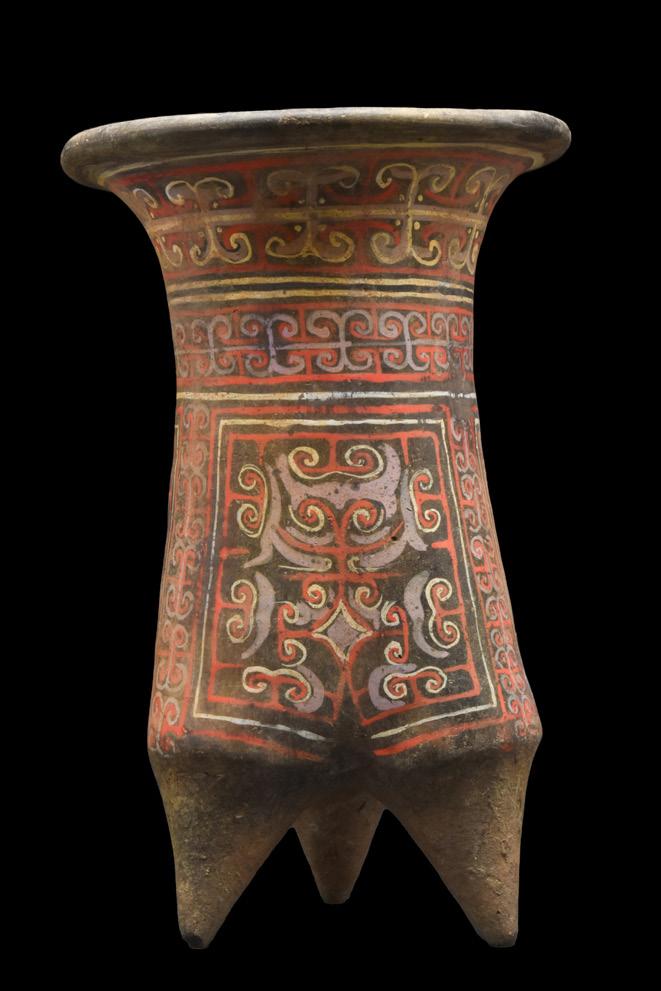
Provenance: Property of a London gallery, acquired on the US art market from A. P.; previously in the collection of E. Bourke, MD., Yonkers, NY.
450.
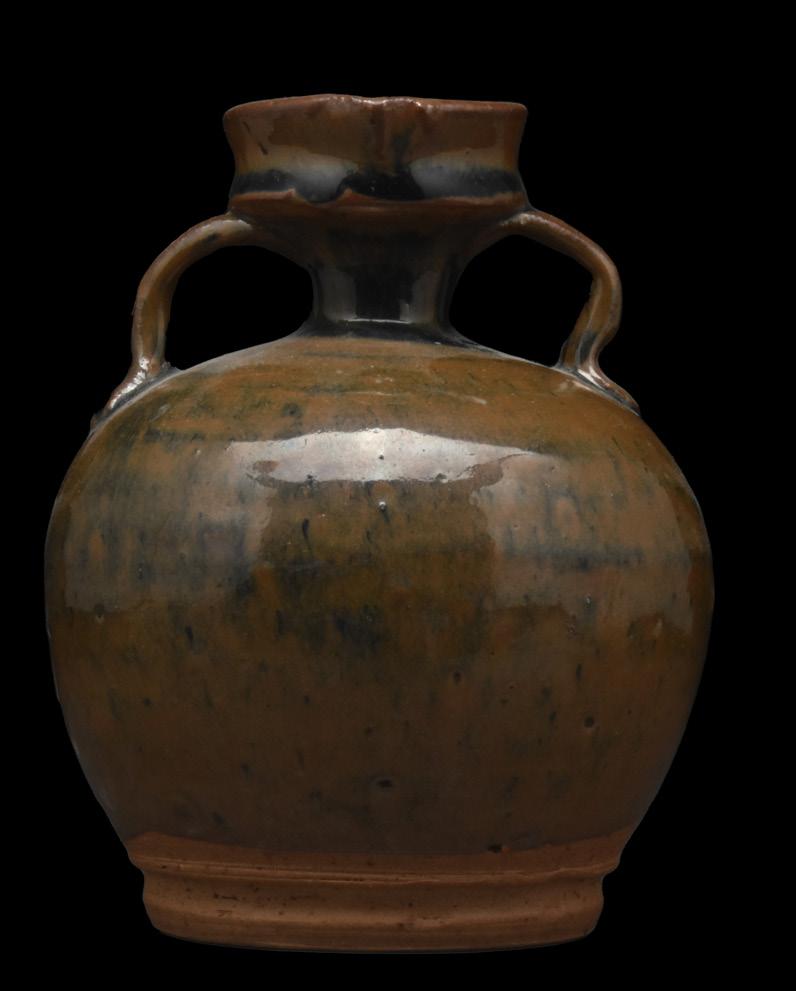
Ca. 1127-1280 AD
Starting price: £100
A beautiful twin handled amphora with a squat body and long neck protruding into a conical-shaped rim. The neck and body connected by two strap handles. Standing on a small pedestal ring foot. The black glaze has a motelled brown glaze. Size: L:156mm / W:125mm ; 690g.
Provenance: Ex High Wycombe Estate Collection, Ex Private UK Collector.

Ca. Qing Dynasty, 1644-1911 AD
Starting price: £1,000
A white and blue porcelain ewer with a squat body resting on four cylindrical legs. The finely decorated main body consists of a broad and deep container with rounded walls, a long tubular spout, and a sturdy handle to the rear. It is topped with a round-shaped lid with a small loop. The decoration features the “Eight Auspicious Symbols” (bajixiang): wheel of the dharma, endless knot, pair of fish, lidded jar, conch shell, victory banner, parasol, lotus flower. They are the eight treasures of Buddhism, believed to bring fortune. For a similar example, see Christie’s Fine Chinese Ceramics and Works of Art, Live Auction 2339, 17 September 2010, Lot 1426. Size: L:220mm / W:220mm ; 1.3kg.

Provenance: Private English collection of Sir Mark Heath KCVO CMG (1927-2005), and thence by descent.
Ca. Upper cretaceous (120 myo)
Starting price: £500
Rhacolepsis. Santana Formation, Araripe Basin, Brazil. A fossilized rhacolepis preserved in a stone with its body fully extended, fins and a tail outstretched. The whole specimen with the soft tissue and skeleton is well-preserved in brownish hue. No compositing or breaks in the nodule. Huge for this species. Size: L:450mm / W:140mm ; 3.18kg.
Provenance: Old USA collection.
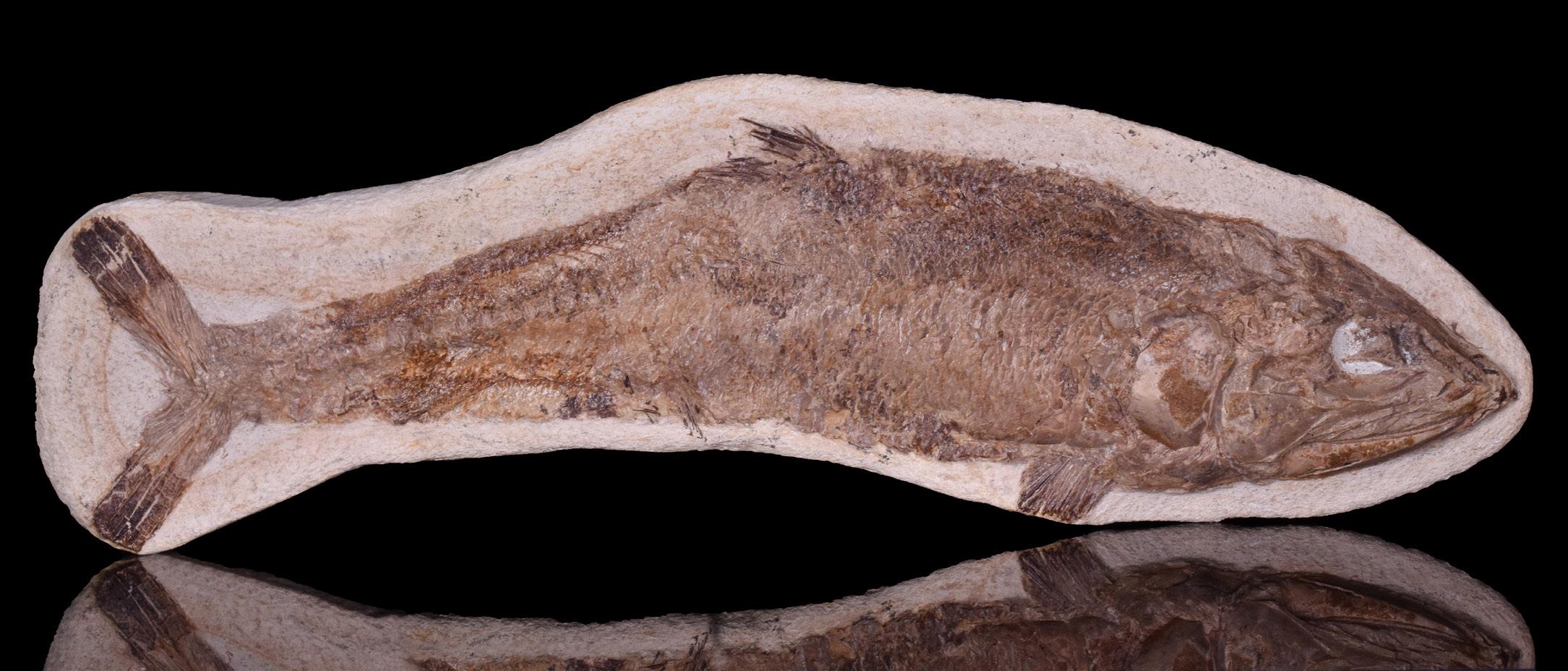
Ca. 100 BC
Starting price: £900
An iron coin die with a cylindrical body and an engraved circular base used to stamp the pseudo staters of Phillip II. A rare find! Philip II was the king of Macedonia from 359 to 336 BC. He was also a great politician, strategist, and reformer of the Macedonian army. Thanks to his successes in wars with his neighbors, he enlarged the territory of the state, turning Macedonia into a strong state organism. Father of the founder of the Macedonian Empire, Alexander the Great. Size: L:101.1mm / W:28.4mm ; 342.14g.

Provenance: From the private collection of a South London art professional; previously in a collection formed on the UK/European art market in the 1970s.
454.
TO ARTAXERXES II, AR SIGLOS, UNCERTAIN MINT (SARDES)
Ca. 485-375 BC
Starting price: £50
Persian king, holding transverse spear and bow, running to right. Four punchmarks Rectangular incuse. Two puchmarks and two chisel cuts SNG COP 280-3; cf. BMC p.cxxxvii for punchmarks. Size: D:16.3mm; 5.4g.
Provenance: Private UK collection, acquired pre 2000.
455.
Ca. 5th century BC
Starting price: £500
AR HEMIOBOL


Forepart of boar left, behind tunny Within incuse square head of lion left with star above SNG COP 49. Size: D:10.3mm; 0.4g.
Provenance: Private UK collection, acquired pre 2000.
456.

Ca. 440-420 BC
Starting price: £200
Obv: Helmeted head of Athena right. Rev: Owl standing right, head facing, olive sprig and crescent behind; all within incuse square; AΘE to right. SNG Lockett 1842; Kroll 8. Extremely fine. Size: D:22.4mm; 17.2g.

Provenance: Private UK collection, acquired pre 2000.


Ca. 440-420 BC
Starting price: £200
Obv: Helmeted head of Athena right. Rev: Owl standing right, head facing, olive sprig and crescent behind; all within incuse square; AΘE to right. SNG Lockett 1842; Kroll 8. Very fine. Size: D:25.1mm; 17.0g.
Provenance: Private UK collection, acquired pre 2000.
460. BOEOTIA. THEBES. AR STATER Ca. 395/390-338 BC
458.
Ca. 454-404 BC, Classical period. Starting price: £200
Head of Athena right, wearing earring and crested Attic helmet decorated with olive leaves and palmette Owl standing right, head frontally,olive sprig and crescent behind, to the right AΘE. Kroll 8. Size: D: 22.9mm / 15.9g.
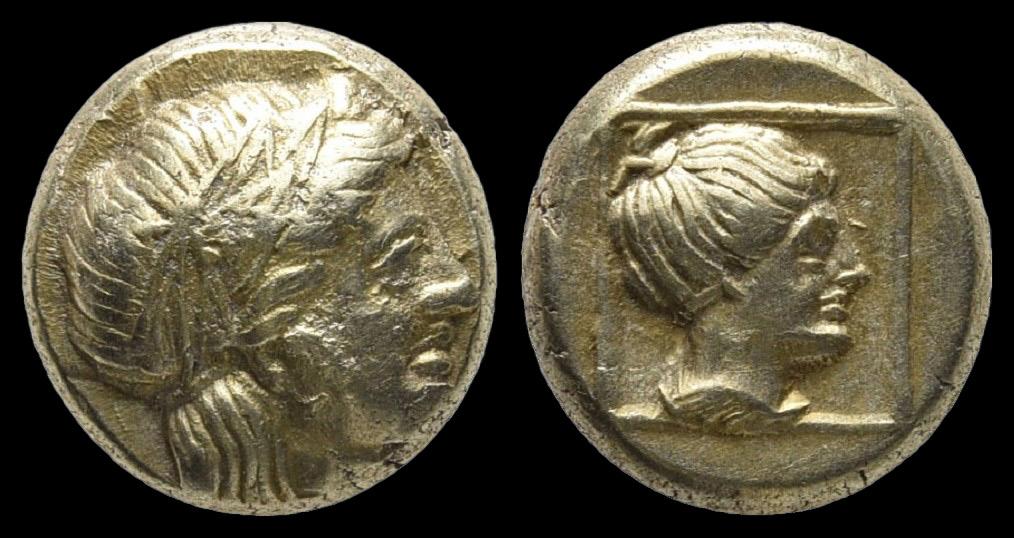
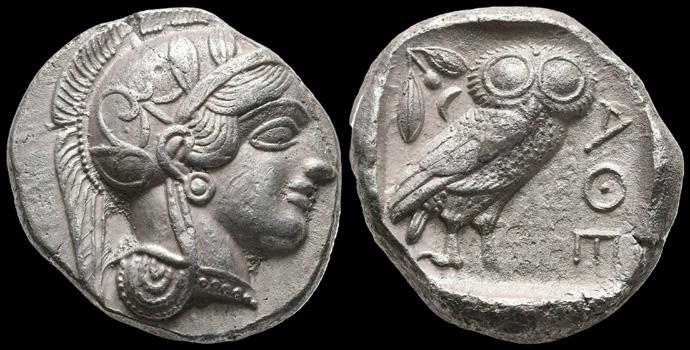

Provenance: Private UK collection, acquired pre 2000.
Obv: Boeotian shield. Rev: Amphora; DA-IM across field. Hepworth 18; BMC Central Greece pg. 81, 126; SNG Copenhagen 323. VF. Size: D: 19.9mm; 12.23g.
Provenance: Private UK collection, acquired pre 2000.
Starting price: £100
459.

Ca. 420-370 BC


Starting price: £100
Obv: Two wrestlers grappling; AΣ (turned up) between. Rev: [E]ΣTΦEΔIIYΣ, slinger in short chiton standing right, triskeles before, all in dotted square border SNG von Aulock 4539. SNG Paris 54. Size: D: 22.9mm / 15.9g.
Provenance: Private UK collection, acquired pre 2000.
461. ISLAND OF LESBOS, MYTILENE, EL HEKTE Ca. 377-326 BC
Laureate head of Apollo right Draped bust of a female facing right within linear square. Bodenstedt. Size: D: 9.9mm; 2.6g.
Provenance: Private UK collection, acquired pre 2000.
462.
OF MACEDONIA, IN THE NAME OF ALEXANDER III THE GREAT, POSTHUMOUS ISSUE, AR TETRADRACHM, AMPHIPOLIS MINT 336-323 BC
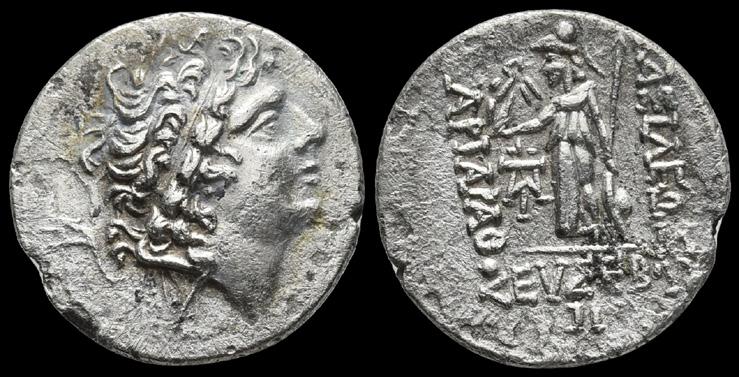
Starting price: £50
Head of Herakles wearing lion’s scalp right Zeus seated left, holding eagle and sceptre. Letter Λ above racing torch. In the right AΛEΞANΔPOY. Price 443. Size: D: 27.3mm; 17g .
Provenance: Private UK collection, acquired pre 2000.
463. CALABRIA,TARENTUM. AR NOMOS Ca. 302-280 BC
Starting price: £100
Obv: Naked horseman mounted right, holding shield, two lances and a spear; ΣA below. Rev: TAΡAΣ behind Taras seated on dolphin left, holding distaff; prow below. Vlasto 585. Size: D: 21.8mm; 7.43g.

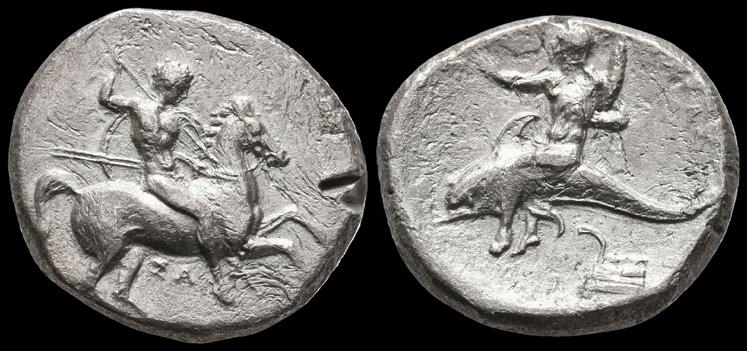
Provenance: Private UK collection, acquired pre 2000.
465. PHRYGIA, APAMEA. Ca. 2-1 century BC
Starting price: £50
AE Laureate head of Zeus right Cult statue of Artemis frontally SNG COP 184 Size: D:22.3mm; 8g.
Provenance: Private UK collection, acquired pre 2000.
L. Calpurnius Piso Frugi, Rome Mint. Laureate head of Apollo right, behind control symbol arrowhead; Horseman holding long palm galloping right, above control symbol, in exergue C_PISO FRVGI, below control numeral XVIIII.Crawford 408/1. Very fine. Size: D: 19.0mm; 3.53g.
Provenance: Private UK collection, acquired pre 2000.
464.


AR NOMOS Ca. 280-272 BC
Starting price: £200
Obv: Youth, nude, on horseback right, crowning horse with wreath; behind, ΣΑ; in two lines below, ΑΡΕ/ΘΩΝ. Rev: TAPAΣ, Phalanthos riding dolphin left, holding tripod and resting hand resting on dolphin; below, CAΣ. Vlasto 666; SNG ANS 1046-50; SNG BN 1869; HN Italy 957. Very fine. Size: D: 21.2mm; 7.97g/
Provenance: Private UK collection, acquired pre 2000.
Eusebeia mint, dated year 13 = 89/88 BC Diademed head of Ariarathes IX right Athena standing left, holding Nike, spear and shield. In left field monogram, in exergue IΓ. ΒΑΣΙΛΕΩΣ APIAPAΘOY ΕΥΣΕΒΟΥΣ Simonetta 7-10v (monogram). Size: D: 18.8mm; 3.6g.
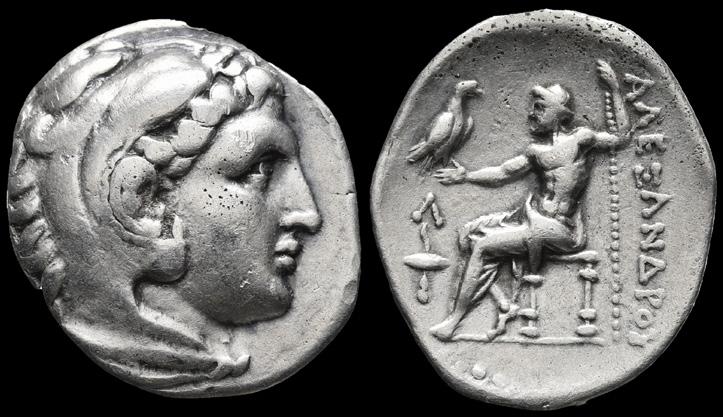

Provenance: Private UK collection; acquired in London before 2000.

468. ROMAN REPUBLIC C. ANNIUS. NORTH-ITALY. AR DENARIUS 82-81 BC
Starting price: £100
Obv: C·ANNI·T·F·T·N· PRO·COS·EX·S·C Diademed and draped female bust r.; behind, caduceus, before, scales and below, pelta. Rev: Victory in quadriga r., holding reins and palm-branch; above horses, Q·. In exergue, L·FABI·L·F·HISP. Babelon Annia 2 and Fabia 17. Sydenham 748. RBW 1375. Crawford 366/1a. Wonderful old tone, very fine. Size: D: 19.3mm; 4.0g.
Provenance: Private UK collection, acquired pre 2000.
469. ROMAN REPUBLIC C. MARIUS C. F. CAPITO. ROME. AR SERRATE DENARIUS 81 BC

Starting price: £100
Obv: Draped bust of Ceres right; CAPIT•L behind, [uncertain control symbol – EI ?] below chin Rev:Ploughman with yoke of oxen to left; L above, C•MARI•C•F S•C in two lines in exergue. Crawford 378/1c; RSC Maria 9. Good Very Fine. Size: D: 18.8mm; 3.85g.
Provenance: Private UK collection, acquired pre 2000.
470. ROMAN REPUBLIC L. PROCILIUS. SERRATE AR DENARIUS 80 BC

Starting price: £100
Obv: Head of Juno Sospita right, wearing goat’s skin; SC behind. Rev: Juno Sospita in biga right, hurling spear and holding shield; serpent below, L PROCILI F in exergue. Crawford 379/2. Sydenham 772. RSC Procilia 2. EF. Size: D: 18.6mm; 3.62g.
Provenance: Private UK collection; acquired in London before 2000.
471. KINGS OF CAPPADOCIA, ARIOBARZANES III EUSEBES PHILOROMAIOS, AR DRACHM, EUSEBEIA MINT, YEAR 11 52-42 BC
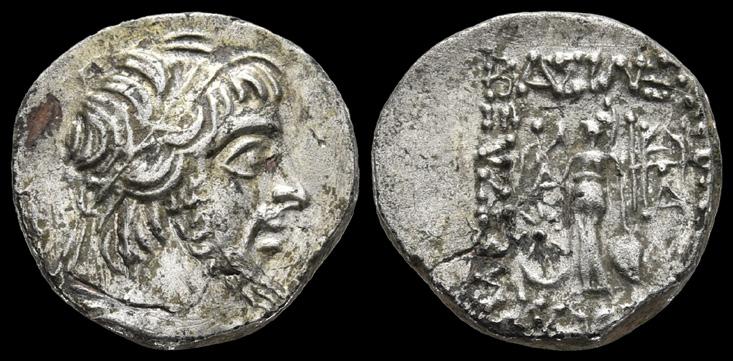

Starting price: £50
Diademed head of Ariobarzanes III with beard, to right Athena standing left, holding Nike, spear and shield. In left field star above crescent, in right field monogram. ΒΑΣΙΛΕΩΣ [APIOBAPZANOY] ΕΥΣΕΒΟΥΣ [ΚΑΙ ΦIΛOPΩMAIOY]


Simonetta 3. Size: D: 15.6mm; 3.65g.
Provenance: Private UK collection, acquired pre 2000.
472. ROMAN REPUBLIC, JULIUS CAESAR. AR DENARIUS 47-46 BC
Starting price: £100
Military mint travelling with Caesar in Africa. Obv: diademed head of Venus to right. Rev: CAESAR to right, Aeneas walking left, carrying Anchises and palladium, dotted border, (S.1402, Cr.458/1, Syd.1013, RSC Julius Caesar 12). Toned, small scratch. Good very fine. Size: D: 18.3mm; 3.65g.
Provenance: Private UK collection, acquired pre 2000.
473. ANCIENT ROMAN IMPERIAL AR DENARIUS AUGUSTUS 27 BC-AD 14
Starting price: £100
Augustus, with Gaius and Lucius Caesares, Lugdunum Mint, 2 BC - AD 4. Laureate head of Augustus right, CAESAR AVGVSTVS DIVI F PATER PATRIAE; Gaius and Lucius standing front, each with a hand resting on a round shield, spears behind, above simpulum to left and lituus to right, AVGVSTI F COS DESIG PRINC IVVENT around, C L CAESARES in exergue. RIC I 207. Cut marks on the obverse. Very fine. Size: D: 19.3mm; 3.81g.

Provenance: Private UK collection, acquired pre 2000.
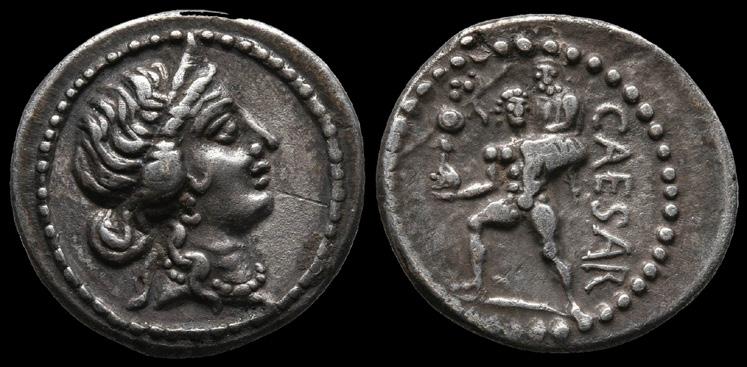
474. TRAJAN Æ SESTERTIUS. ROME AD 103-111.

Starting price: £100
Obv: IMP CAES NERVAE TRAIANO AVG GER DAC P M TR P COS V P P, laureate bust right, drapery on far shoulder Rev: SPQR OPTIMO PRINCIPI, Victory standing right and fastening a shield inscribed VIC DAC to a palm tree, S-C across fields. RIC 527. Very Fine. Size: D: 31.1mm; 24.71g.


Provenance: Private UK collection, acquired pre 2000.
475. ANTONINUS PIUS 138-161 AD WITH MARCUS AURELIUS CAESAR, AR DENARIUS, ROME MINT Ca. 140 AD
Starting price: £50
Laureate head of Antoninus Pius right Bare head of young Marcus Aurelius right RIC III 417a. Size: D:18.7mm; 3.1g.

Provenance: Private UK collection, acquired pre 2000.
476. NERVA. AR DENARIUS, ROME. 97 AD
Starting price: £200
Obv: IMP NERVA CAES AVG P M TR POT II, laureate head right. Rev: COS III PATER PATRIAE, simpulum, sprinkler, ewer, and lituus. RIC 34. Good Very Fine. A well struck; nicely patina. Size: D:18.9mm; 3.6g.
Provenance: Private UK collection, acquired pre 2000.
477. DIDIUS JULIANUS. 193 AD



Starting price: £500
Obv: IMP CAES M DID IVLIAN AVG, laureate head right Rev: RECTOR ORBIS, Didius Julianus standing left, holding globe in right hand, roll in left. RIC IV 3; BMCRE 7; RSC 15. Lightly toned, good VF. Size: D:17.8mm; 2.94g.
Provenance: Private UK collection, acquired pre 2000.
478. VITELLIUS. AR DENARIUS ROME. Ca. 69 AD
Starting price: £500
April-December 69. Obv: A VITELLIVS GERMANICVS IMP Bare head of Vitellius to right. Rev: Victory seated left on throne, holding patera in her right hand and palm in her left. BMC 4. Cohen 121. RIC 71. Very fine. Size: D:18.5mm; 3g.
Provenance: Private UK collection, acquired pre 2000.
479. PESCENNIUS NIGER. AR. UNPUBLISHED DENARIUS 193-194 AD

Starting price: £500
Antioch mint. Obv: IMP CAES C (P) ESCE NIGER IVST (AVG) laureate head ritht. Rev: CELERI FRVGIFERE legend with Ceres standing left, holding a single torch with both hands. RIC -; Sear -; RSC -; Extremely rare! Very fine. Size: D:17.2mm; 3.76g.
Provenance: Private UK collection, acquired pre 2000.
480.
Ca. AD 230


Starting price: £50
Julia Mamaea AD 222-235, Rome Mint. Diademed and draped bust of Julia Mamaea right, IVLIA MAMAEA AVG; Felicitas seated left, holding cornucopiae and caduceus, FELICITAS PVBLICA
RIC IV.2 338. Beautiful coin, sharply struck, attractive toning, minor edge split. Uncirculated. Size: D:19.4mm; 3.20g.
Provenance: Private UK collection, acquired pre 2000.
481.
Starting price: £200
Obv: DIVA PAVLINA Bust draped and veiled r. Rev: CONSECRATIO Peacock standing facing, head l., with tail in splendor. Nicely patina, BM-135, C-1 (50 Fr.), RIC-1. Rare! Size: D:18.4mm; 3.4g.
Provenance: Private UK collection, acquired pre 2000.
483. SYRIA, PHILIP I ARAB 244-249 AD, AR TETRADRACHM , ANTIOCH MINT, YEAR 4. Ca. 248 AD


Starting price: £50
Radiate and cuirassed bust of Philip I. Left Eagle standing left with wreath in its beak Prieur 431/433. Size: D:27.7mm; 11.7g.
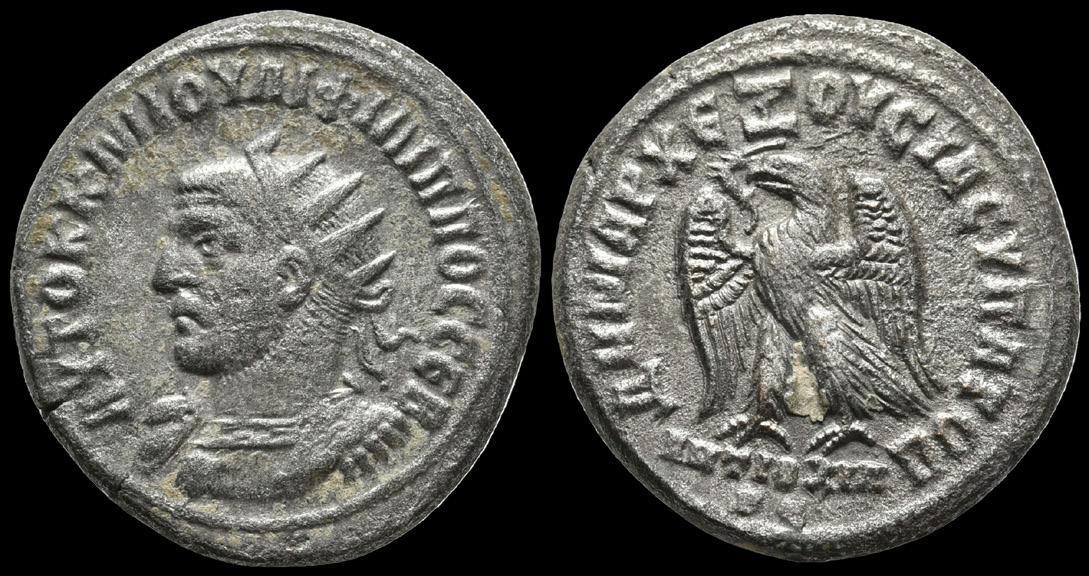

Provenance: Private UK collection, acquired pre 2000.
Starting price: £200
482.

Starting price: £200
Obv: IMP C M CLOD PVPIENVS AVG, laureate, draped, and cuirassed bust of Pupienus right. Rev: CONCORDIA AVGG, Concordia seated left on backless throne, holding patera and double cornucopiae. BMCRE 42. RIC 1. RSC 6. Toned. Nearly extremely fine. Size: D:20.6mm; 2.82g.
Provenance: Private UK collection, acquired pre 2000.
484. BYZANTINE EMPIRE, HERACLIUS WITH HERACLIUS CONSTANTINUS 610-641 AD, AU SOLIDUS, CONSTANTINOPLE MINT. Ca. 613-616 AD
Two busts frontally: to the left large portrait of Heraclius with short beard, wearing chlamys and crown with cross, to the right smaller portrait of beardless Heraclius Constantinus wearing chlamys and crown with cross. Above cross and legend dd NN hERACLIYS ET hERA CONST PP AV Cross potent on the base with three steps. ViCTORIA-AVGVH around, CONOB beneath. DOC II.1 no 8h. Size: D:20.6mm; 4.38g.
Provenance: Private UK collection; acquired in London before 2000.
1.1 Apollo Art Auctions Ltd, a company registered in England with registered number 11450370 and with a registered office at 10-12 Mulberry Green, Old Harlow, Essex CM17 0ET (“Apollo Art Auctions“. “we” or “us“), carries on business with Bidders, Buyers and Sellers (as defined below) on the following Auction Terms and Conditions, the Terms of Consignment for Sellers, and on such other terms, conditions and notices as may be referred to herein or that may be amended by way of notices posted in the saleroom or by way of announcements made by us.
1.2 Bidders should carefully read the Auction Terms and Conditions (the “Terms and Conditions“) and Terms of Consignment for Sellers prior to bidding at auction, as Bidders and Buyers will be deemed to have accepted these terms and conditions once a bid has been placed.
1.3 We act as agent for the Seller whose identity, for reasons of confidentiality, is not normally disclosed to the Buyer. If a Buyer is the successful Bidder on the fall of the hammer, the contract of sale is made directly between the Buyer and the Seller.
2.1 In these Terms and Conditions, the following words have the following meanings:
Bid: an amount offered by a Bidder to purchase a Lot.
Bidder: the person considering, making or attempting to make a Bid on a Lot, in person or by any other means, including the Buyer.
Buyer: the Bidder who makes the highest Bid accepted by us.
Buyer’s Premium: The amount payable by the Buyer in addition to the Hammer Price on each Lot purchased,
calculated as a percentage of the Hammer Price – 20% (not including any online charges)
Date of Sale: the date on which we accept the Buyer’s Bid for the Lot.
Deliberate Forgery: an imitation made with the intention of deceiving as to authorship, origin, date, age, period, culture or source but which is unequivocally described in the catalogue as being the work of a particular author, origin, date, age period, culture or source, and which at the date of the sale had a materially lesser value than it would have had if it had been in accordance with the catalogue description.
Hammer Price: the highest Bid reached (at or above any reserve) and accepted by us when we bring down the hammer and the sale of the Lot is final.
Lot: the item consigned by the Seller for sale at auction by us.
Purchase Price: the Hammer Price in respect of the Lot sold, together with any Buyer’s Premium, Value Added Tax chargeable and any additional charges payable by a Buyer in accordance with these Terms and Conditions.
Seller: the legal owner of the Lot offered for sale, including their agents (other than Apollo Art), executors or personal representatives.
Website: the website where auction takes apollogalleries.com
3.1 Apollo Art Auctions’ knowledge in relation to any Lot is dependent on information provided by the Seller of the Lot. We are not able to and do not carry out exhaustive due diligence on each Lot. Bidders acknowledge this fact and accept responsibility for carrying out inspections and investigations to satisfy themselves as to the Lots on which they bid.
3.2 Lots are offered as seen and are available for inspection prior to auction at our premises. It is the responsibility of Bidders to make any enquiries before the auction date and satisfy themselves as to the accuracy and authenticity of any Lot and in relation to the description of any Lot, including but not limited to a Lot’s condition, quality, provenance, authenticity, background, style, period, age, origin, value and estimated selling price. We have no obligation to examine, investigate or carry out any tests to establish the accuracy or otherwise of any description whether on the Website or in any printed material.
3.3 Sale catalogues, catalogue illustrations, condition reports and any descriptive certificates are for information purposes only and do not necessarily convey the full information regarding any Lot. Information provided to Bidders or their advisors prior to the sale in respect of any Lot, whether written or oral and including any information in the sale catalogue or condition or other report, is a statement of opinion honestly held by Apollo Art Auctions and is not a statement of fact. Our description of any Lot, including details of the age, value, authenticity, ownership, history, use and condition, reflect our opinion only and we therefore do not warrant any information provided to Bidders in relation to the Lot.
3.4 The nature of the Lots sold at auction by Apollo Art Auctions is such that they are likely, due to their nature and their age, to show signs of wear and tear, damage, or other imperfections, restoration or repair. Any reference to condition by Apollo Art Auctions will not amount to a full description of condition.
Photographs included in Apollo Art Auctions’ sale catalogues are not representative of the condition of any Lot.
3.5 We may describe the Lots using the following descriptions:
Restored: the Lot may have been repaired or otherwise reinstated and some parts may have been replaced;
Fair Condition: the Lot may be fragmentary or have some obvious damaged;
Fine Condition: the Lot is likely to be generally complete but may have minor damage or evidence of restoration or repair;
Very Fine Condition: the Lot is usually complete and in good condition, but may have some minor damage, restoration or repair.
3.6 We will provide a report on the physical condition of any Lot on request. The content of a report is information only and should not be relied upon as advice. For coins that have been authenticated, graded and encapsulated (‘slabbed’) by an independent grading company, no guarantee of any kind is offered by us. Buyers should note that removal or attempted removal from any slab will immediately void any independent guarantee that might have been offered by that grading company.
3.7 All dimensions of Lots are approximate and are for general guidance only. A single dimension given is normally the greatest dimension for the Lot.
3.8 Subject to the conditions set out in this clause 3, Apollo Art Auctions exercises reasonable care when making statements of opinion consistent with its role as a regional auction house, based on information provided by the Seller, available scholarship, and the generally accepted opinions of relevant experts (at the time any such expert expressly states such opinion). We are in no way required to seek the opinion of any expert outside Apollo Art Auctions.
3.9 It is the Bidder’s sole responsibility to identify and obtain any necessary licences for a Lot, including but not limited to export, import, or endangered species. Apollo Art Auctions and the Seller make no representations or warranties as to whether any Lot is or is not subject to export or import restrictions. The denial of any licence or permit shall not entitle the Buyer to cancel the sale contract or delay payment of the Lot.
3.10 We reserve the absolute right to withdraw any Lot from sale for any reason.
4.1 Pre-sale estimates for Lots are intended as a guide to help Bidder’s gauge approximate prices for the purchase of a particular Lot. The actual Hammer Price realised at auction may be higher or lower than the pre-sale estimate. The lower estimate may represent a reserve price which we have agreed with the Seller. Pre-sale estimates do not include the Buyer’s
Premium or VAT. d
4.2 VAT is charged and invoiced on an inclusive basis, under Apollo Art Auctions’ Margin Scheme on all Buyers’ Premiums and other charges.
4.3 The Purchase Price is due and payable when the Lot is sold, unless otherwise agreed in writing by us. An invoice will be sent to the Buyer by email or post, and Buyers may be telephoned or otherwise contacted when payment is not received promptly or where there are queries in any respect.
4.4 The full Purchase Price must be paid in Pounds Sterling and can be made by bank transfer; by cash up to the value of £8,000, by cheque from a UK bank (subject to clearance) or by bank debit card or credit card (up to a maximum of £500).
5.1 Bidders must register their personal data with Apollo Art Auctions before a sale commences in order to place a Bid on any Lot. We shall process the Bidder’s personal data in accordance with our privacy policy (which is available via the Website).
5.2 If this is your first-time bidding at Apollo Art Auctions or you are a returning Bidder who has not bought anything from us within the last two years you must register at least 48 hours before an auction to give us enough time to process and approve your registration. We may, at our option, decline to permit you to register as a Bidder. You will be asked for the following:
for individuals: Photo identification (driving licence, national identity card or passport) and, if not shown on the ID document, proof of your current address (for example, a current utility bill or bank statement).
for corporate clients: Your Certificate of Incorporation or equivalent document(s) showing your name and registered address together with documentary proof of directors and beneficial owners; and
for trusts, partnerships, offshore companies and other business structures, please contact us in advance to discuss our requirements.
5.3 The Bidder with the highest bid accepted by us shall be the Buyer at the Hammer Price. Bids may be
made by way of the Website, live telephone bidding, written Bid, or bidding in person at the live sale.
5.4 Bidders shall be deemed to act as principals and require Apollo Art Auctions’ written consent at the time of Bidder registration to bid as agent for another party. Bidders are personally liable for their Bid and jointly and severally liable with their principal if bidding as agent (whether or not Apollo Art Auctions has consented to the Bidder acting as agent).
5.5 Lots will only be invoiced to the name and address of the Bidder on the bid registration form and cannot be transferred to another name and address. Apollo Art Auctions can only accept payment for the Lot from the registered Bidder.
5.6 Apollo Art Auctions expressly reserves the right to bid on behalf of the Seller up to the amount of any reserve. We may at our sole discretion refuse any Bid from any Bidder, and to withdraw or re-offer any Lot if we believe there has been an error or dispute. Any dispute about a Bid shall be settled at Apollo Art Auctions’ absolute discretion, always acting reasonably.
5.7 All Lots (unless otherwise specified) are offered subject to a confidential reserve price agreed between Apollo Art Auctions and the Seller, below which we may not sell the Lot. The reserve price shall be no higher than the low pre-sale estimate of the Lot at the time of auction.
5.8 Bidding increments shall be at Apollo Art Auctions’ sole discretion. By way of example only, bidding increments may be:
(A) £0 to £99 – in increments of £10
(B) £100 to £199 – in increments of £10
(C) £200 to £499 – in increments of £20
(D) £500 to £999 – in increments of £50
(E) £1,000 to £1,999 – in increments of £100
(F) £2,000 to £4,999 – in increments of £200
(G) £5,000 to £9,999 – in increments of £500
(H) £10,000 to £19,999 – in increments of £1,000
(I) £20,000 to £49,999 – in increments of £2,000
(J) £50,000 to £99,999 – in increments of £5,000
(K) £100,000 to £249,999 – in increments of £10,000
(L) £250,000 and up – in minimum increments of £25,000
Apollo Art Auctions is not bound to implement any of the above increments.
5.9 It is the responsibility of the Bidder to ensure that Bids are made accurately. We are not responsible for any technical failure or otherwise which results in bids not being received.
5.10 Bidders will receive future notifications by email and may be sent catalogues for future sales. Any Bidder who does not wish to receive this information should contact us at auction@apollogalleries.com to opt out.
6.1 Title in a purchased Lot is retained by the Seller and shall only pass to the Buyer when the Purchase Price and all other sums payable by the Buyer have been received by Apollo Art Auctions in full and cleared funds.
6.2 Risk for the Lot passes to the Buyer at the time the Lot is sold to the Buyer. Apollo Art Auctions is not responsible for loss or damage to any Lot at any time.
7. 1 Once payment of all sums due have been received in full and cleared funds, we will release the Lot to the Buyer for collection. The Buyer must collect, or arrange the collection of, all purchases from our premises at 25 Bury Place, WC1A 2JH, within seven working days following the Date of Sale (subject always to payment being received in full by us). All packing and handling of Lots will be at the Buyer’s sole risk.
7.2 Lots not collected may be removed and stored and will only be release once any relevant storage costs have been paid in full. If the storage charges reach 50% of the Hammer Price paid or after the expiration
of three months from the transfer date, whichever occurs first, we may re-sell any and all lots stored without notice and in any manner at our sole discretion and to apply any proceeds in defrayment of such costs. The Buyer will be entitled to receive any credit balance above the amount of the costs on request but will remain liable for any deficit.
7.3 Upon request we will arrange delivery of purchased Lots subject to payment of an agreed fee. We do not insure Lots in transit but can arrange insurance at Buyer’s written request. Delivery will be exercised as agreed with the Buyer, and unless otherwise specified by us during the working days and hours only following the sale. We ship paid lots up to 3 working days after payment of all monies owed by the Buyer is received.
8.1 If the Purchase Price and/or all sums payables are not paid in full when they fall due and/or the Lot is not removed in accordance with these terms, we will without further notice to the Buyer be entitled to exercise one or more of the following rights:
to terminate the agreement for sale immediately. to retain possession of the Lot and to exercise a lien over any of the Buyer’s property in our possession for any purpose until the debt due is satisfied. to remove and/or store the Lot at the Buyer’s expense. to take legal proceedings against the Buyer on behalf of the Seller for payment of any sums due.
to release the name and address of the Buyer to the Seller to enable the Seller to commence legal proceedings to recover the amounts due and legal costs. We will take reasonable measures to notify the Buyer prior to releasing such details to the Seller.
to charge interest on any monies due at the annual rate of 8% per annum from time to time to be calculated on a daily basis from the date upon which such monies became payable until the date of actual payment.
to sell the Lot without a Reserve Price at auction and apply any proceeds against the amount owing by the Buyer.
to apply any monies received from the Buyer in payment or part payment of any sums due from the Buyer under these Terms; and/or
to refuse to allow the Buyer to register for a future sale or to reject any future Bid made by the Buyer.
8.2 We shall, as agent for the Seller and on our own behalf pursue these rights and remedies only so far as we deem at our sole discretion is reasonable to make appropriate recovery in respect of breach of these Terms and Conditions. We are in no way obligated to exercise any of the above rights or remedies.
9.1 The Seller represents and warrants to the Buyer that:
The Seller is the legal owner of the Lot consigned to Apollo Art Auctions or is fully authorised to sell the Property by the legal owner of it.
The Seller is able to and shall transfer possession to the Buyer good and marketable title to the Lot free from any third-party rights or claims;
The Seller is unaware of any matter or allegation which would render any description given to Apollo Art Auctions in relation to the Lot inaccurate or misleading in any way.
The Lot has been or will be lawfully imported and lawfully and permanently exported as required by the laws of any country in which it is or was located. Any required declarations upon the export and import of the Lot have been or will be properly made and any duties and taxes on the export and import of the Lot have been or will be paid by the Seller.
9.2 Subject to paragraph 9.1, neither Apollo Art Auctions nor the Seller is liable for any errors or omissions provided to Bidders by Apollo Art Auctions, whether orally or in writing, where negligent or otherwise, except as set out in paragraph 3.3.
9.3 Subject to paragraph 9.6, neither Apollo Art Auctions nor the Seller gives any guarantee or warranty to the Bidder. Any implied warranties and conditions are excluded (except where such warranties and conditions cannot be excluded by law), other than the express warranties given by the Seller to the Buyer
in the Terms of Consignment for Sellers.
9.4 Neither Apollo Art Auctions nor the Seller accepts responsibility to any Bidder for acts or omissions (whether negligent or otherwise) by Apollo Art Auctions in relation to the conduct of any auction.
9.5 Any claim by a Bidder or a Buyer against Apollo Art Auctions or the Seller is limited to the Purchase Price in respect of the relevant lot and shall not include under any circumstances indirect or consequential losses.
9.6 Nothing in these Terms and Conditions shall limit or exclude our liability for (a) death or personal injury resulting from our negligence; (b) fraud or fraudulent misrepresentation; or (c) any other liability that cannot be excluded or limited by English law.
10.1 You agree to use the website in accordance with the terms of use.
10.2 The website contains material which is owned by or licensed to us. This includes, but is not limited to, the design, layout, look, appearance and graphics.
10.3 The Website is made for your personal or internal business use only. You may not reproduce all or a substantial part of the website, or commercially exploit any of the content on the website.
10.4 We will use reasonable endeavours to always make the Website available to you. However, there may be occasions when access to the website may be interrupted, including for scheduled maintenance or upgrades, for emergency repairs, or due to failure of telecommunications links and/or equipment. We reserve the right to remove any content or features from the website for any reason.
11.1 Notwithstanding the conditions in paragraph 9, any Lot which proves to be a Deliberate Forgery (as defined in paragraph 1) may be returned to Apollo Art Auctions by the Buyer within 21 days of the relevant Date of Sale, provided the Lot is in the same condition as when bought, and is accompanied by particulars identifying it from the relevant catalogue description and a written statement of defects. If we are satisfied
at our sole discretion that the above criteria have been met and that the lot is a Deliberate Forgery, the sale will be cancelled, and Apollo Art Auctions shall refund the Hammer Price and the Buyer’s Premium paid by the Buyer for the Lot (subject to Apollo Art Auctions receiving return payment from the Seller).
11.2 Paragraph 11.1 shall not apply if either: (1) the catalogue description reflected the generally accepted view of scholars and experts as at the date of sale, or the catalogue description indicated that there was a conflict of opinion; or (2) the only method of establishing at the date of sale that the item was a Deliberate Forgery would have been not then generally available or accepted, unreasonably expensive or impractical to use, or likely to have caused damage or loss of value (in our reasonable opinion) of the lot; or (3) there has been no material loss in value of the lot from its value had it been in accordance with its description.
11.3 If the Buyer is not personally able to transfer a good and marketable title to Apollo Art Auctions, then the Buyer shall have no rights under this paragraph 10. The right of return provided by this paragraph 11 is additional to any right or remedy provided by law or by these Terms and Conditions.
11.4 Apollo Art Auctions may require the Buyer to obtain at the Buyer’s expense the reports of up to two independent and recognised experts in the field, mutually acceptable to Apollo Art Auctions and to the Buyer. We shall not be bound by any reports produced by the Buyer, and we reserve the right to seek additional expert advice at our own expense.
11.5 For the avoidance of doubt, our maximum liability to the Buyer is total value of the Hammer Price and Buyer’s Premium. We will not pay or refund any additional costs, fees, shipping, loss of profit, damages and consequential costs.
12.1 Apollo Art Auctions reserves the right to alter these Terms and Conditions at any time.
12.2 Apollo Art Auctions shall have the right in its absolute discretion to refuse admission to its premises or attendance at its auctions by any person.
12.3 Special terminology may be used in catalogue de-
scriptions of particular types of goods, and the descriptions should be interpreted in accordance with any glossary appearing in the sale catalogue.
12.4 All images and other materials produced for the auction are the copyright of Apollo Art Auctions for use at Apollo Art Auctions’ discretion.
12.5 Any extension or waiver of any provision of these Terms and Conditions that may be granted to Bidders, Buyers or Sellers by Apollo Art Auctions for a specific Lot shall not have any consequence on the enforceability of these Terms and Conditions and in all other respects these Terms and Conditions shall remain in full force and effect. Should any provision of these Conditions of Business be deemed unenforceable for any reason, the remaining provisions shall remain in full force and effect.
12.6 These Terms and Conditions are not assignable by any Buyer or Seller without Apollo Art Auctions’ prior written consent but are binding on the Buyer’s and the Seller’s respective successors, assigns and representatives. No act, omission or delay by Apollo Art Auctions shall be deemed a waiver or release of any of its rights.
12.7 The Contracts (Rights of Third Parties) Act 1999 is excluded by these Terms and Conditions and shall not apply to any contract made pursuant to them.
12.8 The Terms and Conditions, the Terms of Consignment for Sellers, and any additional notices issued by Apollo Art Auctions form the entire agreement between the parties. It is agreed that no party has entered into any contract pursuant to these terms in reliance on any representation, warranty or undertaking not expressly referred to in these documents (save in respect of liability for fraudulent misrepresentation).
12.9 These Terms and Conditions, including the Terms of Consignment for Sellers, and all transactions or disputes to which they relate, are governed by the laws of England and Wales. The Buyer and the Seller agree that the Courts of England and Wales shall have exclusive jurisdiction in relation to any dispute arising.
Last Updated: January 2022
25 Bury Place, London, WC1A 2JH
Sale Curated by
Dr. Ivan Bonchev
Auction Administration
Marketa Odvarkova Gabriele Luksyte
Catalogue Design Matthew Dorabiala
Photography
Karyna Aslanova Ke Tao Customer Service and Logistics Diana Serediuc Vanessa Morgan
(+44) 7424 994167 auction@apollogalleries.com www.apolloauctions.com
